| |
 |
 |
| |
| Afghanistan |
| |
 |
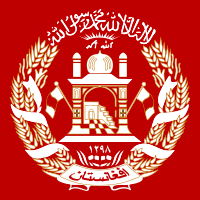 |
| It has an ancient and
has a complex history. The people of this region are fierce fighters and
established an independent and self governing empires throughout their
history. Kabul is the capital and largest city in Afghanistan, a place of
great strategic import. Kabul is also one of the oldest cities in the region
- there are references to the place in the Hindu Rig Veda scriptures (c.
1500 BCE), during Alexandrian times it was called Gandara and Claudius
Ptolemy identifies it (as "Kabura or Ortospana") in the Geographos, 2nd
cent. CE. |
| |
- Persia................................................c.
530 - 330 BCE
- Dadarshish (Balkh)................................520's
- 510's
- Vivana (Qandahar).........................................fl.
520's
- Megabazus (Kabul).........................................fl.
510's
- Bakabadush (Qandahar).....................................fl.
c. 500
- Masistes............................................490
- 465
-
Spitamana...........................................340 - 329 d. 325
- Spitamana's daughter Apama
was married to Seleucus I Nicator during Alexander's campaign to marry his
generals and men to Persian women and created a hybrid empire.
- Bessus...................................................330 -
329 BCE
- He was a Persian general who attempted,
unsuccessfully, to stave off Alexander the Great's invasion of the eastern
portion of the Persian Empire.
- Macedon..................................................329 - 301
BCE
- Artabazus (Balkh).........................................329
- Clitus the Black (Balkh)..................................329
- Amyntas Nikolaos (Balkh)............................328
- 325
- Philip (Balkh,
Satrap of Khurasan c. 320)...........325
- 321
- Oxyartes (Kabul)..........................................fl.
320
- Father of Alexander's
wife Roxane, in Gandara (Kabul).
- Sybirtios (Qandahar)......................................fl.
320
- Stasanor the
Solian (Balkh,
Satrap of Khurasan 316).321
- 312
- The
Seleucid
Empire......................................301 - 256 BCE
- BACTRIA
An Hellenic state whose
rulers are known primarily from their coinage. It eventually fell under the
vassalage of Scythian nomads from the north, the Tocharians.
Capitals: Bactria and
Alexandria on the Oxus (Ai-Khanoum).
- Diodotus I...............................................255 - 239
- Diodotus I wrested independence for his territory
after the death of the Seleucid ruler Antiochus II Theos, who had been
embroiled in a war against Ptolemaic Egypt. Diodotus I married Apama of
Syria, born c. 266 BC, daughter of Antiochus II Theos and wife Laodice I and
had two children: Diodotus II and a daughter, born c. 250 BC, who married
Euthydemus I.
- Diodotus II S/o Diodotus I...............................239
- 223
- He is known for concluding a peace treaty with the
Parthian king Arsaces, in order to forestall the Seleucid reconquest of both
Parthia and Bactria. Diodotus II was killed by a usurper, his brother-in-law
Euthydemus I.
- Euthydemus I S/o Antimachus..............................230 - 200
- Demetrius I S/o Euthydemus I.............................200 - 190
- He conquered extensive areas known as Paropamisade
and Arachosia, what is now Afghanistan and Pakistan, thus creating an
Indo-Greek Kingdom far from Hellenistic Greece. He was never defeated in
battle and was posthumously qualified as the Invincible (Aniketos) on the
pedigree coins of his successor Agathocles. He had diademed and draped bust
facing right on his coins, wearing elephant-skin headdress (evoking
Alexander the Great), symbol of his conquests in India. He married daughter
of Antiochus III.
- Euthydemus II S/o Demetrius I............................190
- 185
- He ruled only Bactria region.
- Agathocles S/o Demetrius I...............................190 -
180
- He ruled only Bactria and Paropamisade.
- Pantaleon S/o Euthydemus
I...............................190 - 180
- He ruled Arachosia, Gandhara and Western Punjab.
- Antimachus I Theos.......................................185 - 170
- He ruled Bactria, Paropamisade and Arachosia.
- Demetrius II S/o Demetrius I.............................175
- 170
- He ruled Bactria, Paropamisade and Arachosia.
- Yuezhi occupation (loss of Ai-Khanoum) of West Bactria in 155 BCE.
- Eucratides I.............................................170
- 145
- He ruled Bactria, Paropamisade, Arachosia,
Gandhara and Western Punjab.
- Eucratides II (East
Bactria).............................155 - 130
with...
- Yuezhi occupied the remaining East Bactria in 130
BCE.
- Plato (East
Bactria).....................................155 - 130
and...
- Heliocles I (East Bactria)...............................155 - 130
- Menander Soter...........................................155
- 130
- Menander was initially a king of Bactria. After
conquering the Punjab he established an empire in the Indian Subcontinent.
|
|
 |
Tetradrachm. Mint:
Balkh. Metal:
0.925 Silver. Weight:
15.25 grams. Diameter:
28.30 mm. Mint:
N/A.
Edge:
Plain.
Alignment:
Medal. Obverse:
Diademed head of king facing right, within
dotted border. |
|
Reverse: Nude
Herakles seated left on a pile of rocks, holding club in right hand
which he rests on another pile of rocks. "BAΣIΛEΩΣ" (King) written
in Greek at the right side from top to bottom. "EYΘYΔHMOY" (Euthydemos)
written in Greek at the left side from top to bottom. Monogram in
lower right field. Ruler:
Euthydemus I (230 - 200 BCE).
Ruling areas: Bactria, Sogdiana,
Ferghana and Arachosia. Euthydemos I (also spelled Euthydemus)
was not a direct descendant of the Diodoti. He appears to have had a
long reign, perhaps 230-200 BCE according to Bopearachchi, as the
portraits on his coins show a steady maturing or aging.
During his reign, Euthydemos faced a challenge from the Seleucid
king Antiochos III, who attempted to take back the Bactrian kingdom.
Euthydemos was able to convince him that, since he was not related
to the usurper Diodoti, he should not be the target of Seleucid
aggression and thus he was able to obtain recognition of his
sovereignty. |
|
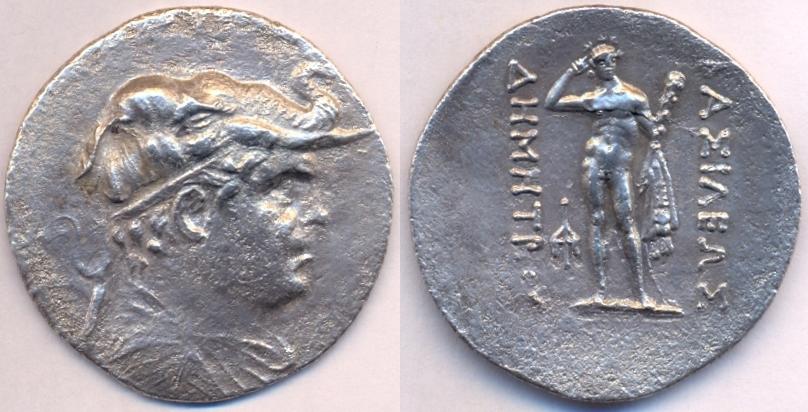 |
Tetradrachm
Metal: 0.925 Silver.
Weight: 14.67 grams.
Diameter: 35.00 mm. Mint:
N/A.
Edge:
Plain.
Alignment:
Medal.
Ruler: Demetrius I
(200 - 190 BCE). He is also known to conquer modern day areas of north India
and Pakistan. His basic coin type, wearing an elephant scalp, symbolizes
this as the elephant represented India to the Greeks. |
|
Obverse: Diademed
head of king facing right, wearing elephant scalp head-dress.
Reverse: Nude
Heracles standing with face straight, holding club and lion skin in left
hand and crowning himself with his right hand. "BAΣIΛEΩΣ" (King) written
in Greek at the right side from top to bottom. "ΔHMHTPIOY" (Demetrius)
written in Greek at the left side from top to bottom. Monogram in lower
left field. |
|
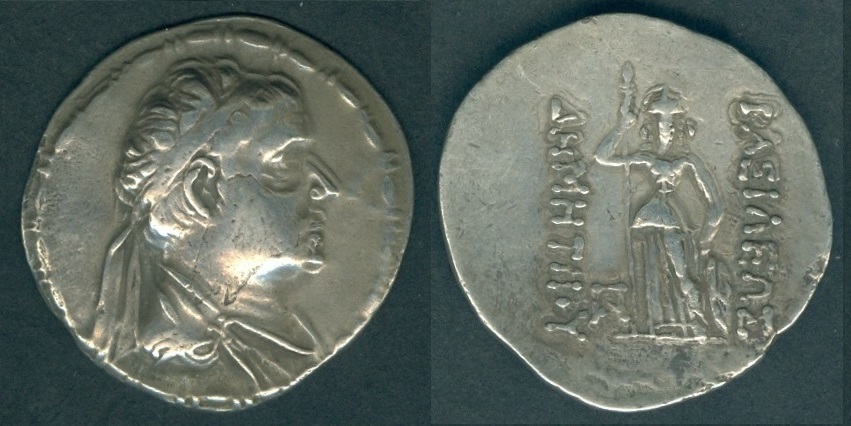 |
Tetradrachm
Metal: 0.925 Silver.
Weight: 16.27 grams.
Diameter: 32.00 x 33.00 mm. Mint:
N/A.
Edge:
Plain.
Alignment:
Medal.
Ruler: Demetrios II
(c. 175-170 BCE). |
|
Obverse:
Diademed bust of king facing right, bead and reel
border around.
Reverse: Athena
standing facing, holding shield in left hand, spear in right. Greek
legend: "BAΣIΛEΩΣ" (King) written in Greek at the right side from
top to bottom. "ΔHMHTPIOY" (Demetrius)
written in Greek at the left side from top to bottom. Monogram in lower
left field. Demetrius II, despite the congruence of name, does
not appear to have been related to the Demetrios I,
since he did not use Herakles on his coins. He must have had a short
reign as his coins are rare. The only coin types known are the
silver tetradrachm and drachm. He is probably the same Demetrius
mentioned by Justin as "king of the Indians" who was overthrown by
the usurper Eucratides. Bopearachchi dates his reign to c. 175-170
BCE, but it was probably even shorter, as the rarity of his coins
attests. |
|
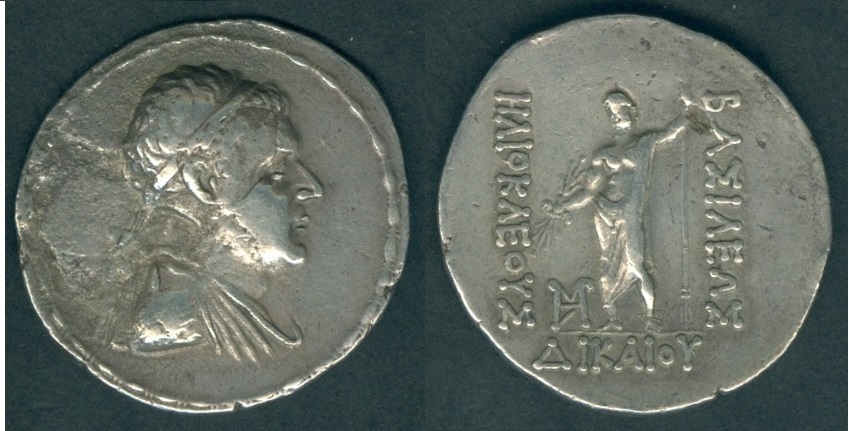 |
Tetradrachm
Metal: 0.925 Silver.
Weight: 16.10 grams.
Diameter: 33.00 mm. Mint:
N/A.
Edge:
Plain.
Alignment:
Medal.
Ruler: Heliocles I
(c. 145-130 BCE). |
|
Obverse:
Diademed bust of king facing right, bead and reel
border around.
Reverse: Zeus
standing facing, holding thunderbolt in right hand and spear in left
hand. Greek legend: "BAΣIΛEΩΣ" (King) written in Greek at the right
side from top to bottom. "HΛIOKΛEOYΣ" (Heliocles) written in Greek
at the left side from top to bottom. "ΔIKAIOY" (the Just) written at
the bottom. Monogram in lower left field. Heliocles I (also spelled Heliokles) was the
third of the three kings (Plato and Eucratides II being the others)
who seemed to succeed Eucratides I in quick succession in Bactria,
north of the Hindu Kush mountains. Heliocles appears to have been
the last of the three, since his coinage was imitated extensively by
the Scythian nomads who undoubtedly overthrew the Greeks in Bactria.
Heliocles ruled only in Bactria, as all his known coins conform to
the Attic weight standard that was used only north of the Hindu Kush. |
|
| |
- The YUEZHI (Chinese: 月氏)
- They were an ancient Indo-European people first
described in Chinese histories as nomadic pastoralists living in an arid
grassland area in the western part of the modern Chinese province of Gansu,
during the 1st millennium BC. After a major defeat by the Xiongnu in 176 BC,
the Yuezhi split into two groups migrating in different directions: the
Greater Yuezhi (Dŕ Yučzhī 大月氏) and Lesser Yuezhi (Xiǎo Yučzhī 小月氏).
The Greater Yuezhi initially migrated northwest into the Ili Valley (on the
modern borders of China and Kazakhstan), where they reportedly displaced
elements of the Sakas. They were driven from the Ili Valley by the Wusun and
migrated southward to Sogdia and later settled in Bactria, where they then
defeated the Greco-Bactrian Kingdom. The Greater Yuezhi have consequently
often been identified with Bactrian peoples mentioned in classical European
sources, like the Tókharioi (Greek Τοχάριοι; Sanskrit Tukhāra) and Asii (or
Asioi). During the 1st century BC, one of the five major Greater Yuezhi
tribes in Bactria, the Kushanas (Chinese: 貴霜; pinyin: Guěshuāng), began to
subsume the other tribes and neighbouring peoples. The subsequent Kushan
Empire, at its peak in the 3rd century CE, stretched from Turfan in the
Tarim Basin, in the north to Pataliputra on the Gangetic plain of India in
the south. The Kushanas played an important role in the development of trade
on the Silk Road and the introduction of Buddhism to China.
The Lesser Yuezhi migrated southward to the edge of the Tibetan Plateau.
Some are reported to have settled among the Qiang people in Qinghai, and to
have been involved in the Liangzhou Rebellion (184–221 CE). Others are said
to have founded the city state of Cumuḍa (now known as Kumul and Hami) in
the eastern Tarim. A fourth group of Lesser Yuezhi may have become part of
the Jie people of Shanxi, who established the 4th century AD Later Zhao
state (although this remains controversial). Below rulers are considered to
be Tu-Mi a Kushan subkingdom centered on Qonduz. Qonduz, a northern Afghan
state, about equidistant between Mazar-I-Sharif and Faizabad. They may have
had a part in forming the Kushan Empire. They were
known by the Chinese as the Daxia or Yueh-chi, by the Greeks as
Tocharoi, and by the Turks as Twghry. Distinct Tocharian groups
survived until the end of the first millenium CE, when they were
absorbed by Turkic groups such as the Uighurs.
- Sapadbizes
(Sapalbizes)...............................20 BCE - 1 BCE
with...
- Two clues provide an approximate date
for this ruler. He is believed to have over struck the coins of
Phraates IV of Parthia, secondly his coins are of good silver.
This places him after Phraates (40 BCE) and before the
debasement of coinage in Northwest India (20 CE). He is not the
only ruler of his dynasty known. Several other coins imply that
Sapadbizes was proceeded by at least one, and possibly two other
rulers. It is likely that Sapadbizes and these other rulers were
descendants of tribes who had invade Bactria and imitated the
coins of the last Greco-Bactrian kings. Though it is clear from
the coins and the evidence of Chinese chroniclers that at this
time Sapadbizes was an ally or dependent of Parthia. Nothing is
known of the succession after Sapadbizes, but scholars surmise
that his kingdom was conquered by Kujula Kadphises, during the
latter's war with Parthia, and absorbed into the Kushan Empire.
- The first identified Yueh-Chi prince has always
been called Sapadbizes. However, as a close examination of the coins shows,
the name should be Sapalbizes, not Sapadbizes. The fifth letter is a Λ
(lambda), not a Δ (delta). A discussion on the southasia-coins eGroup
confirmed that all coins of this ruler do indeed read "Sapalbizes," except
that reportedly there is one coin at the British Museum that carries a Δ.
Perhaps it was this coin that first led numismatists (presumably in this
case Major General Cunningham was the first) to name this prince Sapadbizes.
- Agesiles (Arseiles)...................................20
BCE - 1 BCE and...
- Once again, the conventional name assigned to this
ruler needs to be corrected. Mitchiner, for example, refers to this ruler as
Agesiles. However, Senior has correctly pointed out that the name should
read Arseiles. What Mitchiner and earlier writers have been reading as a Γ
(G) is really a Ρ (R) with a dot replacing the circle at the top of the
letter. This form was used during this period.
- Pabes.................................................20
BCE - 1 BCE
- The reverse on Pabes's coins shows a naked
standing Hercules, holding club by his side. Greek legend right and left:
ΠABHC. A reverse type associated with the Bactrian king Demetrius I, while
the reverses of Sapalbizes and Arseiles exhibit a Persian theme.
- Heraios...............................................c.
first half of 1st. Century
- Reverse legends on his Silver tetradrachm: "TVPANNOYNOTOC
HPAOV - ANTEIX - KOPPANOY" and other type having "TVPANNOVOTOΣ HΛOV - ΣΛNΛB
- KOPPANOY". The normal translation of the legend is: "Of the Tyrant (the
one who rules by his own power), Heraios, the Kushan". Note the two P's in
KOPPANOY are not rhos, but the Bactrian Greek letters san, and are
pronounced "sh". This type is marked by the very rare ANTEIX in place of the
more common ΣANAB. Rtveladze has argued that it means "the one who defeats
the enemy" and the Iranian translation of ANTEIX. The coins traditionally
assigned to "Heraios, the Kushan", appear to be the first Kushan coins. Joe
Cribb (Joseph Edmond Cribb) of the British Museum has argued that these coins were issued by
Kujula Kadphises.
|
- The SAKAE
(INDO-SCYTHIANS) -
The eastern branch of the Scythians, who constantly
harassed the eastern provinces of the Persian empires and invaded
Afghanistan and Northern India in the first century BCE. Sakae (Indo-Scythian) capitals were: Sigal, Taxila, Mathura and
Minnagara. They ruled modern day area of almost all
Pakistan and Northwest part of India. Sigal was a city of the Helmund
valley in south-west Afghanistan.
- Maues.....................................................97 - 58
BCE
- Maues had his capital in Sirkap and minted most of
his coins in Taxila. Maues did not manage however to conquer the Punjab
territories of the Indo-Greeks east of the Jhelum, which remained under
Greek control. After his death the Indo-Greeks regained most of their
territory. Maues issued joint coins mentioning a queen Machene ("ΜΑΧΗΝΗ").
Machene may have been a daughter of one of the Indo-Greek houses. An
Indo-Greek king, Artemidoros, also issued coins where he describes himself
as "Son of Maues".
- Vonones................................................c.
75 - c. 65
- Vonones was an Indo-Scythian king who ruled in
Sakastan and Arachosia from ca. 75 BC to 65 BC. He is also sometimes
described as a Parthian Suren. He succeeded Maues and took the title "Great
King of Kings".
His brother, Spalahores, was mentioned on his coins, as well as Spalahores'
son Spalagadames. Spalahores succeeded him.
- Spalirises (Spalyris)..................................c.
60 - c. 57
- Spalahores, satrap and brother of King Vonones,
and probably later became King Spalirises.
- Spalagademes S/o Spalahores....................................c.
50
- He ruled in areas of the North-western South Asia
between around 50 BCE. No coins of him as king are known, so he must have
been a subordinate local ruler, such as a satrap.
- Azilises...............................................c.
57 - c. 35
- Azilises was an Indo-Scythian king who ruled in
the area of Gandhara. Azilises issued some joint coins with Azes, where Azes
is presented as king on the obverse ("BASILEOS BASILEON MEGALOY AZOY"), and
Azilises is introduced as king on the obverse in kharoshthi ("Maharajasa
rajarajasa mahatasa Ayilisasa", "The great king, the king of kings, the
great Azilises").
- Azes I.................................................c.
48 - c. 25
- He was an Indo-Scythian ruler who completed the
domination of the Scythians in Gandhara. According to Senior, Azes I may
have been identical with Azes II, due to the discovery of an overstrike of
the former over the latter.
- Azes II................................................c.
35 - c. 12
- After the death of Azes II, the rule of the
Indo-Scythians in northwestern India and Pakistan finally crumbled with the
conquest of the Kushans, one of the five tribes of the Yuezhi who had lived
in Bactria for more than a century, and who were then expanding into India
to create a Kushan Empire. Soon after, the Parthians invaded from the west.
Their leader Gondophares temporarily displaced the Kushans and founded the
Parthian that was to last until the middle of the 1st century CE. The
Kushans ultimately regained Mardan and ancient Taxila c. 75 CE, where they
were to prosper for several centuries. After the death of the great king
Azes II, Scythian power in India rapidly waned, with a few kings surviving
here and there for a short while longer. Rajuvula (ruled c. 10 - 25 CE) was one of these kings. He
ruled in Mathura and in the Jammu area in the early part of the new
millennium, losing part of his kingdom to the rising Indo-Parthian king
Gondophares. He retained his seat in Mathura, where he was succeeded by his
son Sodasa.
- Zeionises S/o Manigul..............................c.
10 BCE - c. 10 CE and...
- Zeionises was an Indo-Scythian satrap of the area
of southern Chach (Kashmir) for king Azes II. He then became king, and ruled
in parts of the Indian subcontinent around 10 BCE – 10 CE, but apparently
lost his territory to the invasion of the Indo-Parthians. His coins bear the
Buddhist Triratna symbol on the obverse, and adopt representations of Greek
divinities such as the city goddess Tyche. A silver jug found at Taxila (Konow
1929: 81-83) indicates that Zeionises was "satrap of Chuksa, son of Manigula,
brother of the great king", but who this king was remains uncertain.
- Kharahostes S/o Arta...............................c.
10 BCE - c. 10 CE
- Kharahostes or Kharaostasa was an Indo-Scythian
ruler (probably a satrap) in the northern Indian subcontinent around 10 BCE
– 10 CE. He is known from his coins, often in the name of Azes II, and
possibly from an inscription on the Mathura lion capital, although another
satrap Kharaostes has been discovered in Mathura. Coin finds suggest that
Kharahostes ruled in the area of the Darunta district to the west of
Jalalabad, probably based on the ancient city of Nagarahara, located to the
west of Jalalabad. Kharahostes's own coins attest that he was the son of
Arta, a brother of king Maues and Satrap of Chukhsa.
- Mujatria S/o Kharahostes.......................................c.
10 CE
Mujatria, previously read Hajatria (ruled circa 10 CE, or 40-50 CE according
to more recent research based on numismatics), is the name of an
Indo-Scythian ruler, the son of Kharahostes as mentioned on his coins.
According to Joe Cribb, Mujiatria was located in the region of Jalalabad in
eastern Afghanistan and lived in the later part of the 1st century CE.
- Rajuvula...............................................c.
10 - c. 25 CE
- After the death of the great king Azes, Scythian
power in India rapidly waned, with a few kings surviving here and there for
a short while longer. Rajuvula was one of these kings. He ruled in Mathura
and in the Jammu area in the early part of the new millenium, losing part of
his kingdom to the rising Indo-Parthian king Gondophares. He retained his
seat in Mathura, where he was succeeded by his son Sodasa.
- Sodasa S/o Rajuvula............................................c.
15 CE
- Sodasa was an Indo-Scythian Northern Satrap and
ruler of Mathura during the later part of the 1st century BCE or the early
part of 1st century CE. He was the son of the Great Satrap of Mathura
Rajuvula and Kamula Ayasa. He is mentioned in the Mathura lion capital.
|
|
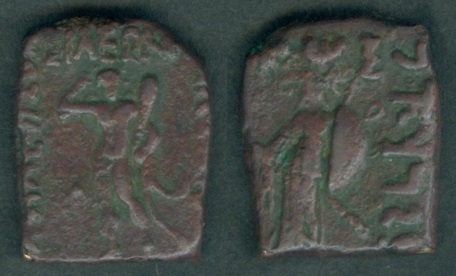 |
MIG 683b / Sen 66.2 Hemi-Obol.
Weight: 8.59 g.
Metal: Copper.
Diameter:
16.00 mm x 19.00 mm.
Alignment: Medal. Mint:
N/A.
Edge:
Plain. Obverse:
Naked Herakles standing facing, crowning himself with right hand,
holding club and lion's skin in left, Greek legend around: BAΣIΛEΩΣ
BA / ΣIΛEΩN MEΓ / AΛOY ONΩNOY. |
|
Reverse: Pallas
Athena standing left, holding spear and shield, monograms at left,
Kharoshthi legend around: "maharajabhrata dhramikasa / spalahorasa".
Ruler: Vonones. Reign recorded by some historian:
c. 75 BCE -
65 BCE. This coin names Vonones on the obverse and Spalahores
on the reverse. It is highly unusual in that the Greek and
Kharoshthi legends are not translations of one another. While the
Greek legend proclaims King Vonones the Great, King of Kings, the
Kharoshthi on the reverse says: "of Spalahores, the king's brother,
the just". |
|
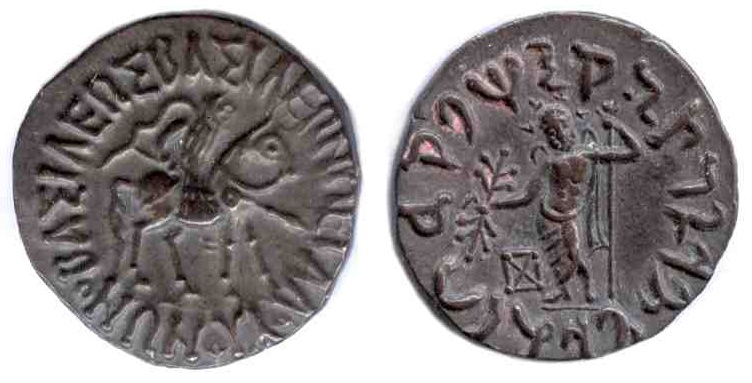 |
MIG 681a / Sen 65.1T Tetradrachm
Weight: 9.00 g.
(Indian Standard).
Metal: 0.925 Silver.
Alignment:
Medal.
Mint:
N/A.
Edge:
Plain. Obverse:
King mounted on horse riding right, holding spear, Greek legend
around "BAΣIΛEΩΣ BAΣIΛEΩN MEΓAΛOY" (Great King of Kings) "ONΩNOY" (Vonones)
written at the bottom. Vonones and Spalagadames Silver
tetradrachm issue. King Vonones mentioning his nephew Spalagadames,
son of his brother Spalahores. Spalahores probably succeeded his
father as Vonones's viceroy. |
|
Reverse: Zeus
holding a thunderbolt and a sceptre in the center. Kharoshthi legend
around: "spalahoraputrasa dhramiasa / spalagadamasa" (Of
Spalagadames, the son of Spalahores, the follower of the Dharma).
Monogram at bottom left field. Ruler: Vonones
[Basileos
Basileon Megaloy Ononiu]. Reign recorded by some historian:
c. 75 BCE -
65 BCE. There is no single-word translation for Dharma in
Western languages. In Hinduism, dharma signifies behaviours that are
considered to be in accord with Ṛta, the order that makes life and
universe possible and includes duties, rights, laws, conduct,
virtues and "right way of living". In Buddhism, dharma means "cosmic
law and order" and is also applied to the teachings of the Buddha.
In Buddhist philosophy, dhamma/dharma is also the term for
"phenomena". Dharma in Jainism refers to the teachings of
tirthankara (Jina) and the body of doctrine pertaining to the
purification and moral transformation of human beings. For Sikhs,
the word dharm means the path of righteousness and proper religious
practice. The word dharma was already in use in the historical Vedic
religion, and its meaning and conceptual scope has evolved over
several millennia. The antonym of dharma is adharma. |
|
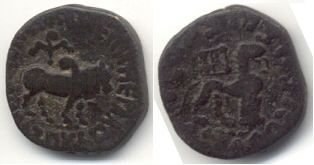 |
MIG 850j / Sen 102.100 Hexa-Chalkon.
Weight: 12.70g.
Metal: Bronze.
Diameter: 28.00 mm.
Alignment:
Coin. Mint: Taxila.
Edge:
Plain. |
|
Obverse:
Humped bull standing facing right with monogram
above. Greek legend around: "BAΣIΛEΩΣ BAΣIΛEΩN MEΓAΛOY / AZOY" (Great
King of Kings / Azes).
Reverse: Lion
standing facing right with monograms above. Kharoshthi legend around: "maharajasa rajarajasa mahatasa / ayasa"
(The Great King of Kings Azes).
Ruler: Azes II
[Basileos
Basileon Megalou Azou]. Reign:
c. 35 BCE to 12 BCE. |
|
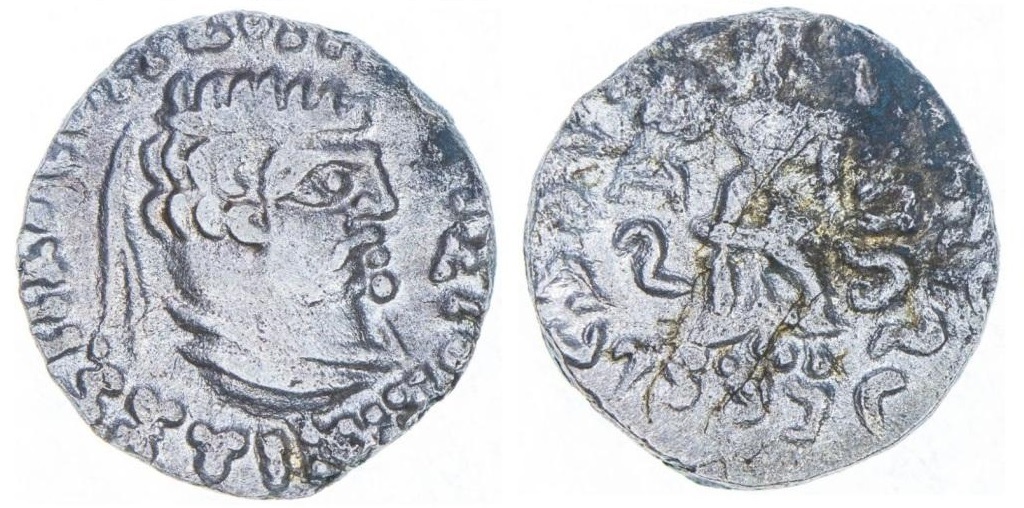 |
MIG 902a / Senior 151.22 / MACW 2497 / HGC 12, 733
Billion Silver Drachm.
Weight:
2.27g.
Metal: Debased
Silver.
Diameter: 13.50 mm.
Alignment:
Medal. Mint:
N/A.
Edge:
Plain. |
|
Obverse: Diademed
bust of Rajuvula facing right; Greek legend around.
Reverse: Athena
Alkidemos standing left, holding horizontal shield on outstretched left
arm, brandishing / hurling thunderbolt with right hand, monograms at
left and right. Kharoshthi legend around: "chatrapasa
apratihatachakrasa rajuvulasa" (of Satrap
Rajuvula of the Invincible Chakra).
Ruler: Rajuvula. Reign:
c. 10 CE to c. 25 CE.
Rajuvula used as his reverse type the image of Athena hurling a
thunderbolt, a design used by many Indo-Greek kings, starting with
Menander. Perhaps he had some Greek blood in him too. Athena Alkidemos
or Alcidemus (defender of the people, demos) was the epithet of Athena,
the city-goddess of Pella, Macedonia. A similar Macedonian epithet of
Athena was Alcis. Athena Alkidemos with thunderbolt and shield (aegis)
was a usual depiction in Hellenistic tetradrachms. |
|
| |
- Suren (Parthia)...................................last
half of 1st cent. BCE
- Surena or Suren (died 53 BCE) was a Parthian
spahbed ("General" or "Commander") during the 1st century BC. He was a
member of the House of Suren and was best known for defeating the Romans in
the Battle of Carrhae. Under his command Parthians decisively defeated a
numerically superior Roman invasion force under the command of Marcus
Licinius Crassus. It is commonly seen as one of the earliest and most
important battles between the Roman and Parthian empires and one of the most
crushing defeats in Roman history.
-
The Kushanid Empire.................................c. 30
BCE - c. 230 CE
- The KUSHANSHAHS
- A Persian state established as a buffer zone.
They ruled from c. 230 to 410, but became a
Persian dependency from c. 350. The Kushanshas are mainly known through
their coins. Their coins were minted at Kabul, Balkh, Herat, and Merv,
attesting the extent of their realm.
- Ardashir...............................................c.
230 - c. 245
- Peroz
I................................................c. 245 - c. 270
- Hormazd
I..............................................c. 270 - c. 295
- Hormazd
II.............................................c. 295 - c. 300
- Peroz
II...............................................c. 300 - c. 325
- Varhran
I..............................................c. 325 - c. 350
- Persia.................................................c.
350 - 410
- Varhran
II........................................c. 350 - c. 400 with...
- Peroz
III.........................................c. 350 - c. 400
- Varhran
III.......................................c. 400 - c. 410
- The White Huns
(Hephthalites).............................410 - 565
- KSHATRIYA - Hindu
dynasty mainly as
Kingdom of Zabulistan.
Controlled Kabul at various
times.
- Napki......................................................fl.
c. 550
- Kanik
- Rutbal.....................................................fl.
c. 670
- Bahr Tigin.................................................c.
698
- Katorman...................................................c.
750
- Unknown rulers
- Zunbil (Phiruz)...................................c.
850 - c. 870
- Lagutarman.................................................fl.
c. 880's
- Much to the Western Turks
(Gök)...........................565 - 652
- Much to The Prophet
Muhammad's elected successors.........652 - 661
- Hemar Beg (Badakhshan).....................................fl.
652
-
Umayyad
Caliphate.........................................661 - 750
-
Abbasid
Caliphate.........................................750 - 867
- Ilyas ibn Asad
(Khorasan
Governor at Herat)................fl. 819
- The NEZAK
- The Nezak were a
Hephtalite clan which seized control during the 600's and 700's in various
places in Afghanistan, including Kapisa, Kabul, and Ghazni, as well as parts
of Seistan.
- Nezak Malka................................................early
600's
- Sri Shaho (in
northern India).....................c.
650 - 700
- Shahi Tigin................................................fl.
690's
- Nezak Shah
- Vakhu (Vakka) Deva.........................................fl.
c. 720
- The Nezak were defeated
and dispersed by the Caliphate in c. 730.
- Persia...................................................867 - 900
- SHAHI - A
Hindu dynasty controlling much of northeastern Afghanistan and northwestern
Pakistan, including Kabul. They are split into two eras the Buddhist-Shahis
and the later Hindu-Shahis with the change-over occurring around 870. These
coins represent the last issues of the Turk Shahis of Kabul which began with
the Nezak Malka/ Srio Shaho "trident crown" coins of Barhategin in the early
8th century. The Arab historian Alberuni tells us of the last Turkic king, Lagaturman, who was overthrown by his Brahman advisor Kellar. This usurper
Kellar founded a dynasty of seven subsequent Hindu rulers.
- Lalliya (Kellar).................................c.
890 - 895
- Toramana Kamaluka
(1st time)..............................895
d.921
- Samanta Deva........................................895
- c. 900
-
Kashmir..........................................c. 900 - c. 902
- Toramana Kamaluka
(2nd time)........................902
- 921
- Khudarayaka (Saffarid
Governor)..................c.
903 - 915
- Coin with Arabic word "Adil" (meaning
"justice") to right of horseman were minted at Kabul. Coins issued with
this legends exists because for a short period Muslims captured Kabul
for a brief period.
- Bhima Deva..........................................921
- 960
- Jayapala S/o
Hutpala................................960
- 1002
- His kingdom stretched from Laghman to Kashmir
and Sirhind to Multan, with Peshawar being in the center. efore his
struggle began Jayapala had raised a large army of Punjabis. When
Jayapala went to the Punjab region, his army was raised to 100,000
horsemen and an innumerable host of foot soldiers. However, the army was
hopeless in battle against the western forces, particularly against the
young Mahmud of Ghazni. Sultan Mahmud came to power and was occupied
with the Qarakhanids north of the Hindu Kush, Jayapala attacked Ghazni
at the Battle of Peshawar, which was fought on 27 November
1001, between the Ghaznavid army under Sultan Mahmud bin Sebuktigin (Mahmud
of Ghazni) and the Hindu Shahi army of Jayapala, near Peshawar. Jayapala
was defeated and captured, and as a result, Jayapala was bound and
paraded, and a large ransom were paid for the release of members of his
family. Due to the humiliation of the defeat, he later immolated himself
in a funeral pyre and committed suicide because his subjects thought he
had brought disaster and disgrace to the Shahi dynasty. This left the region vulnerable and North
India was then open to further invasions.
- Anandapala S/o
Jayapal.............................1002
- 1011
- Anandapala's last stand against Sultan Mahmud
of Ghazni. Mahmud later conquered the upper Indus region, and then in
1009, defeated Jayapala's son Anandapala in a battle at Chach (Chach is
at the edge of Khyber-Pakhtunkhwa - Punjab border within Pakistan. It is
20.4 km from Attock city and 22.9 km from Topi, Khyber-Pakhtunkhwa).
Mahmud then captured Lahore and Multan, giving him control of the Punjab
region. Anandapala eventually signed a treaty with the Ghaznavid Empire
in 1010 and shortly a year later died as a result of a natural death.
R.C Majumdar (D.V. Potdar Commemoration Volume, Poona 1950, p. 351)
compared him ironically to his dynastic ancient famous ancestor "King
Porus, who bravely opposed Alexander but later submitted and helped in
subduing other Indian rulers". Tahqíq Má li'l-Hind (p. 351) finally
revered him in his legacy as "noble and courageous".
- Trilochanpala S/o Anandapala.......................1011
- 1021
- He was assassinated by his own troops at the
year of 1021.
- Bhimapala S/o
Trilochanpala........................1021
- 1026
- He was referred to by
Utbí as "Bhīm, the Fearless" due to his courage and valour. Considering
his kingdom was at its lowest point, possibly only in control of Nandana,
he admirably earned the title of "fearless" from his enemy's own
chronicle writer. He is known to have commanded at the battle of Nandana
personally and seriously wounded the commander of the Ghaznavid army
Muhammad bin Ibrahim at-Tāī ('Utbi, vil.ii, p. 151). He ruled only five
years before meeting his death in 1026. This Hindu dynasty came
to an end with the conquest of Ghaznavid Empire in 1026.
- Bhimapala's sons
Rudrapal, Diddapal, Kshempala and Anangpala served as generals in
Kashmir. They gained prominence in the Kashmiri royal court where they
occupied influential positions and intermarried with the royal family.
Hindu Kashmir had aided the Hindus Shahis against Mahmud of Ghazni. As a
result after barely defeating the Hindu Shahis, Mahmud marched his men
to Hindu Kashmir to take revenge for Kashmir's support of the Hindu
Shahis. Al-Biruni was with Mahmud on these campaigns. They are mentioned
frequently in Rajatarangini of Kalhana written during AD 1147–1149.
Rudrapal was mentioned by the writer Kalhana as a valiant general in the
campaigns he led to quell resistance to the Kashmiri kings whom they
served whilst in exile. His later descendants fell out of favour at the
royal court and were exiled to the Siwalik Hills, retaining control of
the Mandu fort. After a brief period, they rose again to take control of
Mathura under Raja Dhrupet Dev in the 12th century before the campaigns
of the Ghorid Empire. The Janjua Rajputs of Punjab region claim to be
the descendants of the Jayapala.
|
| |
|
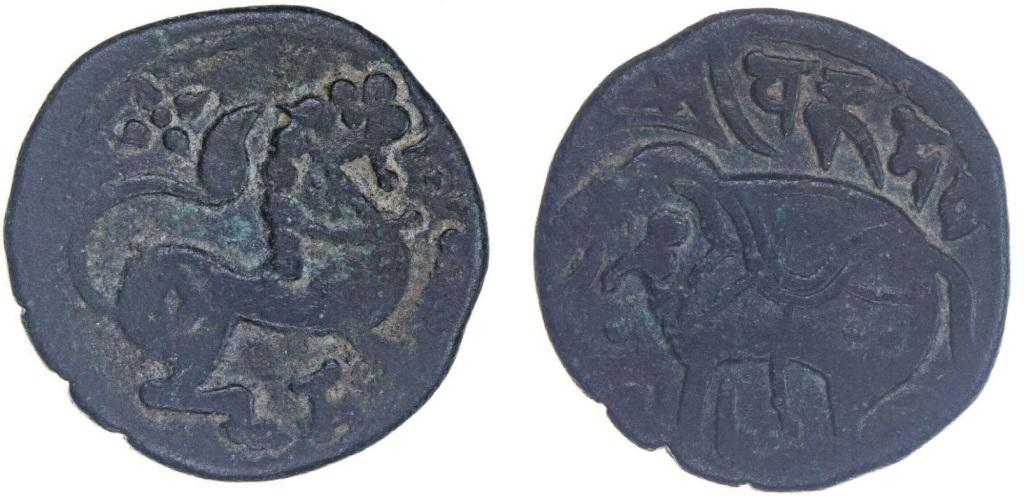 |
Tye#9 Copper Jital.
Year: c. 800 - c. 1000.
Weight: 1.91g.
Metal: Copper.
Diameter:
17.00 mm. Mint:
N/A. Edge:
Plain.
Alignment:
Rotated (11 o'clock).
Obverse:
Lion waking right side.
Reverse:
Nagari legends above Elephant at the top. Elephant standing and facing left in
the center. Mintage:
N/A. Minted Years:
N/A. Ruler:
Vakka. |
|
 |
Tye#19 Copper Jital.
Year: c. 850 - c. 1000.
Weight: 2.31g.
Metal: Copper.
Diameter:
18.10 mm. Mint:
N/A. Edge:
Plain.
Alignment:
Rotated (2 o'clock).
Obverse:
Lion waking right side.
Reverse:
Nagari legends above Elephant at the top. Elephant standing and facing left in
the center. Mintage:
N/A. Minted Years:
N/A. Ruler:
Samanta Deva. |
|
 |
Tye#3
Silver Jital.
Year: c. 750 - c. 900.
Weight: 3.44g.
Metal: Silver.
Diameter:
19.00 mm. Mint:
Kabul. Edge:
Plain.
Alignment:
Rotated (1 o'clock).
Obverse:
Horseman riding
caparisoned horse towards right and
holding banner / lance. "A" written in Nagari at the left side. Plume
symbol at right side.
Type: Royal
title in cursive Bactrian at right side on Obverse side. |
|
Reverse:
"sri spalapati deva" written in Nagari
above Zebu. Recumbent bull facing left, wearing jhula,
(saddle-cloth).
Trident symbol on bull's rump. Star above pellet above crescent. Minted Years:
One year type with various varieties. Ruler:
Spalapati Deva. |
|
 |
Tye#4A
Silver Jital.
Year: c. 750 - c. 900.
Weight: 3.33g.
Metal: Silver.
Diameter:
18.00 mm. Mint:
Kabul. Edge:
Plain.
Alignment:
Rotated (7 o'clock).
Obverse:
Horseman riding
caparisoned horse towards right and
holding banner / lance. "A" written in Nagari at the left side. Plume
symbol at right side. |
|
Reverse:
"sri spalapati deva" written in Nagari
above Zebu. Recumbent bull facing left, wearing jhula,
(saddle-cloth).
Trident symbol on bull's rump. Star above pellet above crescent. Minted Years:
One year type with various varieties. Ruler:
Spalapati Deva. |
|
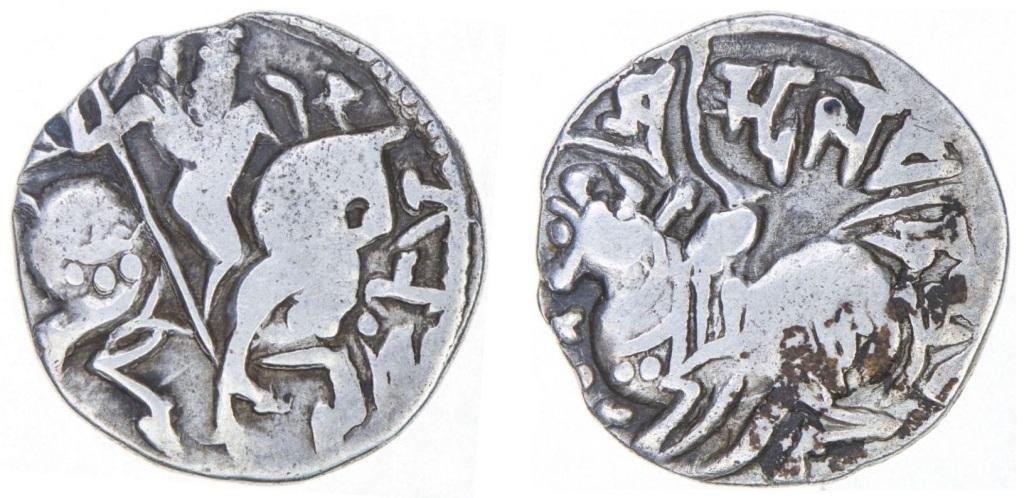 |
Tye#5
Silver Jital.
Year: c. 750 - c. 900.
Weight: 3.25g.
Metal: Silver.
Diameter:
19.00 mm. Mint:
Kabul. Edge:
Plain.
Alignment:
Rotated (9 o'clock).
Obverse:
Horseman riding
caparisoned horse towards right and
holding banner / lance. "A" written in Nagari at the left side. Plume
symbol at right side. |
|
Reverse:
"sri spalapati deva" written in Nagari
above Zebu. Recumbent bull facing left, wearing jhula,
(saddle-cloth).
Trident symbol on bull's rump. Star above pellet above crescent. Minted Years:
One year type with various varieties. Ruler:
Spalapati Deva. |
|
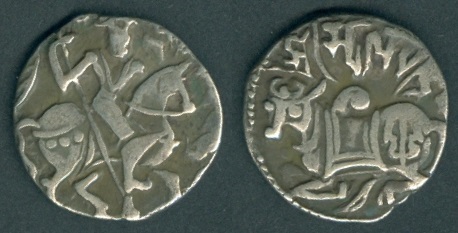 |
Same as above coin but have some difference in legend size and
details.
Weight: 3.35g.
Diameter:
17.00 mm. Alignment:
Coin. |
|
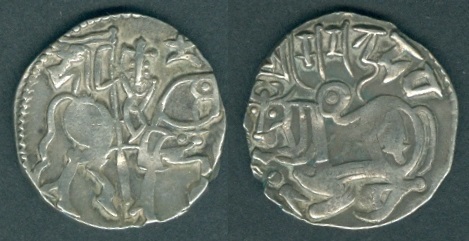 |
Tye#14.1
Silver Jital.
Year: c. 850 - c. 1000.
Weight: 3.37g.
Metal: Silver.
Diameter:
18.50 mm. Mint:
Gandhara - Ohind. Edge:
Plain.
Alignment: Medal.
Obverse:
Horseman riding
caparisoned horse towards right and
holding banner / lance. "दी" (Bhi) written in Nagari at the left side. Plume
symbol at right side.
Type1:
Plume pointing upwards, right of the
horseman's head. |
|
Reverse:
"श्री सामन्त देव" (sri samanta deva) written in Nagari
above Zebu.
Recumbent bull facing left, wearing jhula, (saddle-cloth). Trident symbol on
bull's rump. Star above pellet above crescent. Minted Years:
One year type with various varieties. Ruler:
Samanta Deva.
Note:
Samanta Deva was a title rather than a
name of a ruler according to coin collectors. The first rulers were
called "Samanta Deva" (="Feudatory Chief") and later rulers were
called "Spalapati Deva" (="Military Commander").
These Jital with various character like "Gu" (Tye#4), "Gu" (Tye#5),
"Ka" (Tye#6),"Da" (Tye#7), etc. were documented with reference
numbers given by Robert & Monica Tye. Deyell gives the Spalapati
coins to the Turk Shahis centered at Kabul and the Samanta coins to
the subsequent Hindu Shahis ruling from Ohind in Pakistan.
Further Reading:
|
|
 |
Type2:
Plume pointing north-west, right
of the horseman's head.
Weight: 3.41g.
Diameter:
18.00 mm. Alignment:
Rotated (9 o'clock). |
|
 |
Type3:
Plume pointing west, right of
the horseman's head.
Weight: 3.28g.
Diameter:
18.00 mm. Alignment: Medal. |
|
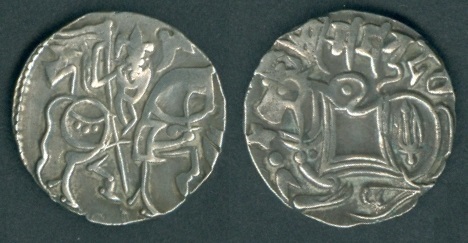 |
Tye#14.2 with thick head of
horseman. Thick Plume pointing west on the right side of horseman's head.
Weight: 3.38g.
Diameter:
18.00 mm. Alignment: Medal. |
|
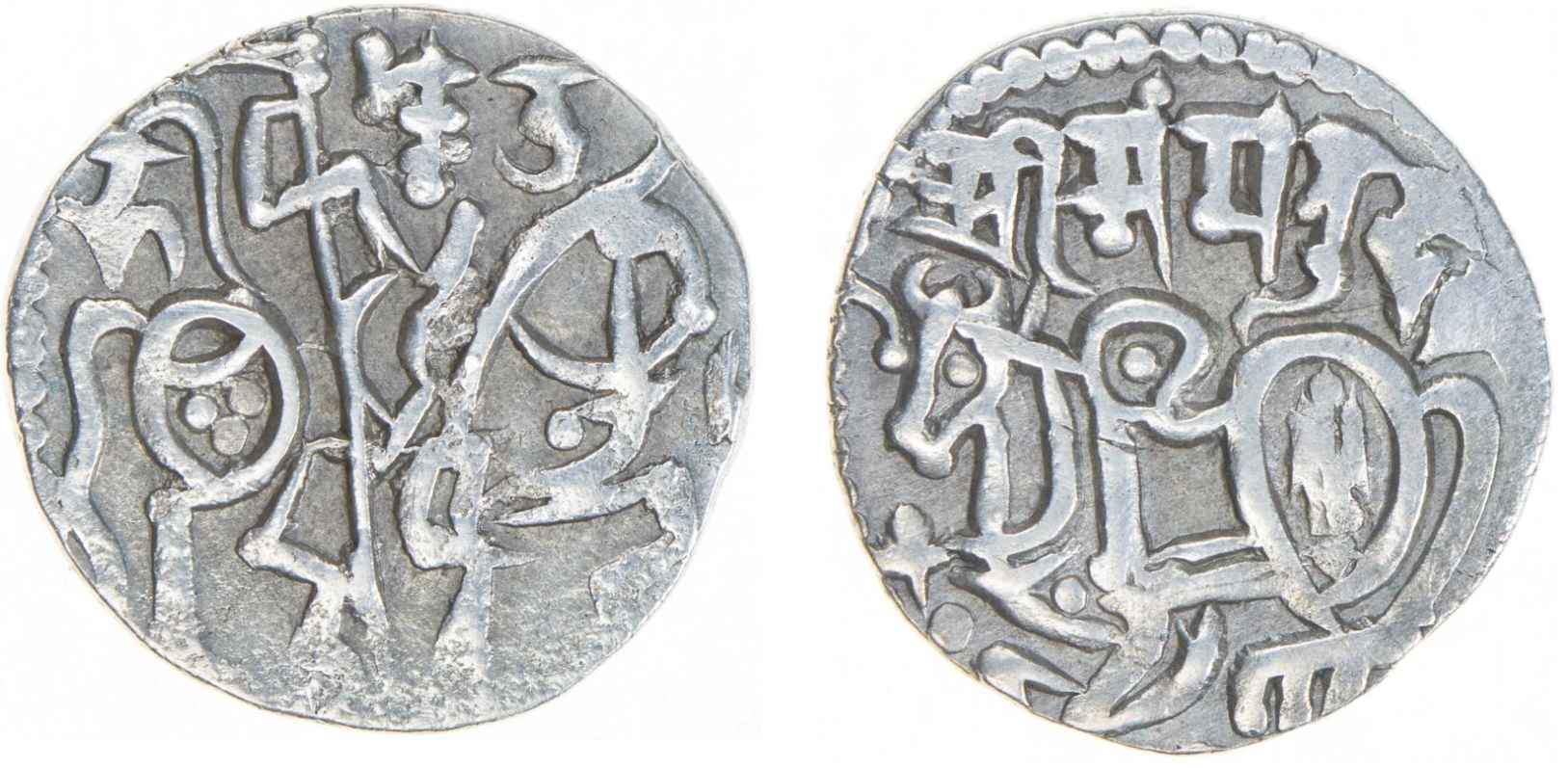 |
Tye#15
Silver Jital.
Year: c. 850 - c. 1000.
Weight: 3.32g.
Metal: Silver.
Diameter:
18.25 mm. Mint:
Gandhara - Ohind. Edge:
Plain.
Alignment:
Rotated.
Obverse:
Horseman riding horse towards right and
holding banner. "टा" (Ta) written in Nagari at the left
side. Hook
symbol at right side. Reverse:
"श्री सामन्त देव" (sri samanta deva) written in Nagari
above Zebu wearing jhula (saddle-cloth). Trident symbol on rump. Star above pellet above crescent. Minted Years:
One year type with various varieties. Ruler:
Samanta Deva. |
|
 |
Tye#21
Silver Jital.
Year: c. 850 - c. 1000.
Weight: 3.23g.
Metal: Silver.
Diameter:
17.75 mm. Mint:
Gandhara - Ohind. Edge:
Plain.
Alignment:
Coin.
Obverse:
Horseman full face riding horse towards right and
holding banner. Reverse:
"श्री सामन्त देव" (sri samanta deva) written in Nagari
above Zebu wearing jhula (saddle-cloth). Trident symbol on rump.
Minted Years:
One year type with various varieties. Ruler:
Samanta Deva. |
|
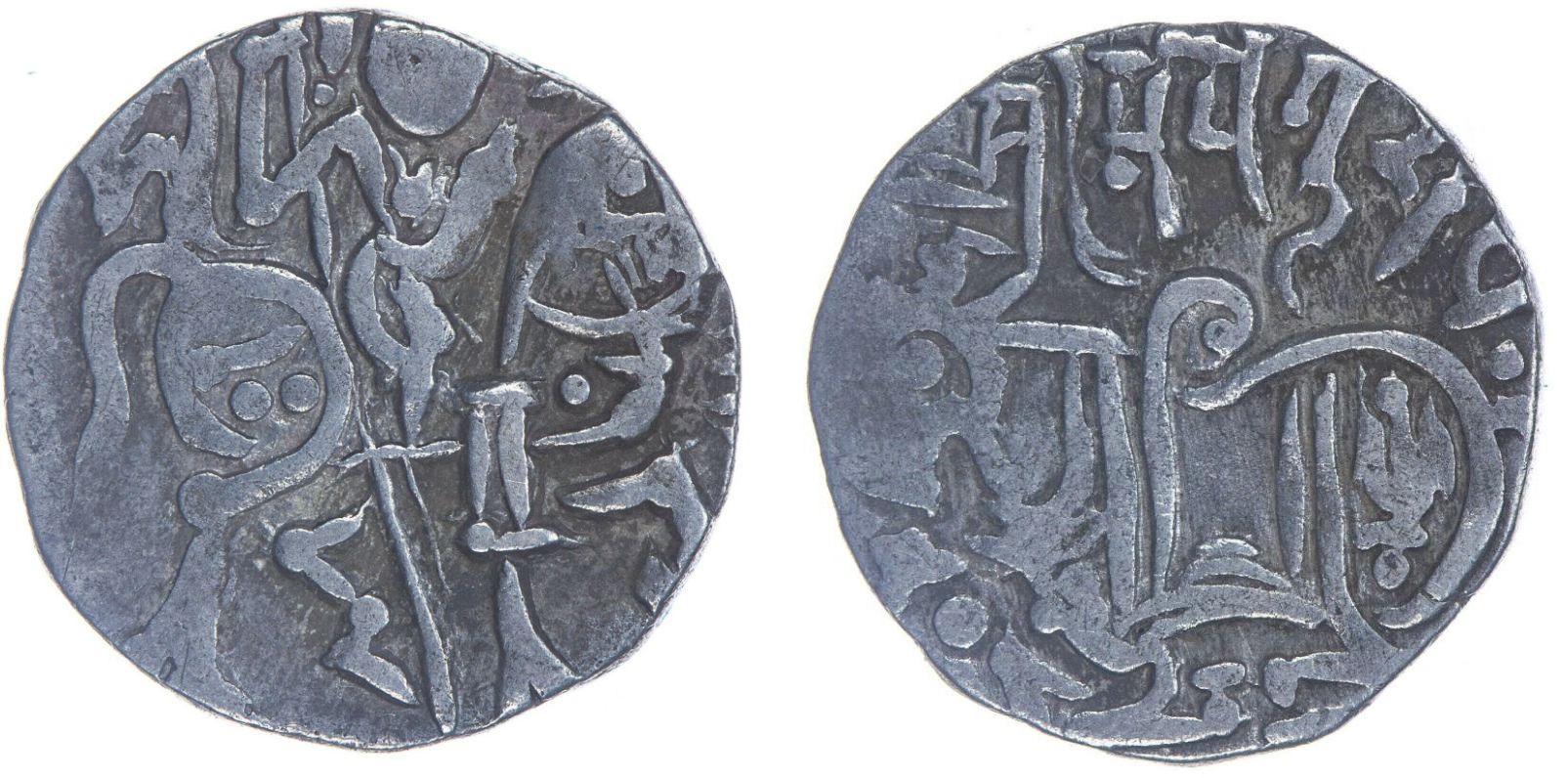 |
Same as above coin, but having different size and position of
legends and images on both sides. This coin is having two dots
instead of three dots on the back part of the Horse.
Weight: 3.25g.
Diameter:
18.50 mm. Alignment:
Rotated (3 o' Clock). |
|
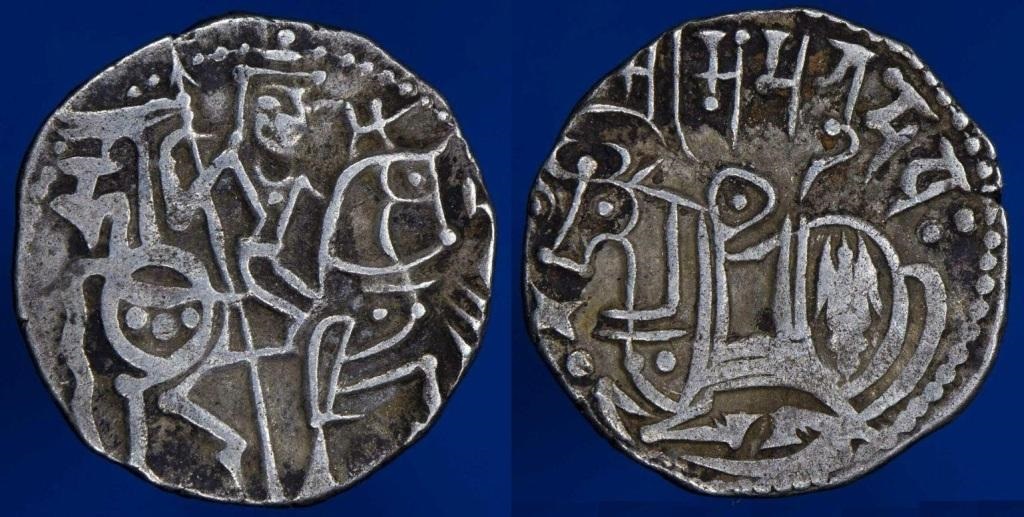 |
Same as above coin, but having full face details.
Weight: 3.32g.
Diameter:
17.50 mm. Alignment:
Rotated (9 o' Clock). |
|
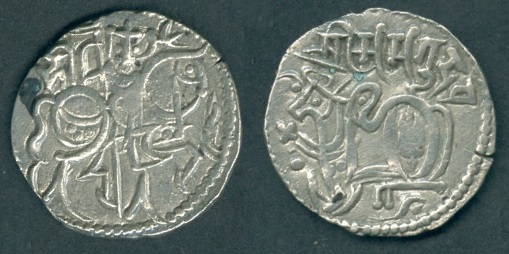 |
Tye#28
Silver Jital.
Year: c. 850 - c. 1000.
Weight: 3.21g.
Metal: Silver.
Diameter:
19.50 mm. Mint:
Gandhara - Ohind. Edge:
Plain.
Alignment:
Coin.
Obverse:
Horseman full face riding horse towards right and
holding banner. Reverse:
"श्री सामन्त देव" (sri samanta deva) written in Nagari
above Zebu wearing jhula (saddle-cloth). Trident symbol on rump.
Minted Years:
One year type with various varieties. Ruler:
Samanta Deva.
Note:
Different symbol at the right side of
horseman's head. |
|
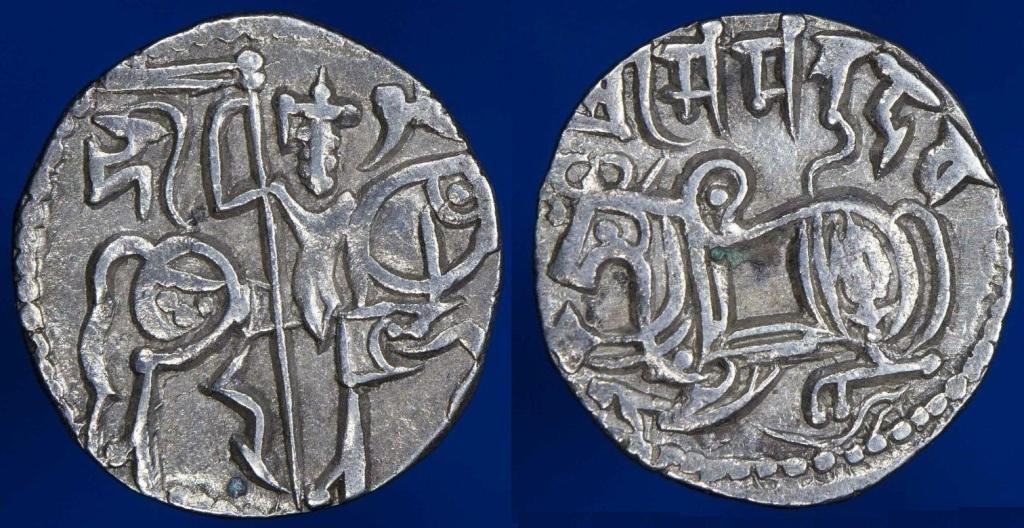 |
Same as above coin, but having thick legends on both sides.
Weight: 3.19g.
Diameter:
18.50 mm. Alignment:
Coin (6 o' Clock). |
|
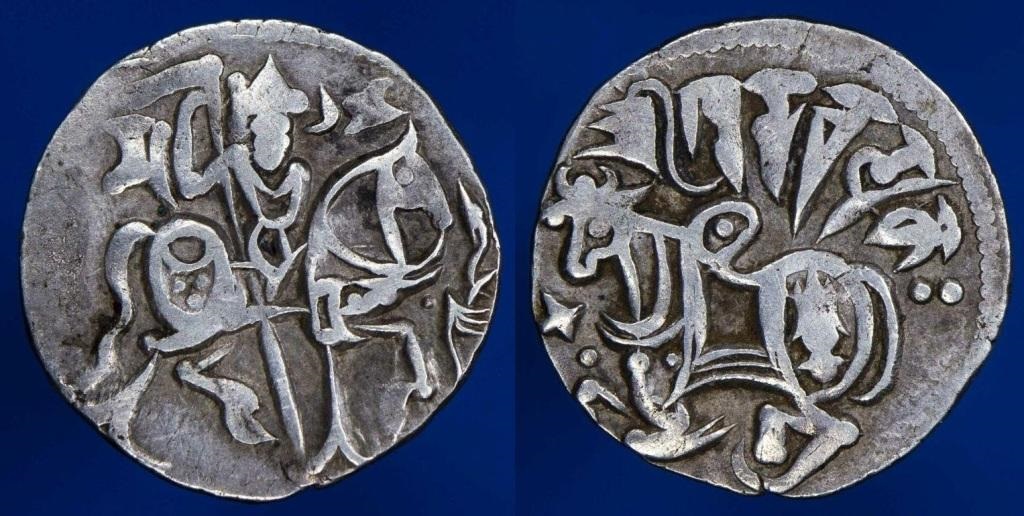 |
Tye#22
Silver Jital.
Year: c. 895 - c. 921.
Weight: 3.09g.
Metal: Silver.
Diameter:
18.50 mm. Mint:
Kabul. Edge:
Plain.
Alignment:
Medal.
Obverse:
Horseman riding horse towards right and
holding banner. Unknown Nagari character written at the left
side. "Adi" (Justice) written at right side. Reverse:
"Sri KhuDaRaYaKaH" written in Nagari
above Zebu wearing jhula (saddle-cloth). Trident symbol on rump. Star above pellet above crescent.
Two dots after Nagari inscription. Minted Years:
One year type with various varieties. Ruler:
Khudarayaka. |
|
 |
Same as above coin
["Adi" (Justice) written at right side on
Obverse side] with minor difference.
Weight: 2.59g.
Diameter:
20.25 mm. Alignment:
Rotated. |
|
Note: Yaqub ibn Layith Saffari, the
founder of the Saffarid dynasty, conquered the Kabul. Kabul Shahis
had built a defensive wall all around the Kabul city to protect it
against the army of Muslim Saffarids. The remains of these walls are
still visible over the mountains which are located inside the Kabul
city. Khudarayaka who ruled c.895 - c. 921 in Kabul under Saffarid
influence is believed to issue these coins. These are not really
rare but seen much less frequently than the common Spalapati and
Samanta coins. There are a few minor variations with different
characters right of the horseman or between the horse's front legs.
Khudarayaka is an epithet used by the governor of Kabul under Yaqub
ibn Layith of Seistan but the exact circumstances of his rule or
issuing coins is unclear.
Following the Islamic conquest of the Hindu Shahi lands one might
expect the end of the bull and horseman coins but that was not the
case. The coins were well established in the region as the
definition of good money so Muslim rulers continued the issue of
bull and horseman varieties for a few more centuries (at least to
1300 A.D.) Our group of ten examples is not by any means a complete
set. Most amazing to me is that the weight standard remained rather
constant with most coins weighing 3.0-3.5g. Diameter, however, was
reduced mostly resulting in rather thick 14 to 16mm coins. Over
time, silver quality fell from the early level around 69% to 18% and
finally to a billon with so little silver that the coins appear to
be copper. These later rulers were less shy about placing their
names on the coins so, unless the language is a barrier, it is
possible to attribute at least those coins well enough centered to
bear significant parts of the legends. |
|
|
|
- BALKH
A small town in northern
Afghanistan, before the 13th century one of the largest and most important
centers of the region. The place is most likely the ancient city of Baktra, the
capital of the Kingdom of Bactria. A center of Islamic culture in the Middle
Ages, the city was pillaged by Ghenghis Khan and never recovered. It about 20
kilometers northwest of the provincial capital, Mazar-e Sharif. A minor
dynasty was established in eastern Khorasan in the Panjsher valley and
adjoining regions.
- BANIJURID (ABU DAWUD)
- Dawud................................................848 - 873
- Abu Dawud Muhammad
ibn Ahmad ........................874 - 899
- Said ibn Shuayb (rebel)..............................883
- 887
- He is known for
producing coins from Andaraba exclusively.
- Ahmad ibn Muhammad...................................899 - 910
- Jafar ibn
Ahmad (al-Khuttal).........................922 - 925
- Banu FARIGHUN
- An Arab Muslim
dynasty in western Afghanistan at Guzgan and Balkh.
- Ahmad ibn Farighun................................c.
908 - 949
- Abu-Nasr
Mohammed....................................949 - 979
- Abu'l-Harith
Ahmad...................................979 - 1011
|
|
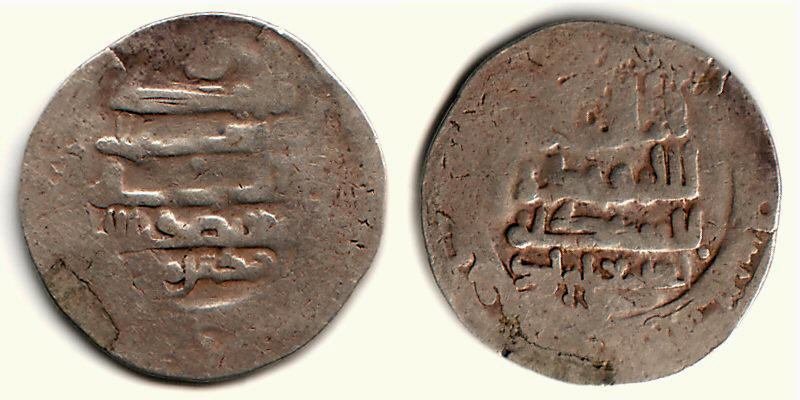 |
SA#1435 Dirham. Year:
circa AH 286-289
[c.900 - c.908 CE]. Weight:
3.34g. Metal:
0.825 Silver.
Diameter: 18.50 mm. Edge:
Plain. Alignment:
Rotated. Mint:
Andaraba. Ruler:
Ahmad ibn Muhammad (899 - 910 CE).
Banijurid (Abu Da'udid) ruled Balkh [Andaraba and
Banjhir (Panjsher) areas]. Ahmad is sometimes cited Abu Ibrahim.
After AH 290, all coins cite the Samanid ruler as overload. |
|
| |
- Central Afghanistan to
Bokhara............................900 - c. 950
- Abu Bakr Lawik (1st
time)..............................c.
950 - 962
- Ibrahim ibn Abd al-Ghaffar Yaminid (Ghazna)............c. 949 -
c. 956
- Bokhara................................................c.
962 - c. 964
- Alptigin Yaminid (Ghazna,
then under
Bokhara's rule).954 - 963
- (Abu-) Ishaq Yaminid (1st
time)......................963
- ?
- Abu Bakr Lawik (2nd
time).......................................fl
960's
- Bokhara................................................c.
965 - 999
- Slave Commanders for the Samanids
- Yaminid dynasty.
- (Abu-) Ishaq
Yaminid (2nd
time)......................965
- 966
- Balkatekin..........................................
966 - 975
- Mansur ibn Balkatekin (1st
time at Ghazna).................969
- Piri.................................................975
- 977
- Nasir
al-Dawla Sebüktigin.....................20 Apr 977 - 05 Aug 997
- Sabuktigin lived as a slave during his youth
and later married the daughter of his master Alptigin, the man who
seized the region of Ghazna (modern Ghazni Province in Afghanistan).
When his father-in-law Alptigin died, Sebuktigin became the new ruler
and expanded the kingdom after defeating Jayapala to cover the territory
as far as the Neelum River in Kashmir and the Indus River in what is now
Pakistan.
- Mansur ibn Balkatekin (2nd
time at Ghazna)........c. 977 - 983
- Ismail ibn Sebüktekin.........................05
Aug 997 - 998
- He reigning for 7 months. He succeeded his
father Sabuktigin, who died of an illness acquired in Balkh during a
campaign in the Samanid civil war. Ismail was designated his successor
by Sabuktigin on his death-bed, while Mahmud, the older brother who was
involved in the Samanid civil war, was stationed in Nishapur.
- GHAZNAVID EMPIRE (YAMINID
Dynasty)
- The capital of this Empire was Ghazna, now called
Ghazni, is a town in eastern Afghanistan, about 128 kilometers southwest of
Kabul, on the road to Qandahar.
- Yamin Al-Dawla
Abu'l Qasim Mahmud ibn Sebüktekin..........998 -
30 Apr 1030
- Upon receiving these news
Mahmud, contested Ismail's right to the throne and divested his charge of
Nishapur to his uncle Borghuz and younger brother Nur-ud-Din Yusuf and
marched upon Ghazna. Mahmud won the Battle of Ghazni and took the crown from
Ismail. Ismail spent the rest of his life confined to a fort in Guzgan.
Mahmud was a Samanid governor in
western Khorasan under Nuh II from 994 to 997, then under Mansur II. Yaminid
dynasty started in 999 CE. He declared himself as Sultan in 1002. He is well known for his seventeen attacks on
India. He attacked the holy cities like Thaneshwar, Mathura etc. In his
seventeenth raid he plundered Somnath Temple (located in Prabhas Patan near
Veraval in Saurashtra on the western coast of Gujarat) and got as much money
as he had got in his past sixteen raids.
- Nasr ibn Sebuktekin (Sistan).............................1010
- 1022
- Jalal al-Dawla Abu
Ahmad Muhammad ibn Mahmud (1st
time).........1030
- He was the younger of a set
of twins of Mahmud; this circumstance resulted in civil strife. His reign
lasted five months before he was overthrown by his twin Ma'sud I, after
which he was blinded and imprisoned. Nine years later he was reinstated for
a year before being slain by his nephew Maw'dud.
- Nasir Din Allah
Abu Said Masud I ibn Mahmud..............1030 - 1041
- Mas'ud, asked for three
provinces that he had won by his sword, but his brother did not consent.
Mas'ud had to fight his brother, and he became king, blinding and
imprisoning Mohammed as punishment. Mas'ud was unable to preserve the empire
and following a disastrous defeat at the Battle of Dandanaqan in 1040, he
lost all the Ghaznavid lands in Iran and Central Asia to the Seljuks,
plunging the realm into a "time of troubles".
- Jalal al-Dawla Abu
Ahmad Muhammad ibn Mahmud
(2nd time).........1041
- Shihab al-Dawla
Abu'l-Fath Mawdud ibn Masud I............1041 - 1049
- He was the governor of Balkh, and in 1040, after hearing of his
father's death, came to Ghazni to claim his kingdom. He fought with the sons
of the blind Mohammed and was victorious. However, the empire soon
disintegrated and most kings did not submit to Mawdud. In a span of nine
years, four more kings claimed the throne of Ghazni.
- Masud II ibn
Mawdud.............................................1049
- Baha ad-Dawlah Ali
ibn Masud I...........................1049 - 1050
- Izz al-Dawla Abd al-Rashid
ibn Mahmud....................1050 - 1052
- He was the fifth son of
Mahmud.
- Qiwan al-Dawla
Abu Said Toghril (Usurper).......................1053
- He was a Turkish mamluk
slave general. He usurped the Ghaznavid throne after massacring Abd
al-Rashid and eleven other Ghaznavid princes. With Ghazna under his control,
Toghrul sent letters to the ghulam general Kirghiz, commander of the
Ghaznavid forces in India, seeking his support. Kirghiz responded by
condemning Toghrul and his massacre of the Ghaznavid princes. Meanwhile,
Toghrul married Masud I's daughter to legitimise his reign and started
minting coins. Despite this, Kirghiz sent letters to the garrison and army
commanders which motivated a ghulam (slave) named Nushtigin to murder
Toghrul. By the time Kirghiz and his army arrived, Toghrul's head was being
paraded around Ghazna.
- Jamal al-Dawla
Abu Shuja Farrukhzad ibn Masud I..........1053 - 04 Apr 1059
- He was very devout Muslim
and fasted during Rajab, Sha'ban and Ramadan. In 1058, palace ghulams
(slaves) attempted to assassinate Farrukhzad in his bath, but he grabbed a
sword and held them at bay until his guards arrived and killed the ghulams.
Depressed and sickened by the attempt on his life, Farrukh-Zad withdrew from
worldly affairs and died of colitis on 04 April 1059 at the age of thirty
four. He was succeeded by his brother Ibrahim.
- Zahir (or Nasir) al-Dawla Ibrahim
ibn Masud I.....06 Apr 1059 - 25 Aug 1099
- In 1059, Mas'ud's son
Ibrahim, a great calligrapher who wrote the Koran with his own pen, became
king. Ibrahim re-established a truncated empire on a firmer basis by
arriving at a peace agreement with the Seljuks and a restoration of cultural
and political linkages. Having been imprisoned at the fortress of Barghund,
he was one of the Ghaznavid princes that escaped the usurper Toghrul's
massacre in 1052. Following Farrukhzad's death, Ibrahim was recognized as
the last surviving male Ghaznavid. A military escort was sent to fetch him
from fortress Nay and he entered Ghazna on 06 April 1059. Ibrahim's reign
was considered a golden age for the Ghaznavid empire, due to the treaties
and cultural exchanges with the Great Seljuq empire. He raids across Northern India, where it faced stiff
resistance from Indian rulers such as the Paramara of Malwa and the
Gahadvala of Kannauj. Ibrahim died on 25 August 1099 ending a reign of 41
years. His tomb lies in the northeastern part of medieval Ghazna near Shaikh
Radi d-Din 'Ali Lala's tomb.
- Ala al-Dawla
Abu Said Masud III ibn Ibrahim..............1099 - 1115
- Masud III became king for
sixteen years, with no major event in his lifetime. Signs of weakness in the
state became apparent when he died in 1115, with internal strife between his
sons ending with the ascension of Sultan Bahram Shah as a Seljuk vassal.
- Kamal ad-Dawlah Shirzad ibn
Masud III....................1115 - 1116
- He was murdered by his
younger brother Arslan.
- Sultan Baha al-Dawla
Malik Arslan
Shah ibn Masud III.....1116 - 1117
- Yamin al-Dawla Bahram
Shah ibn Masud III..........25 Feb 1117 - 1152
- Bahram shah defeated his
brother Arslan for the throne at the Battle of Ghazni in 1117 supported by
the sultan of the Great Seljuq Empire, Ahmad Sanjar. In 1148 he
was defeated in Ghazni by Sayf al-Din Suri, but he recaptured the capital
the next year. Ala al-Din Husayn, a Ghorid King, conquered the city in 1151,
for the revenge of his brother Kutubbuddin's death, who was son-in-law of
the king but was publicly punished and killed for a minor offence. Ala
al-Din Husayn then razed the city and burned it for 7 days, after which he
became known as "Jahānsuz" (World Burner). Ghazni was restored to the
Ghaznavids by the intervention of the Seljuks, who came to the aid of Bahram.
Ghaznavid struggles with the Ghurids continued in subsequent years as they
nibbled away at Ghaznavid territory, and Ghazni and Zabulistan was lost to a
group of Oghuz Turks before captured by the Ghurids.
- Muizz al-Dawla Khusrau Shah
ibn Bahram Shah..............1152 - 1160
- Taj al-Dawla Khusrau Malik
ibn Khusrau Shah..............1160 - 1187
- Ghaznavid power in
northwestern India continued until the Ghurid conquest of Lahore from
Khusrau Malik in 1186. His silver Dirham, normally
of Ghazna types have three laqabs progressively; first Taj al-Dawla, then
Siraj al-Dawla then Abu'l-Muluk. In 1061-1062, a group of Oghuz Turks seized
the Ghaznavid capital of Ghazna, forcing Khusrau Malik to retreat to Lahore,
which became his new capital. From there he made incursions into northern
India, expanding his rule as far as southern Kashmir. He also created an
alliance with the Indian Khokar tribe. In 1170, Khusrau (or one of his
commanders) invaded the southern part of the Ganges. In 1178 the Ghurid
ruler Mu'izz al-Din Muhammad invaded the southern part of Ghaznavid Punjab
and reached as far as Gujarat. In 1179-1780 he seized Peshawar, and by
1181-1182 swept around Lahore, but Khusrau Malik managed to keep him from
the city by paying him. However, Lahore was finally captured by the Ghurids
in 1186, while Khusrau-Malik and his son Bahram-Shah were taken to Ghur and
imprisoned, marking the end of the Ghaznavid Empire.
|
|
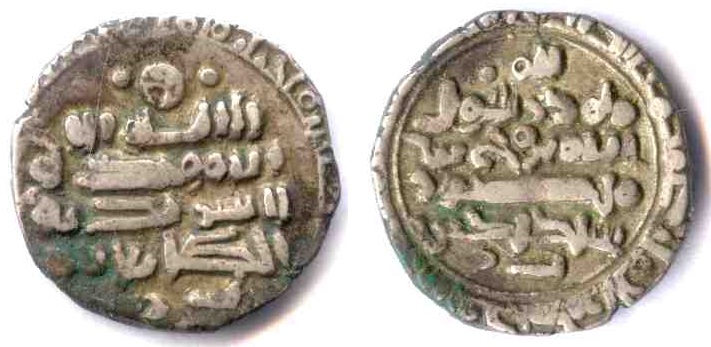 |
SA#1599. Dirham. Year:
977-997. Weight:
3.85g.
Metal: 0.825 Silver.
Diameter: 17.00 mm. Edge:
Plain. Alignment:
Rotated.
Mint: Farwan. Ruler: Nasir al-Dawla
Sebuktekin [Sebüktigin] (977-997). Common type.
Ruled Bust and Gardez. Also became as autonomous ruler in Ghazna from
AH 373 (984 CE) but cited Samanid ruler Nuh II ibn Mansur as overlord on
his coinage as indicated on this particular coin. Sebüktigin was the
son-in-law of Alptigin. |
|
 |
SA#1605 / SNAT Ghazna 751-756. Dirham. Year:
ND (AH 387-389) [997-999]. Weight:
2.37g.
Metal: 0.825 Silver.
Diameter: 17.50 mm. Edge:
Plain. Alignment:
Rotated (9 o' clock).
Mint: Farwan. Ruler:
Sayf al-Dawla Mahmud (997-999). Common type.
Sayf al-Dawla Mahmud became as autonomous
ruler in Ghazna as a vassal of Samanid. Therefore he cited Samanid
ruler Samanid Mansur ibn Nuh on his coins during 997-999. |
|
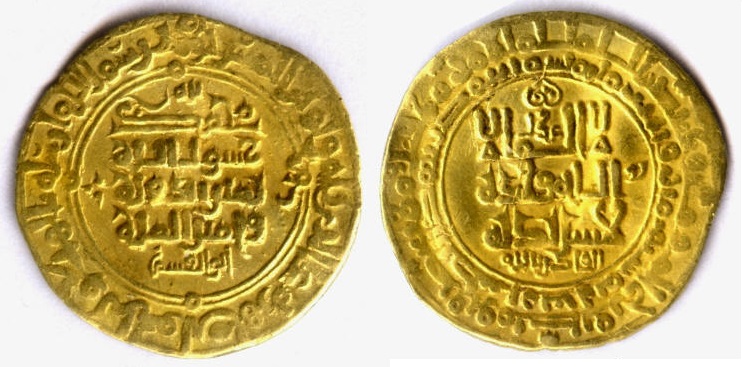 |
SA#1607. Dinar. Year:
AH 408 (1017 CE).
Weight: 3.70g.
Metal: 0.900 Gold. Mint: Ghazna.
Ruler: Mahmud Ghaznavid
(998-1030).
Common
type.
Gold Dinars coins were minted at Herat from AH 389 to 421 and at
Ghazna from AH 406 to 421. The gold alloy is generally rather good until
about AH 408 and becomes increasingly pale thereafter. |
|
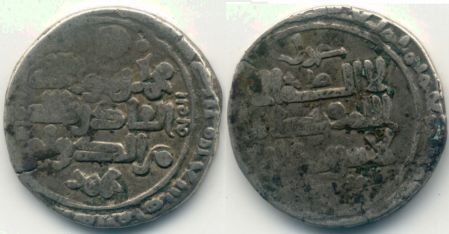 |
SA#1608. Dirham. Year:
AH 389 (999 CE). Weight:
3.40g.
Metal: 0.825 Silver.
Mint:
Andaraba. Ruler: Mahmud Ghaznavid
[Sayf
wa Yamin ad-Dawlah Abd al-Qasim Mahmud ibn Abu Mansur Sebük Tigin (Sebuktekin)
Khan]. Note:
Sword in obverse field. Extremely common type. |
|
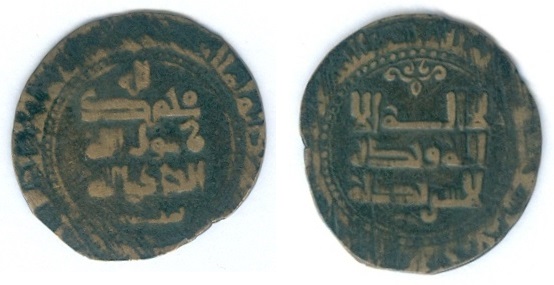 |
Yamini Fals.
Year: ND (998-1030). Weight: 2.15g.
Metal: Copper.
Diameter: 21.50 mm. Edge:
Plain. Alignment:
Rotated (11 o'clock). Mint:
N/A. Ruler: Mahmud Ghaznavid. |
|
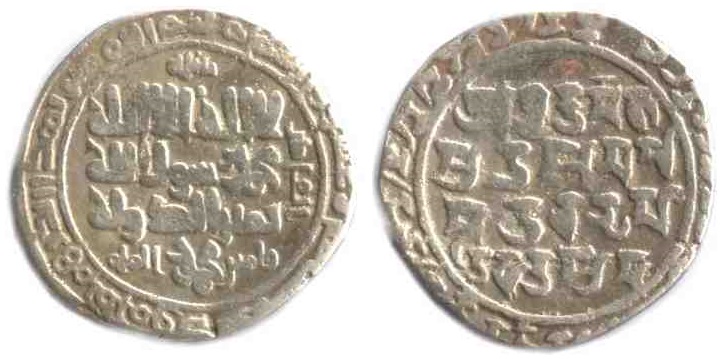 |
SA#1610 / SG#GZ4. Dirham.
Year: AH 418 (1027
CE). Weight: 2.52g.
Metal: 0.825
Silver.
Diameter: 18.50 mm. Edge:
Plain. Alignment:
Rotated. Mint: Mahmoodpur
(Lahore). Bilingual script in Sanskrit and Arabic,
"billah" is above Shahada and "al-qadir" at the right. Ruler:
Mahmud Ghaznavid (998-1030).
Similar bilingual coin were was struck in year AH
419, dated in words in Arabic and in ciphers in Sanskrit.
Rare type. |
|
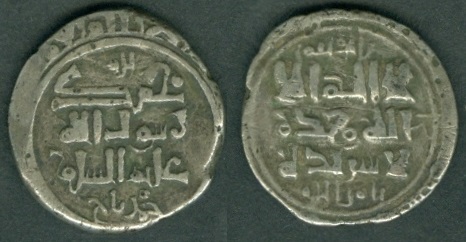 |
SA#1617. Dirham.
Year: AH 421 (1030 CE).
Weight: 3.44g.
Metal: 0.825 Silver.
Diameter: 18.00 mm. Edge:
Plain. Alignment:
Rotated. Mint:
Balkh.
Obverse: "Muhammad
Balkh" written at the bottom under "Alaihi Wassalam". Ruler:
Jalal al-Dawla Abu Ahmad Muhammad ibn Mahmud
(1030).
No coins were issued in his second reign in AH 432 (1041 CE).
Rare type. |
|
 |
SA#1617. Dirham.
Year: AH 421 (1030 CE).
Weight: 3.25g.
Metal: 0.825 Silver.
Diameter: 18.50 mm. Edge:
Plain. Alignment:
Rotated. Mint: Ghazna.
Ruler:
Jalal al-Dawla Abu Ahmad Muhammad ibn Mahmud
(1030). |
|
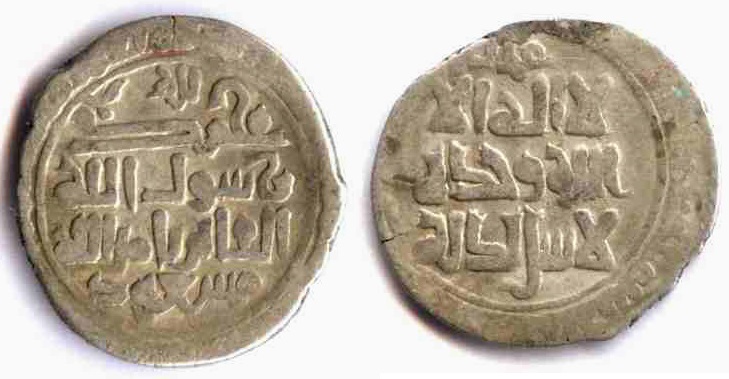 |
SA#1621. Dirham.
Year:
1030-1041. Weight: 2.70g.
Metal: 0.825 Silver.
Diameter: 21.00 mm. Edge:
Plain. Alignment:
Rotated. Mint: Ghazna.
Ruler: Nasir Din Allah (or
Nizam al-Din) Abu Said Masud ibn Mahmud (1030-1041).
Date and Mint: off flan, but
known to be struck at Ghazna.
Abundant type. This coin has Masud's name without titles but also citing
Caliph Al-Qaim. |
|
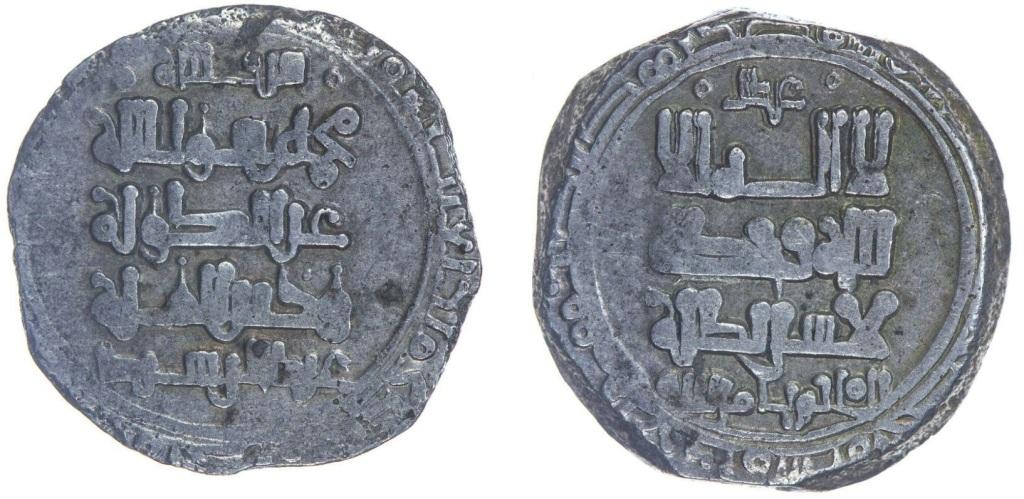 |
SA#1630. Dirham. Year:
1050 - 1052.
Weight: 3.78g.
Metal: 0.825 Silver.
Diameter: 18.00 mm. Edge:
Plain. Alignment:
Rotated (9 o'clock). Mint:
N/A.
Ruler:
Izz al-Dawla Abd al-Rashid ibn Mahmud (1050 -
1052). |
|
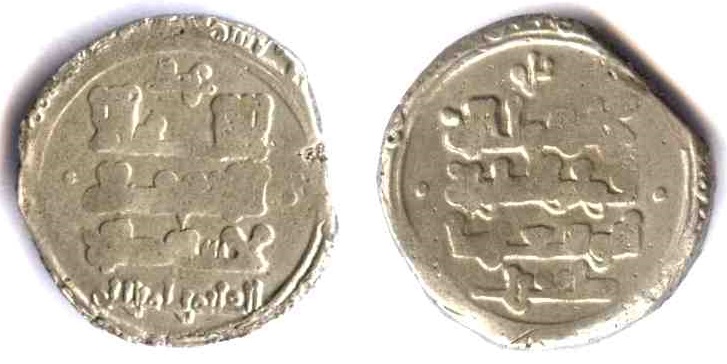 |
SA#1632. Dirham. Year:
1053.
Weight: 3.67g.
Metal: 0.825 Silver.
Diameter: 18.50 mm. Edge:
Plain. Alignment:
Rotated. Mint: Ghazna.
Ruler:
Qiwan al-Dawla Abu Said Tughril [AH 443-444 (1053 CE)]
citing Caliph: Abbasid Al-Hakim. He is known as a usurper at Ghazna during Ghaznavid
Empire.
Very rare type. |
|
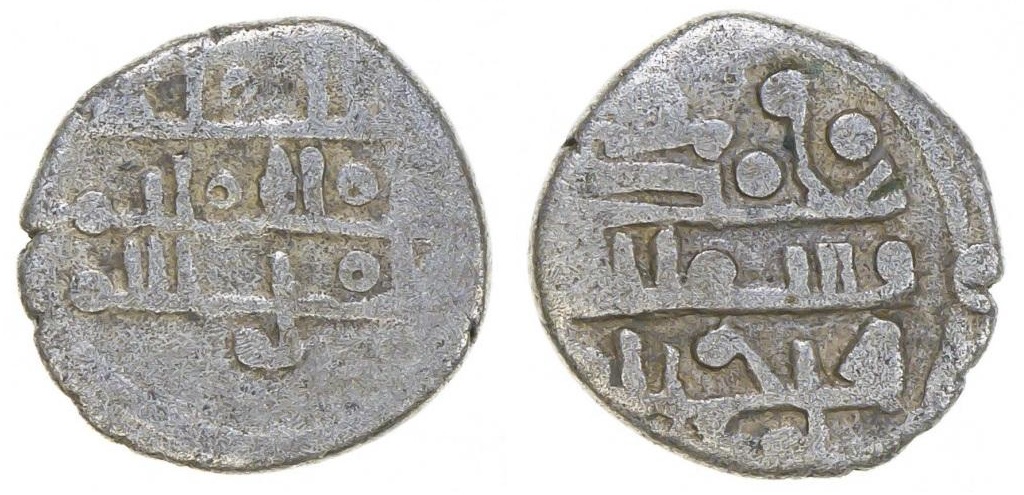 |
SA# 1636 / Fishman & Todd GH22.3. Damma
(Fractional Dirham).
Year:
1053-1059. Weight:
0.32g.
Metal: Much debased
Silver.
Diameter: 8.75 mm.
Alignment:
Medal. Mint:
N/A.
Obverse:
"La ilah illa Allah wahadahu la sharik lahu"
(There is no God but Allah alone, no partner to him).
Reverse:
"Lillah Muhammad rasul Allah Farrukhzad" (In
God, Muhammad is the messenger of God, Farrukhzad). Ruler:
Jamal al-Dawla Abu Shuja Farrukhzad ibn Masud
I (1053-1059). Scarce type. |
|
Note:
This coin was issued to be used in Sindh.
Farrukhzad's Sindh Damma coins are listed into five main varieties
based on the border design on Obverse and Reverse sides of the coin
+ two more varieties based on the legends position and size. |
|
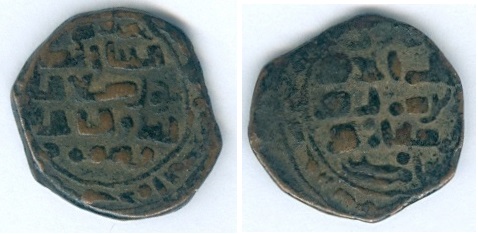 |
Fals.
Year: ND (1099 - 1115). Weight:
3.30g.
Metal: Copper.
Diameter: 18.50 mm. Edge:
Plain. Alignment:
Rotated (11 o'clock). Mint:
Ghazna. Ruler:
Ala al-Dawla Abu Said Masud III ibn Ibrahim. |
|
Bahram Shah
coinage (1117-1152) |
|
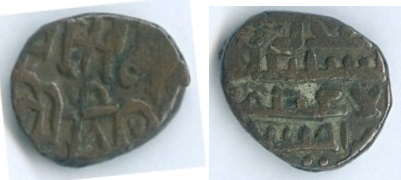 |
SA# 1655 / SG# GZ47 / R# 1937 / D# 107 / Tye# 110. Jital.
Year:
1118-1152. Weight:
3.35g.
Metal: Bronze.
Diameter: 14.15 mm.
Alignment:
Medal. Mint:
Lahore. Obverse:
Stylisted bull to left and "श्री साम" (Sri
Sama) written
above. Reverse: adl al-sultan al-azam
bahram shah. Ruler:
Yamin Al-Daula Bahram Shah (1117-1152).
Common type.
Note: On some coins, the mim of
bahram is joined to shah. |
|
 |
SA# 1658 / SG# GZ49 / R# 872 / Tye# 111.1-4. Jital.
Year:
1118-1152. Weight:
2.94g.
Metal: Bronze.
Diameter: 12.50 mm.
Alignment:
Rotated (9 o' clock). Mint:
N/A. Obverse:
Stylisted bull to left and "श्री साम" (Sri
Sama) written
above. Reverse: "yamin
or yamini" written within rayed circle. Ruler:
Yamin Al-Daula Bahram Shah (1117-1152). Scarce type. |
|
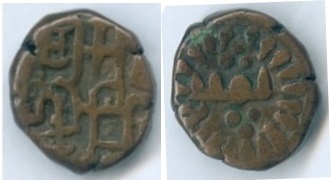 |
Another variety of the above coin but "yamin or yamini" on the
Reverse side written without rayed circle. Weight:
3.51g.
Diameter: 13.50 mm.
Alignment:
Rotated (7 o' clock). Mint:
N/A. Perhaps rare
type. |
|
Khusru Shah
coinage (1152-1160) |
|
 |
SA# 1660 / SG# GZ55 / R# 1938 / D# 108 / Tye# 113. Jital.
Year:
1152-1160. Weight:
3.30g.
Metal: Bronze.
Diameter: 15.25 mm.
Alignment:
Rotated (3 o'clock). Mint:
Lahore. Obverse:
Stylisted bull to left and "sri sama" written
above. "Khair" (excellent, superior) written on bull.
Reverse: al-sultan al-azam
mu'izz al-dawla khusru shah. Ruler:
Mu'izz Al-Daula Khusrau Shah (1152-1160).
Scarce type. |
|
Khusru Malik
coinage (1160-1187) |
|
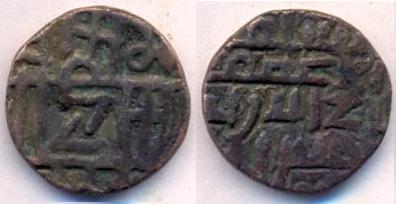 |
SA# 1663 / SG# GZ61 / D# 110 / Tye# 119. Jital.
Year:
1060-1087. Weight: 2.97g.
Metal: Bronze.
Diameter: 16.00 mm.
Mint:
Lahore. Obverse:
geometric design on bull to the left without "Khair"
written on bull. "sri sama" written above.
Reverse: al-sultan al-azam taj al-dawla khusru malik. Ruler:
Taj al-Dawla Khusrau Malik (1160-1187). Abundant type.
Geometric design on bull instead of "khair" type. |
|
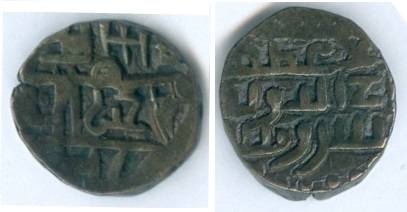 |
Same as above coin, but the legend size and position differ. Weight:
3.32g. Diameter: 15.00 mm.
Alignment:
Rotated (3 o'clock). |
|
 |
Same as above coin, but the legend size and position differ. Weight:
3.29g. Diameter: 14.00 mm.
Alignment:
Rotated (1 o'clock). |
|
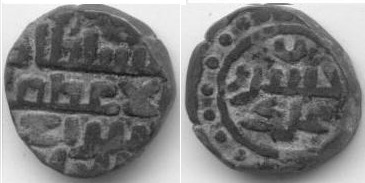 |
SA# 1664 / SG# GZ64 / D# 115 / Tye# 120.3. Jital.
Year:
1060-1087. Weight: 3.28g.
Metal: Bronze.
Diameter: 16.00 mm.
Mint:
Lahore. Obverse:
al-sultan al-azam siraj al-dawla.
Reverse:
crescent
above "Khusrau Malik"
written within center
circle surrounded by dotted circle.
Ruler:
Taj al-Dawla Khusrau Malik (1160-1187). Abundant type.
Crescent instead of Star type at the top on Reverse side. |
|
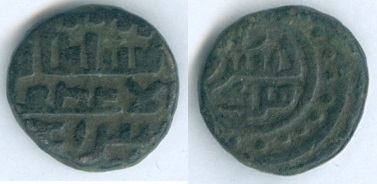 |
Same as above coin but the Crescent is upside down. Weight: 3.17g.
Diameter: 14.00 mm.
Alignment:
Medal. |
|
 |
SG# GZ65 / D# 114a / Tye# 120.1. Jital.
Year:
1060-1087. Weight: 3.25g.
Metal: Bronze.
Diameter: 14.00 mm.
Alignment:
Medal. Mint:
Lahore. Obverse:
al-sultan al-azam siraj al-dawla.
Reverse:
"Khusrau Malik"
written within center
circle surrounded by dotted circle.
Ruler:
Taj al-Dawla Khusrau Malik (1160-1187).
Scarce type. No symbol at the top on Reverse side. |
|
| |
- SELJUQ at HERAT
- Al Malik Al Adil Musa Bayghu [Yabghu](Herat & Sistan)....1043 - 1056
- Alp Arslan Argun.........................................1058 - 1072
- Local Governor of Herat from 1058 to 1063, later
Sultan.
- Toghanshah (Marw
& Herat)................................1072 -
c. 1082
|
|
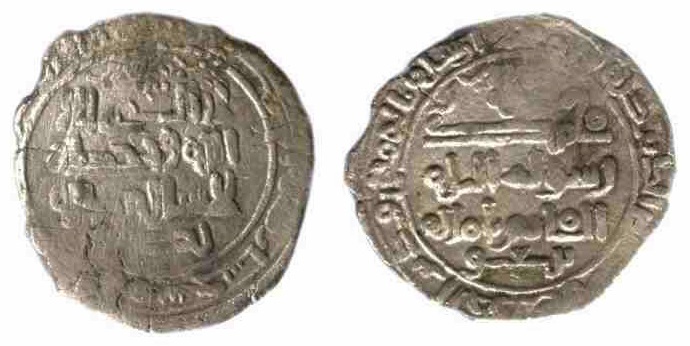 |
SA#1669A. Billion Dirham.
Year:
1043-1056. Weight: 2.20g.
Metal: 0.250 Silver. Diameter: 22.30 mm. Edge:
Plain. Alignment:
Rotated. Mint: Sistan
(Sijistan).
Ruler:
Al Malik Al Adil Musa Bayghu [Yabghu]
citing Caliph: Al-Qaim
Bi'am'rallah / Nasr. Minted Years:
1043-1056.
This
coin in my collection is frequently cutting into small pieces from the
edge due to strong corrosion.
Extremely rare type. |
|
| |
- GHURID EMPIRE
(SHANSABANI Dynasty)
Sultan Bahram tried to reorganize the control but that leaded to the sack of Ghazna by the Shansabani in
1150.
- Nominaly to the
Seljuqs...................................1090's - c. 1148
- Malik Saif-ud-din Sām
bin Hussain...........................1146 - 1149
- Malik Baha-ud-din Sām
bin Hussain..................................1149
- Father of Ghiyath ud-Din and Shihab ud-Din (The famous
Muhammad Ghuri). He was with his brother Saif ud-Din Suri in during the
initial defeat of Bahram Shah and occupation of Ghazni during spring of 1148
AD, but he left for Ghor before the arrival of winter/snow.
- Jahan-Suz
[World burner]
Ala-ud-din Hussain bin
Hussain......1149 - 1161
- Qandahar was apparently established c. 1160 by the
Ghurid ruler Alauddin Jahan-Suz after the destruction of Bust, although the
first unambiguous reference to the place dates from 1281. Alauddin Jahan-Suz struck upon Ghazni in 1149 AD, surprising the
Ghaznavid forces. Occupied Ghazni and gave up the city to plunder after
executing all those who could be captured including women folk. Even the
tombs of the Ghaznavid Sultans except Mahmud, Masud and Ibrahim were
desecrated and the remains of the Sultans put to fire. Bahram Shah escaped
and also solicited the help of his maternal uncle the Seljuq Sultan Sanjar.
In the meantime Alauddin occupied Balkh and Heart from Sanjar [1118-1157 AD
(511-552 AH)], but was defeated, captured and later restored when Sanjar was
himself taken prisoner by the Ghuzz Turks. He died in AH 551 and was
succeeded by his only son Saif ud-Din, who died within a period of 1 ˝ years.
The throne then passed on to the joint rule of Ghiyath ud-Din and Shihab ud-Din.
(The famous Ghuri Brothers who annexed Punjab and defeated the kings of
India).
- Malik
Saif-ud-din Muhammad bin Hussain.......................1161 - 1163
- Sultan Abul-Fateh
Muhammad Shams ad-din bin Sam
(Firuzkuh)...1163 - 1203
- He was also known as Ghiyath ud-Din Muhammad ibn Sam on
his later coinage.
-
Muizz al-Din Muhammad ibn Sam (Ghazna).......................1173 - 1206
-
He took the title as
Sultan Shahāb-ud-din Muhammad
Ghori. Before 1160, the Ghaznavid Empire
covered an area running from central Afghanistan to the Punjab, with
capitals at Ghazni and Lahore. In 1160, the Ghorids
conquered Ghazni from the Ghaznavids and in 1173 Muhammad Shahab ud-Din Ghori
became governor of the province. In 1186-1187 he conquered Lahore, ending the Ghaznavid Empire and bringing the last of Ghaznavid territory under his
control. Muhammad Shahab ud-Din Ghori was a loyal brother. He refrained from
declaring his independence in South Asia, knowing that it would result in
civil war between the two brothers. Till the death of Ghiyas-ud-din Muhammad
in 1203, Ghori never considered himself anything but a general in his
brother's army. After every victory he would send the best of the looted
items to his elder brother in Firuzkuh. Ghiyas-ud-din reciprocated never
interfering in the affairs of his younger brother. Thus they were each able
to concentrate on their own responsibilities. As a result, Ghori managed to
push permanent Muslim rule much further east than Mahmud Ghaznavi did.
Muhammad Shahab ud-Din attacked the north-western regions of the Indian subcontinent many
times. The first time he was defeated in the First Battle of Tarain in
present-day Haryana, India by Prithviraj Chauhan. Though Ghori's main aim
was the expansion of his empire, he also took an interest in the
patronization of education and learning. Illustrious Muslim philosopher
Fakh-ud-din Razi and the well know poet Nizami Aruzi were few of the big
names of his era. -
Break up of the Ghurid Empire
under Turkic slaves: Qutb-ud-din Aibak becomes ruler of Delhi in 1206,
establishing the Sultanate of Delhi; Nasir-ud-Din Qabacha became ruler of
Multan in 1210; Tajuddin Yildiz became ruler of Ghazni; Ikhtiyar Uddin
Muhammad bin Bakhtiyar Khilji became ruler of Bengal; the actual Ghurid
dynasty divided into two groups, one under Mahmud bin Ghiyāṣ-ud-din Muhammad
bin Sam who succeeded his uncle Muhammad of Ghor in possession of Ghor,
Herat, Sistan and eastern Khorasan with his capital at Firuzkuh the other
family group under Jalal-ud-din Ali bin Sam at Bamiyan with possession of
Tukharistan, Badakhshan, Shughnan, Vakhsh and Chaghaniyan.
|
|
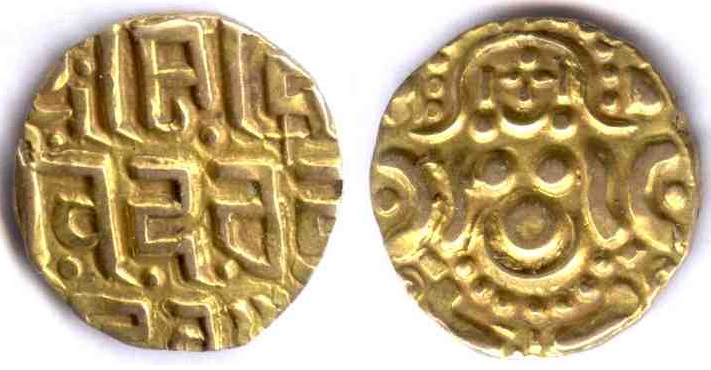 |
SA#1764 / SG# D5 / R# 736 / NW# 4 /
D# 252. Dinar (or Unit).
Weight: 4.25g.
Metal: 0.900 Gold.
Alignment: Medal. Mint:
Kanauj in Northern India.
Obverse:
figure of Lakshmi.
Reverse: Nagari
legends Devanagari sri maha / mira mahama / da samah.
Ruler: Mu'izz al-Din
Muhammad ibn Sam (1173-1206 CE). Common type.
Struck in Northern India. |
|
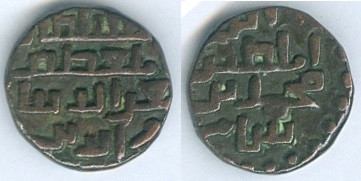 |
SG# D13 / R# 706-707 / D# 247-248 / Tye# 180. Jital
/ Dehliwal.
Year:
1193-1206. Weight: 3.24g.
Metal: Bronze.
Diameter: 13.50 mm.
Alignment:
Coin. Mint:
Lahore. Obverse:
al-sultan al-azam mu'izz al-dunya wa'l din.
Reverse:
abu muzaffar muhammad
bin sam.
Ruler: Mu'izz al-Din
Muhammad ibn Sam (1173-1206 CE).
Common type. |
|
Note: Some coins have a small circle above
the word "abu" on the Reverse side. |
|
| |
-
GHORID OF FIRUZKUH -
Ghurid vassalage under the Khwārazm-Shah dynasty.
-
Malik Mahmud ibn Ghiyath ud-Din Muhammad
ibn Sam............1206 - 1212
- Taj ud-Din Yildiz Muizzi (General
at Ghazna)................1206 - 1215
- Malik Baha ud-Din Sam II
ibn Mahmud.........................1212 - 1213
- Malik Ala-ud-Daulah Ala-ud-din
Atsiz bin Hussain............1213 - 1214
- Khwarazm-Shah dynasty
replaces the Ghurids in 1214.
|
|
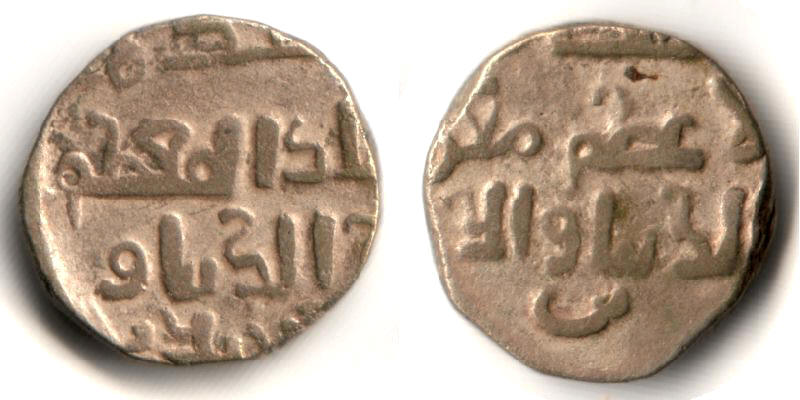 |
SA#1798. Billon Jital.
Weight: 3.07g.
Metal: 0.250 silver.
Mint: Ghazna.
Ruler:
Tajuddin ibn Yildiz Al-Mu'izzi (1206-1215 CE).
Common type.
He is known to be a
military General at Ghazna. |
|
| |
- GHORID OF BAMIYAN
-
Bamiyan is a town in
North-central Afghanistan's Hazarijat province. Bamiyan is an ancient caravan center on the
route across the Hindu Kush between India and central Asia. It is approximately
240 kilometers north-west of Kabul. By the 7th cent. the
town was a center of Buddhism; the Chinese pilgrims Fa Hsien and Hsüan-tsang
traveled through the town. Bamiyan was invaded by the Saffarids in 871. A Muslim
fortress town from the 9th to the 12th cent., Bamian was sacked by Ghenghis Khan
in 1221 and never regained its former prominence. The Bamiyan valley is lined
with cave dwellings cut out of the cliffs by Buddhist monks. Particularly
interesting were two great figures (one 175 ft/53 m high, the other 120
ft/37 m) carved from rock c. 625 CE and finished in fine plaster. These were
the statues destroyed in 2001 by the Taliban, who considered them
idolatrous. The area also has grottoes decorated with wall paintings in
Greco-Buddhist styles. A small dynasty was established parallel the Ghurid Empire from 1145 to 1215 as
follow. The only conflict that was thrust upon it in 1215 by Alauddin
Muhammad Shah of Khawarizm, brought the dynasty to an end. It was taken away
by the Mongols short afterwards in the same year.
- Autonomous city-state,
subject to various nominal overlords..1000 BCE - 650 CE
- The
Caliphate.........................................650 - 871
SHANSABANI (Emirs of Ghuristan)
- The Emirs of Ghuristan were of the Shansabani clan that eventually would
establish the Ghurid Empire in the 1100's at Badakhshan and Bamiyan.
- Shansab.....................................................fl.
c. 650
- Pervez
- Darmansh
- Darmash
- Nehatan
- Yahya.......................................................fl.
c. 800
- Muhammad I
Persia.....................................................871 - 999
The Ghaznavid
Empire.......................................999 - 1090's
- Malik Muhammad bin
Shansabani...........................? - 1011
- Malik Abu Ali bin
Muhammad...........................1011 - 1030s?
- Malik Abbas bin Shith...............................1030s
- 1059?
- Malik Muhammad bin
Abbas............................1059? - ?
- Malik Qutb-ud-din
Hasan bin Muhammad
Nominally to the
Seljuqs................................1090's - 1145
- Abu'l-Muluk
Izz-ud-din Hussain bin Hasan..........c. 1100 - 1146
Within the Ghurid
Empire..................................1145 - 1215
- Malik Fakhr ud-Din
Masud ibn Hussain.................1145 - 1163
- Malik Shams ud-Din
Muhammad ibn Masud................1163 - 1192
- Malik Abu'l
Mu'ayyid Baha ud-Din
Sam ibn Muhammad....1192 - 1206
- Malik Jalal ud-Din
Ali bin Sam.......................1206 - 1215
|
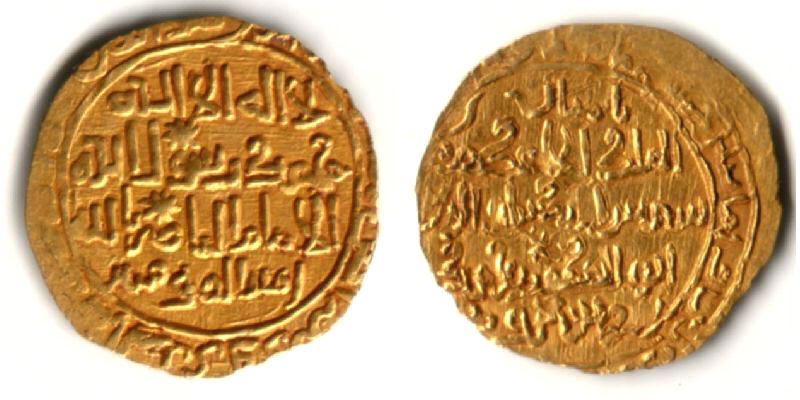
|
Dinar.
Year: AH 581 (1185). Weight:
2.92g. Metal:
0.900 Gold.
Diameter: 24.00 mm.
Mint: Bamiyan.
Legends: Bamian Al Malik al Azam Shams-ud-duniya
w'ad Din Abu'l Muzzafar Muhammad ibn Fakhuruddin Masud
citing Caliph:
al-Nasir b'Allah. Ruler:
Shams-ud-Din Muhammad ibn Masud (1163-1192).
Only two pieces are known. Extremely Rare to find.
The information on Ghorid of Bamiyan was available at:
http://www.islamiccoinsgroup.50g.com/assikka22/ghorids.htm. |
- Khwarazm.................................................1213 - 1231
- Lala Khatun (female
at Bamiyan)...................1210's
- 1221
- The Mongols settled a
garrison of a thousand warriors in the area around Bamiyan (the city itself
had been destroyed by them). The Persian word for thousand being Hazara,
this quickly became the name by which these soldiers were known. The Turco-Mongol
Hazara, after intermarrying with local populations and adopting an Iranic
language and Shi'ite Islam, became the dominant sect in the area of
Ghuristan, which became known as the Hazarajat.
- Aladdin
Aziz........................................1213 - 1214
- Aladdin
Muhammad Shah...............................1214 - 1215
Mongols..................................................1231 - 1345
SHAHS OF BADAKHSHAN
- Chaghatayid dynasty.
The northeastern corner of Afghanistan, the
velayet (province)
which is today the core territory of the Northern Alliance of opposition to
the Taliban. It's modern capital is Faizabad.
- A local dynasty under Mongols
Ali Shah I...........................................fl.
< 1291
Dawlat Shah ibn Ali Shah............................1291 - 1292
?
Sultan Bakht........................................1303 - ?
Arghun
Shah.........................................1307 - 1311
Azam Ali Shah
II....................................1311 - 1318
?
Probably another dynasty, but
independent
Shah Baha' ud-Din...................................1344
- 1358
Muhammad
Shah..............................................fl. 1358/1369
Bahramshah..........................................1359
- 1374/1375
Shaykh
Ali.................................................fl. 1368/1369
|
|
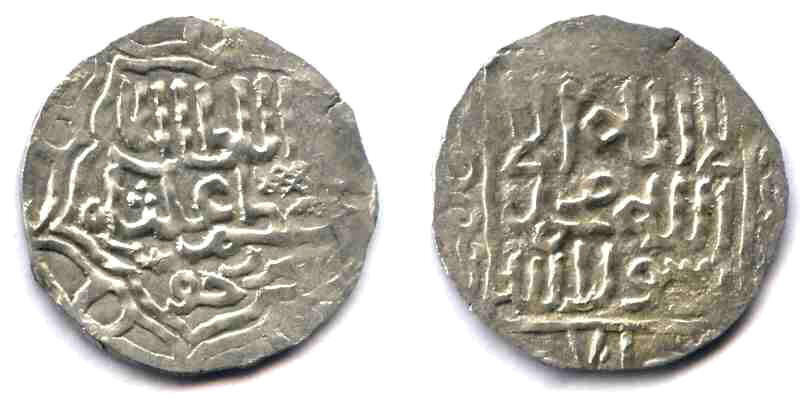 |
SA#A2015 Dirham.
Year:
AH 718 (1318).
Weight:
2.30g.
Metal:
0.825 Silver. Diameter:
23.00 mm. Mint:
Khost. Ruler: Al Sultan Al Azam Ali Shah II.
Extremely rare type. |
|
| |
-
HERAT (Eastern Khorasan)
-
Kurts (or Karts) dynasty
- A wealthy
city and fertile region in northwestern Afghanistan, comprising the plains on
the watershed of the Harirud River, with the edge of the Hindu Kush Mountains
bordering on the east. Kurts (or Karts) dynasty started in 1245 under Mongols
to1332, then became the sole rulers of Afghanistan.
-
Shams ud-Din I
Muhammad.............................1245 - 1277
-
Shams ud-Din
II.....................................1278 - 1295
-
Fakhr ud-Din........................................1295
- 1308
-
Ghiyath ud-Din
I....................................1308 - 1329
-
Shams ud-Din
III....................................1329 - 1330
-
Hafiz...............................................1330 - 1332
-
Mu'izz ud-Din Pir Husain Muhammad........................1332 - 1370
- He was ruling parts of Southern Afghanistan and
areas comprising of modern day Balochistan on both sides of Iran-Pakistan
border when the famous traveler Ibn Batuta passed from this area on his way
to India. He (Sultan Muizzuddin Hussain) is mentioned by Ibn Batuta in his
travelogue "Ajaib Al asfar" (The wonders of travels).
-
Ghiyath ud-Din II Pir Ali................................1370 - 1389
|
|
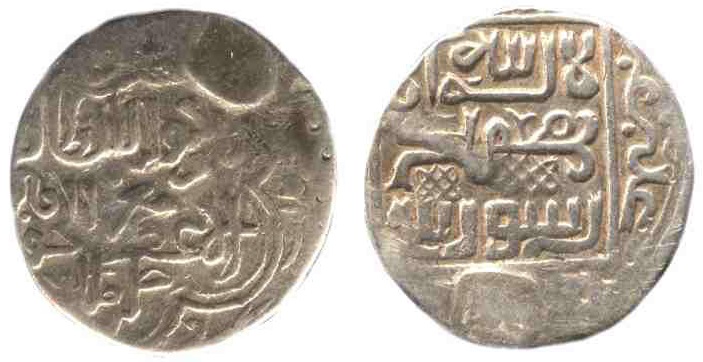 |
SA#2350A 1/4 Tanka.
Year: AH 746-750
(1346-1349). Weight:
2.73g. Metal:
0.825 Silver.
Diameter: 20.00 mm. Edge:
Plain. Alignment:
Almost coin. Mint:
Herat. |
|
Obverse Legends: Zarb Ba-Mir
Dawla Al-Sultan Muizz Al-Haq wa Ud-din Khalid Malik.
Reverse Legends:
Kalima in the center square. Caliph "Abu Bakr"
written at the top, "Omar" at the left side, "Usman" at the bottom
and "Ali" on the right side; all outside the center square. Ruler: Sultan Mu'izz ud-Din Pir Husain Muhammad
(1332-1370).
Extremely rare type.
My coin was part of ex-jewelry as it has
marks on both sides indicating that a clip was removed. |
|
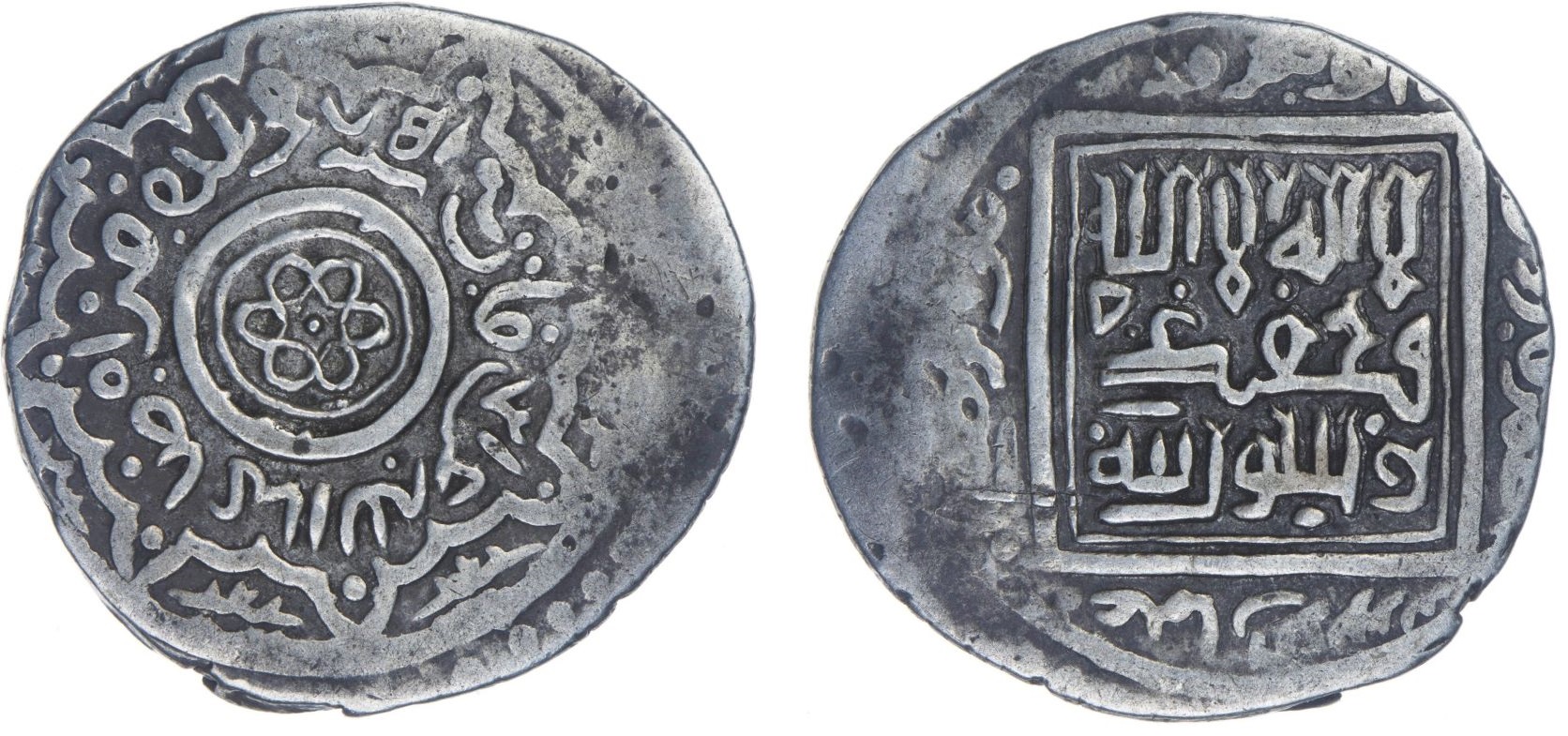 |
SA#2351
/ Mitchiner MWIS# 1865.
12 Dirhams.
Year: AH 751
(1350). Weight:
8.29g. Metal:
0.825 Silver.
Diameter: 29.00 mm. Edge:
Plain. Alignment:
Medal. Mint:
Herat.
Obverse: Date at
the top. Six petal flower in the center surrounded by two circles.
Legend in circular form outside the center circle. Reverse Legends:
Kalima in the center double square. Caliph "Abu Bakr"
written at the top, "Omar" at the left side, "Usman" at the bottom
and "Ali" on the right side; all outside the center square. Ruler: Sultan Mu'izz ud-Din Pir Husain Muhammad
(1332-1370).
Scarce type. |
|
Note: 12 Dirhams or Double Dinar
weighting 8.50 - 8.60 grams, equal to Two Sarbadarid or Walid 6
Dirham coins. Stuck at Beled Herat. |
|
| |
-
Timurid
Empire
-
This Empire was split into three
different series of rules, First at Hissar and Badakhshan (1460 to somehow
1584; it's capital at Faizabad). Second at Herat (1405 to somehow 1506) and
thirdly at Kabul (1419 to somehow 1530). Some of these rulers overlapped
their reign between these three regions.
- Pir Muhammad ibn Jahangir (Balkh)...................1405
- 1406
- Qaidu ibn Pir
muhammad ibn Jahangir (Balkh).........1406
- 1409
- Shahrukh (Herat
& Sabzawar).........................1405
- 1447
- Minted coins also at
Astarabad, Isfahan, Kashan, Khwarizm, Kirman, Nimruz, Samarqand,
Shabankara, Sahaqq (Bamm), Sawah, Shaykh Abu Ishaq (Kazirun), Shiraz and
Yazd. Posthumously minted at Tabriz.
- Suurgatmish ibn Shahrukh (Kabul)....................1419
- 1427
- Masud (Kabul).......................................1427
- 1439
- Karuchar (Kabul)....................................1439
- 1451
- Ala al-Dawla (Herat
& Sabzawar)............................1447
- Abu Bakr ibn
Muhammad Juki (Balkh).........................1447
- Ulugh Beg I (Herat,
Sabzawar & Samarqand)...........1447
- 1449
- Shah Sultan
Muhammad (Badakhshan)................c.
1450 - 1467
- Abu Said (Samarqand
& Transoxiana)..................1451
- 1469
- Minted coins after
capturing Khorasan from 1459, Astarabad from 1460 and later Herat.
- Abu'l-Qasim Babur
(Herat & Kabul)...................1447
- 1457
- He struck coins in 1447
to 1448 before the capturing Herat in AH 853 (1449 CE) and Kabul in
1451.
- Shah Mahmud
(Astarabad & Herat)............................1457
- Sultan Ibrahim (Herat
& Nishapur)...................1457
- 1459
- Mirza Abu
Bakr ibn Abu Said (Badakhshan)............1460
- 1480
- Sultan
Mirza Hussein Baiqara ibn Mansur (Herat).....1469
- 1470
-
It is also known that
Sultan Hussein reign at Astarabad from AH 862-864 (1459-1460 CE), and
again at Astarabad from AH 865-868 (1461-1464 CE).
-
Ulugh Beg II
Kabuli (Kabul).........................1469
- 1501
-
Yadigar Muhammad (Herat)...................................1470
-
Sultan
Mirza Hussein Baiqara (2nd
time at Herat)....1470
- 04 Mar 1506
-
Ruled again 2nd time at Herat. Muhammad and Badi
al-Zaman are known to rebel against their father's reign as indicated
below.
- Dhu’l-Nun Arghun (Timur
Governor at Qandahar)....c.
1470 - 1507
- Sultan
Mahmud ibn Abu Said (Badakhshan).............1480
- 1495
- Masud ibn
Mahmud (Badakhshan).......................1495
- 1497
- Baysuqur Mirza
ibn Mahmud (Badakhshan)..............1497
- 1499
- Muhammad ibn Hussein Baiqara (rebel at
Astarabad)...1498
- 1501
-
Badi al-Zaman ibn Hussein Baiqara (rebel at Balkh)..1499
- 1502
- Sultan Ali ibn Mahmud (Badakhshan)..................1499
- 1500
- Badakhshan was occupied by
Uzbek Khanate of Shaybanids from 1500 to 1505 CE.
-
Abd al-Razzak
(Kabul)...............................1502
- 1503
- Muzaffar
Hussein ibn Hussein Baiqara (Herat)...............1506
with...
- Badi al-Zaman ibn Hussein Baiqara (2nd time but in Herat)..1506
-
Muzaffar Hussein and his
brother Badi al-Zaman ruled Herat briefly in 1506. Badi al-Zaman later
ruled separately in various places, principally at Astarabad and Nimruz
from 1506 to 1508 as an independent ruler. Herat was occupied by
Shaybanids of Transoxania from 1506 to 1516. Later Herat was occupied by
Iran from 1516 to 1709.
|
|
 |
Falus
Year: AH 873-911 (1469-1506).
Weight: 3.01g.
Metal:
Copper.
Diameter: 19.00
mm. Edge:
Plain. Alignment:
Rotated (5 o' clock).
Mint: Herat.
Ruler: Sultan Hussein Baiqara (1470-1506).
"Herat" is mentioned on
the Obverse side. |
|
 |
SA#2432.3. Tanka
Year: AH 895-911 (1490-1506).
Weight: 4.78g.
Metal: 0.800
Silver.
Mint: Astarabad.
Abundant type.
The type has "Bih bud" in knotted diamond on
obverse, which means prosperity, and it was the name of Sultan Hussein's
coinage. Kalma at reverse in square.
Ruler: Sultan Hussein Baiqara
[Mirza Husseyn Bayqarah] ibn Mansur (1470-1506).
Herat & Astarabad are by far the
most common mints. Coinage of other 18 mints are also commonly
available. |
|
| |
- Independent
Rulers at Maimana
- A city-state in the
northwest of Afghanistan, independent from the time when Persia
retreated out of the region, to the era in which Afghanistan coalesced
into a recognizable state.
-
Persia................................................c. 1506 - 1747
-
Hajji....................................................1747 - 1770
- Ghan........................................................?
- 1790
-
Ahmad....................................................1790 - 1810
- Allah Yar................................................1810
- 1826
- Mizhrab..................................................1826
- 1845
- Hikmat...................................................1845
- 1853
- Husain Khan (1st
time)...................................1853
- 1876
-
Afghanistan..............................................1876 - 1879
- Dilwar
Khan..............................................1879 - 1883
- Husain Khan (2nd
time)...................................1883
- ?
- Kemal
Khan........................................early 1890s - c. 1900
- under Afghanistan
afterwards.
|
|
|
-
Independent Rulers at Qonduz (Kunduz)
- A northern Afghan
state, about equidistant between Mazar-I-Sharif and the capital of the
Northern Alliance, Faizabad. Kunduz (Pashto: کندز; Dari: قندوز) is a
city in northern Afghanistan, which serves as the capital of Kunduz
Province. The city is about the 6th-largest city of Afghanistan and the
largest city in the northeastern section of the country. Kunduz is
located in the historical Tokharistan region of Bactria, near the
confluence of the Kunduz River with the Khanabad River. Kunduz is linked
by highways with Kabul to the south, Mazar-i-Sharif to the west, and
Badakhshan to the east. Kunduz is also linked with Dushanbe in
Tajikistan to the north, via the Afghan dry port of Sherkhan Bandar.
-
Persia.................................................c. 500 - 329
-
Macedon...................................................329 - 306
- The Seleucid
Empire.......................................306 - 256
-
Bactria...................................................256 - c. 80
- Kushanid
Empire.....................................c. 80 BCE - c. 240 CE
- Tu-Mi
- a Kushan
subkingdom centered at Qonduz
- Arseiles................................................fl.
c. 20 BCE
- Sapadbizes..............................................fl.
c. 1 BCE
- The Kushanshahs........................................c.
240 - c. 410
- The White Huns
(Hephthalites).............................410 - 565
- The Western
Turks (Gök)...................................565 - 652
- The
Caliphate.............................................652 - 848
- Balkh.....................................................848
- 1011
- The Ghaznavid
Empire.....................................1011 - 1148
- The Ghurid
Empire........................................1148 - 1212
- Khwarazm.................................................1212
- 1220
-
Mongols..................................................1220 - 1332
-
Herat....................................................1332 - 1389
- Timurid
Empire...........................................1389 - 1506
- Amir Khusraw.............................................1497
- 1505
- Amir Khusraw AH 902-910
(1497-1505) was a Timurid Governor who proclaimed independence at Qonduz
in AH 902. He was deposed in AH 910.
- Persia...................................................1506 - 1508
- Sultan Uvays Mirza
ibn Sultan Mahmud.....................1508 - 1520
- Badakhshan...............................................1520
- 1545
- Abu Nasir Muhammad
Hindal ibn Babur......................1545 - 1550
- He
ruled Badakh in 1529 and then again from 1546 to 1547.
- Ibrahim.........................................................1550's
- Badakhshan.................................................
? - 1698
- Mahmud Bey...............................................1698
- 1708
- Qubad Beg.......................................................fl.
c. 1768
- Unknown rulers
- Murad Beg................................................1815
- 1842
- Rustam Beg...............................................1842
- late 1840s
- Mir Ataliq...............................................1850
- 1865
- Sultan Murad.............................................1865
- 1887
-
Ali Bardi Khan....................................early
1890s - c. 1900
- under Afghanistan
afterwards.
|
|
|
|
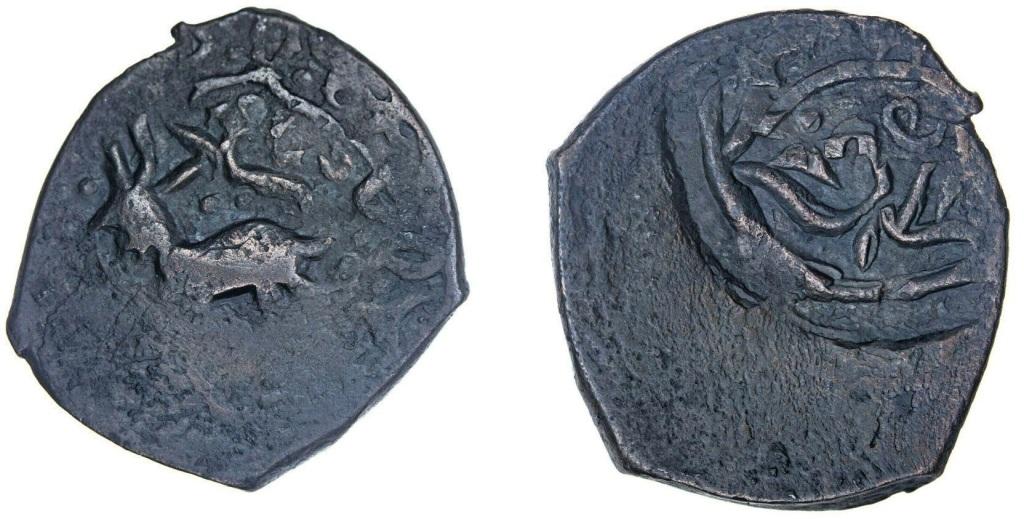 |
| SA#3009.
2 Dinars.
Year: AH 902-910 (1497-1505). Weight:
9.20g.
Metal: Copper.
Diameter: 29.00
mm. Edge:
Plain. Alignment:
Medal.
Mint:
Qunduz.
Obverse:
Deer / Antelope
standing, facing left.
Reverse:
Three line legend
within ornate diamond-shaped border.
Ruler: Amir Khusraw (1497-1505).
Common type.
Note: Amir Khusraw Shah,
erstwhile governor for the Timurid, proclaimed his autonomy in AH
902 (1497). Anonymous copper coins were struck at three mints:
Qunduz, Hisar and Termez, of which the last is somewhat scarce. They
normally bear the frozen year AH 907 (occasionally omitted) and the
zero is often written as a circle, thus often misread as AH 957. All
show a deer or antelope on the Obverse side. The copper coins are
generally 80% or more struck up and are often quite attractive. Most of his coins are
denominated 2 (Persian "do") Dinars. They are frequently found
countermarked with a devaluation to one ("lek") Dinar.
G. Cole claims that such countermark must have have been applied by
the Shaybanids after the fall of Khusraw, during the 910s and
perhaps into the 920s. A single silver Tanka minted only at Hisar is
known for Amir Khusraw and is considered Extremely rare. |
|
|
|
- Independent
Rulers at Sar-I-Pul
-
Persia................................................c. 1510 - 1747
- Mostly to
Afghanistan (Balkh)............................1747 - 1831
- Dhu'l-Fiqar
Khan.........................................1831 - 1838
- Mahmud
Khan..............................................1838 - 1850
- Kabul (Dost
Mohammed)....................................1850 - 1863
- Faiz Muhammad
Khan.......................................1863 - 1867
- Hakim
Khan...............................................1867 - 1879
- Mir
Muhammad.............................................1879 - 1880's
- under Afghanistan
afterwards.
|
|
|
-
Other independent Rulers in various areas of Afghanistan
- Shah Sultan
Muhammad (Badakhshan).....................c.
1450 - 1467
-
Shahab-ud-Din (Karlugh
dynasty in Pakhli region)......c. 1472 - ?
Zu-n-Nun Beg Argun
Mehrabanid (1st
time at Kabul)........1501 - 1502
Zu-n-Nun Beg Argun
Mehrabanid
(2nd
time at Kabul)........1503 - 1504Shah Beg Arghun (Qandahar,
in Sindh from 1522-1524)......1507
- 1522 d. 1524
Wali Muhammad Astrakhanid
(Balkh, Bokhara
1605-1608).....1599
- 1611
Nadir Muhammad
Astrakhanid (Balkh,
Bokhara 1640-1645)....1611
- 1651
Subhan Quli
Astrakhanid (Balkh,
Bokhara 1681-1702).......1651
- 1702
Hussain Khan (Karlugh
dynasty in Pakhli
region)...............fl.
2nd half 16th cent.
Mehmud Khurd (Karlugh
dynasty in Pakhli
region)............ ? - 1703
The Pakhli Sardar fragmented owing to increasing weakness on the part of the
dynasty; most districts devolved to purely local control, and were absorbed
later by Afghanistan.
Persia
(but some regions to Mughal rule).................1506 - 1747
- Timurid
Dynasty
- Below are the Timurid rulers at Kabul,
Badakhshan and Qonduz from 1504:
-
Muhammad Zahir ad-din Babur
Mirza ibn Umar Shaikh...1504 - 1530
- Ruled Samarqand from 1497
to1498, then again in 1500. Eastern Khorasan and Transoxian from
1500 to 1530. He defeated Ibrahim Shah Lodhi, the ruler of Delhi, at the
First Battle of Panipat in 1526 and became the founder and first
Mughal
Emperor of India from 1526 to 1530.
- Muborek Shah Muzaffar (Badakhshan)..................1505
- 1507
- Nasir Mirza Miran Shah (Badakhshan).................1507
- 1520
- Sultan Uvays Mirza ibn
Sultan Mahmud (Qonduz).......1507
- 1520
- Humayun ibn Babar (Badakhshan
& Qonduz).............1520
- 1529
-
He became the second Mughal
Emperor of India from 1530 to 1539 and again from 1555 to 1556.
- Abu Nasir Muhammad Hindal
ibn Babur (Badakhshan)...........1529
- Sulayman Shah Mirza ibn
Sultan Uvays (Badakhshan)...1529
- 1546
- Muhammad Kamran Mirza ibn Babur
(Kabul).............1530
- 1555
- He was the second
surviving son of Babur and was half-brother to Babur's eldest son
Humayun (who go on and inherit the Mughal throne). Kamran was a full
brother to Babur’s third son, Askari. Humayun was able to enter Kabul in
November 1545 in a bloodless takeover. Kamran then wound up in the
Punjab, where a local ruler handed him over to Humayun in 1553. Although
Humayun resisted the pressure to put his rebellious brother to death, he
was persuaded that something needed to be done about him so he
reluctantly had him blinded. Humayun then sent him off to perform the
Hajj to Makkah, where he died in 1557.
-
Humayun ibn Babar (exile
at Qandahar)...............1544
- 1545
-
He was deposed in Delhi by
a rival Afghan leader, Sher Shah Suri in 1540. Humayun exiled to the
court of the Persian ruler, Shah Tahmasp I, whose help he sought in
regaining his lost kingdom.
-
Abu Nasir Muhammad Hindal
ibn Babur (Qonduz)........1545
- 1550 and at
- Abu Nasir Muhammad Hindal ibn Babur (Badakhshan)....1546
- 1547
- Sulayman Shah Mirza ibn
Sultan Uvays (Badakhshan)...1547
- 1575
- Abu'l-Qasim Muhammad ibn Kamran
(probably at Kabul)........1560
- Hakim Mirza S/o
Humayun (Mughal
Governor of Kabul).1580? - 10 Aug 1581
- In 1580, some prominent
Muslim officers of Akbar, displeased with his liberal religious
policies, started to conspire against him. Qazi Muhammad Yazdi declared
it the duty of every Muslim to rebel against Akbar. In Bihar and Bengal
they declared Mirza Hakim, Akbar's stepbrother and Governor of Kabul, to
be the emperor. Akbar sent armies to Bihar and Bengal to crush this
rebellion, while he himself started towards Kabul; Man Singh (Kacchwaha
King of Amber, a state later known as Jaipur) with him. Akbar himself
arrived at Kabul on August 10, 1581. Hakim was pardoned by Akbar, but
his sister "Bakhtunissa Begum" was appointed Governor of Kabul. After
Akbar returned to Fatehpur Sikri; Bakhtunissa remained as the nominal
head of state, while Hakim acted as the Governor. Hakim died in July,
1582.
- Shahrukh ibn Ibrahim ibn
Sulayman Mirza (Badakhshan)1575
- 1584
(2nd time)-
Badakhshan was occupied
by Bokara from 1584 to 1657. At Badakhshan, someone named Akbar from
Timurid dynasty has been known to mint his coins from 1556 to 1605.
|
|
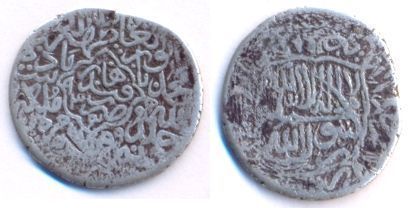 |
SA#2462. Tanka (or Shahrukhi).
Year: AH 933 (1527). Weight: 4.20g.
Metal: 0.825 Silver.
Diameter: approx. 25.00
mm. Edge:
Plain. Alignment:
Rotated.
Mint: Qandahar.
Obverse:
In eightfoil area: "Zarb Qandahar 933" and ruler's name and title around.
Reverse:
Kalima in centre, with
first four caliph's names around.
Ruler: Muhammad Zahir ad-din Babur Mirza ibn Umar Shaykh.
Very Rare type.
His Tankas (Shahrukis) were struck at Khorasanian and Transoxianan mints
between AH 906 and AH 933. |
|
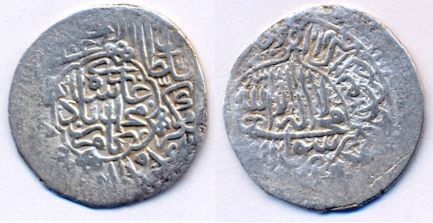 |
SA#I2464. Shahrukhi. Years:
AH 937-962 (1530-1555).
Weight: 3.72g.
Metal: 0.825 Silver.
Diameter: approx. 25.00
mm. Edge:
Plain. Alignment:
Rotated. Mint: Kabul.
Obverse:
In twelvefoil area:
"Muhammad Kamran Badshah Ghazi". In the area around: "al-sultan al-azam
wa khaqan al-Mukarram te'ala khallad Allah mulkahu wa sultanahu zarb
Kabul" and date.
Reverse: Kalima in
centre, with first four caliph's names around.
Ruler:
Muhammad Kamran Mirza
ibn Zahir al-Din Babur [AH 937-962 (1530-1555)].
Rare type.
Ruler at Kabul and briefly at Lahore. |
While his father, Babur, was conquering the northern Indian
Subcontinent from 1525 onwards, Kamran remained in Qandahar in order
to secure his northern flank. He was still in charge of the northern
part of the newly formed empire, when his father died in 1530.
According to the Mughal historian Abu'l Fazl, Babur’s last words to
Humayun were “do nothing against your brothers, even though they may
deserve it.”
In 1538, Kamran first crossed into India, bringing with him 12,000
soldiers, while Humayun was away fighting in Bengal. He appeared to
have come in order to put down the rebellion of his brother Hindal
against Humayun. However, despite Humayun's calls for help, Kamran
offered him no aid whatsoever. After Humayun returned from his
defeat at the Battle of Chausa, Kamran refused to place his troops
under Humayun's command as he was more interested in taking power
for himself. Seeing no chance of furthering his ambition, Kamran
withdrew back to Lahore. Later Humayun captured him and took over
his territories. |
|
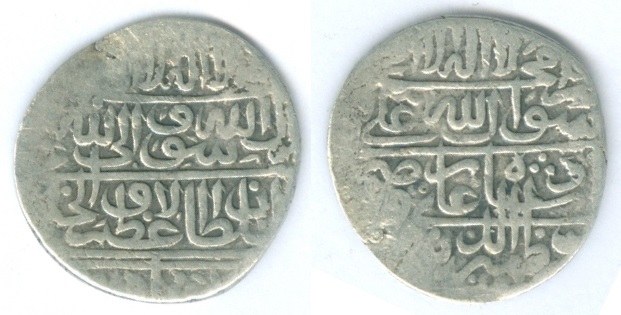 |
SA#E2464.
Shahrukhi. Years:
AH 950-951 (1544).
Weight: 4.45g.
Metal: 0.825 Silver.
Diameter: 24.00
mm. Edge:
Plain. Alignment:
Coin. Mint:
Qandahar. |
|
Obverse:
Shia Kalima in top two
line: la ilaha illa-llah muhammadun
rasulu-llah aliyun waliyu-llah (There is no deity but God.
Muhammad is the messenger of God. Ali is the vicegerent of God.).
Last two line:
al-sultan al-azam al-khaqan al-hussaini shah tahmasp.
Reverse: Shia Kalima
in top two lines. la ilaha illa-llah
muhammadun rasulu-llah aliyun waliyu-llah (There is no deity
but God. Muhammad is the messenger of God. Ali is the vicegerent of
God).
Last two line:
Nasir al-Din Muhammad Humayun Zahir al-Din Muhammad Babur Padishah
Ghazi.
Ruler:
Muhammad Humayun Mirza
ibn Zahir al-Din Babur [exile in Afghanistan].
Extremely
Rare type. The Mughal empire was unsteady in this initial period, especially
under the talented but fickle-minded Humayun. Humayun’s
eccentricities led to his downfall; he was deposed by a rival Afghan
leader, Sher Shah Suri in 1540 and exiled to the court of the
Persian ruler, Shah Tahmasp I, whose help he sought in regaining his
lost kingdom. In Persia, Humayun was often encouraged to turn to the
Shia faith. Thus we find some later coins issued by the Mughal from
Qandahar proclaiming Shah Tahmasp as his overlord and featuring the
Shia Kalima, a compromise Humayun accepted to survive at the Safavid
court. These coins were produced a few months during AH 950-951
(1544). Humayun abandoned the Safavid alliance early in AH 952
(1545). |
|
| |
-
DURRANI
at Herat
-
Sadozai segment
- Abdullah
Khan Abdali (Herat).............................1709
- Aug 1712
- Served as Persian governor of Herat from 1695
to 1708. Later became Shah of Herat.
- Persian Governors at Herat
- Shahzada Assadullah Khan Abdali..............16
Oct 1712 - 04 Oct 1720
- Shahzada Muhammad Khan Abdali................15
Jul 1722 - Aug 1724
- Allah Yar Khan Abdali...........................Aug 1724 -
21 Apr 1730
- Sardar Zulfikhar Khan Abdali.................21
Apr 1730 - 22 Aug 1731
- Persia.......................................22 Aug 1731 - Jul 1747
- GILZHAI (HOTAKI)
- Chieftains at Qandahar.
Qandahar is a major city, linked by highways
with Herat to the west, Ghazni and Kabul to the east, Tarin Kowt to the
north, and Quetta in Pakistan to the south. Qandahar was an independent
Kingdom from 1709 to 1738. Under the leadership of Mahmud Shah, they
launched a successful invasion of Iran in AH1134 (1721 CE). Their coins are readily
distinguished by their Sunni legends. However Iran (Persia) under Nadir Shah Afsharid in 1738 took all these areas captured by Gilzhai (or Hotaki) dynasty.
- Persian Governors at Qandahar
- Gurgin Khan [Giorgi
XI of Kartli]...............May 1704 - 21 Apr 1709
- Ki-Khosrow [Kaikhosro
of Kartli]................Nov 1709 - 26 Oct 1711
- Mir Wais (rebel
till 1711)........................21 Apr 1709 - 1715
-
He overthrew and killed Gurgin Khan, the Safavid
governor of Kandahar. Mir Wais successfully defeated the Persians, who were
attempting to convert the local population of Kandahar from Sunni to the
Shia sect of Islam. Mir Wais held the region of Kandahar until his death in
1715 and was succeeded by his son Mir Mahmud Hotaki.
- Mir Abdul Aziz (or, Abdullah)
Khan Hotaki (six months)..........1715
-
Mir Wais and Mir Abdul Aziz were brothers.
-
Mir Mahmud
Shah Hotaki (Shah of Persia 1722-1725)........1715 -
25 Apr 1725
- He was the son of Mir Wais. In 1722, Mir Mahmud led an Afghan army to Isfahan
(Iran), sacked the city and proclaimed himself King of Persia. He invited all leading Persians to a great festival and then butchered them
all.
However, the great majority still
rejected the Afghan regime as usurping, and after the massacre of thousands
of civilians in Isfahan by the Afghans – including more than three thousand
religious scholars, nobles, and members of the Safavid family. Eventually
the Hotaki dynasty was eventually removed from power by a new ruler, Nader
Shah of Persia came to power.
- Ashraf Shah Hotaki (also Shah of Persia)..........26
Apr 1725 - 13 Nov 1729
- He was the son of Mir Abdul
Aziz.
- Mir Husayn
Sultan Khan Hotaki............................1730 - 12 Mar 1738
- Qandahar came under Persian
rule 1738-1747 and then back under Afghanistan rule.
|
|
 |
SA#2714. Rupi (10 Shahi).
type A. Year:
1722-1725. Weight:
11.14g. Metal:
0.900 Silver. Diameter:
23.00 mm. Thickness:
3.00 mm.
Alignment:
Rotated.
Mint:
Qandahar. Ruler: Mir Mahmud Shah
(1715-1725).
Scarce type.
He belonged to Hotaki (Gilzhai) dynasty at Qandahar
and became Shah of Persia from 23 Oct 1722 to 25 Apr 1725. |
|
Obverse Persian
legends: "سکه زداز مشرق
ایران چو قرص آفتاب" (From
the east of Iran, he struck coin like solar face) written at top two lines. "شاه
محمود جهانگیر سیادت إنتساب" (King Mahmoud world conqueror
of saintly race) written in middle two
lines. "ضرب قندهار" (Struck at Qandahar)
written at the bottom line which is off flan.
Reverse Persian legends: Kalima in the
center square. Four caliph names outside the center square, "Abu
Bakar" written at the left side, "Umar" written at the top, "Usman"
written at the right side and "Ali" at the bottom.
Note:
"Saintly Race" means the Sayyids,
descendants of Prophet Muhammad. |
|
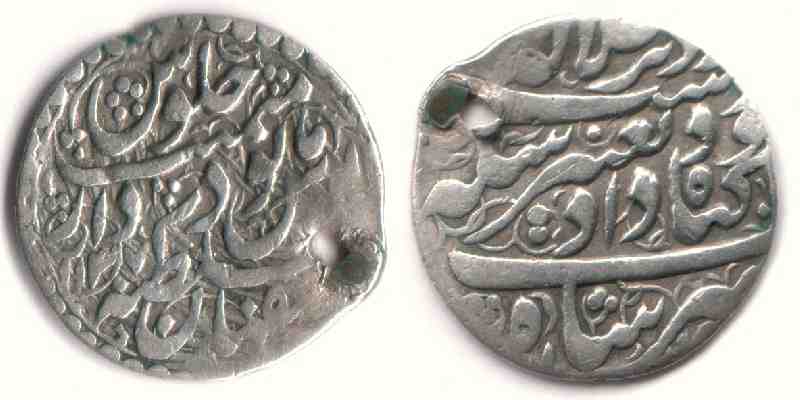 |
SA#2721. Abbasi. type D.
Year: AH 1137 (1725). Weight:
4.16g. Metal:
0.900 Silver.
Diameter: 23.00 mm.
Alignment:
Rotated.
Mint: Isfahan.
Ruler: Ashraf Shah ibn Mir Mahmud Shah
(1725-1729).
Scarce type.
He belonged to Hotaki (Gilzhai) dynasty at Qandahar and was Shah of
Persia from 26 Apr 1725 to 13 Nov 1729. This coin has a hole, probably
used as a part of jewelry in the past. |
|
Obverse Persian legends:
"جلوس میمنت
مانوس در دار السلطنة اصفهان" (julus maimanat manus
dar dar-es-sultanate Isfahan /
1137) [struck at
Dar es-Sultanate Isfahan
in the year 1137 of the accession associated with tranquil prosperity]
written within center thin
circle surrounded by dotted circle.
Reverse Persian legends: "دست زد بر جلالة اشرف
شاه" (Ashraf Shah laid hold on majesty with might)
written at the top and bottom lines. "بود تعبیر سکه دار گناه" (Let
his coin's legend read "Requited be unright") written in
the middle two lines. |
|
| |
- AFSHARID EMPIRE of
Persia
- Nader Shah (Nadhar /
Tahmasp
Qoli Khan Afshar)...........1738 - 20 June 1747
He was King of Persia since
22 January 1736 and son Emam Qoli. Nader evidenced in numerous martial
encounters throughout his campaigns, such as the battles of Herat,
Mihmandust, Murche-Khort, Kirkuk, Yeghevard, Khyber Pass, Karnal and Kars.
Some historians have described him as the Napoleon of Persia, Sword of
Persia or the Second Alexander. Nader rose to power during
a period of chaos in Iran after a rebellion by the Hotaki Pashtuns had
overthrown the weak Shah Sultan Husayn, while the arch-enemy of the Safavids,
the Ottomans, as well as the Russians had seized Persian territory for
themselves. Nader reunited the Persian realm and removed the invaders. He
became so powerful that he decided to depose the last members of the Safavid
dynasty, which had ruled Iran for over 200 years, and become Shah himself in
1736. His numerous campaigns created a great empire that, at its greatest
extent, briefly encompassed what is now part of or includes Iran, Armenia,
Azerbaijan, Georgia, the North Caucasus, Iraq, Turkey, Turkmenistan,
Afghanistan, Uzbekistan, Bahrain, Pakistan, Oman and the Persian Gulf, but
his military spending had a ruinous effect on the Persian economy.
In 1738, Nader Shah
conquered Kandahar, the last outpost of the Hotaki dynasty. His thoughts now
turned to the Mughal Empire based in Delhi. Despite being outnumbered by six
to one, Nader Shah crushed the Mughal army in less than three hours at the
huge Battle of Karnal on 13 February 1739. After this spectacular victory,
Nader captured Mohammad Shah and entered Delhi. When a rumour broke out that
Nader had been assassinated, some of the Indians attacked and killed Persian
troops. Nader, furious, reacted by ordering his soldiers to plunder and sack
the city. During the course of one day (March 22) 20,000 to 30,000 Indians
were killed by the Persian troops, forcing Mohammad Shah to beg Nader for
mercy. In response, Nader Shah agreed to withdraw, but Mohammad Shah paid
the consequence in handing over the keys of his royal treasury, and losing
even the fabled Peacock Throne to the Persian emperor. The Peacock Throne,
thereafter, served as a symbol of Persian imperial might. It is estimated
that Nader took away with him treasures worth as much as seven hundred
million rupees. Among a trove of other fabulous jewels, Nader also looted
the Koh-i-Noor (meaning "Mountain of Light" in Persian) and Darya-ye Noor
(meaning "Sea of Light") diamonds. The Persian troops left Delhi at the
beginning of May 1739, but before they left, he ceded back to Muhammad Shah
all territories to the east of the Indus which he had overrun. Nader's
soldiers also took with them thousands of elephants, horses and camels,
loaded with the booty they had collected. The plunder seized from India was
so much that Nader stopped taxation in Iran for a period of three years
following his return. Later Nadir became increasingly cruel as a result of
his illness and his desire to extort more and more tax money to pay for his
military campaigns. New revolts broke out and Nader crushed them ruthlessly,
building towers from his victims' skulls in imitation of his hero Timur. In
1747, Nader set off for Khorasan, where he intended to punish Kurdish
rebels. Some of his officers feared he was about to execute them and plotted
against him. Nader Shah was assassinated on 20 June 1747, at Quchan in
Khorasan. He was surprised in his sleep by Salah Bey, captain of the guards,
and stabbed with a sword. Nader was able to kill two of the assassins before
he died.
After his death, he was
succeeded by his nephew Ali Qoli, who renamed himself Adil Shah ("righteous
king"). Adil Shah was probably involved in the assassination plot. Adil Shah
was deposed within a year by his brother Ibrahim Shah. During the struggle
between Adil Shah, his brother Ibrahim Khan and Nader's grandson Shah Rukh
and almost all provincial governors declared independence, established their
own states, and the entire Empire of Nader Shah fell into anarchy. Oman and
the Uzbek khanates of Bukhara and Khiva regained independence, while the
Ottoman Empire regained the lost territories in Western Armenia and
Mesopotamia. Finally, Karim Khan founded the Zand dynasty and became ruler
of Iran by 1760. Erekle II and Teimuraz II, who, in 1744, had been made the
kings of Kakheti and Kartli respectively by Nader himself for their loyal
service, capitalized on the eruption of instability, and declared de facto
independence. Erekle II assumed control over Kartli after Teimuraz II's
death, thus unifying the two as the Kingdom of Kartli-Kakheti, becoming the
first Georgian ruler in three centuries to preside over a politically
unified eastern Georgia, and due to the frantic turn of events in mainland
Iran he would be able to maintain its autonomy until the advent of the
Iranian Qajar dynasty. The rest of the Iranian territories in the Caucasus,
comprising modern-day Azerbaijan, Armenia, and Dagestan broke away into
various khanates. Until the advent of the Zands and Qajars, its rulers had
various forms of autonomy, but stayed vassals and subjects to the Iranian
king. In the far east, Ahmad Shah Durrani had already proclaimed
independence, marking the foundation of modern Afghanistan. Iran finally
lost Bahrain to House of Khalifa during Invasion of Bani Utbah in 1783.
DURRANI
at Safa
- Safa, a tiny village in eastern
Afghanistan, some 46 miles (74 km.) south of Kabul and about 38 miles (61
km.) west of the nearest point on the Pakistani frontier. Formerly, it was a
base for the Durrani clan, the chiefs of the Alus Abdali, who eventually
mastered all Afghanistan.
- Governors within Mughal Empire to c.
1650 at Safa
- Malik Saddu.........................................1598 -
1627
- Amir-i-Afghan (Commander of the Afghan
forces); Governor of Qandahar for the Mughals from 1622 to 1626.
- Khwaja Khizr
Khan....................................Mar - Sept 1627
- Maudad
Khan.........................................1627 - 1643
- Shah Husain
Khan....................................1643 - 1649 d. c. 1655/9
Sultan Khuda Dad Khan
(1st sultan of Safa)...............1649
- 1665
Sultan Qalandar
Khan......................................Aug - Nov 1665
Sultan Inayat
Khan.......................................1665 - 1667
Sultan Hayat Khan
Khudakka...............................1667 - 1680 d. 1729
Ja'afar
Sultan...........................................1680 - 1695
Sultan Abdullah Khan (in
Herat from 1712-1721)...........1695
- 1721
Safa became under Herat
from 1712 to 1730 and then under Persia from 1730 to 1747. A protracted
succession crisis in Persia permitted a number of outlying provinces to
break away, and Afghanistan was no exception. Ahmad Shah, a scion of the
Durranids, son of the governor of Herat and later governor of Mazandaram in
his own right, united the afghan tribes and was crowned the first Afghan
sovereign in 1747.
DURRANI
Ahmad Shah "Dorr-e Dorran"
Abdali....................Jul 1747 -
16 Oct 1772
Multan was annexed by Ahmad Shah in AH1165 (1752)
and was held under Afghan rule, except for an interval of Maratha control in
AH1173 (1759) and Sikh control from AH1185 to AH1194 (1771 to 1780). Ahmad
Shah occupied Lahore briefly in 1750 and again in 1755. Shahjahanabad
(Delhi), was twice seized by Ahmad Shah; few months in AH 1170/winter
(1756-1757 CE) and again in AH 1173-1174 (1760-1761 CE) for thirteen months.
Taimur Shah ibn Ahmad
Shah........................16
Oct 1772 - 18 May 1793
Ruler of Herat under his father reign from 1751 to
1772. Minted coins on his name as Nizam (Governor) at Bhakhar (1759-1772
CE), Dera (1757-1758 CE), Lahore (1756-1760 CE) and
Multan (1757-1772 CE).
He is also known to mint coins at Mashhad (1784-1793 CE). Sind (Haidarabad) and Sirhind,
both were feudatories of Taimur Shah.
Sulayman Shah
ibn Ahmad Shah
(Qandahar)...........16
Oct 1772 - 1772
Ahmad Shah died in 1772
leaving four sons: Sulayman, Taimur, Sikandar and Parwez. Taimur had been
chosen to succeed, but as Sulaiman was both the eldest and the son-in-law of
the prime-minister, Shah Wali Khan, there was an attempt to enthrone him.
This resulted in the single-year issue of coinage on Sulayman name in AH1186
(1772). Taimur Shah put down this rebellion and moved his capital to Kabul.
Taimur did not attempt to expand the empire and withdrew as much power as
possible from his kinsmen the Sadozais and the other Durrani chiefs who he
mistrusted. Although some marginal territories were lost, this was a
prosperous time, as the many issues of Kabul, Herat, Peshawar and Qandahar
attest.Humayun Shah ibn Taimur Shah (Qandahar)...........18
May 1793 - 19 Jun 1793
Shah Zaman ibn Taimur
Shah........................18
May 1793 - 25 Aug 1801
Unfortunately when Taimur
Shah died in 1793 he gave no instructions as to who of his many sons should
succeed him. Humayun was the eldest and he struck coins at Qandahar in 1793
which are extremely rare. The fifth son Shah Zaman appears to have had a
larger following as he succeeded in ruling for seven years between 1793 and
1801. However battles between the brothers continued throughout his reign.
When he tried to retake Sindh, his brother Mahmud, then governor of Herat,
aided a Persian revolt in Khorasan which diverted his troops away. Mahmud
finally defeated and blinded Shah Zaman in 1801. However he himself was
defeated and imprisoned by another brother, Shah Shuja in 1803. In 1809
Mahmud seized power again, exiling Shuja to India, from where he returned in
1839 to rule briefly until 1842. The constant battling between the princes
of this line and that of a rival Durrani tribe, the Barakzais, was to continue throughout the 19th century.
Mahmud Shah ibn Taimur Shah (Herat)................................1797
Shoja al-Mulk Muhammad Shah ibn Taimur
Shah (Peshawar)..Aug 1801
- Sep 1801
|
|
Ahmad Shah
Abdali [Durrani]: 1747-1772 |
|
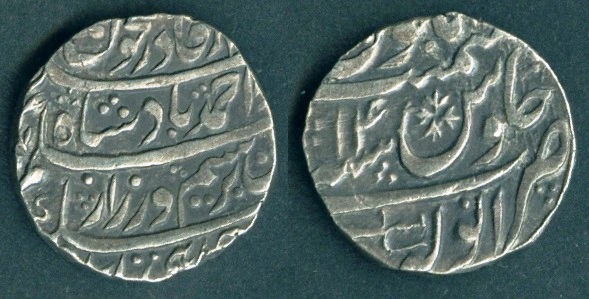 |
KM#228.1 Rupee.
Year:
AH xx74 (AH 1174) - RY14 [1765]. Weight:
11.10g. Metal:
0.925 Silver.
Diameter: 22.00 mm. Edge:
Plain. Alignment:
Rotated (1 o' clock). Mint:
Anwala.
Type1:
Quatrefoil in Arabic “S” of Julus, mint
name at bottom. |
Obverse couplet:
"حکم شد ازقادربیجون باحمد
بادشاه سکه زن برسیم وزرازا وجماهی تابماه" (hukm shud za
qadir-i bu-chun ba Ahmad padshah sikka zan bar sim wa zar az awj-i
mahi ta ba mah)
[The order came from the Peerless Powerful One to
King Ahmad to strike coin on gold and silver from the ascension of
Fish to the Moon].
Date at xx74 at the left side.
Reverse:
"zarb
Anwala sanat 14 julus maimanat manus" (struck at
Anwala
in the year
14 of the accession associated with tranquil prosperity). Sword at
the bottom left side.
Mintage:
N/A.
Minted Years:
AH1173//14 (1760) and
AH1174//14 (1760).
Ruler:
Ahmad Shah Abdali [Durrani] (1747-1772).
- Type2:
KM#228.2 has mint
name at the top. Mintage Years: AH1174//14 (1760).
- Type3:
KM#228.3 has mint
name at the bottom but has Hexafoil in Arabic “S” of Julus.
Mintage Years: AH1174//14 (1760).
Anwala is a village in the
Bhopal district of Madhya Pradesh, India. It is located in the
Huzur tehsil and the Phanda block. Anwala is 23 kilometers
south-west of Bhopal.
Note:
Coins mints by Ahmad Shah
Durrani during his reign: Attock, Ahmadshahi (Qandahar), Ahmadnagar-Farrukhabad, Anwala (Anola), Balkh,
Bareli, Bhakhar, Dera (Dera Ghazi Khan), Derajat (Dera Ismail Khan),
Herat, Kabul, Kashmir, Lahore, Mashhad, Multan, Muradabad, Najibabad, Peshawar,
Sarhind, Shanjahanabad (Delhi) and Tatta. |
|
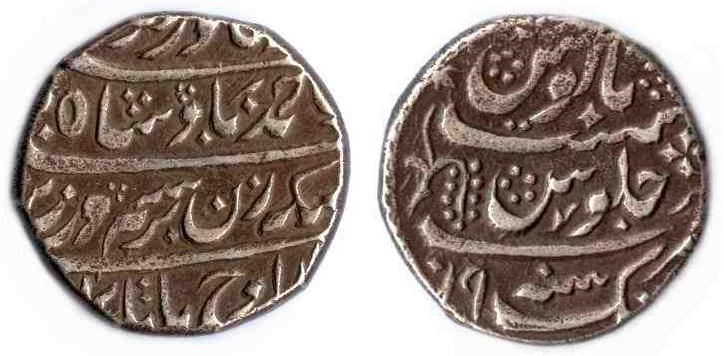 |
KM#233. Rupee.
Year:
ND - RY19
(1765). Weight:
11.21g. Metal:
0.925 Silver.
Diameter: 22.00 mm. Edge:
Plain. Alignment:
Rotated. Mint:
Attock.
This coin should be dated AH 1179. |
|
Obverse couplet:
"حکم شد ازقادربیجون باحمد
بادشاه سکه زن برسیم وزرازا وجماهی تابماه" (hukm
shud za qadir-i bu-chun ba Ahmad padshah sikka zan bar sim wa zar az
awj-i mahi ta ba mah)
[The order came from the Peerless Powerful One to King Ahmad to strike
coin on gold and silver from the ascension of Fish to the Moon].
Reverse:
"zarb
Attock sanat 19 julus maimanat
manus" (struck at
Attock
in the year 19 of the accession associated with
tranquil prosperity).
Mintage:
N/A.
Minted Years:
AH116x//9 (1755),
AH1170//11 (1756), AH1170//12 (1757), AH1171//11 (1757), AH1172//12
(1758), AH1173//13 (1759), AH1174//14 (1760), AH1177//81 (1764) Error
for 18, AH1179//19 (1765), AH11xx//20 (1766), AH1180//21 (1767),
AH1181//21 (1767) and AH1182//22 (1768).
Ruler:
Ahmad Shah Abdali [Durrani] (1747-1772). |
|
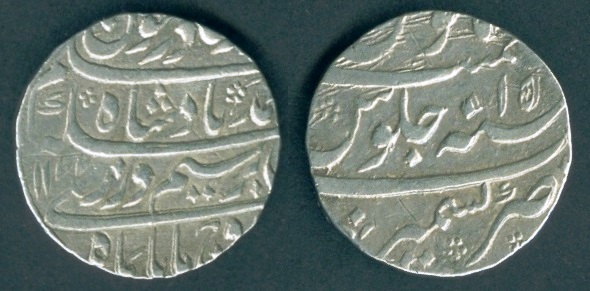 |
KM#553.
Rupee.
Year:
AH1177 - RY15 (1763).
Weight:
11.21g. Metal:
0.925 Silver.
Diameter: 22.00 mm.
Edge:
Plain. Alignment:
Rotated (4 o' clock). Mint:
Kashmir. |
|
Obverse couplet:
"حکم شد ازقادربیجون باحمد
بادشاه سکه زن برسیم وزرازا وجماهی تابماه" (hukm
shud za qadir-i bu-chun ba Ahmad padshah sikka zan bar sim wa zar az
awj-i mahi ta ba mah)
[The order came from the Peerless Powerful One to King Ahmad to strike
coin on gold and silver from the ascension of Fish to the Moon]. Date AH
1177 at the lower left side.
Reverse:
"zarb
Kashmir sanat 15 julus maimanat
manus" (struck at
Kashmir
in the year 15 of the accession associated with
tranquil prosperity).
Mintage:
N/A.
Minted Years:
AH1176//14 (1762),
AH1176//15 (1762), AH1177//15 (1763), AH1177//16 (1763), AH1178//17
(1764), AH1179//18 (1765), AH1179//19 (1765), AH1180//20 (1766),
AH1181//21 (1767), AH118x//21 (1767), AH1182//22 (1768), AH1184//23
(1770), AH1184//24 (1770), AH1185//24 (1771) and AH1186//25 (1772). |
|
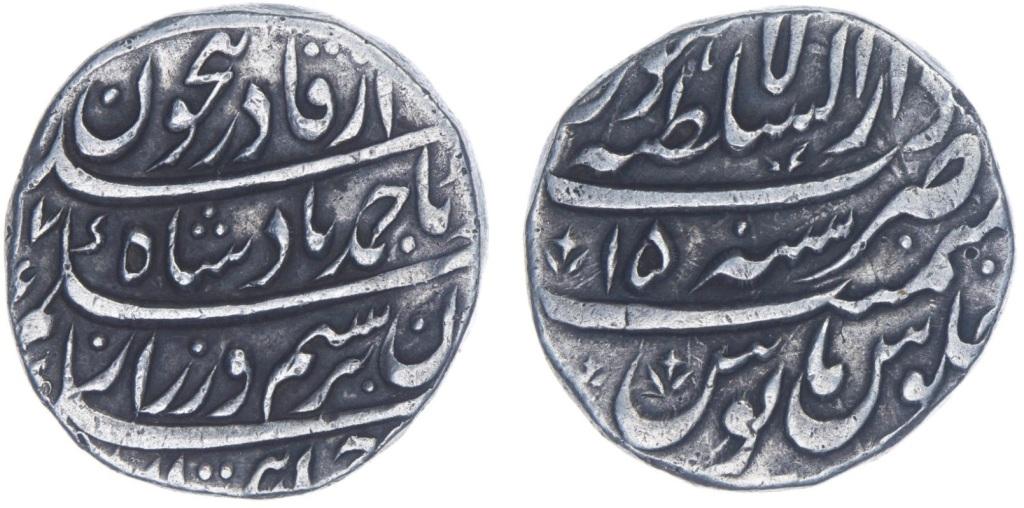 |
KM#623.
Rupee.
Year:
AHxx76 - RY15 (1762).
Weight:
11.22g. Metal:
0.925 Silver.
Diameter: 22.00 mm.
Edge:
Plain. Alignment:
Rotated. Mint:
Lahore.
This coin should be dated AH 1176.
Unpublished Date/RY combination in Krause publication. Therefore seems
to be a sic (mismatch Date and RY combination) coin. |
Obverse couplet:
"حکم شد ازقادربیجون باحمد
بادشاه سکه زن برسیم وزرازا وجماهی تابماه" (hukm
shud za qadir-i bu-chun ba Ahmad padshah sikka zan bar sim wa zar az
awj-i mahi ta ba mah)
[The order came from the Peerless Powerful One to King Ahmad to strike
coin on gold and silver from the ascension of Fish to the Moon].
Reverse:
"zarb
Dar-es-Sultanate Lahore sanat 15
julus maimanat manus" (struck at
seat of the Kingdom Lahore
in the year 15 of the accession associated with tranquil prosperity).
Mintage:
N/A.
Minted Years:
AH1165//5 (1751),
AH1170//10 (1756), AH1170//11 (1756), AH1172//13 (1758), AH1173//13
(1759), AH1173//14 (1759), AH1174//14 (1760), AH1173//15 (1760),
AH1174//15 (1761), AH1175//15 (1761), AH1175//16 (1762), AH1176//16
(1762), AH1176//17 (1763), AH1177//17 (1763), AH1177//18 (1764),
AH1178//18 (1764), AH1178//19 (1765), AH1179//19 (1765) and AH1180//21
(1767).
Ruler:
Ahmad Shah Abdali [Durrani] (1747-1772).
- KM#622 has "Lahore"
mint name at the bottom produced only in AH1161//1 (1748).
Note: Lahore
was lost to the Sikhs in AH1178 (1764 AD, VS1822), and the first Sikh
coinage was struck at Lahore in VS1822 and VS1823. However, the Durrani
forces briefly regained control over Lahore in AH1180, which began on 09
July 1766, late in VS1823. This 2nd Durrani occupation of Lahore lasted
only a few months, and Lahore was restored to Sikh authority later that
year, with a slightly modified Sikh coinage commencing in VS1824.
Durrani rupees of Lahore dated AH1170-1178 are reasonably common, but
there are none dated 1179 during the Sikh control, and only a few known
examples dated 1180. |
|
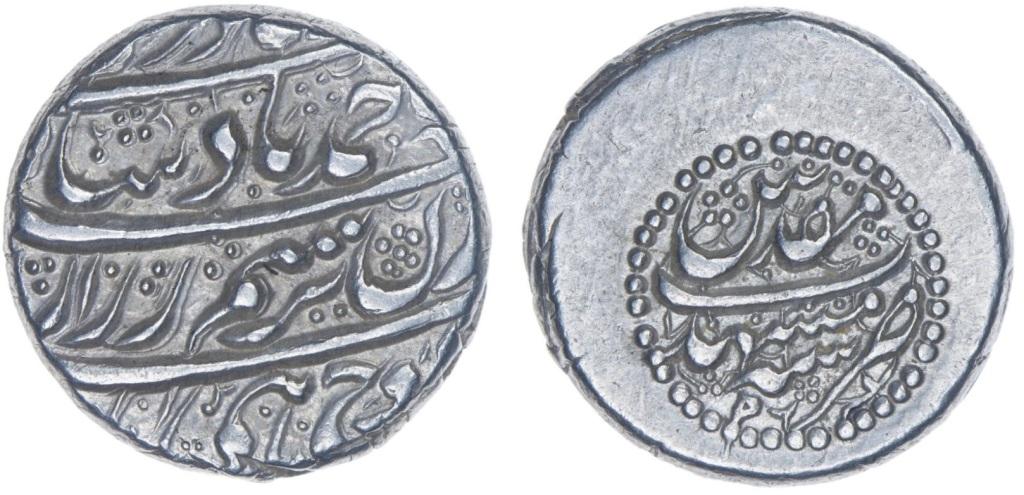 |
KM#638.
Rupee.
Year:
ND - RY9 (1755).
Weight:
11.22g. Metal:
0.925 Silver.
Diameter: 22.00 mm.
Edge:
Plain. Alignment:
Rotated. Mint:
Mashhad. |
|
Obverse couplet:
"حکم شد ازقادربیجون باحمد
بادشاه سکه زن برسیم وزرازا وجماهی تابماه" (hukm
shud za qadir-i bu-chun ba Ahmad padshah sikka zan bar sim wa zar az
awj-i mahi ta ba mah)
[The order came from the Peerless Powerful One to King Ahmad to strike
coin on gold and silver from the ascension of Fish to the Moon].
Reverse:
"zarb Muqaddas
Mashhad sanat 9" [struck at Sanctified (Holy)
Mashhad in the year 9]
written within center
dotted circle.
Mintage:
N/A.
Minted Years:
AH1168//8 (1754), AH116x//9
(1755), AH1170//10 (1756), AH1171//11 (1757) and AH1186 (1772).
Ruler:
Ahmad Shah Abdali [Durrani] (1747-1772).
Note:
Mashhad (Persian: مشهد, Mašhad) also
spelled Mashad or Meshad, is the second most populous city in Iran and
the capital of Razavi Khorasan Province. It is located in the northeast
of the country, near the borders with Turkmenistan and Afghanistan. It
includes the areas of Mashhad Taman and Torqabeh. It was a major oasis
along the ancient Silk Road connecting with Merv to the east. The city
is named after the "shrine" of Imam Reza, the eighth Shia Imam. The Imam
was buried in a village in Khorasan, which afterwards gained the name
Mashhad, meaning the place of martyrdom. Every year, millions of
pilgrims visit the Imam Reza shrine. The Abbasid caliph Harun al-Rashid
is also buried within the shrine. |
|
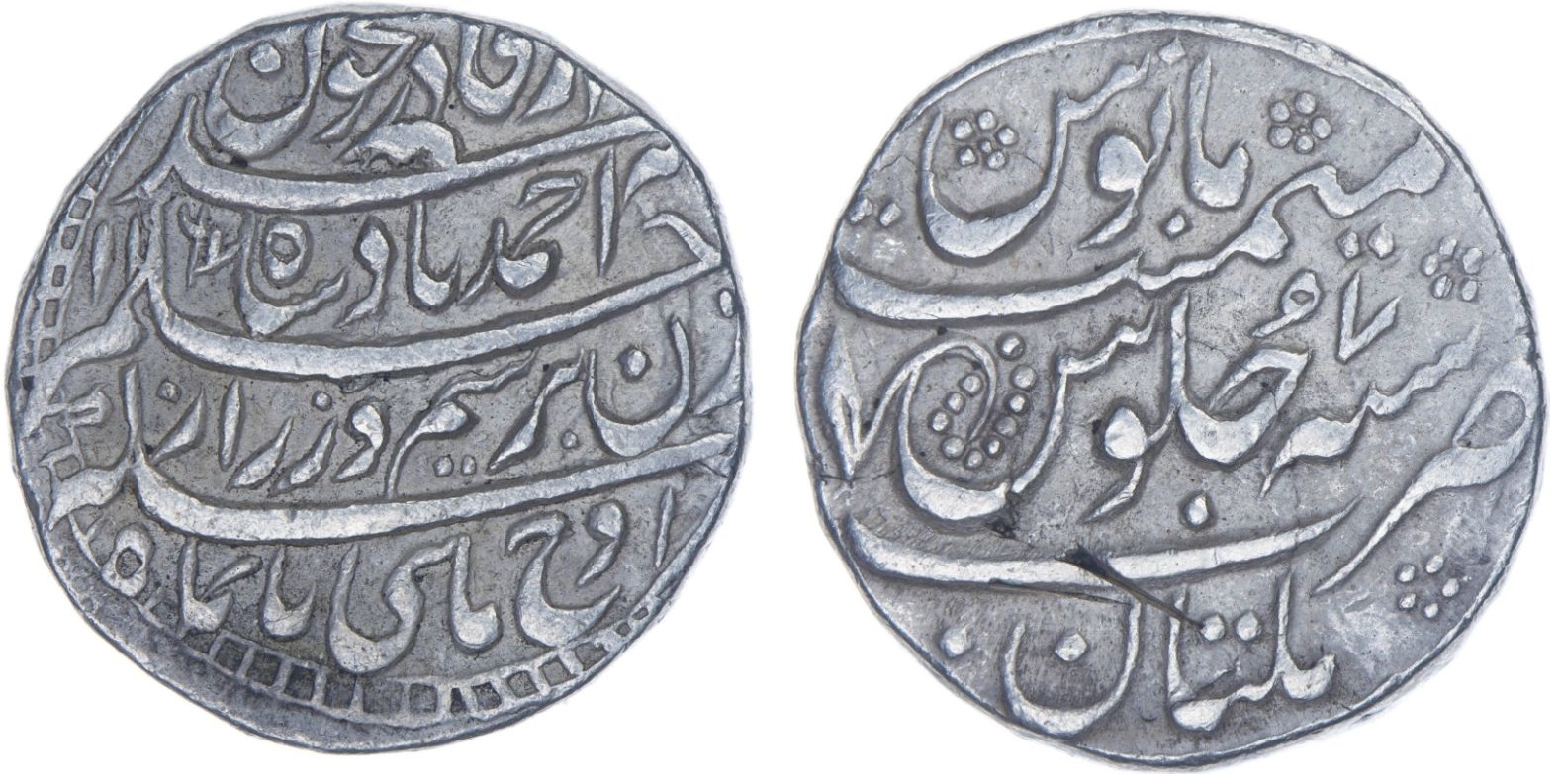 |
KM#643.
Rupee.
Year:
AH1167 - RY7 (1753).
Weight:
11.45g. Metal:
0.925 Silver.
Diameter: 22.50 mm.
Edge:
Plain. Alignment:
Medal. Mint:
Multan.
Border of rays between two linear
circles on both sides. |
|
Obverse couplet:
"حکم شد ازقادربیجون باحمد
بادشاه سکه زن برسیم وزرازا وجماهی تابماه" (hukm
shud za qadir-i bu-chun ba Ahmad padshah sikka zan bar sim wa zar az
awj-i mahi ta ba mah)
[The order came from the Peerless Powerful One to King Ahmad to
strike coin on gold and silver from the ascension of Fish to the
Moon] / AH 1167.
Reverse:
"zarb
Multan sanat 7 julus maimanat
manus" (struck at
Multan in the year 7 of the
accession associated with tranquil prosperity).
Mintage:
N/A.
Minted Years:
AH1165//5 (1751),
AH1166//5 (1752), AH1166//6 (1752), AH1167//6 (1753), AH1167//7
(1753), AH1168//7 (1754), AH1168//8 (1754), AH1170//9 (1756) and AH1170//10 (1756).
Ruler:
Ahmad Shah Abdali [Durrani] (1747-1772). |
|
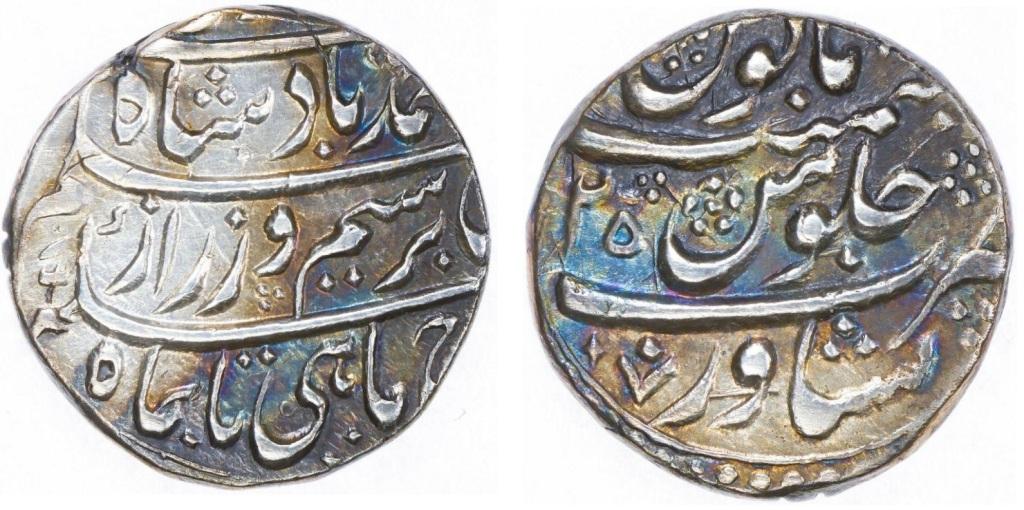 |
KM#693
Rupee.
Year: ND - RY 25 (1771).
Weight:
11.36g. Metal:
0.925 Silver.
Diameter: 21.50 mm.
Edge:
Plain. Alignment:
Rotated (9 o' clock).
Mint:
Peshawar.
As the date is off-flan, therefore
based on the catalog, this coin should be Dated: AH 1185 - RY25. |
|
Obverse couplet:
"حکم شد ازقادربیجون باحمد
بادشاه سکه زن برسیم وزرازا وجماهی تابماه" (hukm
shud za qadir-i bu-chun ba Ahmad padshah sikka zan bar sim wa zar az
awj-i mahi ta ba mah)
[The order came from the Peerless Powerful One to King Ahmad to
strike coin on gold and silver from the ascension of Fish to the
Moon] / ND.
Reverse:
"zarb
Peshawar sanat 25 julus maimanat
manus" (struck at
Peshawar
in the year 25 of the accession associated with tranquil
prosperity).
Mintage:
N/A.
Minted Years:
AH1160 (1747),
AH1161//1 (1748), AH1161//2 (1748), AH1162//2 (1748), AH1164//3
(1750), AH116x//4 (1750), AH1166//5 (1752), AH1166//6 (1752),
AH1168//9 (1755), AH1170//10 (1756), AH1171//11 (1757), AH1172//12
(1758), AH117x//14 (1760), AH117x//15 (1761), AH1176//16 (1762),
AH1177//17 (1763), AH117x//18 (1764), AH117x//19 (1765), AH118x//22
(1768), AH1183//23 (1769), AH1184//24 (1770), AH1185//25 (1771) and
AH1186//26 (1772).
Ruler:
Ahmad Shah Abdali [Durrani] (1747-1772). |
|
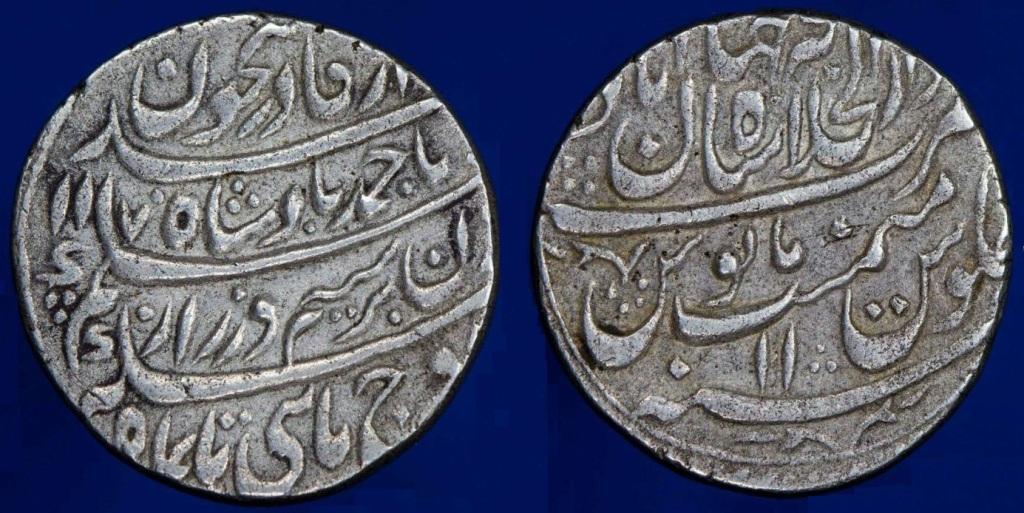 |
KM#763
Rupee.
Year: AH 1170 - RY 11 (1757).
Weight:
11.18g. Metal:
0.925 Silver.
Diameter: 23.00 mm.
Edge:
Plain. Alignment:
Medal. Mint:
Shahjahanabad (Delhi).
As the date is off-flan, therefore
based on the catalog, this coin should be Dated: AH 1185 - RY25. |
|
Obverse couplet:
"حکم شد ازقادربیجون باحمد
بادشاه سکه زن برسیم وزرازا وجماهی تابماه" (hukm
shud za qadir-i bu-chun ba Ahmad padshah sikka zan bar sim wa zar az
awj-i mahi ta ba mah)
[The order came from the Peerless Powerful One to King Ahmad to
strike coin on gold and silver from the ascension of Fish to the
Moon] / 1170.
Reverse:
"zarb
Shahjahanabad
sanat 25 julus maimanat manus" (struck at
Shahjahanabad
in the year 11 of the accession associated with tranquil
prosperity).
Mintage:
N/A.
Minted Years:
AH1170//11 (1757),
AH1173//14 (1760) and AH1174//15 (1760).
Ruler:
Ahmad Shah Abdali [Durrani] (1747-1772). |
|
Sulayman Shah Durrani: 1772 |
|
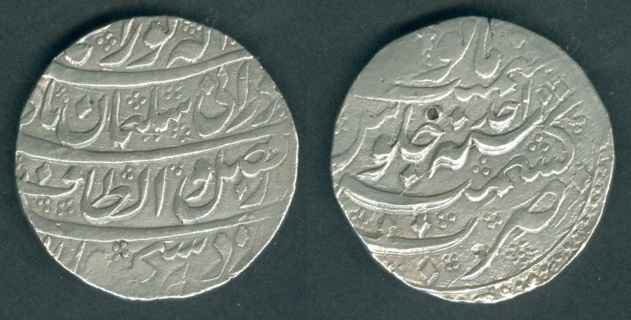 |
|
KM#558
Rupee.
Year: ND - Ahad
(1772). Weight:
10.99g. Metal:
0.925 Silver. Edge:
Plain. Alignment:
Rotated (7 o' clock).
Diameter:
24.00 mm. Mint:
Kashmir.
Obverse couplet:
Legends in four lines
// ND.
Reverse:
"Zarb Kashmir Sanah Ahad julus maimanat manus"
(Struck at Kashmir, in year First
of the accession associated with tranquil prosperity).
Mintage:
N/A.
Minted Years:
One year type.
Ruler:
Sulayman Shah.
Note:
Sulayman Shah was the
eldest son of Ahmad Shah and the son-in-law of the prime-minister,
Shah Wali Khan. There was an attempt to enthrone him. This resulted
in the single-year issue of coinage on Sulayman name in AH1186
(1772). Sulayman issued Silver Rupee at Ahmadshahi (Qandahar), Dera
(Dera Ghazi Khan), Kabul, Kashmir and Peshawar. Gold Mohur was
issued at Kabul only. |
|
Taimur
Shah Durrani as Nizam: 1757-1772 |
|
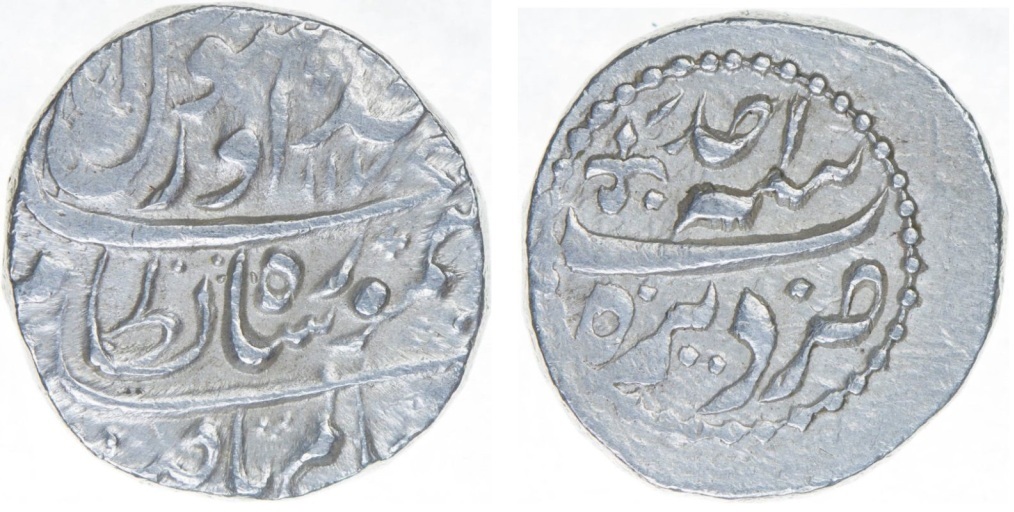 |
KM#318
Rupee.
Year: AH 1170 - Ahad (one) [1757].
Weight:
11.54g. Metal:
0.925 Silver.
Diameter: 20.50 mm.
Edge:
Plain. Alignment:
Coin. Mint:
Dera (Dera Ghazi Khan).
Taimur Shah Abdali [Durrani]
was Nizam (Governor) AH1170-1186 (1757-1772) at Dera during his father Ahmad
Shah Abdali's rule. Later Taimur became King of Afghanistan from 16 Oct 1772
to 18 May 1793. |
|
Obverse couplet:
"بعالم یافت سکه تیمورشاه
نظام بحکم خداورسول انام" (Ba-alam
yaft sikkah-i-Taimur Shah Nizam Ba-hukm-i-khuda-o-Rasul-i-anam)
[The stamp of Taimur Shah gained rule in the world by command of God and
of the Prophet of Mankind] // 1170.
Reverse:
"Zarb Dera sanat Ahad"
(Struck at Dera, in year First) written within center dotted circle.
Mintage:
N/A.
Minted Years:
AH1170//1 (1757),
ND//2 (1757) and ND//3 (1758).
Ruler:
Taimur Shah.
Note: The mint of Dera was
located at Dera Ghazi Khan. It was taken by the Sikhs in AH1235
(1819AD) and now within Pakistan. |
|
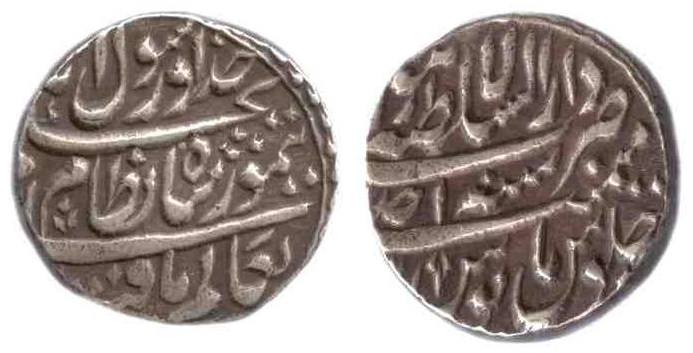 |
KM#628
Rupee.
Year: AH xxx1 - Ahad (one) [1757].
Weight:
11.34g. Metal:
0.925 Silver.
Diameter: 20.50 mm.
Edge:
Plain. Alignment:
Rotated. Mint:
Lahore.
This coin likes to be dated AH 1171.
Taimur Shah Abdali [Durrani]
was Nizam (Governor) AH1170-1186 (1757-1772) at Lahore during his father
Ahmad Shah Abdali's rule. Later Taimur became King of Afghanistan from 16
Oct 1772 to 18 May 1793. |
|
Obverse couplet:
"بعالم یافت سکه تیمورشاه
نظام بحکم خداورسول انام" (Ba-alam
yaft sikkah-i-Taimur Shah Nizam Ba-hukm-i-khuda-o-Rasul-i-anam)
[The stamp of Taimur Shah gained rule in the world by command of God and
of the Prophet of Mankind].
Reverse:
"Zarb Dar-es-Sultanate Lahore sanat
Ahad julus maimanat manus"
(Struck at Lahore, the Seat of Sovereignty, in year First
of the accession associated with tranquil prosperity).
Mintage:
N/A.
Minted Years:
AH1170//1 (1756),
AH1171//1 (1757), AH1172//1 (1758), AH1173//3 (1759) and AH1174//4
(1760).
Ruler:
Taimur Shah. |
|
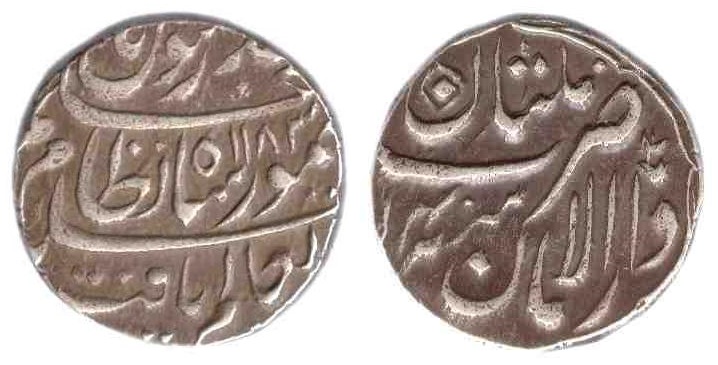 |
KM#652.4
Rupee.
Year: AH 1183 - RY14
(1770). Weight:
11.50g. Metal:
0.925 Silver.
Diameter: 20.00 mm.
Edge:
Plain. Alignment:
Almost coin.
Mint:
Multan. Mintage:
N/A.
Unlisted date in Krause and Mishler's book.
Taimur Shah Abdali
[Durrani] was Nizam (Governor) AH1170-1186 (1757-1772) at Multan during
his father Ahmad Shah Abdali's rule. Later Taimur became King of
Afghanistan from 16 Oct 1772 to 18 May 1793. |
|
Obverse couplet:
"بعالم یافت سکه تیمورشاه
نظام بحکم خداورسول انام" (Ba-alam
yaft sikkah-i-Taimur Shah Nizam Ba-hukm-i-khuda-o-Rasul-i-anam)
[The stamp of Taimur Shah gained rule in the world by command of God and
of the Prophet of Mankind].
The date (AH 1183) is in the middle line at right.
Reverse:
"Zarb Dar-ul-Aman Multan sanat 14" (Struck
at Multan, the Seat of Safety, in year 14). Mark: diamond or rhombus in
frame in the N of Multan.
Mintage Years:
AH1181//11 (1767) and AH1182 (1769).
Ruler: Taimur Shah
ibn Ahmad Shah (1772-1793).
|
|
Taimur
Shah Durrani: 1772-1793 |
|
 |
KM#270
Falus with single sword.
Year: AH 1202 (1787).
Weight: 7.68g [7.00 -
10.50g].
Metal: Copper.
Alignment: Medal,
slightly rotated. Diameter:
23.00 mm. Mint:
Balkh.
Obverse:
Zarb Balkh 1202
written within center
circle.
Reverse:
Falus Taimur Shah.
Mintage: N/A.
Minted Years:
AH1197 (1782), AH1202 (1787), AH1205 (1790) and
AH1206 (1791). Ruler:
Taimur Shah ibn Ahmad Shah (1772-1793).
Note:
AH1202 coin is ordinary found written as AH1220. |
|
 |
KM#290 Falus.
Year: AH 1189//8 (1775).
Weight: 16.00g [12.00
- 16.20g].
Metal: Copper.
Alignment:
Rotated (3 o'clock).
Diameter:
25.50 mm x 22.00 mm. Mint:
Bhakhar.
Obverse:
"Zarb Bhakhar 1189//8"
written within
center circle surrounded by dotted circle.
Reverse:
Falus Taimur Shah.
Mintage: N/A.
Minted Years:
AH1188 (1774), AH1189//8 (1775), AH1190//9 (1776),
AH1194 (1780), AH1196 (1781), AH1197 (1782) and AH1198 (1783).
Ruler: Taimur Shah ibn Ahmad Shah
(1772-1793). |
|
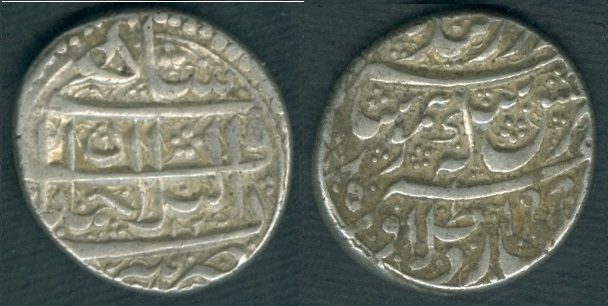 |
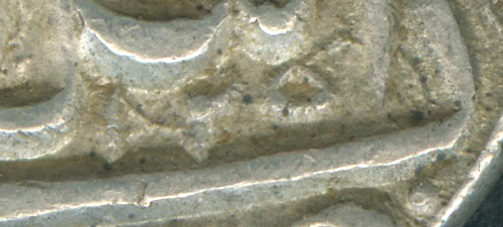 |
|
KM#124 Rupee.
Year: AH 1025 error =
AH 1205 [1790]. Weight:
11.56g.
Metal: Silver.
Diameter:
24.00 mm. Mint:
Ahmadshahi (Qandahar).
Edge:
Plain.
Alignment: Coin.
Obverse: "Zarb
Ashraf al-Bilad Ahmadshahi / 1025".
Reverse
couplet:
"چرخ مي آرد طلا و نقره از خورشید ماه تازید
برچهره نقش سکه تیمور شاه" (The heaven brings in
gold and silver from the sun and moon, so that it may receive the
impression of the stamp of Timur Shah)
written within center
circle surrounded by dotted circle.
Mintage:
N/A.
Minted Years:
AH1204//18 (1788), AH1205//19 (1789), AH1025
(1789) error for 1205, AH1206//19 (1790), AH1206//20 (1791), AH1026
(1791) error for 1206, AH1207//20 (1792), AH1027//21 (1792) error for
1207 and AH1207//12 (1792) error for year 21.
Ruler: Taimur
Shah ibn Ahmad Shah (1772-1793). |
|
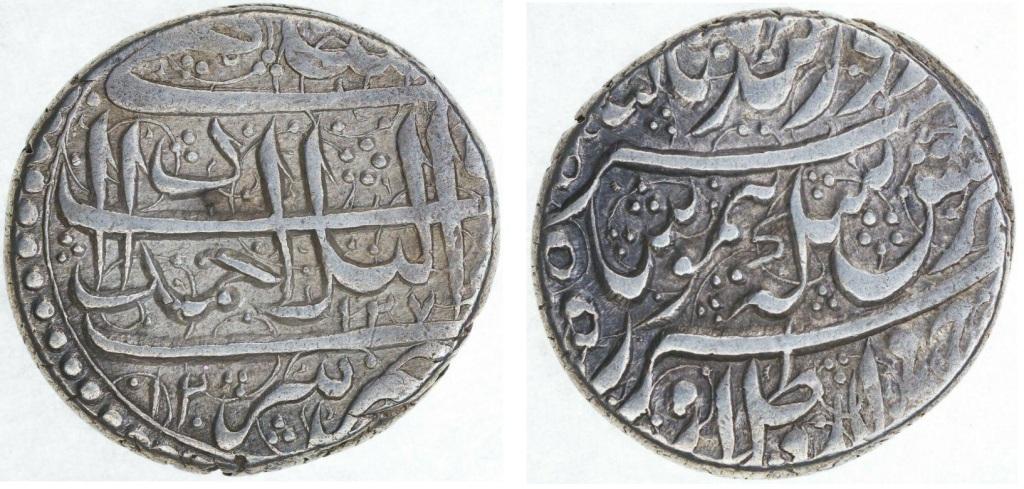 |
Same as above coin KM#124, but...
Rupee.
Year: AH 1207 - RY12
error for RY21 [1792]. Weight:
11.50g. Diameter:
24.00 mm. Alignment:
Rotated (7 o'clock).
Mintage:
N/A. |
|
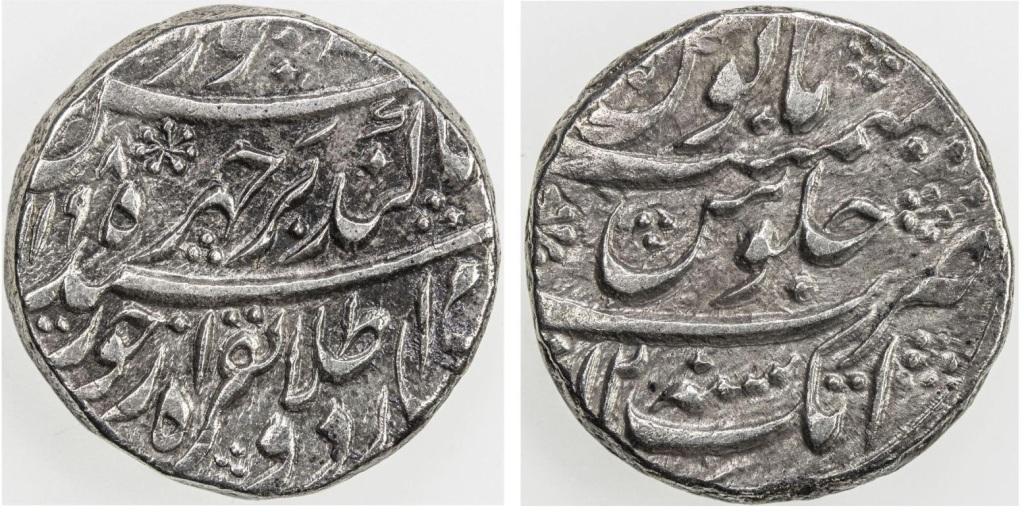 |
KM#238 / SA# 3100
Rupee.
Year: AH 1198 - RY 12
[1783]. Weight:
11.45g.
Metal: Silver.
Diameter:
20.50 mm. Mint:
Attock. Edge:
Plain.
Alignment: Rotated (3
o' clock).
|
|
Obverse couplet:
"چرخ مي آرد طلا و نقره از خورشید ماه تازید
برچهره نقش سکه تیمور شاه" (The heaven brings
in gold and silver from the sun and moon, so that it may receive the
impression of the stamp of Timur Shah)
written within center
circle surrounded by dotted circle.
Obverse:
"Zarb Attock Sanah 12 julus maimanat manus"
(Struck at Attock, in reign year 12 of the accession associated with
tranquil prosperity).
Mintage:
N/A.
Minted Years:
AH1186//1 (1772), AH1187//2 (1773), AH1188//2
(1774), AH1188 (sic)//4 (1774), AH1190//4 (1776), AH1192//4 (1778),
AH1193//8 (1779), AH1195//8 (1780), AH1195//10 (1780), AH1196//10
(1781), AH1196//11 (1781), AH1197//11 (1782), AH1197//12 (1782),
AH1197//14 (1782), AH1198//12 (1783), AH1198 (sic)//14 (1784) and
AH120x//16 (1786).
Ruler: Taimur
Shah ibn Ahmad Shah (1772-1793). |
|
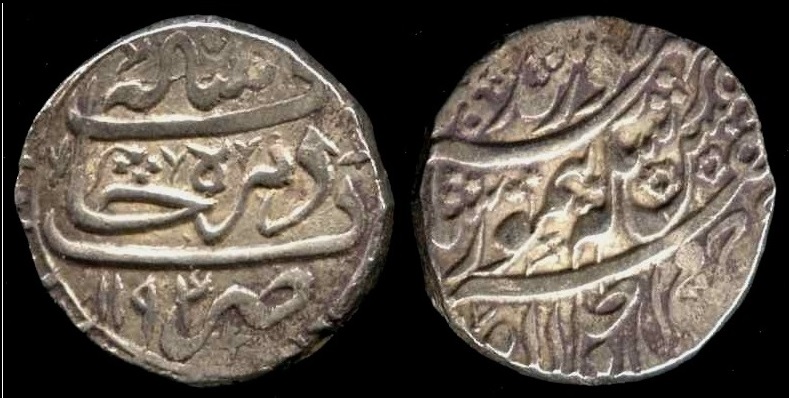 |
KM#353.
Rupee.
Year: AH 1194 - RY7
(1780). Weight:
11.00g. Metal:
0.925 Silver. Mint:
Derajat (Dera Ismail Khan).
Obverse:
Zarb Sikka
Derajat AH 1194 - RY7. |
|
Reverse
couplet:
"چرخ مي آرد طلا و نقره از خورشید ماه تازید
برچهره نقش سکه تیمور شاه" (The heaven brings in
gold and silver from the sun and moon, so that it may receive the
impression of the stamp of Timur Shah).
Mintage:
N/A.
Minted Years:
AH1187 (1773), AH1192//6 (1778), AH-//8 (1779),
AH1194//7 (1780), AH1196//10 (1781), AH1197//11 (1782), AH1198//12
(1783), AH1199//13 (1784), AH1199//14 (1784), AH1199 (sic)//15 (1785),
AH1200//15 (1785), AH1201//16 (1786), AH1202//17 (1787), AH1202
(sic)//18 (1788), AH1203//18 (1788), AH1204//18 (1789), AH1205//19
(1790), AH1206//19 (1790), AH1206//20 (1791), AH120x//21 (1791),
AH1207//20 (1792), AH1207//22 (1792), AH-//23 (1793), AH1208 (1793)
Posthumous and AH1209 (1794) Posthumous [Posthumous issues,
bearing no regnal year]. Ruler:
Taimur Shah ibn Ahmad Shah (1772-1793).
Note:
Other coins mints in his reign include: Ahmadshahi (Qandahar), Attock,
Balkh, Bhakhar, Dera (Dera Ghazi Khan), Herat, Kabul, Kashmir, Multan,
Peshawar, Rakib 'Mubarak' (Camp Mint), Sind and Tatta. Posthumous issues
has also been struck at various mints in AH 1208 - 1209 (1793-1794). |
|
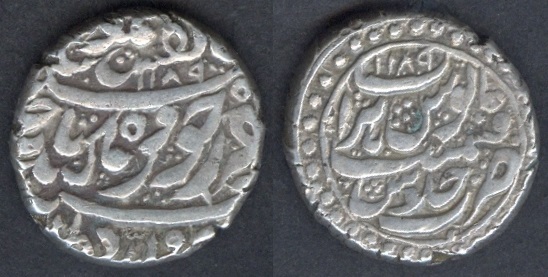 |
KM#383.1
Rupee.
Year: AH 1189 (1775).
Weight:
11.36g. Metal:
0.925 Silver. Edge:
Plain. Alignment:
Coin. Diameter:
21.50 mm. Mint:
Herat.
Note:
Date on both sides. |
|
Obverse
couplet:
"چرخ مي آرد طلا و نقره از خورشید ماه تازید
برچهره نقش سکه تیمور شاه" (The heaven brings
in gold and silver from the sun and moon, so that it may receive the
impression of the stamp of Timur Shah) / AH 1189.
Reverse:
"Zarb Herat Sanah 1189 julus maimanat manus"
(Struck at Herat, in year AH 1189 of the accession associated with
tranquil prosperity) written within center circle surrounded by
dotted circle.
Mintage:
N/A.
Minted Years:
AH1184 (1770), AH1187
(1773), AH1188 (1774), AH1189 (1775), AH1190 (1776), AH1191 (1777),
AH1192 (1778), AH1193 (1779), AH1194 (1780), AH1195 (1780), AH1196
(1781), AH1197 (1782), AH1198 (1783), AH1199 (1784) and AH1200
(1785).
Ruler:
Taimur Shah ibn Ahmad Shah
(1772-1793). |
|
 |
KM#383.2
Rupee.
Year: AH 1205 (1790).
Weight:
11.51g [11.20 - 11.60 grams].
Metal:
0.925 Silver. Edge:
Plain. Alignment:
Rotated (3 o' clock).
Diameter:
22.00 mm. Mint:
Herat.
Note:
Date on both sides at bottom left side. |
|
Obverse couplet:
"چرخ مي آرد طلا و نقره از خورشید ماه تازید
برچهره نقش سکه تیمور شاه" (The heaven brings
in gold and silver from the sun and moon, so that it may receive the
impression of the stamp of Timur Shah) / AH xxx5.
Reverse:
"Zarb Dar es-Sultanate Herat //
AH x205"
(Struck at Dar es-Sultanate Herat).
Mintage:
N/A.
Minted Years:
Minted Years:
AH1201 (1787), AH1202
(1788), AH1203 (1789), AH1204 (1790), AH1205 (1791), AH1206 (1792),
AH1207 (1793), AH1208 (1794), AH1209 (1795), AH1210 (1796),
AH1210//1201 (1796) and AH1211 (1797).
Ruler:
Taimur Shah ibn Ahmad Shah
(1772-1793).
Note:
Posthumous dates from AH 1208 were
struck by Mahmud Shah in opposition to Shah Zaman. |
|
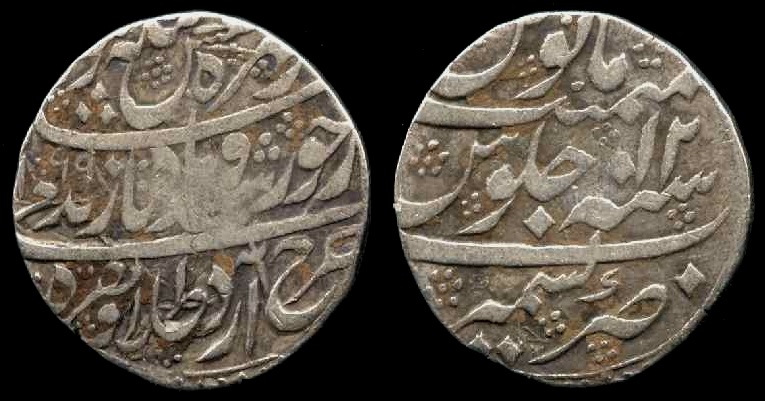 |
KM#563.
Rupee
Year: AH 1199 - RY12
(1784). Weight:
10.40g. Metal:
0.925 Silver. Mint:
Kashmir.
Contains different arrangement of
Reverse legend. |
|
Obverse
couplet:
"چرخ مي آرد طلا و نقره از خورشید ماه تازید
برچهره نقش سکه تیمور شاه" (The heaven brings in
gold and silver from the sun and moon, so that it may receive the
impression of the stamp of Timur Shah) / AH 1199.
Reverse:
"Zarb Kashmir Sanah 12 julus maimanat manus"
(Struck at Kashmir, in year 12
of the accession associated with tranquil prosperity).
Mintage:
N/A.
Minted Years:
AH1187//1 (1773), AH118x//3
(1774), AH1190//4 (1776), AH1191//5 (1777), AH1192//5 (1778), AH1193//6
(1779), AH1194//7 (1780), AH1195//7 (1780), AH1195//8 (1780), AH1196//9
(1781) different arrangement of the reverse legend, AH1197//9 (1782)
different arrangement of the reverse legend, AH1197//10 (1782),
AH1198//6 (1783), AH1198//7 (1783), AH1198//10 (1784), AH1198//11
(1784), AH1199//12 (1784) different arrangement of the reverse legend,
AH1200//12 (1785) different arrangement of the reverse legend,
AH1200//13 (1786), AH1201//13 (1786), AH1201//14 (1787), AH1202//14
(1787), AH1202//15 (1788), AH1203//15 (1788), AH1203//16 (1789),
AH1204//16 (1789), AH1204//17 (1790), AH1205//17 (1790), AH1206//19
(1791), AH1207//19 (1792), AH1207//20 (1793) and AH1208//20 (1793).
Ruler:
Taimur Shah ibn Ahmad Shah
(1772-1793). |
|
 |
Same as above coin KM#563, but...
Rupee.
Year: AH 1200 - RY12
(1785). Weight:
10.76g. Metal:
0.925 Silver. Edge:
Plain. Alignment:
Coin. Diameter:
22.50 mm. Mint:
Kashmir.
Mintage:
N/A.
Contains different arrangement of
Reverse legend (same as above coin). |
|
 |
Same as above coin KM#563, but unlisted Date/RY
combination in Krause publication.
Rupee.
Year: AH 1206 - RY17
(1791). Weight:
10.69g. Metal:
0.925 Silver. Edge:
Plain. Alignment:
Rotated (7 o' clock).
Diameter:
23.00 mm. Mint:
Kashmir.
Mintage:
N/A. This coin has
normal arrangement of Reverse legend,
different than above two coins. |
|
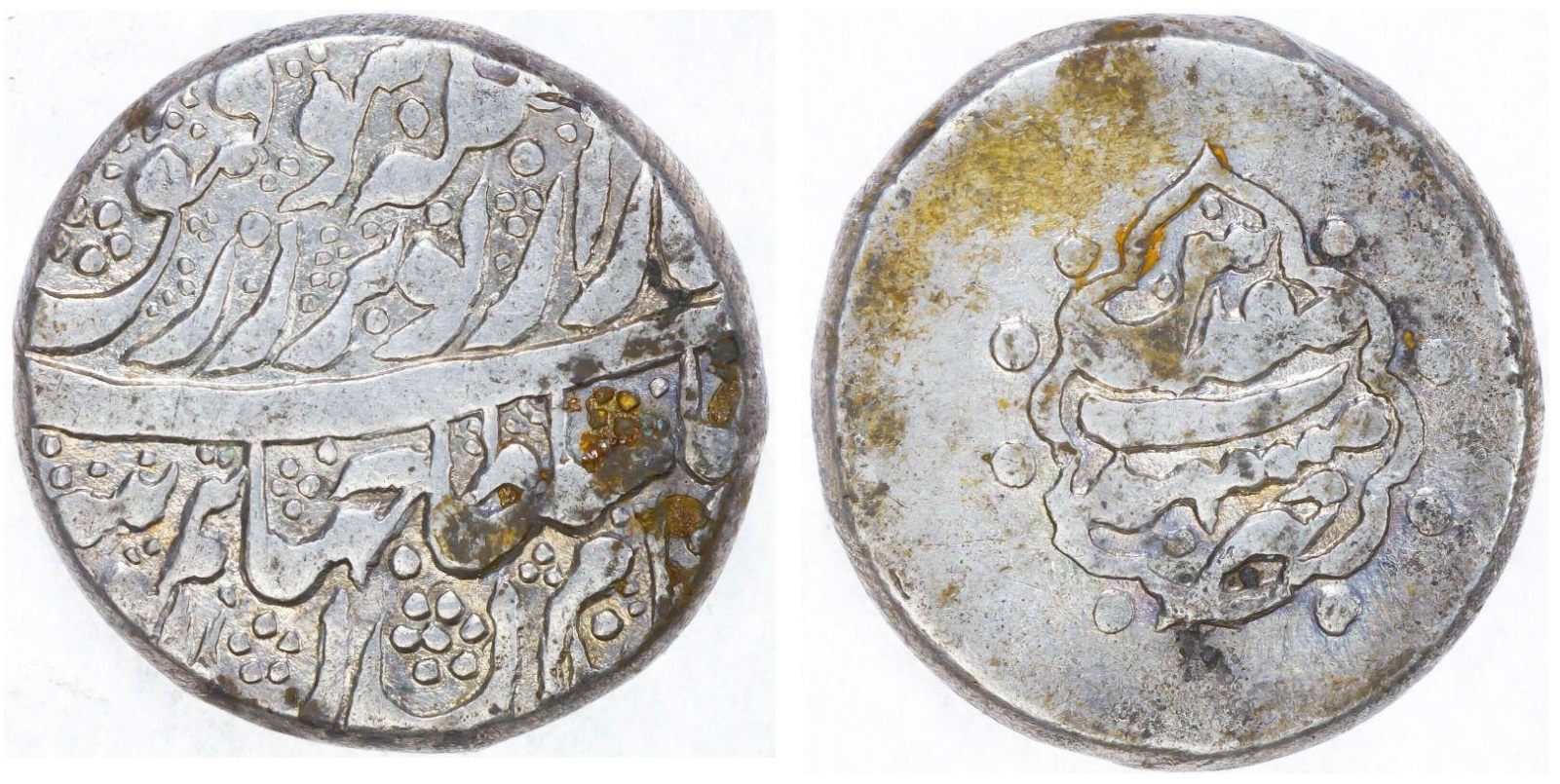 |
KM#B640
Rupee.
Year: ND (1776-1792).
Weight:
11.19g. Metal:
0.925 Silver. Edge:
Plain. Alignment:
Rotated (9 o' clock).
Diameter:
21.25 mm. Mint:
Mashhad. |
|
Obverse:
Persian Couplet in the
center.
Reverse:
"zarb Muqaddas
Mashhad" [struck at Sanctified (Holy) Mashhad]
written within center
cartouche design surrounded by 8 dots.
Mintage:
N/A.
Mintage Years:
AH119x (1776), AH1201 (1786), AH1202 (1787), AH1203 (1788), AH1204
(1789), AH1205 (1790) and AH12(0)7 (1792).
Ruler:
Taimur Shah ibn Ahmad Shah
(1772-1793). |
|
 |
KM#703
Rupee.
Year: AH x187 - RY2
(1773). Weight:
11.26g. Metal:
0.925 Silver. Edge:
Plain. Alignment:
Rotated.
Diameter:
21.50 mm. Mint:
Peshawar. |
|
Obverse
couplet:
"چرخ مي آرد طلا و نقره از خورشید ماه تازید
برچهره نقش سکه تیمور شاه" (The heaven brings
in gold and silver from the sun and moon, so that it may receive the
impression of the stamp of Timur Shah) / AH x187.
Reverse:
"Zarb Peshawar Sanah 2 julus maimanat manus"
(Struck at Peshawar, in year 2
of the accession associated with tranquil prosperity).
Mintage:
N/A.
Minted Years:
AH1186//1 (1772), AH1187//1
(1773), AH1187//2 (1773), AH1188//2 (1774), AH1188//3 (1774),
AH1189//4 (1775), AH1190//5 (1776), AH1191 (1777), AH1193//8 (1779),
AH1194//8 (1780), AH1195//10 (1780), AH1195//9 (1780), AH1196//10
(1781), AH1196//11 (1781), AH1197//10 (1782) Muling, AH1197//11
(1782), AH1197//12 (1782), AH1198//12 (1783), AH1199//12 (1783),
AH1199//13 (1784), AH1200//13 (1785), AH1201//15 (1786) and
AH1203//17 (1788).
Ruler:
Taimur Shah ibn Ahmad Shah
(1772-1793). |
|
Shah
Zaman Durrani: 1793-1801 |
Shah Zaman Durrani Sadozai (c. 1770 – 1844)
was ruler of the Durrani Empire from 1793 until 1800. He was the
grandson of Ahmad Shah Durrani and the fifth son of Timur Shah Durrani.
An ethnic Pashtun like the rest of his family and Durrani rulers, Shah
Zaman became the third King of Afghanistan. Zaman Shah belonged to
Sadozai family.
He seized the throne of the Durrani Empire on the death of his father,
Timur Shah. He defeated his rivals, his brothers, with the help of
Sardar Payenda Khan, chief of the Barakzais. He extracted an oath of
allegiance from the final challenger, Mahmud, and in return relinquished
the governorship of Herat. In so doing, he divided the power base
between Herat and his own government in Kabul, a division which was to
remain in place for a century. Kabul was the primary base of power,
while Herat maintained a state of quasi-independence. Qandahar was
fought over for the spoils. During his reign he tried to combine his
dispersed relatives together who were deported by his father Timur Shah.
His uncle Saifullah Khan Durrani, his sons Mohammad Umar, Bashir Ahmad
Khan and Shams Ur Rehman, his cousins Faizullah Khan and Abdullah Khan
lived in Akora Khattak in present-day Khyber Pakhtunkhwa. They were
contacted to come back to Afghanistan but without success. Saifullah
Khan died in 1779 and after that the family was led by Faizullah Khan
but he disliked the bad habits of Abdullah Khan and Bashir Ahmad Khan
and left Akora Khattak and went to Bannu without informing his
relatives. Later on, after the death of his wife, Abdullah Khan Durrani
migrated to Kohat in 1791 where he married a widow, Pashmina.
Shah Zaman tried his best to recombine his family members and relatives
so as to gain power but many of them were living an unknown life. Some
of them have even been forgotten their identity.
He attempted to repeat his father's success in India, but his attempts
at expansion attempts were failed by the Sikhs and also brought him into
conflict with the British. The British induced the Shah of Persia to
invade Durrani, thwarting his plans by forcing him to protect his own
lands. In his own lands things went well for Zaman, at least initially.
He was able to force Mahmud from Herat and into a Persian exile.
However, Mahmud established an alliance with Fateh Khan, with whose
support he was able to strike back in 1800, and Zaman had to flee toward
Peshawar. But he never made it; on the way, he was captured, blinded and
imprisoned in Kabul, in the Bala Hissar (a fortress located in the south
of the old city of Kabul).
Zaman Shah was rescued when his brother Shujah Shah Durrani became the
king after toppling Mahmud Shah Durrani in 1803. He lived in 'blinded'
luxury up to 1809 when Mahmud Shah Durrani again seized the throne.
While his brother, Shujah Shah was captured by the Governor of Attock,
Zaman Shah managed to escape with the zenana (ladies of the house) of
his brother and his own to Lahore and sought asylum from Maharaja Ranjit
Singh in 1810. He was first allowed to stay at Rawalpindi but, in 1811,
Zaman Shah received full state honours at Lahore by Sikh ruler Ranjit
Singh. After a few years, Zaman Shah moved to Ludhiana where he lived
with a pension of Rs 24,000 from the British. Zaman Shah never went back
to Afghanistan even after his brother, Shujah Shah Durrani was
reinstated on the throne with the help of the British and the Sikhs
under Ranjit Singh. He died at Ludhiana in 1844. He is buried at the
mazar of Ahmad al-Faruqi al-Sirhindi in Sirhind-Fatehgarh, Punjab
(India). |
|
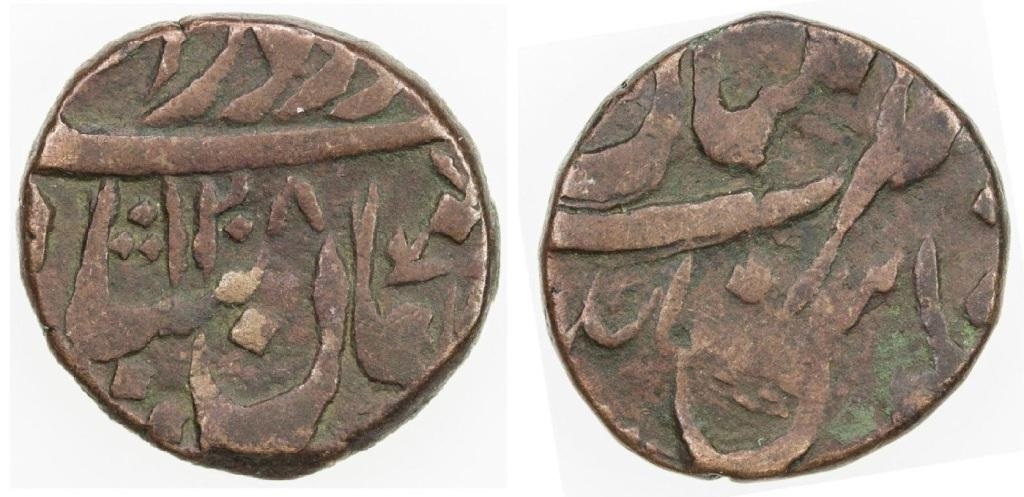 |
KM#660.
Falus.
Year: AH 1208 - Ahad (1793).
Weight:
12.08g [11.50 - 12.20g]. Metal:
Copper. Edge:
Plain. Alignment:
Coin. Diameter:
21.00 mm [21.50 - 23.00 mm]. Mint:
Multan. |
|
Obverse:
"Zaman Shah /
AH 1208".
Reverse:
"Zarb Multan
Sanat Ahad julus maimanat manus" (struck at Multan in the year
First of the accession associated with tranquil prosperity).
Mintage:
N/A.
Mintage Years:
AH1208//Ahad (1793), AH1209//2 (1794), AH1210//4 (1796), AH1211//4
(1796), AH1212//5 (1797) and AH1215//8 (1800).
Ruler:
Shah Zaman [fifth son of Timur Shah] (1793-1801).
Other coins, mints during
Shah Zaman's reign include: Ahmadshahi (Qandahar), Bhakhar, Dera (Dera
Ghazi Khan), Herat, Kabul, Kashmir, Lahore, Mashhad, Multan, Peshawar
and Qandahar.
Note:
In the battle of Panipat, in 1626, the
Rajah of Gwalior was slain and his most precious jewel, the Koh-i-Nur,
valued ‘at half the daily expense of the whole world’, came to Humayun,
son of Babur. Two centuries later the wonderful store of gems belonging
to Humayun’s descendants was carried off to Afghanistan. The treasures
of Nadir were looted by the Durranis. The Koh-i-Nur was taken from Shah
Zaman when he was dethroned and blinded by his half brother Mahmud but
was later recovered by Zaman’s full brother Shuja, together with a
famous ruby called Fakhr. Shuja in his turn was driven out of Kabul; he
fell into the hands of the Sikhs and was constrained to deliver up the
Koh i Nur diamond to Ranjit Singh. After the Sikh Wars the priceless
stone came to the British Crown. |
|
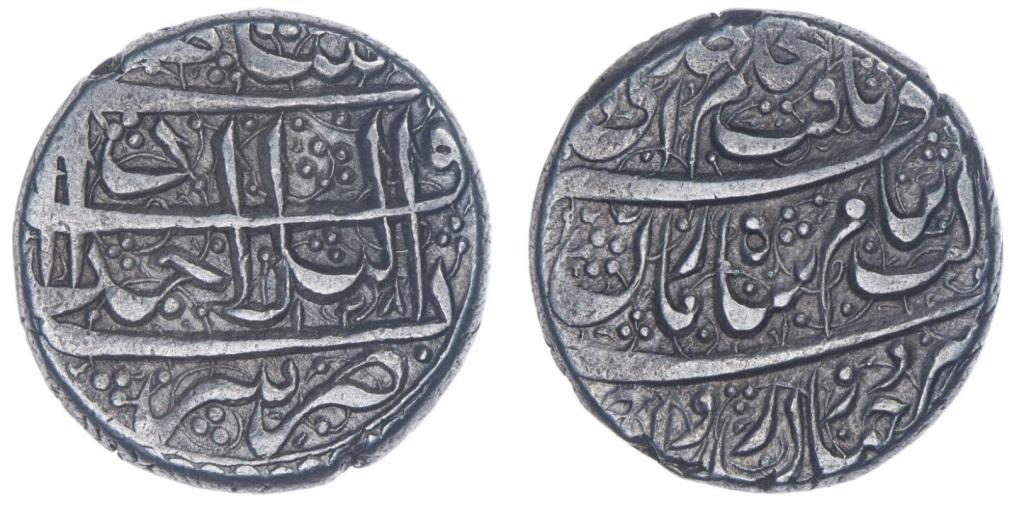 |
KM#133.
Rupee.
Year: AH 1208 (1793).
Weight:
11.50g. Metal:
0.925 Silver. Edge:
Plain. Alignment:
Coin. Diameter:
23.50 mm. Mint:
Ahmadshahi (Qandahar). |
|
Obverse:
"Zarb Ashraful-bilad Ahmad Shahi /
AH 1208" (Struck at
Ahmadshahi, the Most Noble of the Cities / AH 1208).
Reverse couplet:
"قراریافت
بحکم خدای هردوجهان رواج سکه دولت بنام شاه زمان"
(Obtained permanency by command of the Lord of both Worlds, Current coin
of the realm through the name of Shah Zaman).
Mintage:
N/A.
Mintage Years:
AH1207 (1792), AH1208 (1793), AH1209//2 (1794), AH1210//3 (1795),
AH1201// (1795) error for 1210, AH1211//2 (1796), AH1211//4 (1796),
AH1212//5 (1797) and AH1213//6 (1798).
Ruler:
Shah Zaman [fifth son of Timur Shah] (1793-1801). |
|
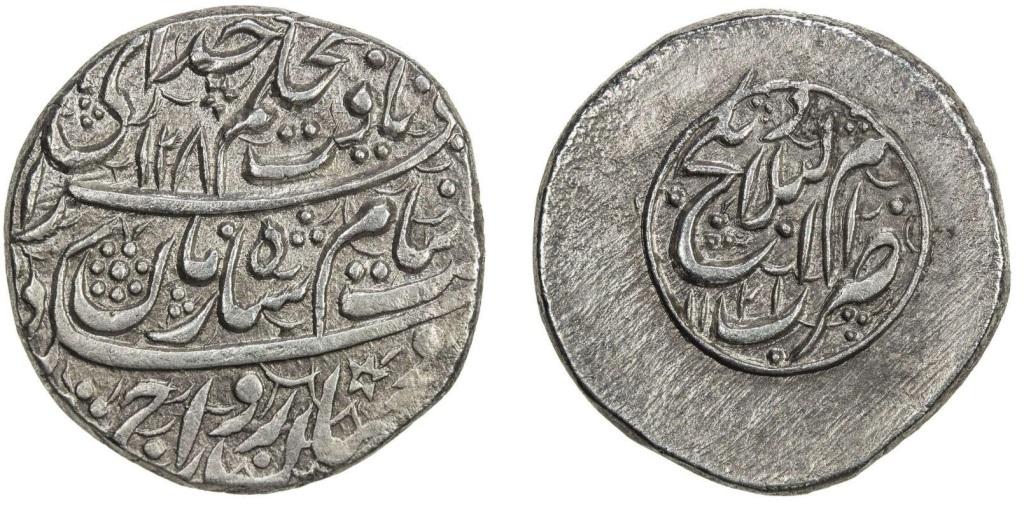 |
SA# 3108.
Rupee.
Year: AH 1208 // 1121
error for 1211 (1796). Weight:
10.89g. Metal:
0.925 Silver. Edge:
Plain. Alignment:
Rotated (5 o'clock).
Diameter:
24.00 mm. Epithet Mint Name:
Umm al-bilad Balkh. |
|
Obverse:
Persian Couplet with
date 1208 at the center top left side.
Reverse:
"Zarb
Umm al-bilad Balkh / 1121" [struck at mother of the cities Balkh / 1121]
written within the center
circle.
Mintage:
N/A.
Mintage Years:
One year type.
Ruler:
Shah Zaman [fifth son of Timur Shah] (1793-1801). Unlisted in
Krause publications. Extremely rare as very few sample are known with
collectors.
Note: This appears to be the first
reported rupee of Balkh in the name of Shah Zaman. The reverse date
"1121 " is probably retrograde for 1211, the actual year of issue,
utilizing an old obverse die dated 1208. Purchase from Stephen Album
Auction No. 34 (Auction Date: May 23-26, 2019), Lot No. 973
(249092). |
|
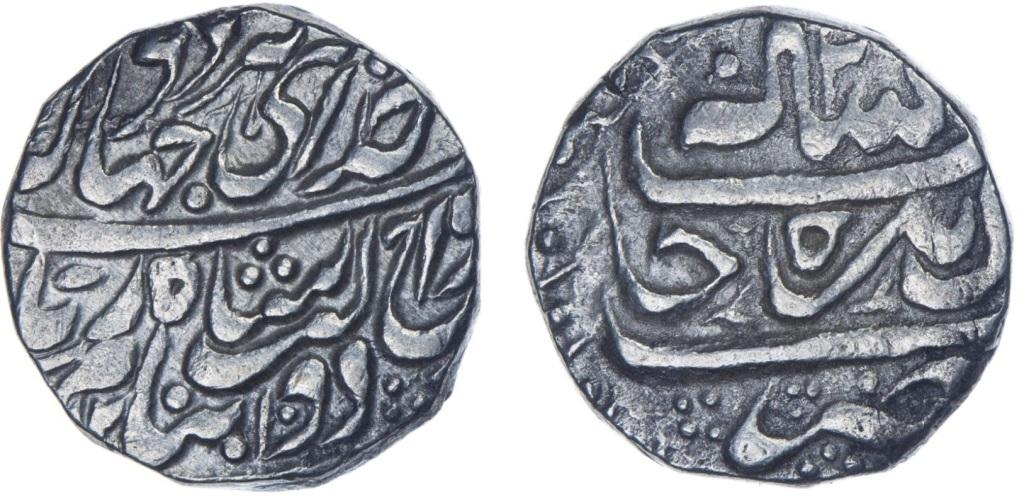 |
KM#358.
Rupee.
Year: AH 1210 - RY2
(1795). Weight:
10.85g. Metal:
0.925 Silver. Edge:
Plain. Alignment:
Rotated.
Diameter:
21.00 mm. Mint:
Derajat (Dera Ismail Khan). |
|
Obverse couplet:
"قراریافت
بحکم خدای هردوجهان رواج سکه دولت بنام شاه زمان"
(Obtained permanency by command of the Lord of both Worlds, Current coin
of the realm through the name of Shah Zaman) / AH 1210.
Reverse: "Zarb
Derajat Sanah 2"
(Struck at Derajat in the year 2).
Mintage:
N/A.
Mintage Years:
AH1207//1, AH1208//1, AH1209//2, AH1210//2, AH1211//2, AH1212//2,
AH1212//6, AH1213//7, AH1214//7, AH1214//8 and AH1215//8 (1793-1800)
[The reignal year 2 was retained for four years, for reasons unknown
today].
Ruler:
Shah Zaman [fifth son of Timur Shah] (1793-1801). |
|
 |
Same as above coin
KM#358, but...
Year: AH 1212 (1798).
Weight:
10.80g. Mint:
Derhojat (Dera Ismail Khan).
Mintage:
N/A.
"Derhojat" is unpublished spelling mint
name mentioned in "Catalogue of Durrani coins Lahore Museum" by
Whitehead and also under KM#358 in Krause publication (18th century, 3rd
edition). The correct spelling is "Derajat". |
|
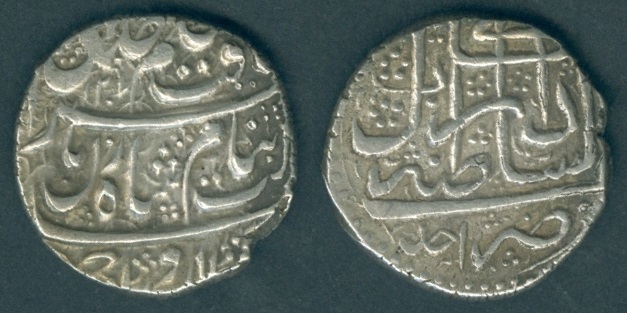 |
KM#443.
Rupee.
Year: AH 1207 - Ahad
(1793). Weight:
11.43g. Metal:
0.925 Silver. Edge:
Plain. Alignment:
Rotated (4 o' clock).
Diameter:
23.00 mm. Mint:
Kabul. |
|
Obverse couplet:
"قراریافت
بحکم خدای هردوجهان رواج سکه دولت بنام شاه زمان"
(Obtained permanency by command of the Lord of both Worlds, Current coin
of the realm through the name of Shah Zaman) / AH 1207.
Reverse: "Zarb
Dar es-Sultanate Kabul Sanah Ahad
julus maimanat manus"
(Struck at Dar es-Sultanate Kabul in the year First of the accession
associated with tranquil prosperity).
Mintage:
N/A.
Mintage Years:
AH1207//1 (1793), AH1208//1 (1793), AH1208//2 (1794), AH1209//2
(1794), AH1209//3 (1795), AH1210//4 (1796), AH1211//4 (1796) and
AH1212//4 (1797) - Muling with old die.
Ruler:
Shah Zaman [fifth son of Timur Shah] (1793-1801). |
|
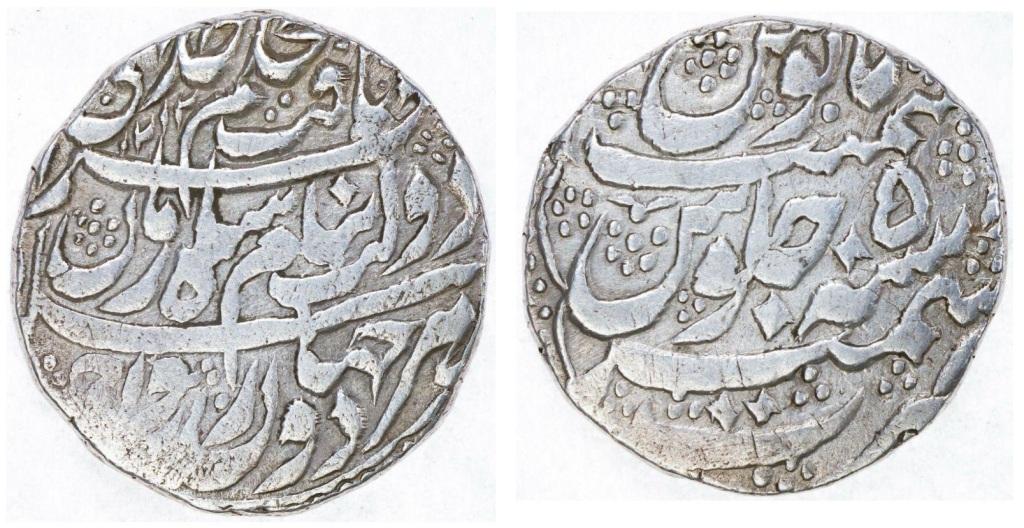 |
KM#575.
Rupee.
Year: AH 1212 - RY5
(1797). Weight:
10.70g. Metal:
0.925 Silver. Edge:
Plain. Alignment:
Rotated (10 o' clock).
Diameter:
23.50 mm. Mint:
Kashmir. |
|
Obverse couplet:
"قراریافت
بحکم خدای هردوجهان رواج سکه دولت بنام شاه زمان"
(Obtained permanency by command of the Lord of both Worlds, Current coin
of the realm through the name of Shah Zaman) / AH 1212.
Reverse: "Zarb
Kashmir Sanah 5
julus maimanat manus"
(Struck at Kashmir in the year 5
of the accession associated with tranquil prosperity).
Mintage:
N/A.
Mintage Years:
AH1208//2 (1794), AH1209//2 (1794), AH1209//3 (1795), AH1210//3 (1795),
AH1211//4 (1796), AH1211//5 (1797) and AH1212//5 (1797).
Ruler:
Shah Zaman [fifth son of Timur Shah] (1793-1801). |
|
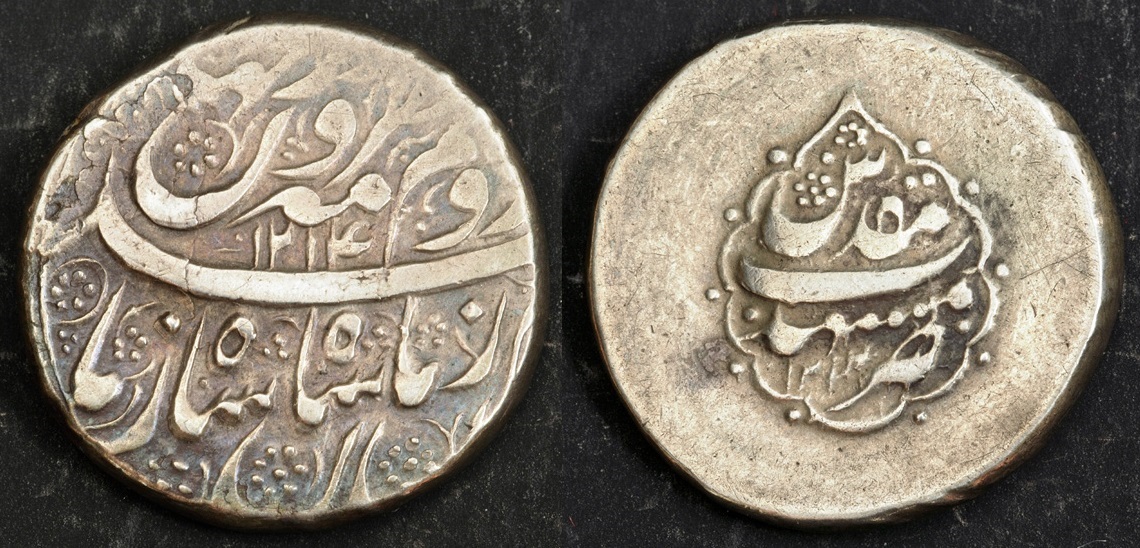 |
KM#E640 / SA# 3108.
Rupee.
Year: AH 1214 (1799).
Weight:
11.36g. Metal:
0.925 Silver. Edge:
Plain. Alignment:
Rotated (7 o'clock).
Diameter:
21.00 mm. Mint:
Mashhad. |
|
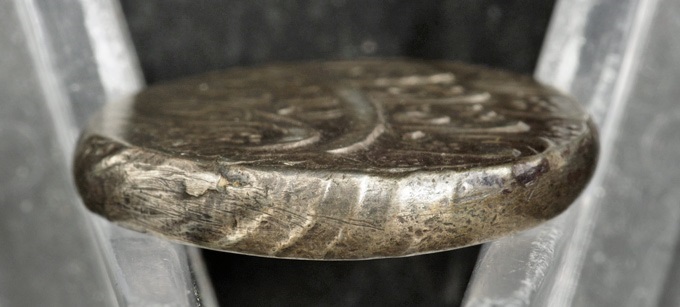 |
|
Obverse:
Persian Couplet with
date 1214 in the center.
Reverse:
"zarb Muqaddas
Mashhad / 1213/4" [struck at Sanctified (Holy)
Mashhad / 1213/4]
written within center
cartouche design surrounded by 10 dots.
Mintage:
N/A.
Mintage Years:
AH1212 (1797). AH1213 (1798) and AH1214 (1799).
Ruler:
Shah Zaman [fifth son of Timur Shah] (1793-1801). A few curved
lines can be seen on the edge of the coin as image shown above.
Note:
Strictly speaking, this coin is
considered as an issue by the Persian Afsharid ruler Nadir Mirza
Afshar (AH 1210-1218), who recognized Durrani suzerainty and struck
coins at Mashhad in the Durrani rulers names, except during AH1216.
Nadir Mirza Afshar was great-grandson of Nader Shah the founder of
the Afsharid dynasty of Persia. He was the fourth son of Shahrukh
Afshar emperor of Khorasan.
In 1785 Shahrukh appointed Nadir Mirza as crown prince of Khorasan.
This appointment displeased Nasrollah Mirza who was the older
brother of Nadir Mirza. The two brothers had few armed clashes and
when Nadir Mirza was defeated he fled to Tabas. Nasrollah Mirza died
in Mashhad in 1787 and Nadir Mirza was restored as crown prince of
Khorasan. In 1796 Shahrukh's Afsharid dynasty was conquered by Agha
Muhammad Khan, the founder of the Qajar Dynasty. Shahrukh was
tortured and killed and the Qajar Shah appointed a Qajar Governor
for Khorasan.
When Agha Muhammad Khan died in 1797 and Fath Ali Shah (his nephew)
sat on the throne of Persia, Nadir Mirza Afshar was appointed as
Governor of Khorasan. However Nadir Mirza was an ambitious man and
wanted to regain independence, so in 1802, he rebelled against the
Qajar Shah from his capital, Mashhad. His rebellion was a disaster
as he was taken prisoner to Tehran, blinded and had his tongue cut
off. He was killed on the orders of Fath Ali Shah in April 1803,
along with his eldest sons Abbas Mirza and Ibrahim Mirza. His other
three sons Tahmasp Mirza, Khaliq Vardi Mirza and Mahboub Ali Mirza
were blinded by the orders of Fath Ali Shah. Another son, Ismail
Mirza, fled to Hyderabad, Deccan. He settled there with help from
Sir John Malcolm. |
|
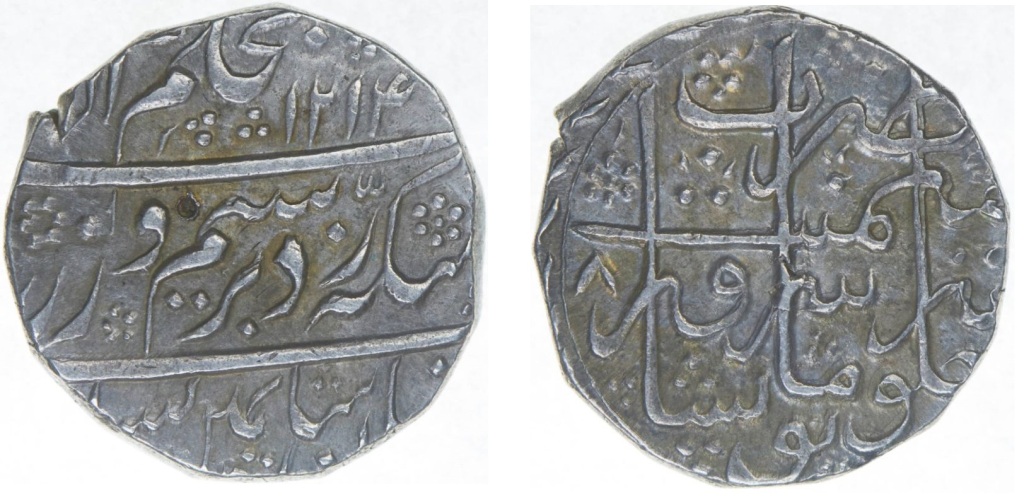 |
KM#A713.
Rupee.
Year: AH 1214 - RY8
(1799). Weight:
11.61g. Metal:
0.925 Silver. Edge:
Plain. Alignment:
Rotated.
Diameter:
22.00 mm. Mint:
Peshawar. |
|
Obverse couplet:
"قراریافت
بحکم خدای هردوجهان رواج سکه دولت بنام شاه زمان"
(Obtained permanency by command of the Lord of both Worlds, Current coin
of the realm through the name of Shah Zaman) / AH 1214.
Reverse: "Zarb
Peshawar Sanah 8 julus maimanat manus"
(Struck at Peshawar in the year 8
of the accession associated with tranquil prosperity).
Mintage:
N/A.
Mintage Years:
AH1211//4 (1796), AH1211//5 (1797), AH1212//5 (1797), AH1213//6 (1798),
AH1214//6 (1799), AH1214//8 (1800) and AH1215//8 (1800).
Ruler:
Shah Zaman [fifth son of Timur Shah] (1793-1801). |
|
 |
|
KM#444.
Two Rupees.
Year: ND - RY6
(1798). Weight:
23.04g.
Metal:
0.925 Silver. Edge:
Plain. Alignment:
Rotated (10 o' clock).
Diameter:
25.00 mm. Mint:
Dar-es-Sultanate Kabul.
Obverse couplet:
Persian legends within the
center circle and in circular form outside the center circle.
Reverse: "Zarb
Dar-es-Sultanate Kabul Sanah 6"
(Struck at Seat of Sovereignty Kabul in the year 6).
Mintage:
N/A.
Mintage Years:
AH1212//5 (1797), AH1212//6 (1797), AH1213//6 (1798) and AH121x//7
(1799).
Ruler:
Shah Zaman [fifth son of Timur Shah] (1793-1801). |
|
| |
- BARAKZAI
- Mahmud Shah (1st
time)............................25 Jul 1801 -
Jul 1803
- Minted coins at Bahawalpur, Bhakhar (Bhakkar),
Dera Ghazi Khan, Dera Ismail Khan, Herat, Qandahar, Kabul, Kashmir, Mashhad
[it was seized by Fath Ali Shah and permanently annexed to Iran in AH1218
(1803)], Multan and Peshawar.
- Qaisar Shah (rebel
at Kabul & Qandahar).........................1803
- He also ruled Kabul in AH
1222 (1807) and Kashmir AH 1222 - 1223 (1807-1808).
-
Mahmud Shah (2nd
time and also in Kashmir)........03 May 1809 -
1818
- Son of
Taimur Shah and was King at Qandahar in 1808
and again from 1809 to 1818. Captured Kabul and ruled Herat from 03 May 1809
to 1818. Minted coins at Dera Ismail Khan, Multan and Peshawar from 1808 to
1817.
- Mahmud Shah (3rd time
at Herat)..........................1818
- 1819
-
Shirdil Khan Mohammadzai (regent at Qandahar)............1819
- 1826
- He was son of Payinda (Sarafraz) Khan. Briefly ruled Herat in 1819.
-
Mahmud Shah (4th
time at Herat)..........................1819
- 1826
- Habibollah Shah Mohammadzai (only
at Kabul).....................1823
- Sultan Yar Mohammad Khan Mohammadzai (regent at Kabul)...1823 - 1826
- Dost Muhammad Khan
Mohammadzai (1st
time)................1824 - 02 Aug 1839
- Regent at Kabul till 1836,
then as Emir from 1836 to 1839. British Prisoner from 1840 to 1842.
- Kamran Shah ibn Mahmud Shah (Herat)......................1826
- Mar 1842
- Purdil Khan Mohammadzai (regent
at Qandahar).............1826 - 1829
- He was son of Payinda (Sarafraz) Khan.
Ahmadshahi (= Qandahar) coin dated AH1241 (1825), with reference: A-C3138,
Obverse legend: "sekke-ye saheb zeman" (coin of the ruler at the time)
exists. It is probably a reference to Purdil Khan, who replaced Sherdil Khan
after his death late in AH1241 without overt opposition. Only a very few known
examples are seen. It was first confirmed by the Tübingen collection in
1999.
-
Kohandil Khan
Mohammadzai
(1st
time regent
at Qandahar)..1829 - 1839
-
He was son of Payinda (Sarafraz) Khan.
-
Sultan Muhammad
Tilai Barakzai (Peshawar)................1831
- 1834
|
|
Mahmud Shah Barakzai: 1801-1803, 1809-1826 |
|
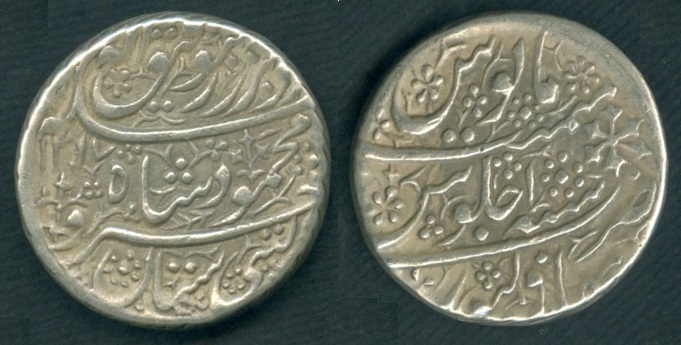 |
|
KM#244. Two Rupees.
Year: AH 1217 - RY1 (1802).
Weight: 22.69g
[23.00g].
Metal: 0.925 Silver.
Diameter: 26.50 mm. Edge:
Oblique milling (Grained right). Alignment:
Rotated. Mint:
Bahawalpur.
Mintage:
N/A.
Mintage Years:
One year type.
Ruler: Mahmud Shah ibn Taimur Shah
(1st reign: 1801-1803).
Note:
Regnal year written as
numeral, instead of "Ahad. |
|
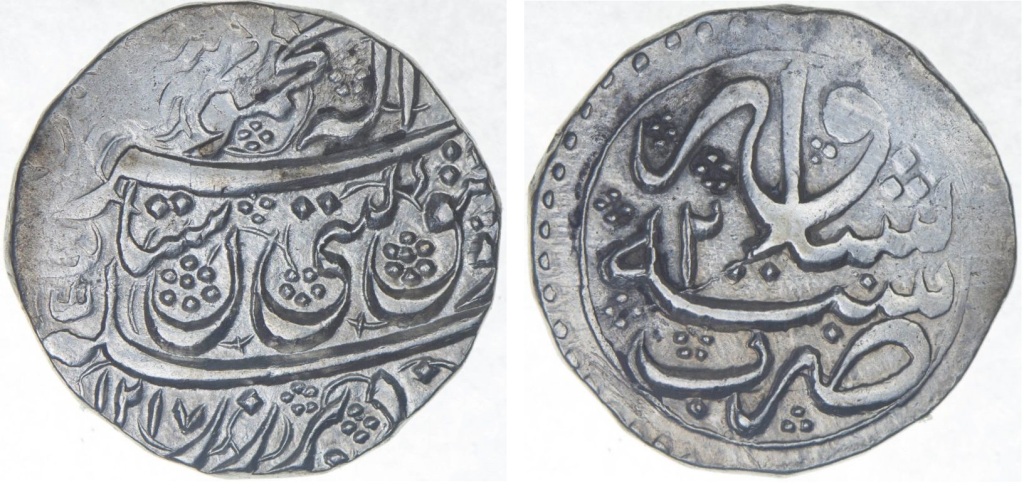 |
KM#719. Rupee.
Year: AH 1217 - RY2 (1802).
Weight: 11.42g [11.40
- 11.60g].
Metal: 0.925 Silver.
Edge:
Plain. Diameter:
23.00 mm.
Alignment:
Medal. Mint:
Peshawar. Reverse:
"Zarb Peshawar Sanah 2" (Struck
at Peshawar in the year 2).
Mintage:
N/A.
Minted Years: AH1217//2
and
AH1218//3 (1802-1803).
Ruler: Mahmud Shah ibn Taimur Shah
(1st reign: 1801-1803). |
|
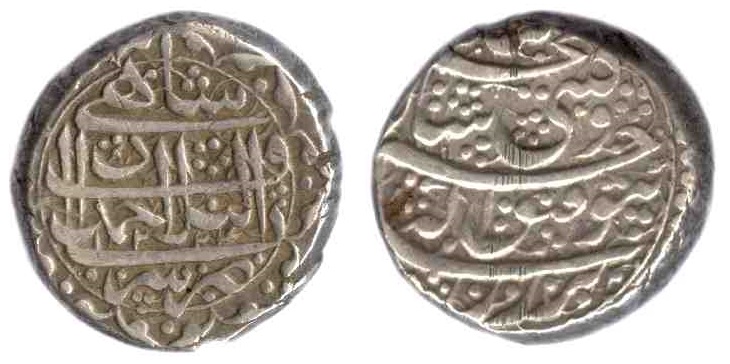 |
KM#157. Rupee.
Year: AH 1224 (1809).
Weight: 11.50g [11.40
- 11.60g].
Metal: 0.925 Silver.
Edge:
Plain. Diameter: 19.50 mm.
Alignment:
Rotated. Mint: Ahmadshahi
(also known as Ashraf al-Bilad, later from AH 1271 as Qandahar).
Obverse: Zarb Ashraf
al-Bilad Ahmadshahi / 1224.
Mintage:
N/A.
Minted Years: AH1223,
AH1224, AH1225, AH1226, AH1227, AH1228, AH1229, AH1230 and AH1232 (1808-1814
and 1816).
Ruler: Mahmud Shah ibn Taimur Shah
(2nd reign: 1809-1818).
Note:
Reverse side can be in cartouche or dotted circle. |
|
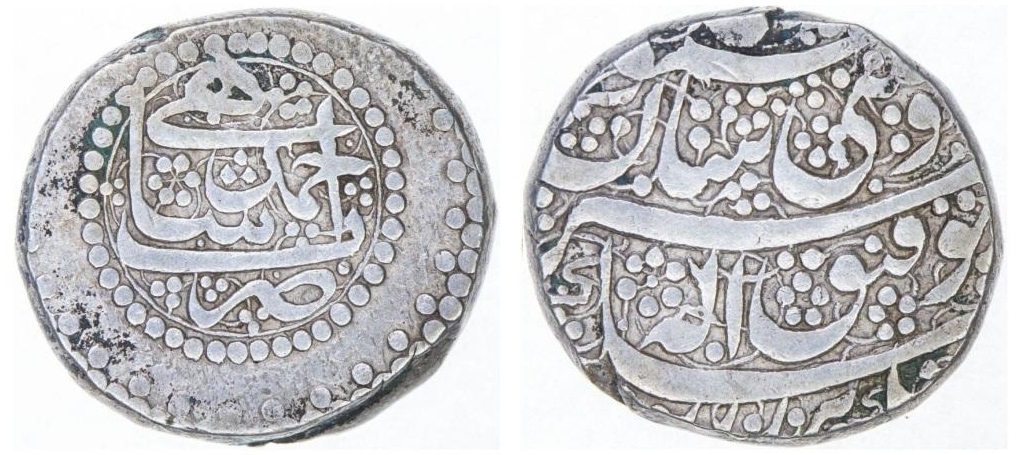 |
Type2: Same as
above coin but Reverse side legends within thin circle surrounded by dotted
circle. No Date visible on this coin. No "Ashraf
al-Bilad" written on Obverse side. Unlisted style.
Year: ND (1808-1814, 1816).
Weight: 11.33g.
Metal: 0.925 Silver.
Edge:
Plain. Diameter:
22.50 mm.
Alignment:
Coin.
Obverse: Zarb Ahmadshahi
/ ND. Mintage:
N/A. |
|
 |
Same design as as above coin, but it has proper Date
on Obverse side.
Year: AH 1228 (1812).
Weight: 11.31g [11.40
- 11.60g].
Metal: 0.925 Silver.
Edge:
Plain. Diameter:
20.50 mm.
Alignment:
Rotated (3 o' clock).
|
|
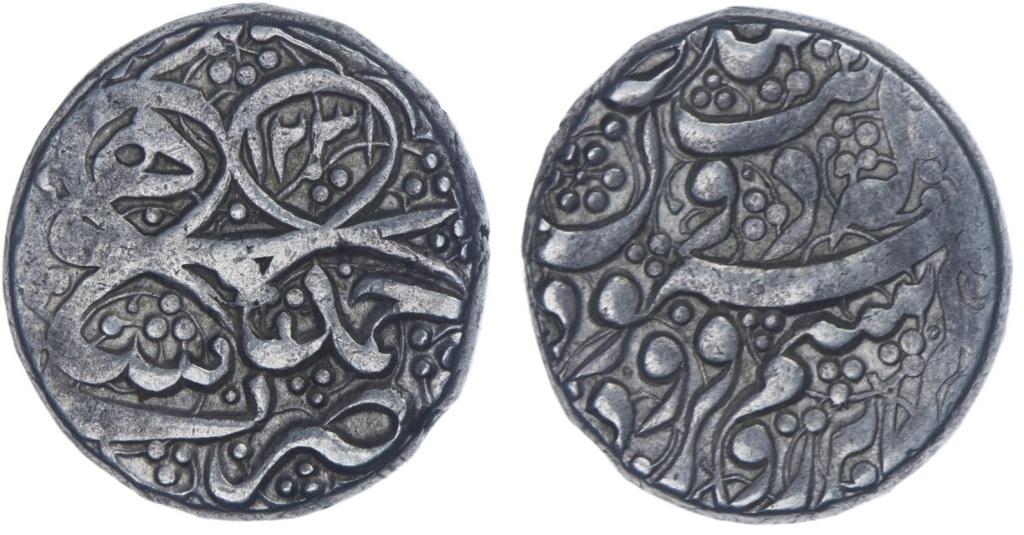 |
KM#158.1. Rupee.
Year: AH 1231 (1816).
Weight: 11.36g [10.20
- 10.40g].
Metal: 0.925 Silver.
Edge:
Plain. Diameter:
20.50 mm.
Alignment:
Medal. Mint: Ahmadshahi
(Qandahar).
Obverse: Zarb Ahmadshahi
/ 1231.
Mintage:
N/A.
Minted Years:
AH1229, AH1230, AH1231 and AH1232 (1814-1817).
Ruler: Mahmud Shah ibn Taimur Shah
(2nd reign: 1809-1818). |
|
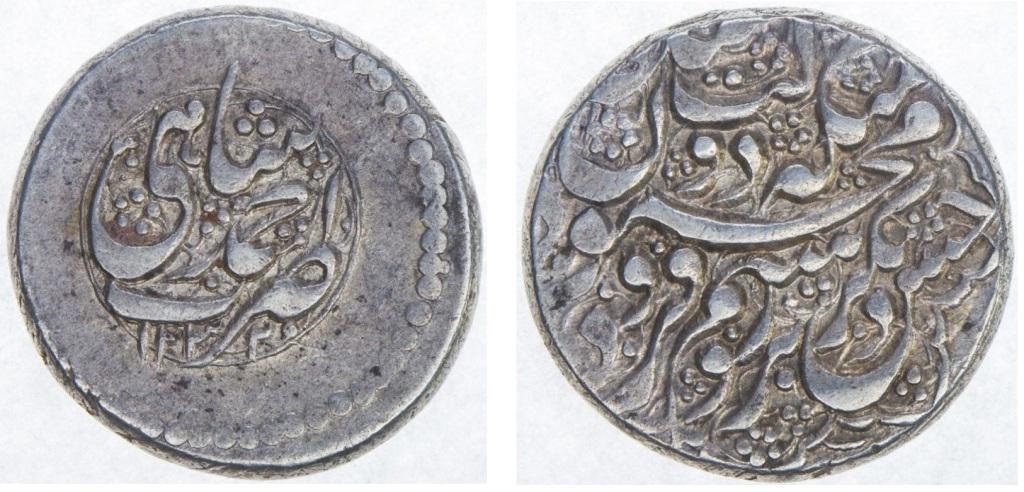 |
KM#158.2. Rupee.
Year: AH 1232 (1817).
Weight: 10.24g [10.20
- 10.40g].
Metal: 0.925 Silver.
Edge:
Plain. Diameter:
22.00 mm.
Alignment:
Rotated (5 o'clock). Mint: Ahmadshahi
(Qandahar).
Obverse: Zarb Ahmadshahi
/ 1232. Mintage:
N/A.
Minted Years:
AH1232, AH1233 and AH1234 (1817-1819).
Ruler: Mahmud Shah ibn Taimur Shah
(2nd reign: 1809-1818). |
|
 |
KM#307. Rupee.
Year: ND (1813-1814).
Weight: 11.48g [11.40
- 11.60g].
Metal: 0.925 Silver.
Edge:
Plain. Diameter:
21.00 mm.
Alignment:
Medal. Mint:
Bhakhar.
Mintage:
N/A.
Minted Years:
AH1228 and AH1229 (1813-1814).
Ruler: Mahmud Shah ibn Taimur Shah
(2nd reign: 1809-1818). |
|
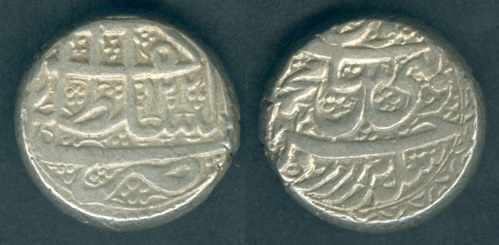 |
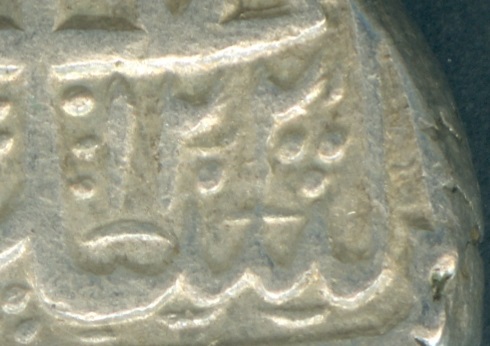 |
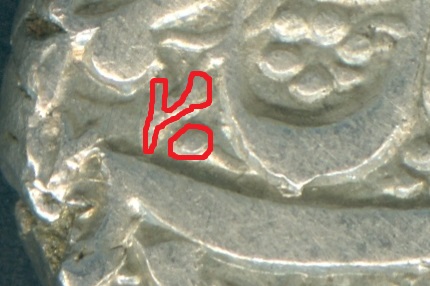 |
|
KM#398.2. Rupee.
Year: AH 1202 error for 1220 (1805).
Weight: 11.55g [11.00
- 11.60g].
Metal: 0.925 Silver.
Edge:
Plain. Diameter:
17.50 mm.
Alignment:
Medal. Mint:
Herat.
Obverse: Zarb Dar es-Sultanate
Herat / 1202.
Obverse:
Persian legend with Date: xx20. Mintage:
N/A.
Minted Years:
AH1218-1238 and AH1240-1241 (1803-1822 and 1824-1825).
Ruler: Mahmud Shah ibn Taimur Shah
(2nd reign: 1809-1818). Unlisted date AH 1202 / AH 1220
combination in Krause publications. |
|
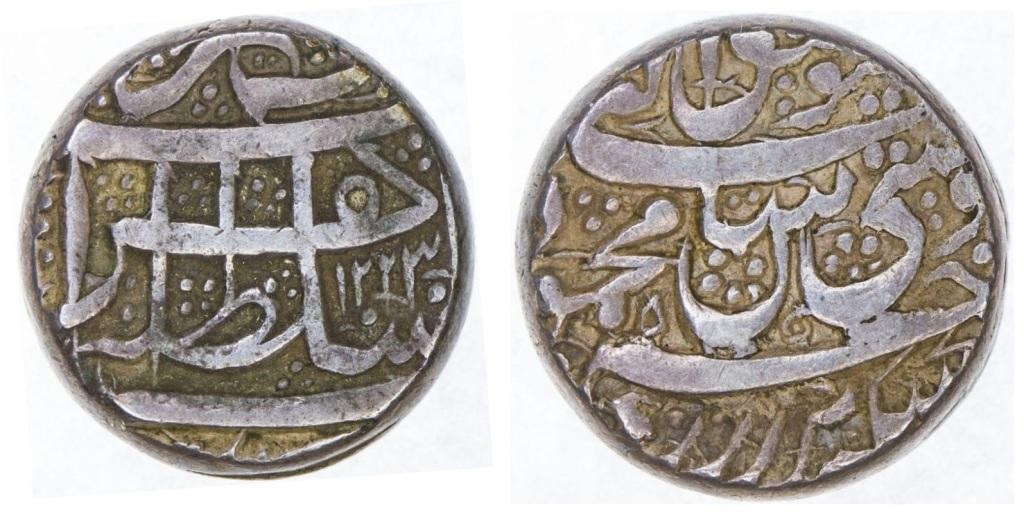 |
Same as above coin, but...
Year: AH 1223 (1808).
Weight: 11.39g.
Diameter:
18.00 mm.
Alignment:
Rotated (3 o'clock).
Mintage:
N/A.
Note:
Digit "5" seen under Gitistan and also
under Mahmud on Obverse side. |
|
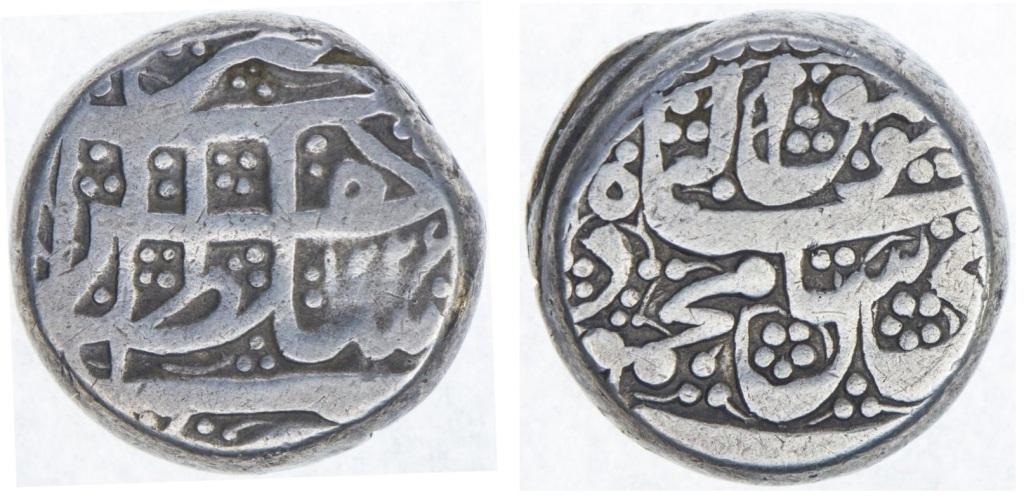 |
Same as above coin, but...
Year: AH 1226 (1811).
Weight: 11.17g.
Diameter:
16.50 mm.
Alignment:
Rotated (4 o'clock).
Mintage:
N/A. |
|
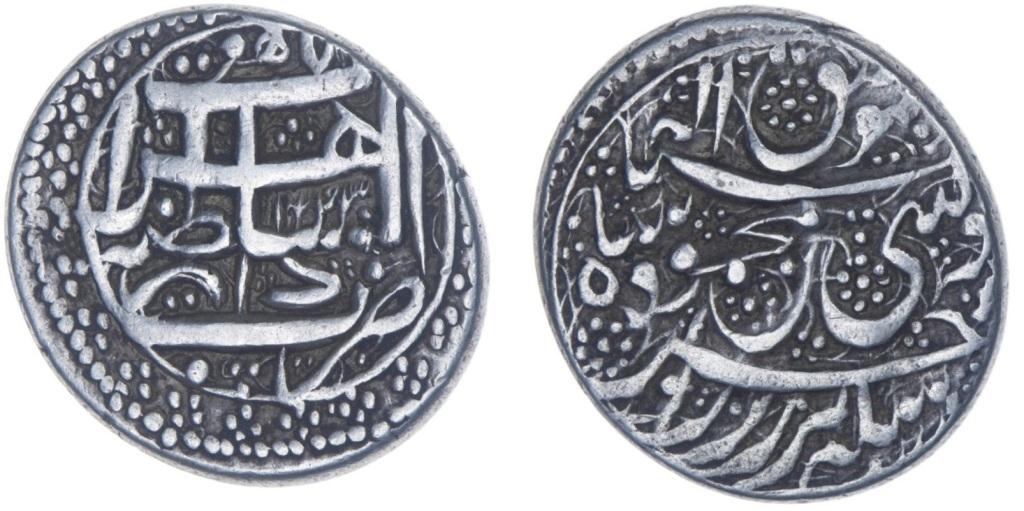 |
KM#398.3. Rupee.
Year: AH 1243 (1827).
Weight: 10.17g [11.00
- 11.60g].
Metal: 0.925 Silver.
Edge:
Plain. Diameter:
23.00 mm.
Alignment:
Rotated. Mint:
Herat.
Obverse: Zarb Dar es-Sultanate
Herat / 1243.
Mintage:
N/A.
Minted Years:
AH1242, AH1243, AH1244 and AH1254 error for 1245 (1826-1829).
Ruler: Mahmud Shah ibn Taimur
Shah (3rd reign at Herat: 1818-1826). Posthumous issues. |
|
 |
KM#462.2. Rupee.
Year: AH 1228 - RY5 (1813).
Weight: 11.35g [10.75
- 11.60g].
Metal: 0.925 Silver.
Edge:
Plain. Diameter:
20.00 mm.
Alignment:
Rotated (1 o'clock). Mint:
Kabul. Obverse:
Legend with Date " 1228". Reverse:
"Dar es-Sultanate
- Kabul" and regin year "5" written within the center circle,
surrounded by dots in circular form.
Mintage:
N/A.
Minted Years:
One year type.
Ruler: Mahmud Shah ibn Taimur Shah
(2nd reign: 1809-1818). Rare one-year type as usually
found with countermarks. |
|
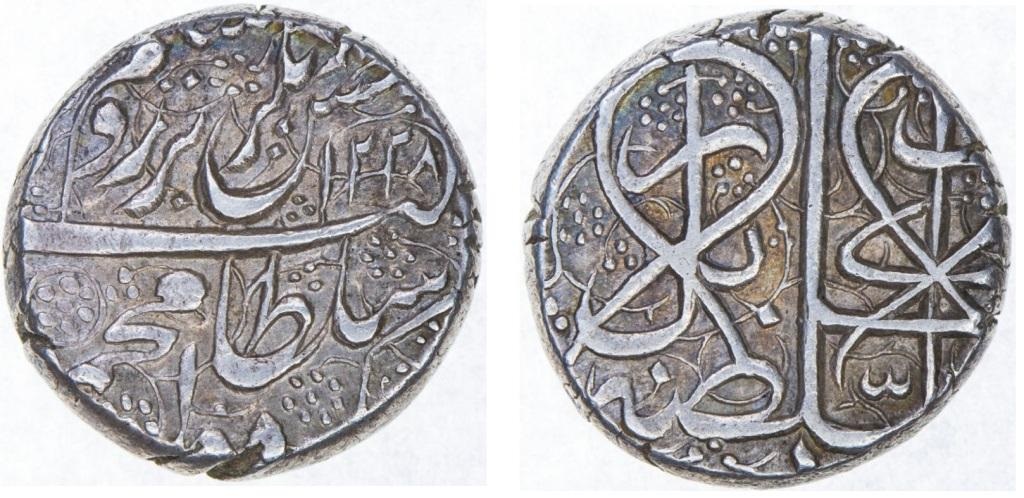 |
KM#463. Rupee.
Year: AH 1228 (1813).
Weight: 10.66g [10.75
- 11.60g].
Metal: 0.925 Silver.
Edge:
Plain. Diameter:
20.00 mm.
Alignment:
Rotated (3 o'clock). Mint:
Kabul. Reverse:
Dar es-Sultanate
- Kabul.
Mintage:
N/A.
Minted Years:
AH(122)6, AH1228, AH1230, AH1231//8, AH1232 and AH1233//10 [1811,
1813, 1815-1818].
Ruler: Mahmud Shah ibn Taimur Shah
(2nd reign: 1809-1818). |
|
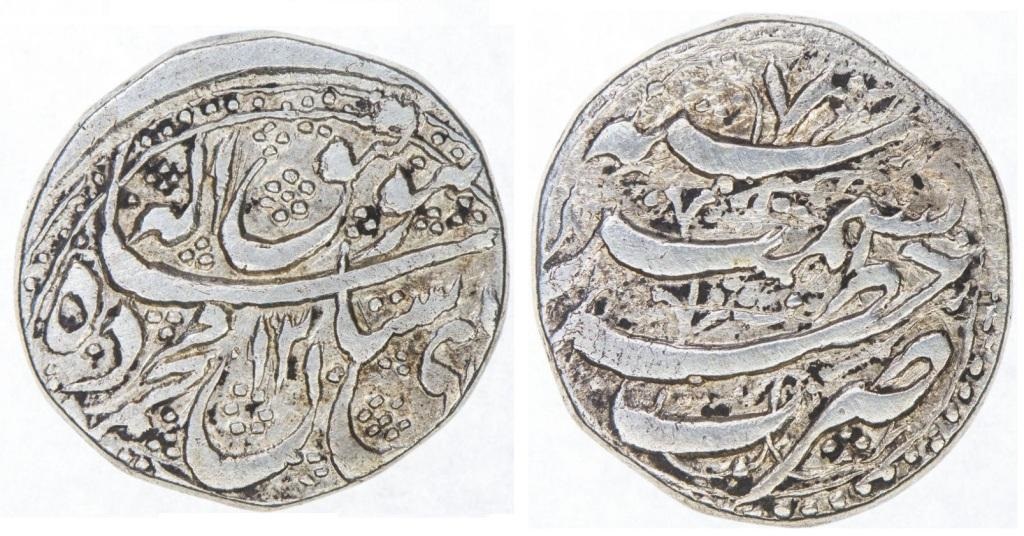 |
KM#591. Rupee.
Year: AH 12xx - RY7 (1814).
Weight: 10.71g [10.80
- 11.00g].
Metal: 0.925 Silver.
Edge:
Plain. Diameter:
22.00 mm.
Alignment:
Rotated (4 o'clock). Mint:
Kashmir. Reverse:
"Zarb Khitta Kashmir Sannah 7" (Struck at the
district of Kashmir in reign year 7).
Mintage:
N/A.
Minted Years:
AH(122)6, AH1228, AH1230, AH1231//8, AH1232 and AH1233//10 [1811,
1813, 1815-1818].
Ruler: Mahmud Shah ibn Taimur Shah
(2nd reign: 1809-1818).
Note:
The sequence of reign years at Kashmir
is very
confusing. |
|
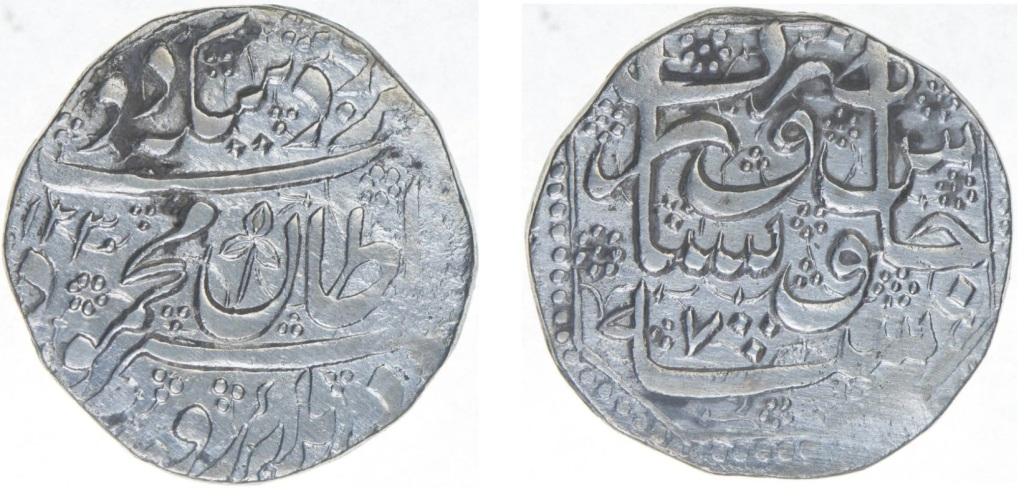 |
|
KM#727.2. Rupee.
Year: AH 1230 - RY7 (1815).
Weight: 10.47g [10.60
- 11.50g].
Metal: 0.925 Silver.
Edge:
Plain. Diameter:
24.50 mm.
Alignment:
Rotated. Mint:
Peshawar.
Reverse: "Zarb
Peshawar Sanah 7 julus maimanat manus"
(Struck at Peshawar in the year 7
of the accession associated with tranquil prosperity).
Mintage:
N/A.
Minted Years:
AH1224//1, AH1227//3, AH1227//4, AH1228//4, AH1228//5, AH1229//5,
AH1229//6, AH1230//6, AH1230//7, AH1231//7 and AH1231//8
(1809-1816).
Ruler: Mahmud Shah ibn Taimur Shah
(2nd reign: 1809-1818). |
|
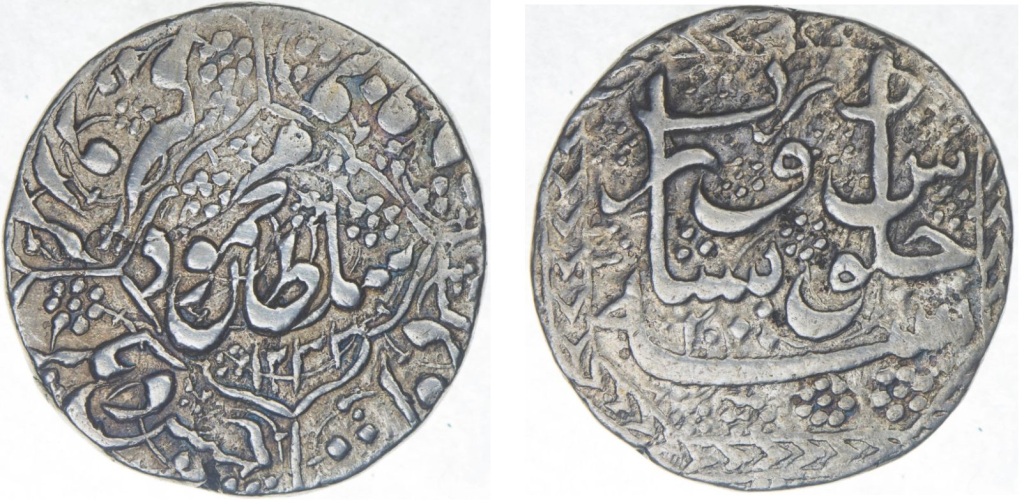 |
KM#728. Rupee.
Year: AH 1233 - RY10 (1818).
Weight: 10.44g [10.60
- 11.50g].
Metal: 0.925 Silver.
Edge:
Plain. Diameter:
22.50 mm.
Alignment:
Rotated. Mint:
Peshawar.
Obverse: "Sultan Muhmud"
with Date in the
quatrefoil
center. Reverse: "Zarb
Peshawar Sanah 10 julus maimanat manus"
(Struck at Peshawar in the year 10
of the accession associated with tranquil prosperity).
Mintage:
N/A.
Minted Years:
AH1231//8, AH1232//8, AH1232//9, AH1233//6 error for reign year 9,
AH1233//9 and AH1233//10 (1816-1818).
Ruler: Mahmud Shah ibn Taimur Shah
(2nd reign: 1809-1818). |
|
Note: This coin was produced
under Sikh rule (Sikh occupation of Peshawar). Sikh effective rule in
Peshawar commenced in AH1231 (1816), but all coinage cites only the
Durrani ruler, Mahmud Shah until about AH1234 (1819) and then Ayyub
Shah until AH1245 (1829). |
|
Habibollah Shah
at Kabul: 1823 |
|
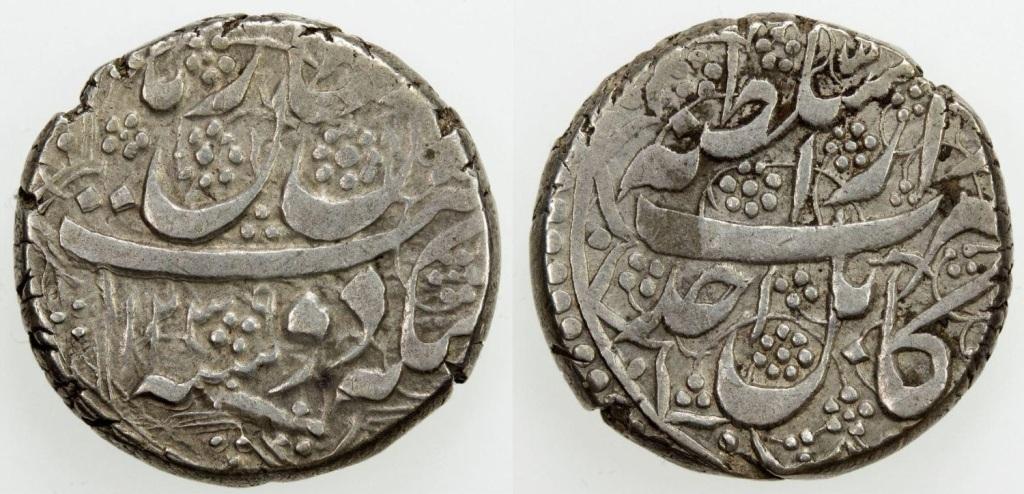 |
SA#3137A Rupee.
Year: AH 1239 (1823).
Weight: 11.51g.
Metal: 0.925 Silver.
Diameter: 21.00 mm. Edge:
Plain. Alignment:
Medal. Mint: Kabul.
Obverse: Persian
legend with Date "1239".
Reverse: "Zarb Dar-es-Sultanate
Kabul Sannah Ahad" (Struck at Dar-es-Sultanate
Kabul in reign year First). Ruler:
Habibollah Shah (at Kabul in 1823).
Mintage:
N/A.
Minted Years:
One year type. |
|
Note: This
coin is not listed in Krause publications. It was however on display
in Ashmolean Museum at Oxford, England as anonymous / unpublished
specimen of Kabul. Later this anonymous coin was accepted by coin
experts to be produced by Habibollah Shah Mohammadzai, who ruled
Kabul briefly in AH 1239 (1823). |
|
Dost Muhammad Barakzai: 1824-1839 |
|
 |
KM#477. Rupee.
Year: AH 1241 - RY2 (1825).
Weight: 9.81g.
Metal: 0.925 Silver.
Edge:
Plain. Diameter:
23.00 mm.
Alignment:
Rotated (7 o' clock). Mint:
Kabul.
Obverse:
"Sahib al-Zaman" written at the top. Date AH 1241 written
at the right side. Reverse: Zarb Dar es-Sultanate
Kabul / RY 2.
Mintage:
N/A.
Minted Years:
AH1240//1, AH1240//2 and AH1241//2 (1824-1825).
Ruler:
Dost Muhammad Khan ibn Payinda (Sarafraz) Khan Muhammadzai ibn
Jamal Khan [1st reign] (1824-1839). |
|
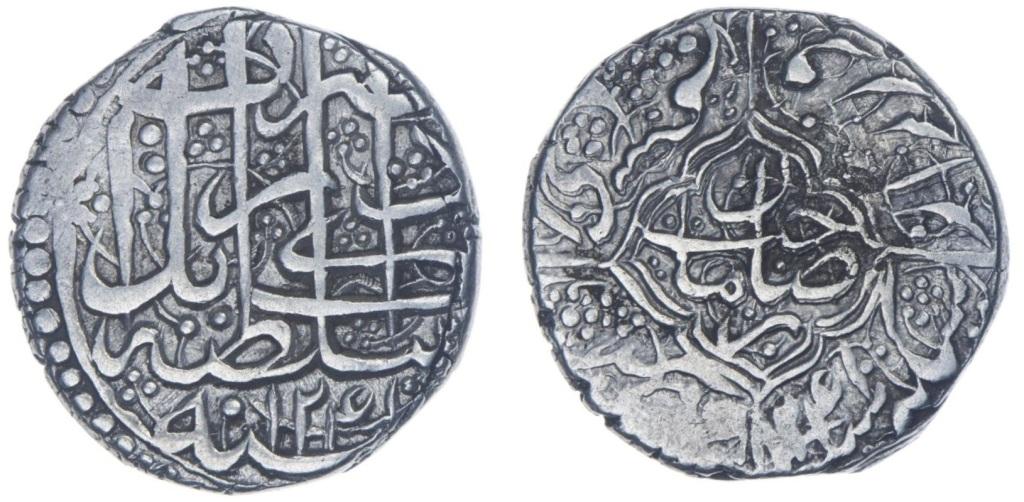 |
KM#478. Rupee.
Year: AH 1241 (1825).
Weight: 9.71g.
Metal: 0.925 Silver.
Edge:
Plain. Diameter:
22.50 mm.
Alignment:
Rotated. Mint:
Kabul.
Obverse: Zarb Dar es-Sultanate
Kabul / 1241. Reverse:
"Sahib al-Zaman" written in center cartouche. Date AH 1241 written
at the bottom right side.
Mintage:
N/A.
Minted Years:
AH1241, AH1242, AH1243 and AH1244 (1825-1828).
Ruler:
Dost Muhammad Khan ibn Payinda (Sarafraz) Khan Muhammadzai ibn
Jamal Khan [1st reign] (1824-1839). |
|
 |
Same as
above coin KM#478 Rupee, but...
Year: AH 1244 (1828).
Weight: 9.35g.
Diameter:
22.50 mm.
Alignment:
Rotated (3 o' clock).
The legends on both sides are large and thick.
The word in the outer center cartouche of the above coin at 12 o'clock,
while on
this coin it is at 3 o' clock. |
|
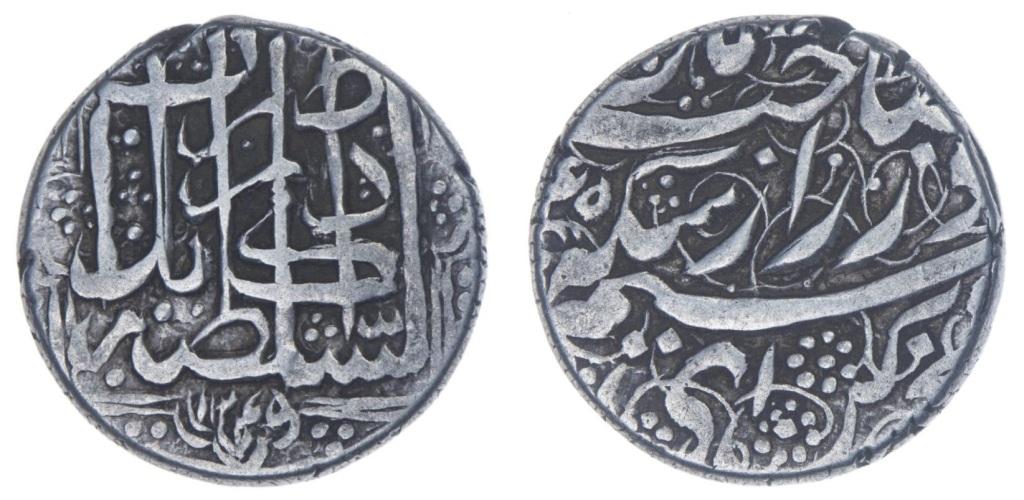 |
KM#479. Rupee.
Year: AH 1245 (1829).
Weight: 9.62g.
Metal: 0.925 Silver.
Edge:
Plain. Diameter:
22.50 mm.
Alignment:
Medal. Mint:
Kabul.
Obverse: Zarb Dar es-Sultanate
Kabul / 1245. Reverse:
"Sahib al-Zaman" written at the top. Date "1245" written
at the right side.
Mintage:
N/A.
Minted Years:
AH1244 and AH1245 (1828-1829).
Ruler:
Dost Muhammad Khan ibn Payinda (Sarafraz) Khan Muhammadzai ibn
Jamal Khan [1st reign] (1824-1839). |
|
 |
KM#480.1. Rupee.
Year: AH 1246 (1830).
Weight: 9.44g.
Metal: 0.925 Silver.
Edge:
Plain. Diameter:
24.00 mm.
Alignment:
Rotated (9 o' clock). Mint:
Kabul.
Obverse: Zarb Dar es-Sultanate
Kabul / 1246.
This coin has Date on
both sides. |
|
Reverse:
Couplet citing his long- deceased father
Payinda Khan: "sim o tala beh shams o qamar midehad navid
vaqt-e ravaj-e sekke-ye payendeh khan rasid"
(silver and gold have brought news to the sun and moon that the time
of currency of the stamp of Payinda Khan has arrived). Mintage:
N/A.
Minted Years:
AH1245, AH1246, AH1247, AH1248, AH1249 and AH1250 (1829-1834).
Ruler:
Dost Muhammad Khan ibn Payinda (Sarafraz) Khan Muhammadzai ibn
Jamal Khan [1st reign] (1824-1839).
Note:
Various borders on Obverse side (Zarb Dar es-Sultanate Kabul side) and various arrangements of
couplet on Reverse side exists. |
|
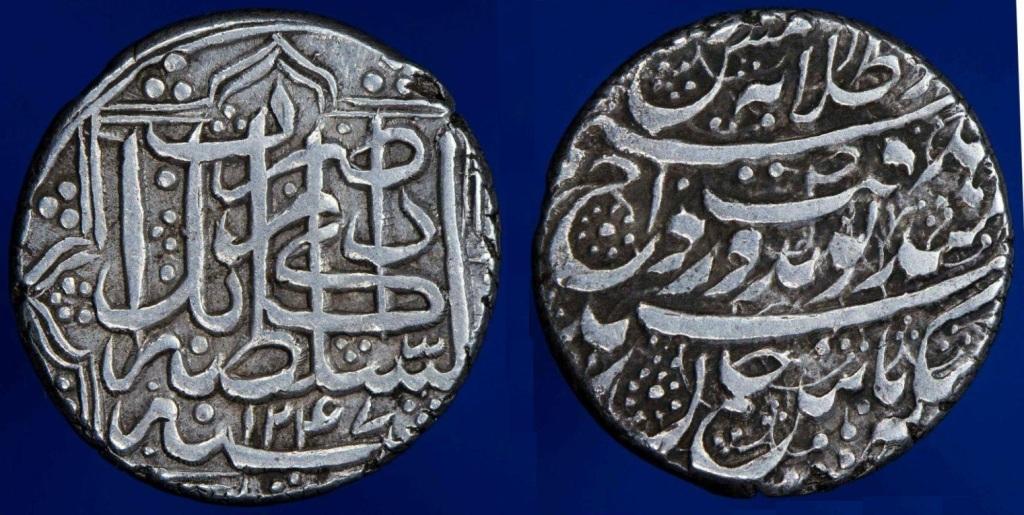 |
Same as above coin
KM#480.1 Rupee, but...
Year: AH 1247 (1831).
Weight: 9.36g.
Diameter:
22.00 mm.
Alignment:
Rotated (4 o' clock).
Different border design on the Obverse
side than the above coin. |
|
 |
Same as above coin
KM#480.1 Rupee, but...
Year: AH 1249 (1833).
Weight: 9.43g.
Diameter:
22.50 mm.
Alignment:
Medal.
Different border design on the Obverse
side than the above coin. |
|
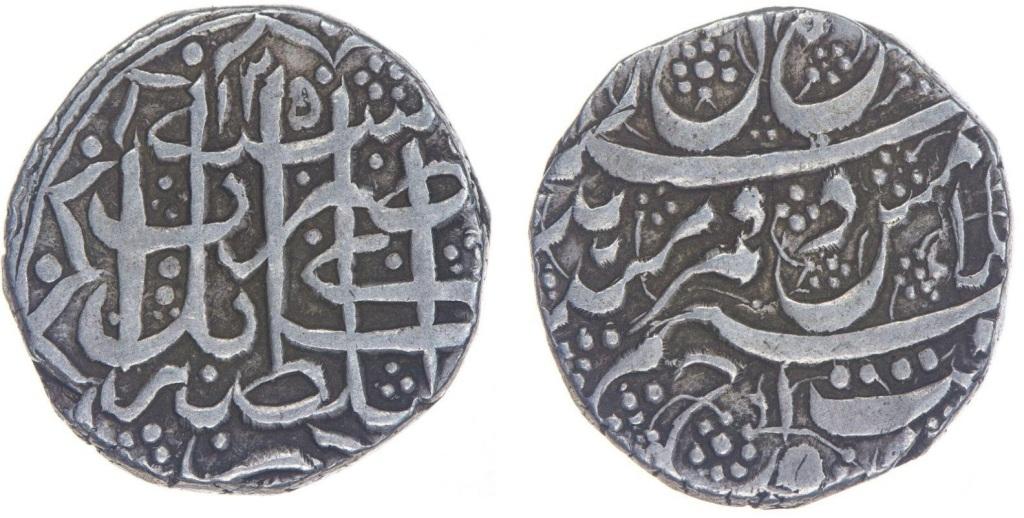 |
Same as above coin
KM#480.1 Rupee, but...
Year: AH 1250 (1834).
Weight: 9.35g.
Diameter:
22.50 mm.
Alignment:
Rotated (11 o' clock).
Same border design as of above coin
dated AH 1248 on the Obverse side.
Curiously, the
Date on Obverse side is at the top instead of bottom. |
|
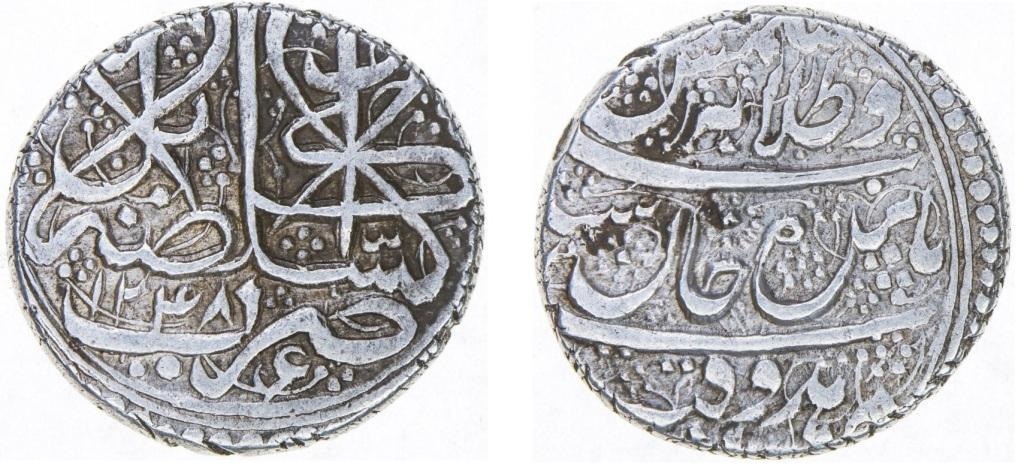 |
KM#480.2. Rupee.
Year: AH 1248 (1832).
Weight: 9.44g.
Metal: 0.925 Silver.
Edge:
Plain. Diameter:
23.50 mm.
Alignment:
Rotated (1 o'clock). Mint:
Kabul.
Obverse: Zarb Dar es-Sultanate
Kabul / 1248. Mintage:
N/A.
Minted Years:
AH1247 and AH1248 (1831-1832).
Ruler:
Dost Muhammad Khan ibn Payinda (Sarafraz) Khan Muhammadzai ibn
Jamal Khan [1st reign] (1824-1839). |
|
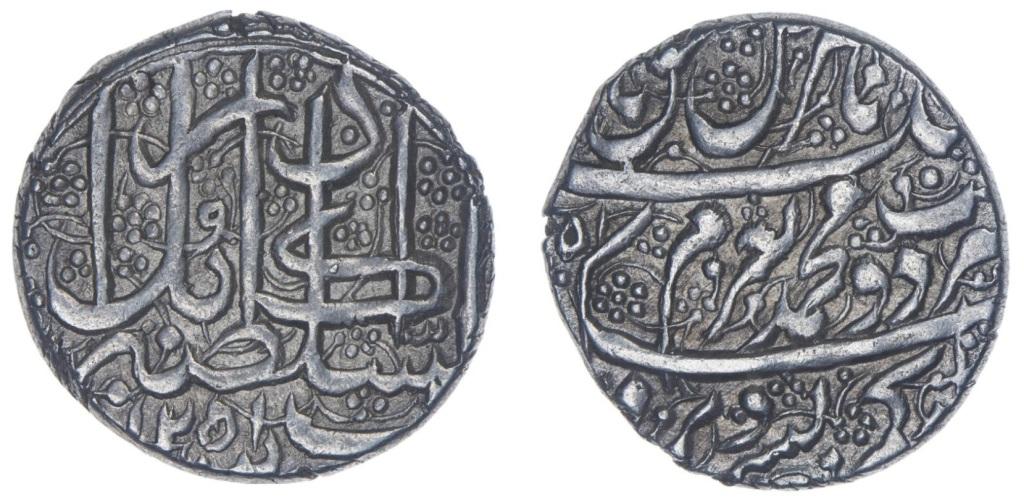 |
KM#481. Rupee.
Year: AH 1251 (1835).
Weight: 9.46g.
Metal: 0.925 Silver.
Edge:
Plain. Diameter:
23.50 mm.
Alignment:
Rotated. Mint:
Kabul.
Obverse: Zarb Dar es-Sultanate
Kabul / 1251. Reverse:
"Dost Muhammad" written in the middle line at the left side.
Date "1251" written at the right side.
Mintage:
N/A.
Minted Years:
AH1250, AH1251, AH1252, AH1253, AH1254 and AH1255 (1834-1839).
Ruler:
Dost Muhammad Khan ibn Payinda (Sarafraz) Khan Muhammadzai ibn
Jamal Khan [1st reign] (1824-1839). |
|
Kamran Shah Barakzai: 1826-1842 |
|
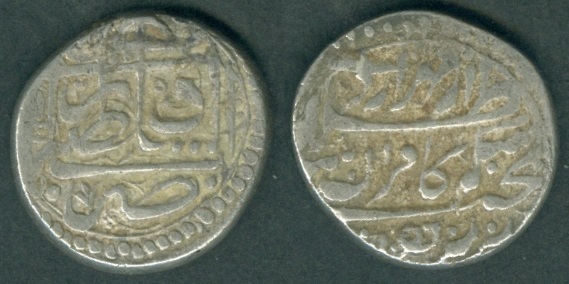 |
KM#403.
Rupee. Year:
AH 1254 (1838).
Weight: 10.26g.
Metal: 0.925 Silver.
Diameter: 21.50 mm. Edge:
Plain. Alignment:
Medal. Mint: Herat.
Obverse:
Zarb Dar as-Sultanat - Herat.
Mintage:
N/A.
Minted Years:
AH1244, AH1245, AH1246, AH1248, AH1249, AH1251,
AH1252, AH1254 and AH1255 (1829-1839).
Ruler: Kamran Shah ibn Mahmud Shah
(1826-1842). |
|
Sultan Muhammad Tilai Barakzai: 1831-1834 |
|
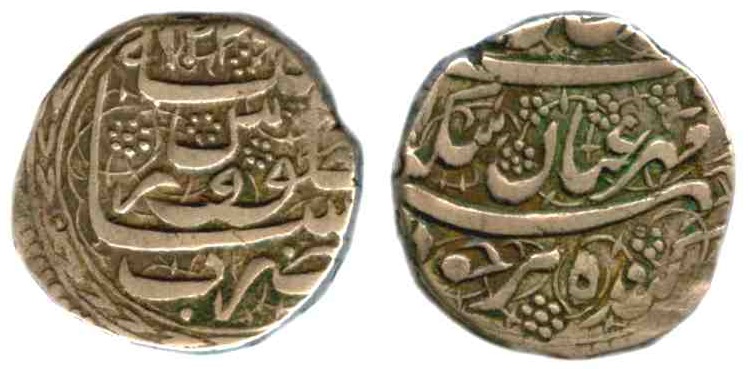 |
KM#739.
Rupee. Year:
AH 1247 (1831).
Weight: 9.31g.
Metal: .925 Silver.
Diameter: 23.50 mm. Edge:
Plain. Alignment:
Rotated.
Mint: Peshawar.
Mintage:
N/A.
Minted Years:
AH1247, AH1248 and AH1249 (1831-1833).
Ruler: Sultan
Muhammad Tilai Barakzai (1831-1834).
Also note that a very similar design as
anonymous coinage, KM#738 exists. Minted Years: AH 1246-1249, having
date on both sides. |
|
| |
- DURRANI
- Shoja al-Mulk Muhammad Shah
(2nd time)............13 Jul 1803 - 1809
- Son of Taimur and minted coins at Bahawalpur, Bhakhar (Bhakkar),
Dera Ghazi Khan, Dera Ismail Khan, Herat, Qandahar, Kabul, Kashmir and
Multan. In Peshawar he minted coins as a local ruler.
- Kamran Shah (Qandahar)...................................1804 - 1805
- Ata Muhammad Bamizai
Khan (Rebel
Governor of Kashmir)....1808
- 1813
- Used the name of Shah Nur
al-Din; the patron Saint of Kashmir, on his coinage.
-
Ayyub Shah ibn Taimur Shah (Peshawar
& Qandahar).........1817 -
1829
- He is also known as a
puppet of Dost Muhammad from 1817 to 1823 and ruled Kashmir from
1818 to 1829. Peshawar from 1818 briefly then again from 1818 to 1829. Kabul from 1817 to 1826.
A regent, Purdil Khan was also governing under
his rule at Qandahar from 1826 to 1829. Sikhs captured Dera Ghazi Khan in
AH 1235 (1819), Dera Ismail Khan in AH1236 (1820-1821) and Multan in AH1233
(1818) and later these areas were permanently incorporated into Punjab. Period of disorder started from
about 1817 to around 1880, Afghanistan was usually divided mainly in four
regions Herat, Kabul, Peshawar and Qandahar with extremely complex authority
among themselves. During this period most of these regions were somehow
united under Dost Mohammed's second reign (1842-1863). British Occupation of
Peshawar incorporated into Punjab in 1823, officially in May 1834.
- Muhammad Azim Khan (Kashmir
Governor)...............1813 -
1819
- He was a
governor at Kashmir during AH1228-1234 (1813-1819) under Ayyub Shah. KM#609 Copper Falus of 7.50
grams, minted at Kashmir is known to be issued in AH1228//Ahad (1813) by
this governor.
Shoja al-Mulk Muhammad Shah (3rd time
at Peshawar)..............1818
Sultan Ali Shah (only
at Kabul)..........................1818 - 1819
|
|
Shuja al-Mulk
Muhammad Shah Durrani: 1803-1809 |
|
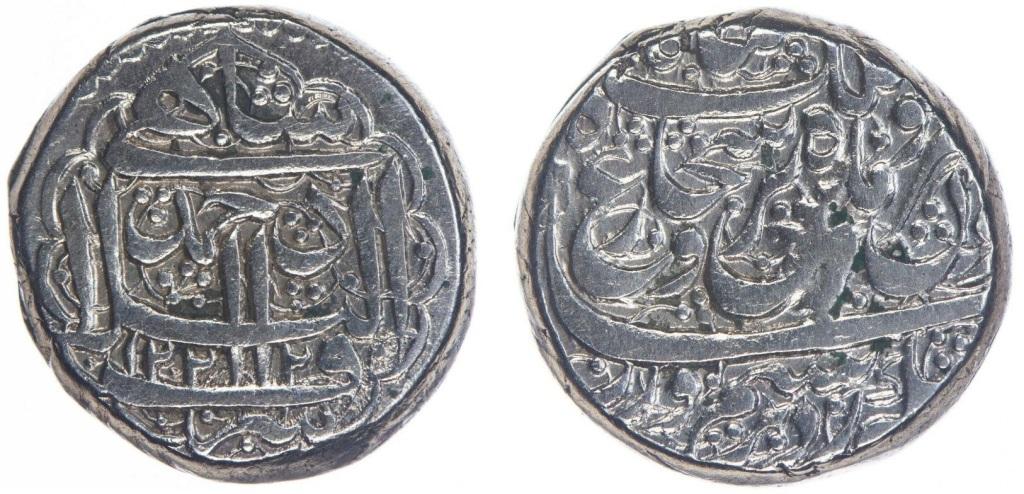 |
KM#153. Rupee.
Year: AH 1222 (1807).
Weight: 11.42g.
Metal: 0.925 Silver.
Diameter: 18.00 mm.
Edge:
Plain. Alignment:
Rotated (3 o' clock). Mint:
Ahmadshahi (Qandahar). |
|
Obverse: Zarb Ashraf
al-Bilad Ahmadshahi / 1222.
Mintage:
N/A.
Minted Years:
AH1218//3, AH1219//1, AH1220//2, AH1221//3, AH1222, AH1223 and
AH1224 (1803-1809).
Ruler: Shuja al-Mulk Muhammad Shah ibn
Taimur Shah (1803-1809).
|
|
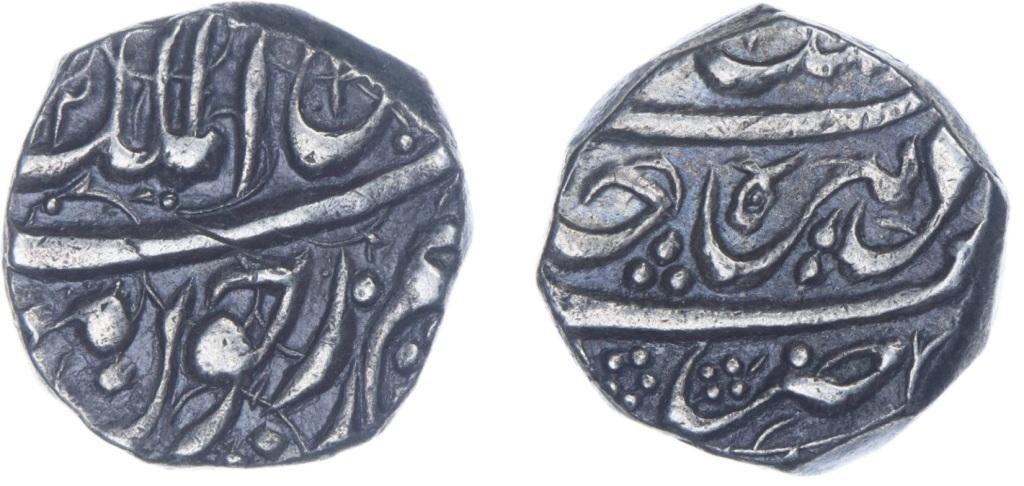 |
KM#368. Rupee.
Year: ND [AH x22x] (1805-1808)].
Weight: 10.98g.
Metal: 0.925 Silver.
Diameter: 18.50 mm.
Edge:
Plain. Alignment:
Medal. Mint:
Derajat (Dera Ismail Khan).
This coin is cut from the edges all
around. |
|
Obverse
Shorter couplet:
"Sikka zad bar Seem wa Zar chun
Mihr wa Mah / Shah-i deen Parwar Shuja'a ul-Mulk Shah".
Reverse: "zarb
Derajat sanah x julus maimanat manus" (Struck
at
Derajat in the year x associated with tranquil prosperity).
Mintage:
N/A.
Mintage Years:
AH1218//1, AH1219//2, AH1218//2, AH1220//2,
AH1220//3, AH1221//3, AH1221//4, AH1221//5, AH122x//6 and AH1223 (1803-1808).
Ruler: Shuja al-Mulk Muhammad Shah ibn
Taimur Shah (1803-1809). |
|
 |
KM#598. Rupee.
Year: AH 12xx - RY2 (1804).
Weight: 10.98g.
Metal: 0.925 Silver.
Diameter: 23.00 mm.
Edge:
Plain. Alignment:
Rotated (10 o'clock).
Mint: Kashmir. |
|
Reverse:
"Zarb Khitta Kashmir Sannah 2" (Struck at the
district of Kashmir in reign year 2).
Mintage:
N/A.
Minted Years:
AH1218//1, AH1219//2, AH1220//3, AH1221//4, AH1222//5 and AH1223//6 (1803-1808).
Ruler: Shuja al-Mulk Muhammad Shah ibn
Taimur Shah (1803-1809). |
|
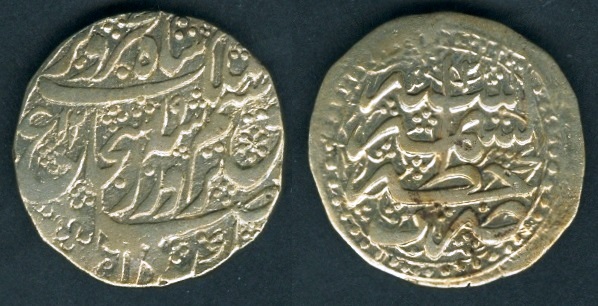 |
Same as above coin KM#598,
Rupee, but...
Year: AH 1219 - RY2 (1804).
Weight: 10.96g.
Diameter: 23.00 mm. Alignment:
Coin.
Mintage:
N/A.
Date in the center on Obverse side. |
|
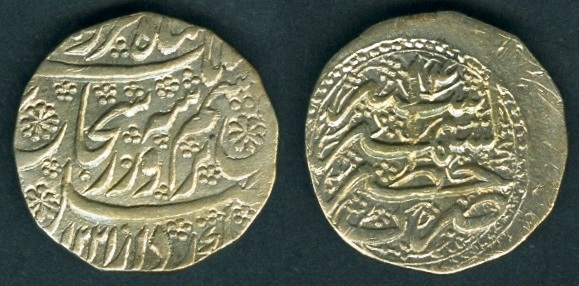 |
Same as above coin KM#598,
Rupee, but...
Year: AH 1221 - RY4 (1806).
Weight: 10.98g.
Diameter: 22.25 mm. Alignment:
Coin.
Mintage:
N/A.
Date at the bottom left on Obverse
side. |
|
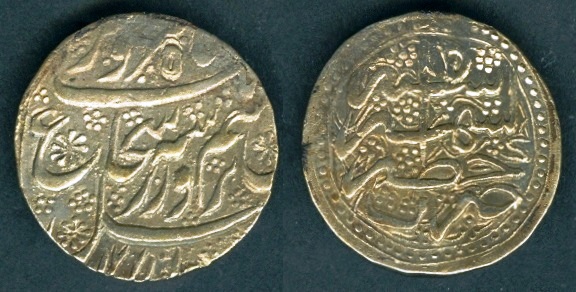 |
Same as above coin KM#598,
Rupee, but...
Year: AH 1221 - RY5 (1806).
Weight: 10.06g.
Diameter: 22.25 mm. Alignment:
Rotated (1 o'clock).
Mintage:
N/A.
Date at the bottom left on Obverse
side. Unlisted Date / reign year combination in Krause publications. |
|
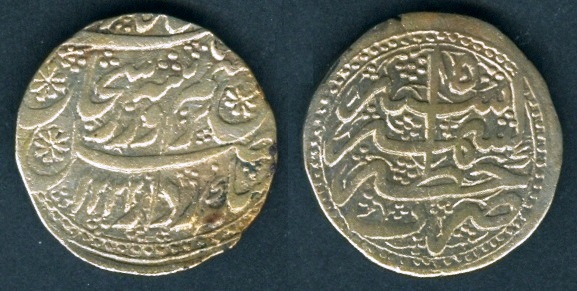 |
Same as above coin KM#598,
Rupee, but...
Year: AH 1222 - RY5 (1807).
Weight: 10.97g.
Diameter: 22.25 mm. Alignment:
Rotated (9 o'clock).
Mintage:
N/A.
Date at the bottom left on Obverse
side. |
|
 |
KM#722. Rupee.
Year: ND [AH 1218-1224 (1803-1808)].
Weight: 11.00g.
Metal: 0.925 Silver.
Edge:
Plain. Mint: Peshawar.
Shuja al-Mulk minted this
coin as a local rule at Peshawar. |
|
Obverse couplet:
"سکه زد برسیم وزر روشنتراز خورشید وماه نور چشم دّردّران شه
شجاع الملك شاه" (The light of the eyes, the
preal of the Durrani tribe, the King Shuja ul-Mulk put his stamp on
gold and silver more brightly than sun and the moon).
Reverse: "zarb
Peshawar julus maimanat manus" (Struck
at
Peshawar associated with tranquil prosperity).
Mintage:
N/A.
Mintage Years:
AH1218//1, AH1219//2, AH1219//3, AH1220//3,
AH1221//4, AH1222//5, AH1223//6 and AH1224//7 (1803-1808).
Ruler: Shuja al-Mulk Muhammad Shah ibn
Taimur Shah (1803-1809). |
|
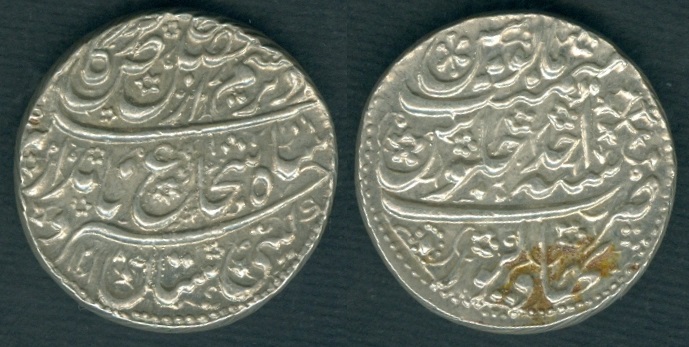 |
|
KM#254. Two Rupees.
Year: AH 1218 - RY Ahad (1) [1803].
Weight: 22.71g
[23.00g].
Metal: 0.925 Silver.
Diameter: 27.00 mm. Edge:
Oblique milling (Grained right). Alignment:
Medal. Mint:
Bahawalpur.
Obverse: "sikka
zad bar sim az fazal khas kardegar khusru giti sitan shah shuja'
namdar".
Reverse: "zarb Bahawalpur sanah
Ahad julus maimanat manus" (Struck
at
Bahawalpur
in the year First associated with tranquil prosperity).
Mintage:
N/A.
Mintage Years:
AH1218//1 and AH1219 (1803-1804).
Ruler: Shuja al-Mulk Muhammad Shah ibn
Taimur Shah (1803-1809). |
|
Ayyub Shah Durrani: 1817-1829 |
|
 |
KM#162. Rupee. Year:
AH 1235 (1820).
Weight: 10.21g.
Metal:
0.925 Silver.
Diameter: 21.50 mm. Edge:
Plain. Alignment:
Rotated. Mint: Ahmadshahi (Qandahar).
Obverse: "Zarb Ahmadshahi
/ AH 1235" written in proper round circle. Sunni Kalima is circled
around the mint name. Mintage:
N/A.
Minted Years: AH1234
and AH1235 (1819-1820).
Ruler:
Ayyub Shah ibn Taimur Shah (1817-1829).
Scarce type. |
|
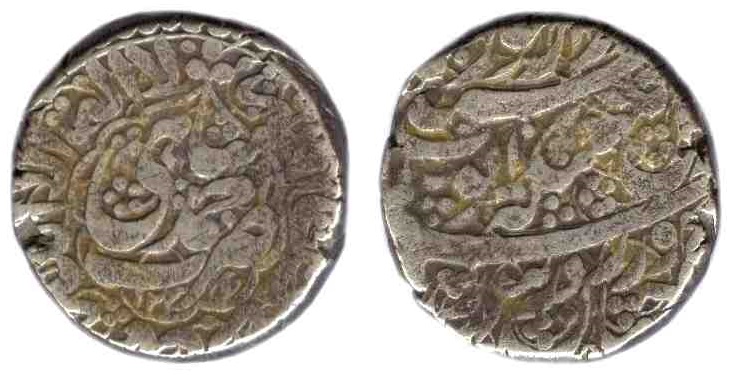 |
Same as above coin KM#162
Rupee, but...
Year:
AH 1234 (1819).
Weight: 9.71g.
Diameter: 21.00 mm.
Alignment:
Coin. Mintage:
N/A.
Unpublished style as
mint Ahmadshahi is written within cartouche. KM#162 Obverse indicates mint: Ahmadshahi in center with proper round circle for AH 1234-1235. Sunni
Kalimah is circled around the mint name in both dates. |
|
 |
KM#468. Rupee. Year:
AH 1236 - RY2 (1821).
Weight: 10.66g.
Metal:
0.925 Silver.
Diameter: 21.50 mm. Edge:
Plain. Alignment:
Medal. Mint:
Kabul.
Obverse: "Zarb Dar-es-Sultanate
Kabul / AH 1234 / RY2". Mintage:
N/A.
Minted Years:
AH1234, AH1234//1, AH1235//1-2, AH1235//2,
AH1236//2, AH1237//2, AH1237//3, AH1238//1237/2, AH1238//3 and
AH1239//4 (1819-1823).
Ruler:
Ayyub Shah ibn Taimur Shah (1817-1829). |
|
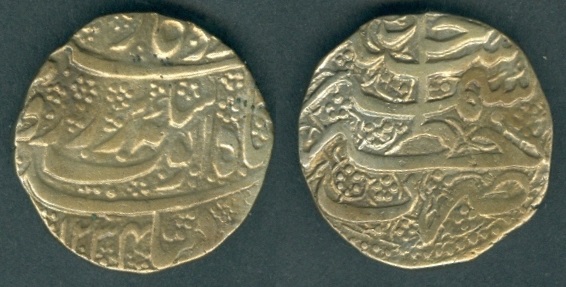 |
KM#613. Rupee. Year:
AH 1234 - RY2 (1819).
Weight: 10.81g.
Metal:
0.925 Silver.
Diameter: 21.00 mm. Edge:
Plain. Alignment:
Medal. Mint:
Kashmir.
Reverse: "Zarb
Khitta
Kashmir Sanah Ahad"
(Struck at the
district of Kashmir
in year First).
Mintage: N/A.
Minted Years:
AH1233//1 and AH1234//1.
Ruler:
Ayyub Shah ibn Taimur Shah (1817-1829). |
|
Note: Kashmir fell to the Sikhs in
AH1234 (1819) and ended the Durrani rule, but they still cite Ayyub
Shah Durrani on their coins. It was conquered by the Sikh Army under
the command of Misr Diwan Chand, Ranjit Singh's most capable Indian
General and Raja Gulab Singh of Jammu. The first Sikh Rupees from
Kashmir were struck in the name of Ayyub Shah Durrani, until Hari
Singh Nalwa introduced a new "Chota" Rupiya as replacement (source:
Herrli). |
|
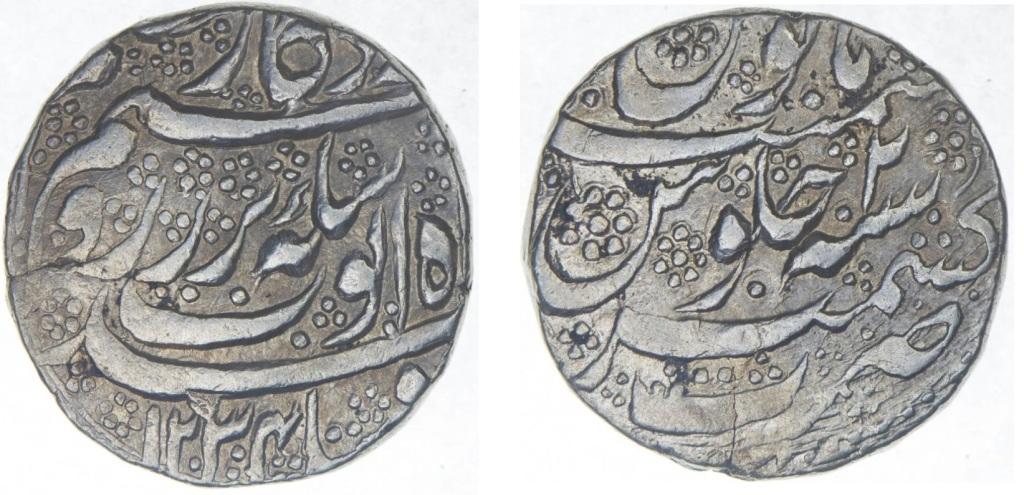 |
KM#614. Rupee. Year:
AH 1234 - RY2 (1819).
Weight: 10.96g.
Metal:
0.925 Silver.
Diameter: 21.50 mm. Edge:
Plain. Alignment:
Rotated. Mint:
Kashmir.
Reverse: "Zarb
Kashmir Sanah 2 julus maimanat manus"
(Struck
at
Kashmir in year 2, associated with tranquil prosperity).
Mintage: N/A.
Minted Years:
One year type.
Ruler:
Ayyub Shah ibn Taimur Shah (1817-1829). |
|
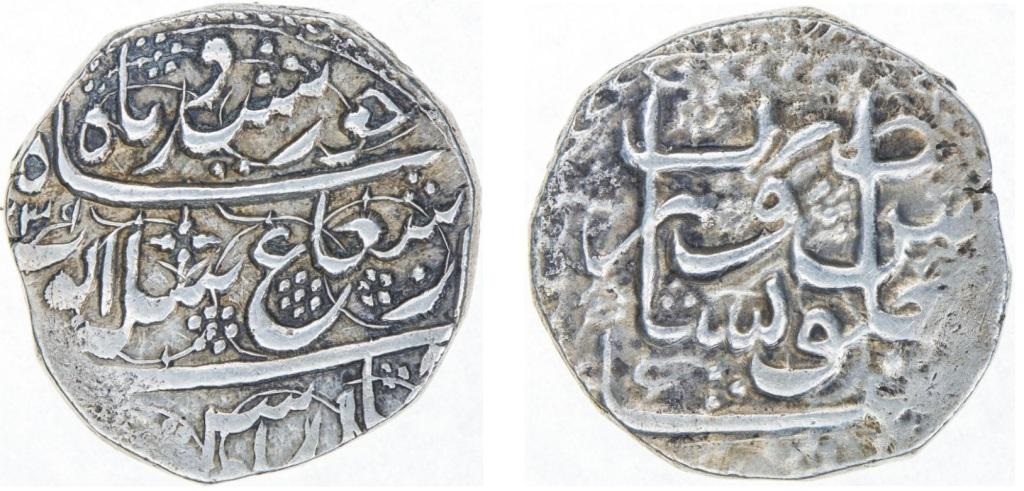 |
KM#733. Rupee. Year:
AH xx39 - RY6 (1823).
Weight: 10.50g.
Metal:
0.925 Silver.
Diameter: 22.25 mm. Edge:
Plain. Alignment:
Medal. Mint:
Peshawar.
Reverse: "Zarb
Peshawar Sanah 6 julus maimanat manus"
(Struck
at Peshawar in year 6, associated with tranquil prosperity). |
|
Mintage:
N/A. Minted Years:
AH1233//1, AH1234/1, AH1234//2, AH(123)4//6,
AH1235//2, AH1235//3, AH1236//3, AH1236//4, AH1237//4, AH1237//5,
AH1238//5, AH1238//6, AH1239//6, AH1239//7, AH1240//6, AH1240//7,
AH1240//8, AH1241//7, AH1242//9, AH1243//8, AH1243//9, AH1243//10,
AH1244//11 and AH1245//11 (1818-1829).
Ruler:
Ayyub Shah ibn Taimur Shah (1817-1829).
Sikh effective rule in Peshawar commenced in AH1231 (1816), but all
coinage cites only the Durrani ruler, Mahmud Shah until about AH1234 (1819) and then Ayyub
Shah until AH1245 (1829). |
|
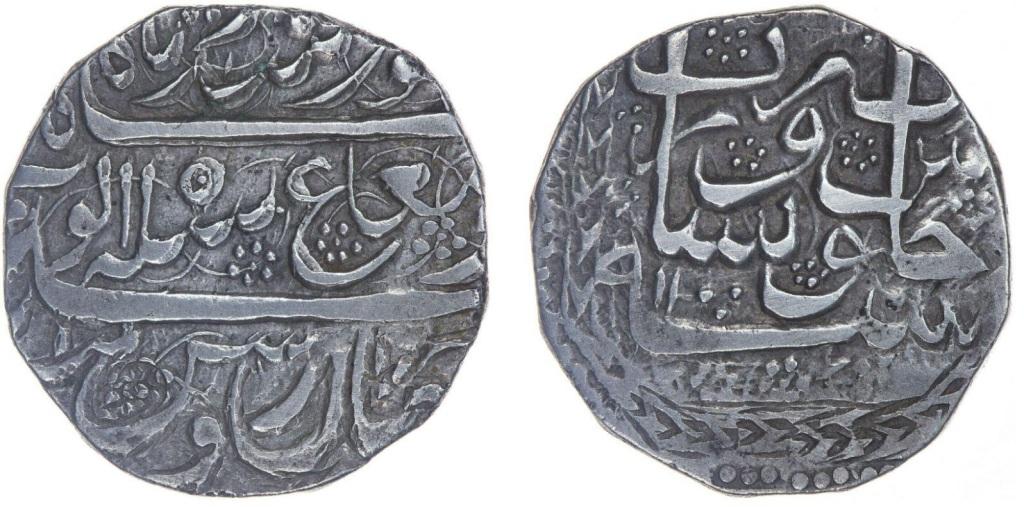 |
Same as above coin KM#733 Rupee, but...
Year:
AH xxx5 - RY11 (1829).
Weight: 10.39g.
Diameter: 23.00 mm. Alignment:
Medal. Mintage:
N/A.
The Date AH xxx5 - RY11 indicates
that it should be AH 1245. |
|
| |
|
|
- Great
Britain........................................Apr 1839 - 06 Jan 1842
First Anglo-Afghan War: An army of British and Indian
troops under the command of Sir John Keane (subsequently replaced by Sir
Willoughby Cotten and then by the spectacularly incompetent Major-General
William George Keith Elphinstone) set out from the Punjab in December 1838.
With them was William Hay Macnaghten, the former chief secretary of the
Calcutta government who had been selected as Britain's chief representative
to Kabul. They reached Quetta by late March 1839 and a month later took
Kandahar without a battle. In July, after a two-month delay in Kandahar, the
British attacked the fortress of Ghazni, overlooking a plain leading to
eastward into the North West Frontier Province, and achieved a decisive
victory over Dost Mohammad's troops led by one of his sons. Dost Mohammad
fled with his loyal followers across the passes to Bamian, and ultimately to
Bukhara. In August 1839, after almost thirty years, Shuja was again
enthroned in Kabul. Some British troops returned to India, but it soon
became clear that Shuja's rule could only be maintained with the presence of
British forces. The Afghans resented the British presence and Shah Shuja. As
the occupation dragged on, MacNaghten allowed his soldiers to bring in their
families to improve morale; this further infuriated the Afghans, as it
appeared the British were settling into a permanent occupation. After he
unsuccessfully attacked the British and their Afghan protégé, Dost Mohammad
surrendered to them and was exiled in India in late 1840.
By October 1841, however, disaffected Afghan tribes were flocking to support
Dost Mohammad's son, Mohammad Akbar Khan, in Bamian. In November 1841 a
senior British officer, Sir Alexander 'Sekundar' Burnes, and his aides were
killed by a mob in Kabul. The substantial remaining British forces in their
cantonment just outside Kabul did nothing immediately. In the following
weeks the British commanders tried to negotiate with Mohammad Akbar. In a
secret meeting, MacNaghten offered to make Akbar Afghanistan's vizier in
exchange for allowing the British to stay. Rather than betray his
countrymen, Akbar ordered MacNaghten thrown in prison. Along the way to
prison, an angry mob killed MacNaghten and his dismembered corpse was
paraded through Kabul. In this war known as the First Anglo-Afghan War,
placed in command of the British garrison in Kabul, numbering around 4500
troops, of whom 690 were European and the rest Indian. As they struggled
through the snowbound passes, the British were attacked by Ghilzai warriors.
The evacuees were harassed down the 30 miles (48 km) of treacherous gorges
and passes lying along the Kabul River between Kabul and Gandamak, and
massacred at the Gandamak pass before reaching the besieged garrison at
Jalalabad. The force had been reduced to fewer than forty men by a retreat
from Kabul that had become, towards the end, a running battle through two
feet of snow. The ground was frozen, the men had no shelter and had little
food for weeks. Only a dozen of the men had working muskets, the officers
their pistols and a few unbroken swords. The only Briton known to have
escaped was Dr. William Brydon, who reached Jalalabad, though a few others
were captured. Elphinstone died as a captive in Afghanistan some months
later on 23 April 1842.
(Kings - Sadozai segment)
Shoja al-Mulk Muhammad Shah (4th
time).......08 May 1839 - 05 Apr 1842
Ruler at Kabul. Qandahar
from Apr 1839.
BARAKZAI
Mohammad Zaman Khan Mohammadzai.....................1841
- Apr 1842
Rebel regent at
Kabul.
DURRANI
(Emirs - Sadozai segment)
Safdar Jang Khan Sadozai
(regent at Qandahar).......May 1842 -
1842
Fath
Jang Khan (Kabul & Qandahar)................29 Jun 1842 - 12 Oct 1842
Shahpur Khan (Kabul).............................12
Oct 1842 - Dec 1842
|
|
Shuja al-Mulk Muhammad Shah Durrani: 1839-1842 |
|
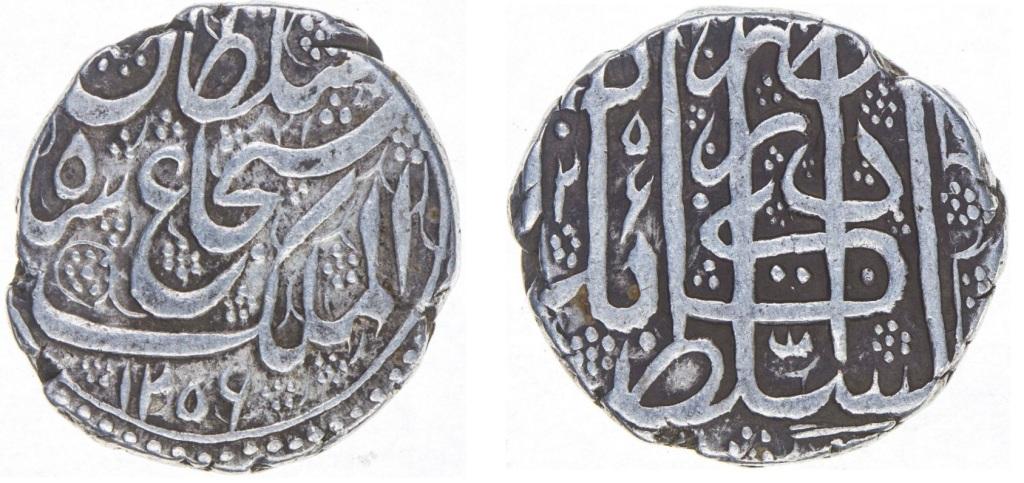 |
KM#484.1 Rupee.
Year: AH 1256 (1840).
Weight: 9.35g.
Metal: 0.925 Silver.
Diameter: 23.50 mm. Edge:
Plain. Alignment:
Rotated. Mint: Kabul.
Obverse: "Sultan
Shoja Shah Al-Mulk" / AH 1256. Reverse: "Zarb Dar-es-Sultanate
Kabul / AH 1256". Ruler:
Shoja al-Mulk Muhammad Shah.
Mintage:
N/A.
Minted Years:
AH1255, AH1256, AH1257 and AH1258 (1839-1842).
This coin was made during First Anglo-Afghan War by British but citing
Shuja al-Mulk Muhammad Shah. |
|
Mohammad Zaman
Khan Barakzai: 1841-1842 |
|
 |
KM#486 Rupee.
Year: AH 1258 (1842).
Weight: 9.47g.
Metal: 0.925 Silver.
Diameter: 20.00 mm. Edge:
Plain. Alignment:
Coin. Mint: Kabul.
Obverse: "Zarb Dar-es-Sultanate
Kabul / AH 1258". Ruler:
Mohammad Zaman Khan (rebel at Kabul during
1841-1842). Mintage:
N/A.
Minted Years:
One year type.
This coin is mistakenly listed under Shuja al-Mulk in Krause
publications. |
|
Fath Jang Khan Durrani:
1842 |
|
 |
KM#178 Rupee.
Year: AH 1258 (1842).
Weight: 9.00g.
Metal: 0.925 Silver.
Diameter: 21.00 mm. Edge:
Plain. Alignment:
Rotated (5 o'clock). Mint:
Ahmadshahi (Qandahar).
Obverse: "Fath Jang
Badshah" in the center line.
Reverse: "Zarb
Ahmadshahi / AH 1258". Ruler: Fath Jang
Khan (1842). Mintage:
N/A.
Minted Years:
One year type.
On Obverse side, three dots after digit 8 in Date; One
above and two below. |
|
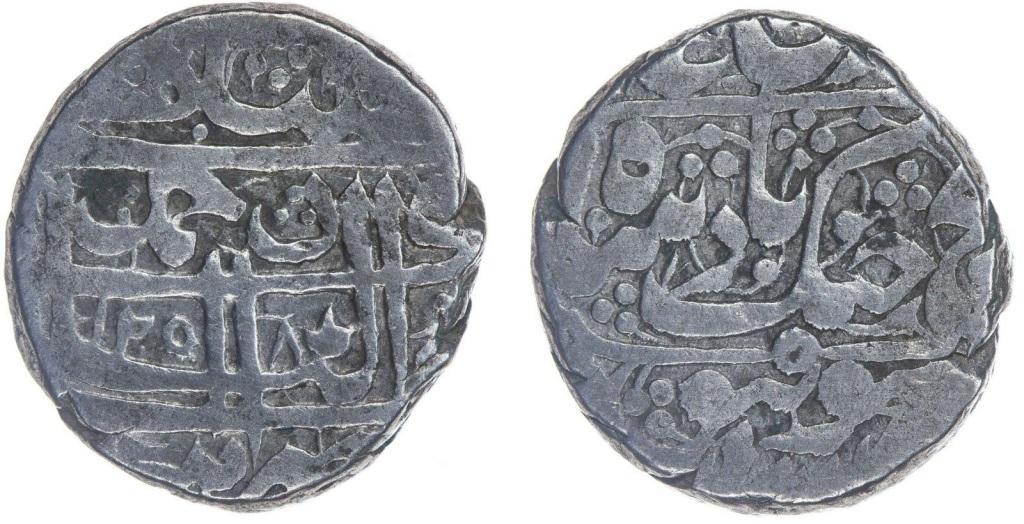 |
Type2: Same as above coin, KM#178 Rupee,
but having different font size and position of characters vary.
Maple leaf design after digit "8" in Date.
Weight: 8.91g.
Diameter: 22.00 mm. Alignment:
Coin. |
|
 |
Type3: Same as above coin, KM#178 Rupee,
but having thick and curved lines instead of thin and straight
horizontal lines on the Reverse side. Even the position of
characters on Reverse side widely differs.
On Obverse side, three dots after digit 8 in Date; Two
above and one below, different from Type1. Unlisted style.
Weight: 9.00g.
Diameter: 22.00 mm. Alignment:
Rotated (2 o' clock). |
|
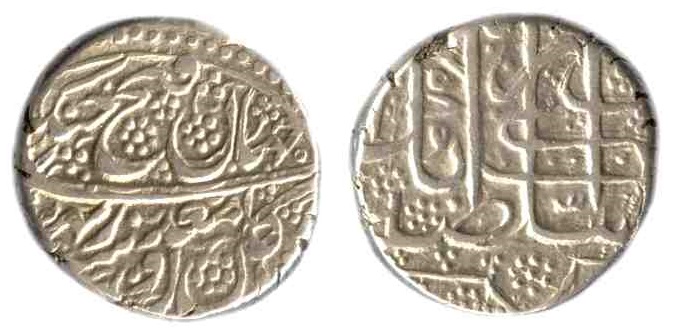 |
KM#488.1 Rupee.
Year: AH 1258 (1842).
Weight: 9.00g.
Metal: 0.925 Silver.
Diameter: 21.00 mm. Edge:
Plain. Alignment:
Coin. Mint: Kabul.
Obverse: Couplet, name Fath Jang at top.
Reverse: "Zarb Dar-es-Sultanate
Kabul / AH 1258". Ruler: Fath Jang
Khan (1842). Mintage:
N/A.
Minted Years:
One year type.
KM#488.2 also exists as one year
type, having the name "Fath Jang" in center. This type is more
scarce than the displayed one. |
|
| |
-
Continued fragmentation as Emirs, 1842 to 1878.Kohandil Khan
Mohammadzai
(2nd
time regent
at Qandahar)..1842 - Aug
1855He was son
of Payinda (Sarafraz) Khan. Qandahar was captured by Dost
Muhammad in 1851.
Dost Muhammad Khan
Mohammadzai (2nd
time)............Dec
1842 - 09 Jun 1863
He ruled Kabul and Balkh
from 1842, Sar-I-Pul from 1850, Qandahar from July 1858. Herat was ruled briefly under his reign from 26 May 1863. He was the son of
Payinda (Sarafraz) Khan. He also issued coins in the name of Amir-e Kabir and his late son
Akbar Khan.After Dost Mohammad Khan established himself in
Kabul he began to extend his rule throughout Afghanistan. He took Gaznī and
defeated Shah Shoja-al-Dawla Sadozī in Qandahar but failed to restore Afghan
sovereignty over Peshawar in AH1250 (1834) and again in AH1253 (1837). He
adopted the title amīr-al-mumenin (commander of the faithful) in AH1254
(1838) and waged what he claimed was jehad (holy war) against the Sikhs. He
inscribed on the first coinage that he issued, in AH1254 (1838): “Amīr Dost
Mohammad resolved to wage jehad / And to mint coins, may God grant him
victory.” From that time on he was known as Amir-e Kabir, despite a
three-year interruption in his rule. In AH1255 (1839), with the help of
British forces, he was ousted from Kabul, and Shah Shoja-al-Dawla was
installed as ruler. After some attempts to regain his throne Dost Mohammad
Khan surrendered to the British government and was exiled to India. It was
during his second reign that Dost Mohammad Khan was able to bring all of
Afghanistan under his direct control, with the exception of Peshawar and
Kashmir, which have remained separate. He conquered Bamīan and Hazarajat in
AH1266 (1849), naming his son Mohammad Akram Khan as governor. During an
expedition to Turkestan in AH1271 (1854) Balḵ, Maymana, and Sebergan were
subjugated, and Prince Mohammad Afzal Khan was appointed governor there. The
amir extended his rule over Qandahar after the death, in AH1272 (1855) of
his brother Sardar Kohandel Khan, ruler of that region. Dost Mohammad Khan’s
last campaign resulted in the conquest of Herat, but he died there of
natural causes in AH1279 (1863). At the time of his death he had sixteen
wives. The result of these alliances was a great number of offspring,
twenty-seven sons and twenty-five daughters at his death, the cause of much
discord among the Mohammadzī. Three of his sons ruled in Afghanistan as
amirs: Sher Alī Khan (AH1280-82/1863-65, AH1285-97/1868-79), Mohammad Afżal
Khan (AH1283-84/1866-67), and Mohammad Azam Khan (AH1284-85/1867-68). Other
noteworthy sons were Mohammad Akbar Khan, Gholam Ḥaydar Khan and Mohammad
Amīn Khan.Rahamdil Khan (Qandahar).................................1855
- 1856
- Mohammad Sadeq Khan Mohammadzai (regent)........Aug 1855 - Nov
1855
- Gholam Haydar Khan Mohammadzai (regent).........Nov 1855 - Jul
1858
Isa Khan Bardorani (minister-regent at Herat)........Jun
1856 - Oct 1856
Herat was occupied by Iran from
Oct 1856 to 27 Jul 1857 and coins were issued
in the name of Nasir al-Din Shah [AH1272 to AH1280 (1856 to 1863)].
Sultan Ahmad Khan
Mohammadzai (Herat)............27
Jul 1857 - 26 May 1863
Sher Ali Khan
Mohammadzai
(1st
time)....................1863 - May 1866
Emir of Kabul and Qandahar.
Continued ruling Herat
from 09 Jun 1863 to 21 Feb 1879 and Qandahar from 1865 to Jan 1867.
Mohammad Amin Khan Mohammadzai (Qandahar)...............1863
- 1865
Muhammad Afzal Khan
Mohammadzai....................
May 1866 - 07 Oct 1867
Emir of Balkh, Herat, Kabul & Qandahar. Qandahar from
Jan 1867.
Muhammad Azam
Khan Mohammadzai...................07 Oct 1867 - 08 Sep 1868
Emir of Balkh, Herat, Kabul
and Qandahar. Qanadar till Apr 1868.
Sher Ali Khan Mohammadzai (2nd
time).............08
Sep 1868 - 21 Sep 1879
Emir of Balkh, Herat, Kabul & Qandahar. Qandahar
from Apr 1868 and Maimana from 1876.
|
|
Kohandil Khan:
1842-1855 |
|
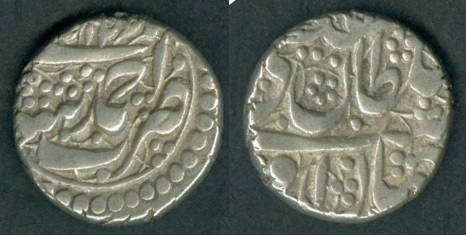 |
KM#182.1 Half Rupee.
Year: AH 1260 (1844). Weight: 5.71g. Metal:
0.925 Silver.
Diameter: 19.00 mm. Edge:
Plain. Alignment:
Rotated. Mint: Ahmadshahi (Qandahar).
Obverse:
Date at the top right side within the center
circle. "Zarb Ahmadshahi" in the center circle.
Reverse:
"Sultan Haqiqi" (Real Sultan) written at the top
line. |
|
Mintage:
N/A. Minted Years:
AH1260, AH1261, AH1262, AH1263, AH1264, AH1265,
AH1264//1266, AH1267, AH1268, AH1269, AH1270, AH1271 and AH1272
(1844-1855). Ruler: Kohandil Khan Mohammadzai
[regent at Qandahar]
(1842-1855).
Note:
Both obverse and reverse have legends differently arranged in
different years. For example in the above coin, the mint name "Ahamdshahi"
ends with "ے" while in the below coin, it
ends with "ی". "Ahamdshahi"
ends with "ی" but within a 12 curve design instead of circle
were also minted in AH1266 and AH1269. |
|
 |
Year: AH 1261 (1845). Weight: 5.61g.
Alignment:
Rotated. Mintage:
N/A.
Date at the bottom within the center
circle. |
|
 |
Same as above coin KM# 182.1, Half Rupee but...
Year: AH 126x (1844-1853). Weight: 5.71g. Alignment:
Rotated. Mintage:
N/A.
Note:
Mint name "Ahamdshahi"
end with "ے". Date at the
top right side within the center circle. |
|
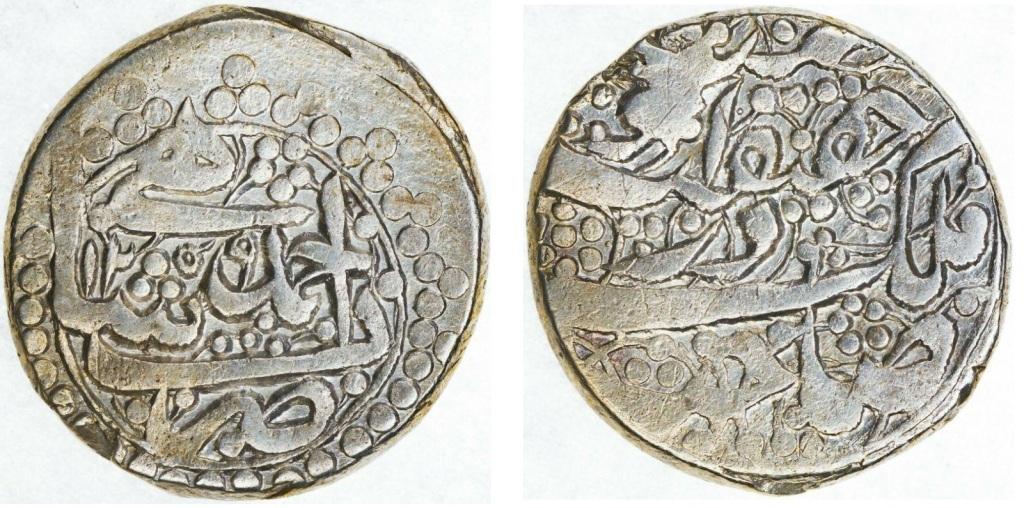 |
KM#183 Rupee.
Year: AH 1259 (1843). Weight:
8.99g. Metal:
0.925 Silver.
Diameter: 22.50 mm. Edge:
Plain. Alignment:
Coin. Mint: Ahmadshahi (Qandahar).
Obverse:
Zarb Ahmadshahi / 1259.
Reverse:
Persian legends in four lines. Mintage:
N/A. Minted Years:
One year type. Ruler: Kohandil Khan Mohammadzai
[regent at Qandahar]
(1842-1855).
This is the only Rupee coin issued
by Kohandil Khan, therefore it is considered Rare. |
|
Dost Muhammad Khan
(2nd time): 1842-1863 |
|
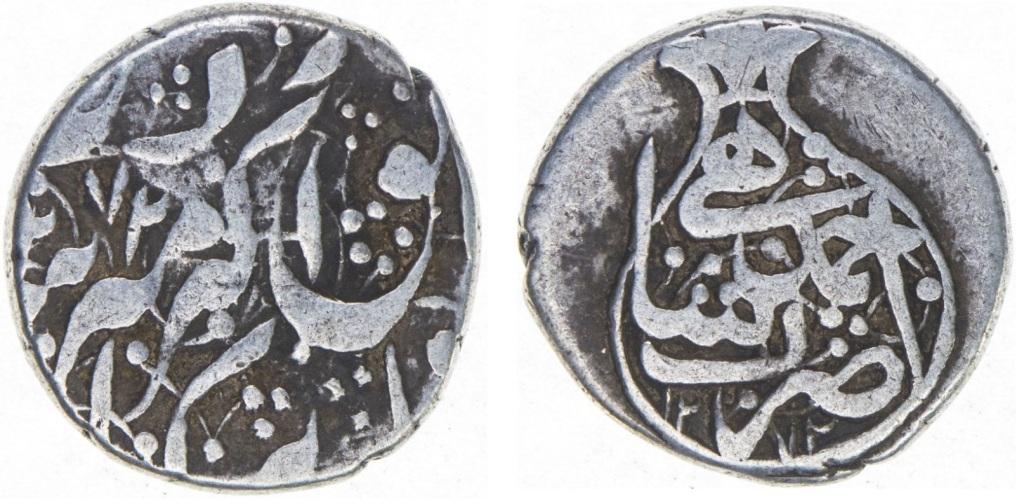 |
KM#186. Half Rupee.
Year: AH 1272 (1855).
Weight: 5.47g.
Metal: 0.925 Silver.
Edge:
Plain. Diameter:
18.50 mm.
Alignment:
almost Medal. Mint:
Kabul.
Obverse: "Amir-e
Kabir, Akbar Khan / x272". Reverse:
"Zarb Ahmadshahi" with Date AH 1272 written within jar.
Mintage:
N/A.
Minted Years:
AH1272, AH1273, AH1273//1272 (Date on both sides) [1855-1856].
Ruler:
Dost Muhammad Khan ibn Payinda (Sarafraz) Khan Muhammadzai ibn Jamal Khan
[2nd reign] (1842-1863). |
|
Note: "Amir-e Kabir" was the
title Dost Muhammad Khan gave himself in 1838 after the Battle of
Jamrud. "Akbar Khan" was his brave son who led an army of well
trained and equipped men in this battle. Mohammad Akbar Khan was
born in 1816 to Emir Dost Mohammad Barakzai of Afghanistan and
Mermən Khadija Popalzai. Mohammad Akbar Khan fame began on 30 April
1837 at the Battle of Jamrud, while attempting to regain
Afghanistan's second capital Peshawar from the Sikh Empire. In this
battle Sikh General Hari Singh Nalwa was killed and this was
considered a big achievement by Afghans. Mohammad Akbar Khan is
known for his conquest of Bala Bagh and of Jalalabad during first
Anglo-Afghan war (1839-1842). He is very well known by the British
for the massacre of Elphinstone's army (British retreat from Kabul
during January 1842) at the Gandamak pass (06–13 January 1842). The only survivor, the assistant surgeon William Brydon,
reached the besieged garrison at Jalalabad on 13 January 1842.
Major-General William George Keith Elphinstone died in captive on
23rd April 1842. His body was dispatched with a small guard of
Afghan soldiers to the British garrison at Jalalabad and was buried
in an unmarked grave. Mohammad Akbar Khan died in 1845. The above
coin was made by Dost Muhammad Khan as a remembrance of his brave
son. |
|
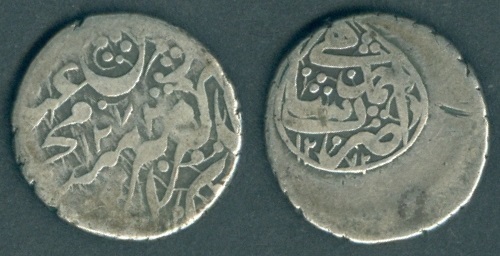 |
Same as above coin, but jar on the Reverse side is off flan.
Complete Date on both sides.
Year: AH 1272 (1855).
Weight: 5.35g.
Metal: 0.925 Silver.
Edge:
Plain. Diameter:
19.50 mm.
Alignment:
Coin. |
|
.jpg) |
KM#187.3 Half Rupee.
Year: ND [AH 1277 (1860)].
Weight: 5.47g.
Metal: 0.925 Silver.
Edge:
Plain. Diameter:
18.25 mm.
Alignment: Medal. Mint:
Kabul.
Obverse: "...
Dost Muhammad... / ND". Reverse:
"Zarb Qandahar" written outside the center oval.
Mintage:
N/A.
Minted Years:
One year type.
Ruler:
Dost Muhammad Khan ibn Payinda (Sarafraz) Khan Muhammadzai ibn
Jamal Khan [2nd reign] (1842-1863) |
|
Note: This style / design is not listed
in Krause publication if compared with KM#187.1 and KM#187.2. It has
Thuluth font / script on Obverse side. Anyhow this coin with proper
Date AH 1277 is listed in Zeno as Z-201205. |
|
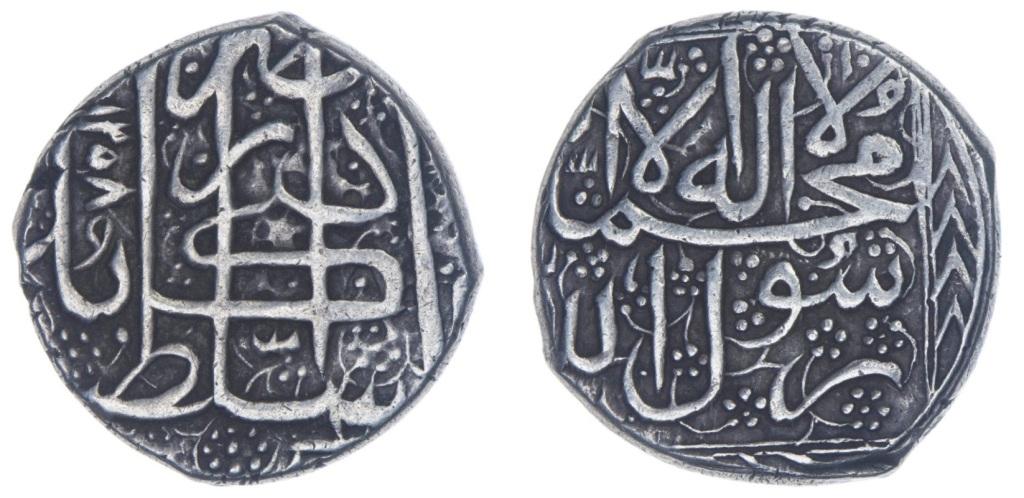 |
KM#493. Rupee.
Year: AH 1258 (1842).
Weight: 9.24g.
Metal: 0.925 Silver.
Edge:
Plain. Diameter:
21.00 mm.
Alignment:
almost Coin. Mint:
Kabul.
Obverse: Zarb Dar es-Sultanate
Kabul / 1258. Reverse:
Kalima.
Mintage:
N/A.
Minted Years:
One year type.
Ruler:
Dost Muhammad Khan ibn Payinda (Sarafraz) Khan Muhammadzai ibn Jamal Khan
[2nd reign] (1842-1863). |
|
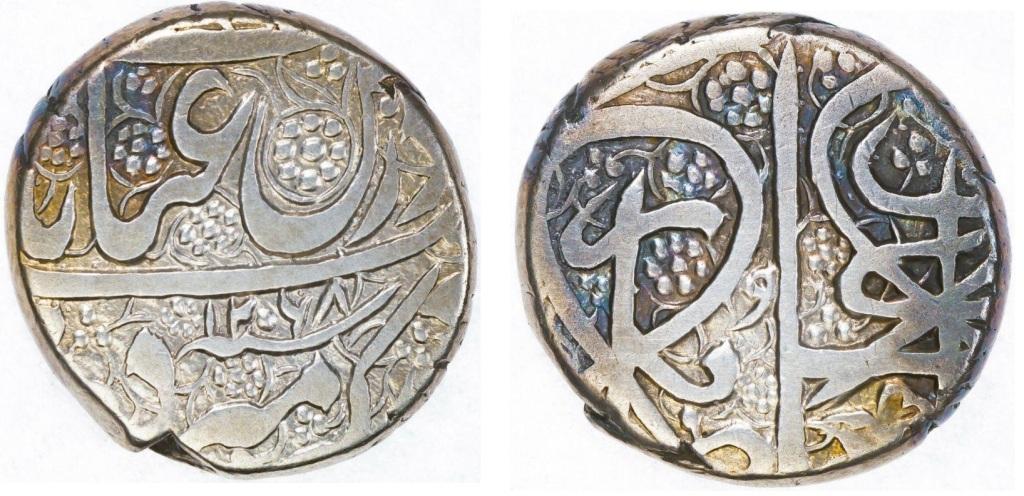 |
KM#497.1 Rupee.
Year: AH 1268 (1852). Weight:
9.19g. Metal:
0.925 Silver.
Diameter: 20.00 mm.
Edge:
Plain.
Alignment: Rotated (9
o' clock). Mint:
Kabul. Obverse:
Date in the center. Reverse:
Dar as-Sultanat - Kabul.
Date the bottom. |
|
Mintage:
N/A. Minted Years:
AH1259, AH1262, AH1263, AH1264, AH1265, AH1266
Five-pointed star on obverse, AH1266 Five-pointed star on reverse,
AH1266 Five-pointed star on both sides, AH1267//1266 Five-pointed star
on reverse, AH1267 Five-pointed star on reverse, AH1268, AH1269, AH1270,
AH1271, AH1272, AH1273, AH1274, AH1275, AH1276, AH1277, AH1278, AH1279
and AH1280 (1843-1863). Ruler:
Dost Muhammad Khan ibn Payinda (Sarafraz) Khan Muhammadzai ibn Jamal Khan
[2nd reign] (1842-1863).
Note: couplet ending "Khaliq-i-Akbar"
on Obverse side having many varieties. Mulings exist with different dates on obverse and reverse. |
|
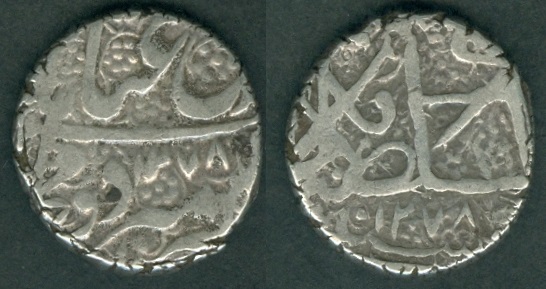 |
Same as above coin KM#497.1 Rupee,
but...
Year: AH 1278 on both
sides (1861). Weight:
9.30g.
Diameter: 21.00 mm.
Alignment: Coin.
Mintage:
N/A. |
|
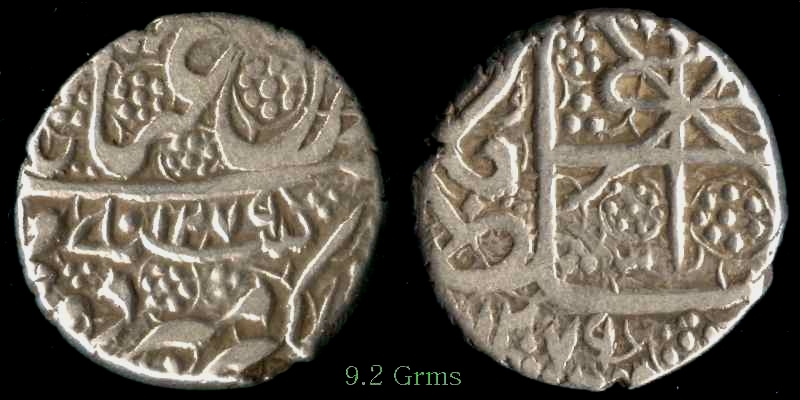 |
Same as above coin KM#497.1 Rupee,
but...
Year: AH 1279 on both
sides (1862). Weight:
9.20g.
Diameter: 21.00 mm.
Alignment: Coin.
Mintage:
N/A. |
|
 |
KM#497.2. Rupee.
Year: AH 1272 (1855).
Weight: 9.10g.
Metal: 0.925 Silver.
Edge:
Plain. Diameter:
22.50 mm.
Alignment:
Medal. Mint:
Kabul.
Obverse: Leaf at 2
o'clock. Date in the center. Reverse:
Dar as-Sultanat - Kabul.
Two leaves on right side. Date the bottom left side.
Mintage:
N/A.
Minted Years:
AH1269, AH1269//1270, AH1270, AH1271, AH1272, AH1273, AH1274,
AH1275, AH1276 and AH1277 (1853-1860). Ruler:
Dost Muhammad Khan ibn Payinda (Sarafraz) Khan Muhammadzai ibn Jamal Khan
[2nd reign] (1842-1863). |
|
Note:
Dost Muhammad Khan added two leaves against
Sikh single leaf on his coins for more blessing and good luck. Pipal
Leaf type, design inspired from Sikh coinage. |
|
Sher Ali Khan
(1st time): 1863-1866 |
|
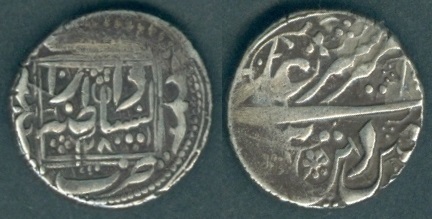 |
KM#410.1 Half Rupee.
Year: AH 1280 (1863). Weight:
4.91g. Metal:
0.925 Silver.
Diameter: 17.00 mm. Edge:
Plain. Alignment:
Rotated (9 o'clock). Mint in square:
Dar as-Sultanat -
Herat.
Mintage:
N/A.
Mint Years: One year type.
Ruler: Sher Ali Khan Barakzai
(1st
time) [third son of Dost Mohammed Khan]
(1863-1866).
Type:
Legend in square. KM#410.2 has legend
in "Mehrabi" square also Dated: AH 1280 (1863). |
|
 |
KM#412 Half Rupee.
Year: AH 1284 (1868). Weight:
4.96g. Metal:
0.925 Silver.
Diameter: 17.25 mm. Edge:
Plain. Alignment:
Rotated (5 o'clock). Mint:
Dar as-Sultanat -
Herat.
Obverse:
Date at the top. "Emir Sher
Ali" written at the bottom line.
Reverse:
"Dar as-Sultanat -
Herat". Date at the bottom. |
|
Mintage:
N/A.
Minted Years:
AH1281, AH1281//1283, AH1282, AH1283, AH1284,
AH1285 and AH1287 (1864-1868 and 1870).
Ruler: Sher Ali Khan Barakzai
(1st
time) [third son of Dost Mohammed Khan]
(1863-1866).
Note:
Dates on both sides. Mules exist
bearing various combinations of these dates. |
|
Muhammad Afzal Khan:
1866-1867 |
|
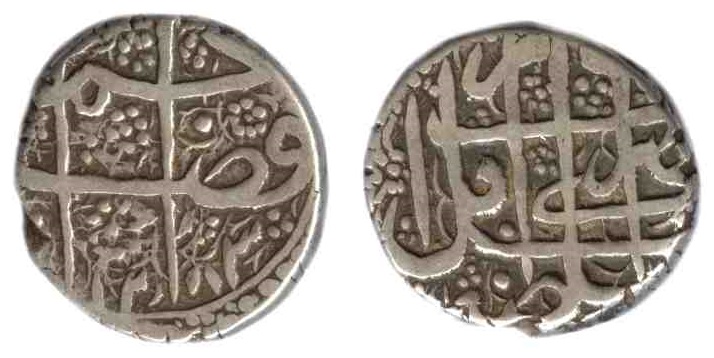 |
KM#507 Rupee.
Year: AH 1283 (1866). Weight:
9.09g. Metal:
0.925 Silver.
Diameter: 21.00 mm. Edge:
Plain. Alignment:
Rotated. Mint:
Dar as-Sultanat -
Kabul.
Obverse:
Muhammad Afzal / 1283.
Reverse: Zarb
Dar as-Sultanat - Kabul.
Mintage: N/A.
Minted Years:
AH 1283-1284 (1866-1867).
Ruler: Muhammad Afzal Khan Barakzai
[eldest
son of Dost Muhammad Khan]
(1866-1867).
Note: Two varieties
are known, minted in AH 1283.
|
|
 |
Same as above coin KM#507 Rupee, but...
Type2:
Year: AH 1283 (1866). Weight:
9.09g.
Diameter: 22.25 mm. Alignment:
Coin. Obverse:
Amir Muhammad Afzal / 1283.
Mintage: N/A.
AH 1284 issue has the same style as
this coin. |
|
Muhammad Azam Khan:
1867-1868 |
|
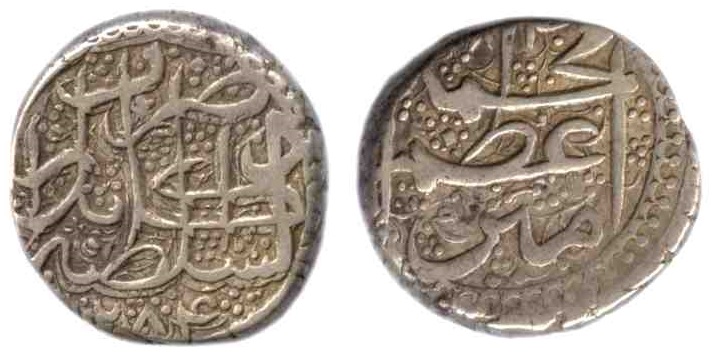 |
KM#508.1 Rupee.
Year: AH 1284 (1867). Weight:
9.11g. Metal:
0.925 Silver.
Diameter: 21.00 mm. Edge:
Plain. Alignment:
Rotated. Mint:
Dar as-Sultanat - Kabul.
Obverse:
Zarb Dar as-Sultanat - Kabul.
Reverse:
Azam above Amir and below Muhammad.
Mintage:
N/A.
Minted Years:
AH 1284-1285 (1867-1868).
Ruler:
Muhammad Azam Khan
Barakzai
(1867-1868).
Note:
KM#508.1, dated AH 1284 and AH 1285
has Azam (in the center) above Amir and below Muhammad. |
|
 |
KM#508.2 Rupee.
Year: AH 1284 (1867). Weight:
9.15g. Metal:
0.925 Silver.
Diameter: 22.00 mm. Edge:
Plain. Alignment:
Medal. Mint:
Dar as-Sultanat - Kabul.
Obverse:
Zarb Dar as-Sultanat - Kabul.
Reverse:
Muhammad above Amir and below Azam.
Mintage:
N/A.
Minted Years:
One year type.
Ruler:
Muhammad Azam Khan
Barakzai
(1867-1868).
Note:
KM#508.2, dated AH 1284
has Muhammad (in the center) above Amir and below Azam. |
|
Sher Ali Khan
(2nd time): 1868-1879 |
|
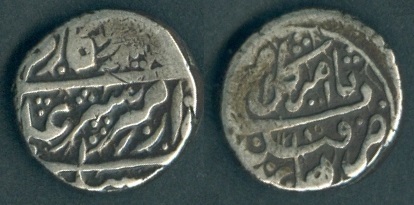 |
KM#205.1 Half Rupee.
Year: AH 1285 (1869). Weight:
5.55g. Metal:
0.925 Silver.
Diameter: 15.50 mm. Edge:
Plain. Alignment:
Rotated (7 o'clock). Mint:
Qandahar.
Obverse:
"Emir Sher Ali"
written in center line.
Reverse:
"Zarb Qandahar" at the bottom.
Tiny Date in the center.
Mintage:
N/A.
Minted Years:
AH1284 and AH1285 (1868-1869).
Ruler: Sher Ali Khan Barakzai
(2nd
time) [third son of Dost Mohammed Khan]
(1868-1879). |
|
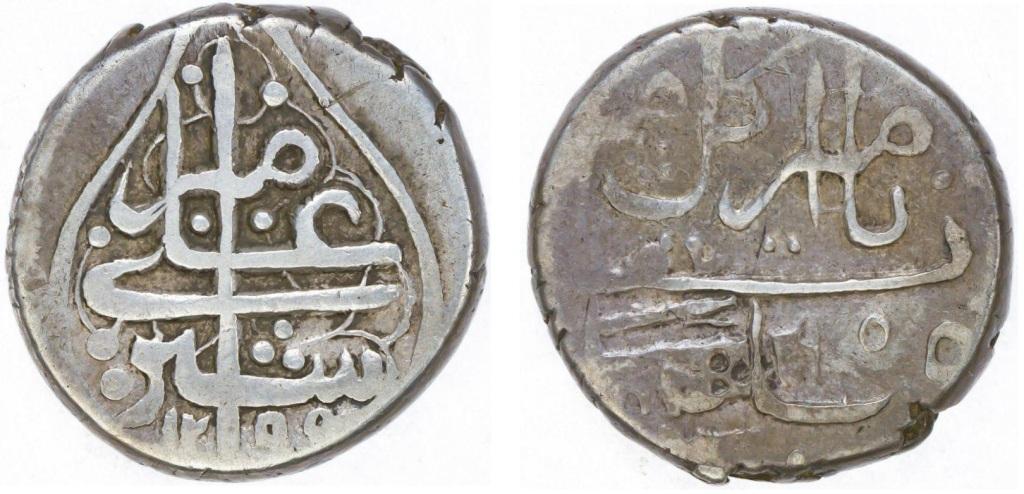 |
KM#207.2 Half Rupee.
Year: AH 1285 (1868). Weight:
5.39g. Metal:
0.925 Silver.
Diameter: 17.50 mm. Edge:
Plain. Alignment:
Coin. Mint:
Qandahar.
Obverse:
"Emir Sher
Ali" written in the center of the teardrop. Date at the bottom.
Reverse:
Date at the bottom.
Type:
Teardrop design. |
|
Mintage:
N/A.
Minted Years:
AH1284 and
AH1285 (1868).
Ruler: Sher Ali Khan Barakzai
(2nd
time) [third son of Dost Mohammed Khan]
(1868-1879). |
|
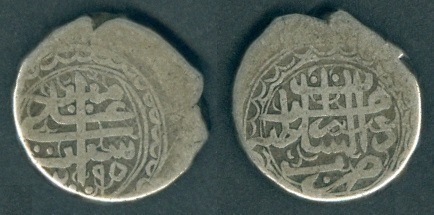 |
KM#413 Half Rupee.
Year: AH 1295 (1878). Weight:
4.54g. Metal:
0.925 Silver.
Diameter: 16.00 mm. Edge:
Plain. Alignment:
Rotated (3 o'clock). Mint:
Dar as-Sultanat - Herat.
Obverse:
"Emir Sher Ali"
written in the center circle. Date at the bottom within the
center circle.
Reverse:
"Zarb Dar as-Sultanat -
Herat". |
|
Mintage:
N/A.
Minted Years:
AH1292 and AH1295 (1875 and 1878).
Ruler: Sher Ali Khan Barakzai
(2nd
time) [third son of Dost Mohammed Khan]
(1868-1879).
Note:
Several varieties exist. A Tilla dated
AH1284 of Sher Ali has been reported. |
|
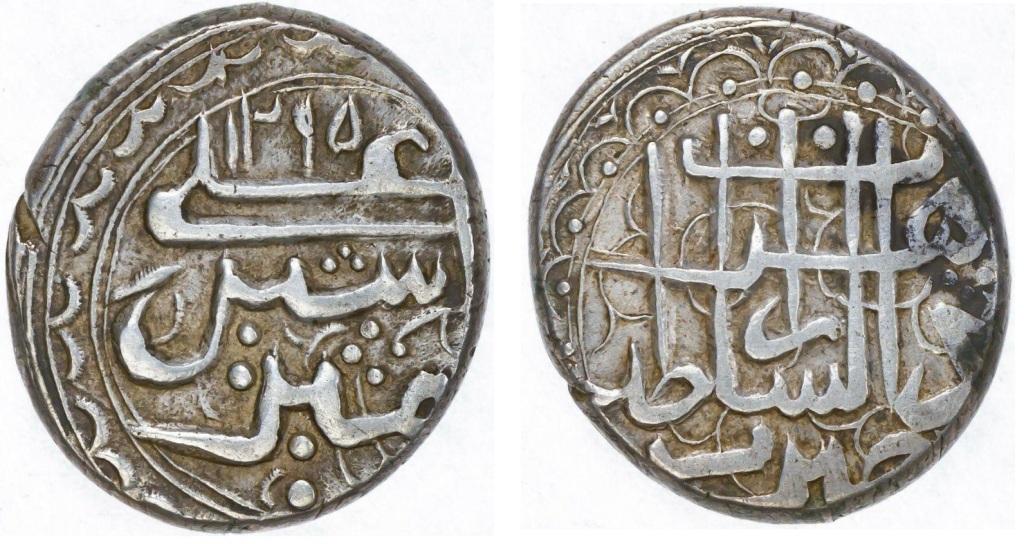 |
Unlisted style / design of the above coin. Crude design on both
sides. Date at the top on Obverse side. Half Rupee.
Year: AH 1295 (1878). Weight:
4.54g. Metal:
0.925 Silver.
Diameter: 17.00 mm x
15.00 mm. Edge:
Plain. Alignment:
Coin. Mint:
Dar as-Sultanat - Herat.
Obverse:
"Emir Sher
Ali" written in the center circle. Date at the bottom of the
center circle.
Reverse:
"Zarb Dar as-Sultanat -
Herat".
Mintage:
N/A. |
|
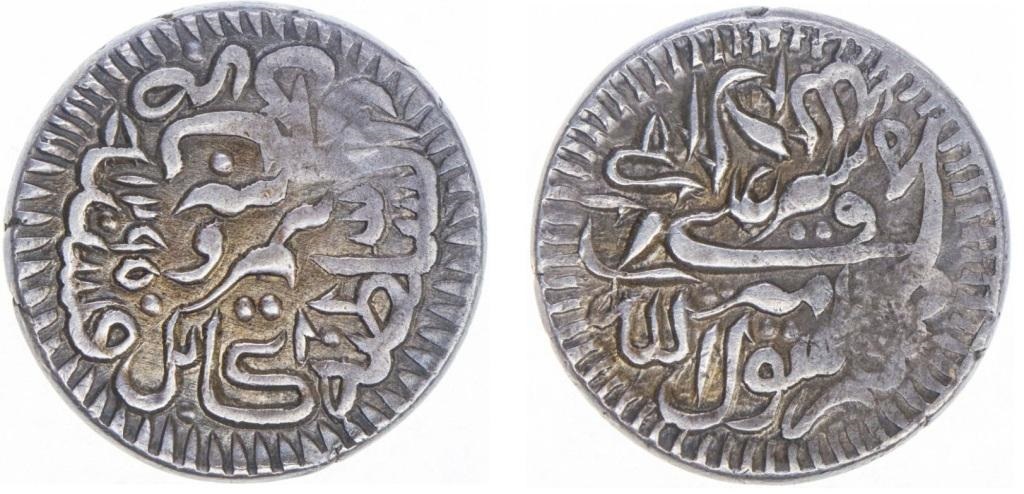 |
KM#514 Half Rupee.
Year: AH 1295 (1878). Weight:
4.61g. Metal:
0.925 Silver.
Diameter: 19.00 mm. Edge:
Plain. Alignment:
Coin. Mint:
Dar as-Sultanat - Kabul.
Obverse:
"نیم روپیه" (Nim Rupiya)
[Half Rupee] written in the center. "Zarb Dar as-Sultanat - Kabul
Sannah 1295" written around clockwise starting from the top. |
|
Reverse:
"Emir Sher
Ali" written in the center. Kalima written around starting from
the top.
Mintage:
N/A.
Minted Years:
One year type.
Ruler: Sher Ali Khan Barakzai
(2nd
time) [third son of Dost Mohammed Khan]
(1868-1879). |
|
 |
|
KM#520
Rupee.
Year: AH 1292 (1875). Weight:
9.23g. Metal:
0.925 Silver.
Diameter: 27.00 mm. Edge:
Plain. Alignment:
Rotated (1 o'clock). Mint:
Dar as-Sultanat - Kabul.
Obverse:
"یک روپیه" (Ek Rupiya)
[One Rupee] written in the center. "Zarb Dar as-Sultanat - Kabul
Sannah 1292" written around clockwise starting from the bottom.
Reverse:
"Emir Sher
Ali" written in the center. Kalima written around starting from
the top.
Mintage:
N/A.
Minted Years:
AH 1292 and AH 1293 (1875-1876).
Ruler: Sher Ali Khan Barakzai
(2nd
time) [third son of Dost Mohammed Khan]
(1868-1879). This issue is considered as Nazarana Rupee. |
|
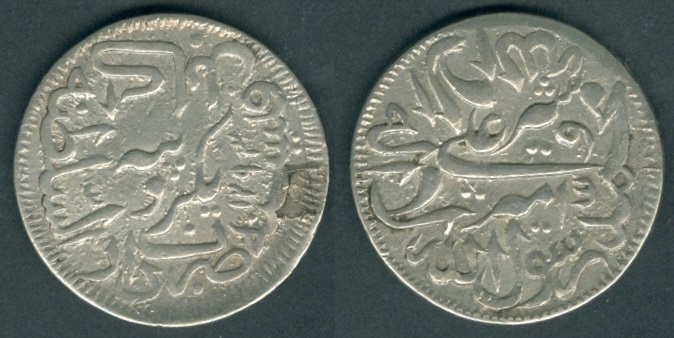 |
|
Same as above coin KM#520 Rupee, but...
Year: AH 1293 (1876). Weight:
9.16g.
Diameter: 26.50 mm. Alignment:
Coin. Mintage:
N/A.
Note:
This coin has thick legends on both
side if compared with above coin. This coin was part of ex-jewelry
and the clip was removed very carefully. |
|
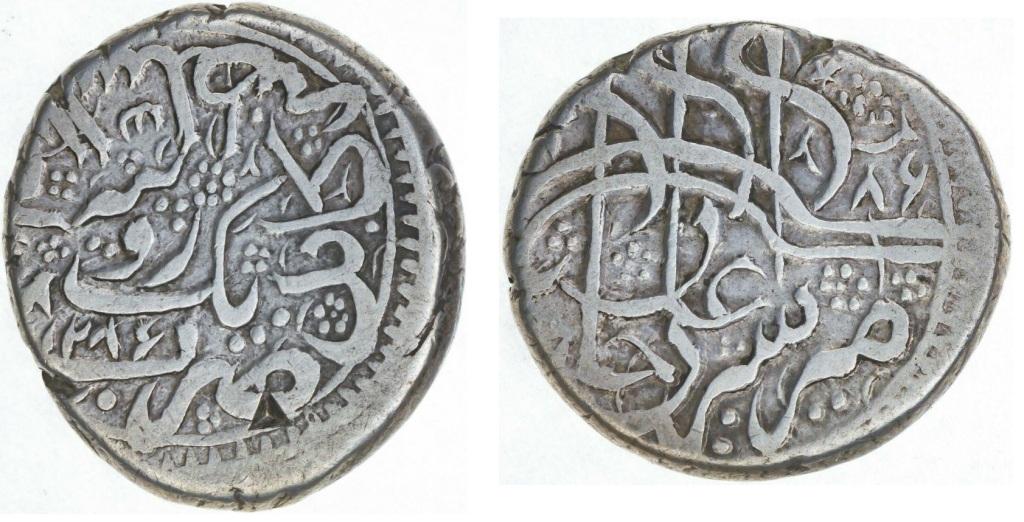 |
KM#517 Rupee.
Year: AH 1286 (1879). Weight:
9.08g. Metal:
0.925 Silver.
Diameter: 22.00 mm. Edge:
Plain. Alignment:
Rotated (3 o' clock). Mint:
Dar as-Sultanat - Kabul.
Obverse:
"یک روپیه" (Ek Rupiya)
[One Rupee] written in the center. "Zarb Dar as-Sultanat - Kabul
Sannah 1286" written around clockwise starting from the bottom.
Reverse:
"Emir Sher
Ali" written as three stem Toughra and Date in the center.
Mintage:
N/A.
Minted Years:
AH1285, AH1286, AH1286//1287 and AH1287 (1878-1880).
Ruler: Sher Ali Khan Barakzai
(2nd
time) [third son of Dost Mohammed Khan]
(1868-1879). |
|
Note: KM#518 has five stem Toughra
design issued in AH1285 and AH1286
(1878-1879). |
|
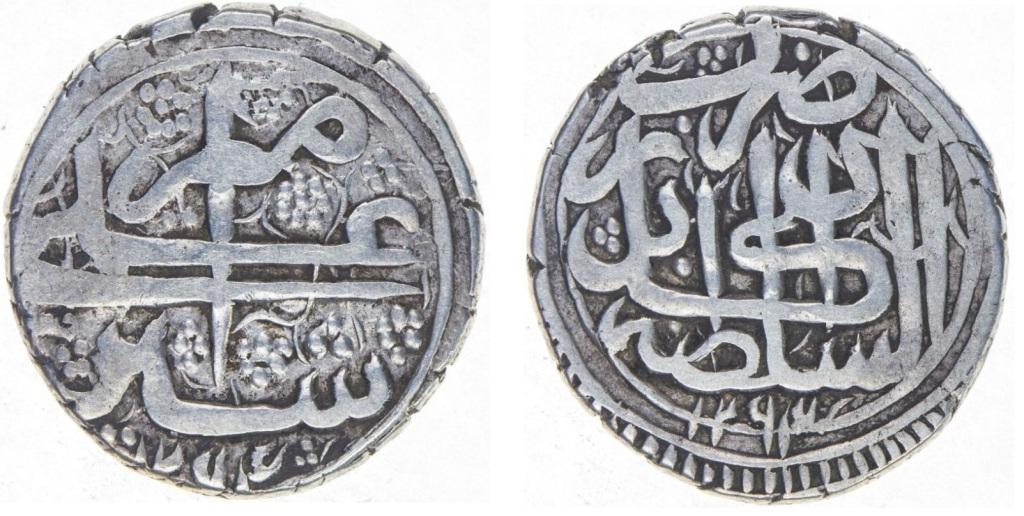 |
KM#519 Rupee.
Year: AH 1294 (1877). Weight:
9.15g. Metal:
0.925 Silver.
Diameter: 23.50 mm. Edge:
Plain. Alignment:
Medal. Mint:
Dar as-Sultanat - Kabul.
Obverse:
"Emir Sher Ali" and
Date at the bottom.
Reverse:
"Zarb Dar as-Sultanat -
Kabul" and Date at the bottom.
Mintage:
N/A.
Minted Years:
AH1287, AH1288, AH1289, AH1290, AH1291, AH1292,
AH1293, AH1294, AH1295, AH1295//1296 and AH1296 (1870-1879).
Ruler: Sher Ali Khan Barakzai
(2nd
time) [third son of Dost Mohammed Khan]
(1868-1879). |
|
 |
KM#521 Rupee.
Year: AH 1294 (1877). Weight:
9.13g. Metal:
0.925 Silver.
Mint:
Dar as-Sultanat - Kabul.
Obverse:
"Ek Rupiya" (One Rupee)
written in the center. "Zarb Dar as-Sultanat - Kabul" written
around. Reverse:
"Emir Sher Ali"
written in the center and Kalima around in circular form.
Mintage:
N/A.
Minted Years:
AH 1293-1295 (1876-1878).
Ruler: Sher Ali Khan Barakzai
(2nd
time) [third son of Dost Mohammed Khan]
(1868-1879).
Coarse style. |
|
| |
|
|
- SADOZAI - A branch of Durrani at Herat (1842-1856).
-
Yar Muhammad Khan
Alikozai
(Herat)...................Mar 1842 -
01 Jun 1851
- Minister-regent at Herat.
He served as Vizier of Herat from 1829 to 1842.
- Sayyed Mohammad Khan Alikozai
(Herat).............01
Jun 1851 - 15 Sep 1855
-
He was son of Yar Muhammad Khan
and minister-regent at Herat. Herat was occupied by Persia (Iran) from 1852 to 1853.
- Muhammad Yusuf Khan
Sadozai (regent at
Herat).....15 Sep
1851 - Jun 1856
|
|
Yar Mohammad Khan:
1842-1851 |
|
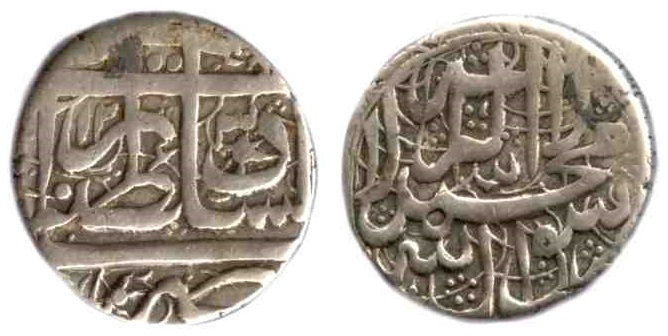 |
KM#405.1
Half Rupee.
Year: AH 1263 (1847). Weight:
5.24g. Metal:
0.925 Silver.
Diameter: 19.00 mm.
Edge:
Plain. Alignment:
almost Medal. Mint:
Herat. Obverse:
Zarb Dar as-Sultanat - Herat. Reverse:
Shahada "Kalimah.
Mintage:
N/A.
Minted Years: AH
1260-1266 (1844-1850). Ruler:
Yar Mohammad Khan (Alikozai) Sadozai
[minister-regent at Herat]
(1842-1851). |
|
Sayyed Mohammad Khan:
1851-1855 |
|
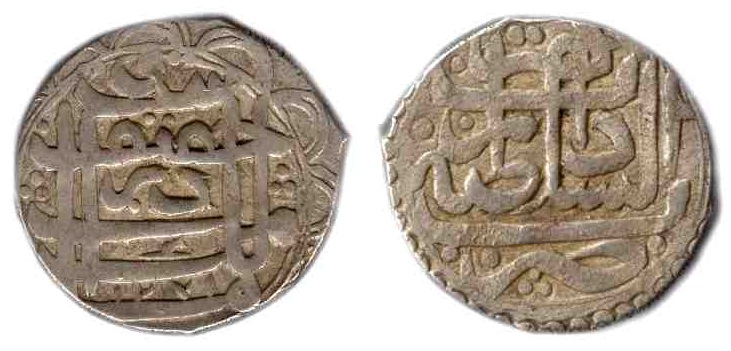 |
KM#407 Qiran (Half Rupee).
Year: AH 1271 (1855). Weight: 5.20g. Metal:
0.925 Silver.
Diameter: 19.00 mm. Edge:
Plain. Alignment:
Medal. Mint in square:
Dar as-Sultanat -
Herat.
Mintage:
N/A.
Mint Years: One year type.
Ruler: Sayyed Mohammad Khan Alikozai
[minister-regent at Herat]
(1851-1855).
Scarce type. |
|
|
|
|
|
- To Great
Britain........................................1878 - 1880
-
Second Anglo-Afghan War: After tension
between Russia and Britain in Europe ended with the June
1878 Congress of Berlin, Russia turned its attention to
Central Asia. That same summer, Russia sent an uninvited
diplomatic mission to Kabul. Sher Ali tried, but failed, to
keep them out. Russian envoys arrived in Kabul on 22 July
1878 and on 14 August, the British demanded that Sher Ali
accept a British mission too. The amir not only refused to
receive a British mission but threatened to stop it if it
were dispatched. Lord Lytton, the viceroy, ordered a
diplomatic mission to set out for Kabul in September 1878
but the mission was turned back as it approached the eastern
entrance of the Khyber Pass, triggering the Second
Anglo-Afghan War. A British force of about 40,000 fighting
men was distributed into military columns which penetrated
Afghanistan at three different points. An alarmed Sher Ali
attempted to appeal in person to the tsar for assistance,
but unable to do so, he returned to Mazari Sharif, where he
died on 21 February 1879.
With British forces occupying much of the country, Sher
Ali's son and successor, Mohammad Yaqub Khan, signed the
Treaty of Gandamak in May 1879 to prevent a British invasion
of the rest of the country. According to this agreement and
in return for an annual subsidy and vague assurances of
assistance in case of foreign aggression, Yaqub relinquished
control of Afghan foreign affairs to the British. British
representatives were installed in Kabul and other locations,
British control was extended to the Khyber and Michni
passes, and Afghanistan ceded various frontier areas and
Quetta to Britain. The British army then withdrew. Soon
afterwards, an uprising in Kabul led to the slaughter of
Britain’s Resident in Kabul, Sir Pierre Cavagnari and his
guards and staff on 3 September 1879, provoking the second
phase of the Second Afghan War. Major General Sir Frederick
Roberts led the Kabul Field Force over the Shutargardan Pass
into central Afghanistan, defeated the Afghan Army at Char
Asiab on 6 October 1879 and occupied Kabul. Ghazi Mohammad
Jan Khan Wardak staged an uprising and attacked British
forces near Kabul in the Siege of the Sherpur Cantonment in
December 1879, but his defeat there resulted in the collapse
of this rebellion.
Yaqub Khan, suspected of complicity in the massacre of
Cavagnari and his staff, was obliged to abdicate. The
British considered a number of possible political
settlements, including partitioning Afghanistan between
multiple rulers or placing Yaqub's brother Ayyub Khan on the
throne, but ultimately decided to install his cousin Abdur
Rahman Khan as emir instead. Ayyub Khan, who had been
serving as governor of Herat, rose in revolt, defeated a
British detachment at the Battle of Maiwand in July 1880 and
besieged Kandahar. Roberts then led the main British force
from Kabul and decisively defeated Ayyub Khan in September
at the Battle of Kandahar, bringing his rebellion to an end.
Abdur Rahman had confirmed the Treaty of Gandamak, leaving
the British in control of the territories ceded by Yaqub
Khan and ensuring British control of Afghanistan's foreign
policy in exchange for protection and a subsidy. Abandoning
the provocative policy of maintaining a British resident in
Kabul, but having achieved all their other objectives, the
British withdrew.
|
- Uzbek Khanate of
Badakhshan
- Capital in
Fayzabad.
Mir Yari
Beg............................................1657 - 1708
Sulaiman
Beg............................................1708 - 1713
Yusuf
Ali...............................................1713 - 1718
Diya'
ad-Din............................................1718 - 1730
Mir Nabat...............................................1730
- ?
Mirza Kalan
I............................................. ? - 1748
Mir Sultan Shah
I.......................................1748 - 1765
Burhan
ad-Din...........................................1765 - ?
Mirza Kalan II
Ahmad Shah Khan
Mirza Kalan III
Zaman
ad-Din............................................. ? - 1792
Mir Mohammed
Shah......................................1792 - 1822
Tributary to Qonduz....................................1822
- 1859
- Mirza Kalan
IV....................................1822 - 1828
- Mirza Abd al-Ghaful...............................1828
- 1829
- Murad
Beg.........................................1829 - 1832
- Mirza Sulaiman....................................1832
- 1838
- Sultan Shah
II....................................1838 - 1847 with...
Tributary to
Afghanistan...............................1859 - 1873
- Mir Shah Nizam
ad-Din.............................1844 - ?
- Jan
Khan..........................................1847 - 1848
- Shah Ghahan..............................................1848
- Saman
ad-Din......................................1848 - 1864
- Ghahandar Shah (1st
time).........................1864
- 1867 d. 1869
- Mir Mohammed
Shah.................................1867 - 1868
- Mizrab
Shah..............................................1868
- Ghahandar Shah (2nd
time).........................1868
- 1869
- Mahmud
Shah.......................................1869 - 1873
- Shah Zade Hasan...................................1873
- 1880
- Alim
Khan.........................................1880 - 1881
|
|
Civic / Civil war /
Anonymous Copper Coins of Afghanistan |
| |
|
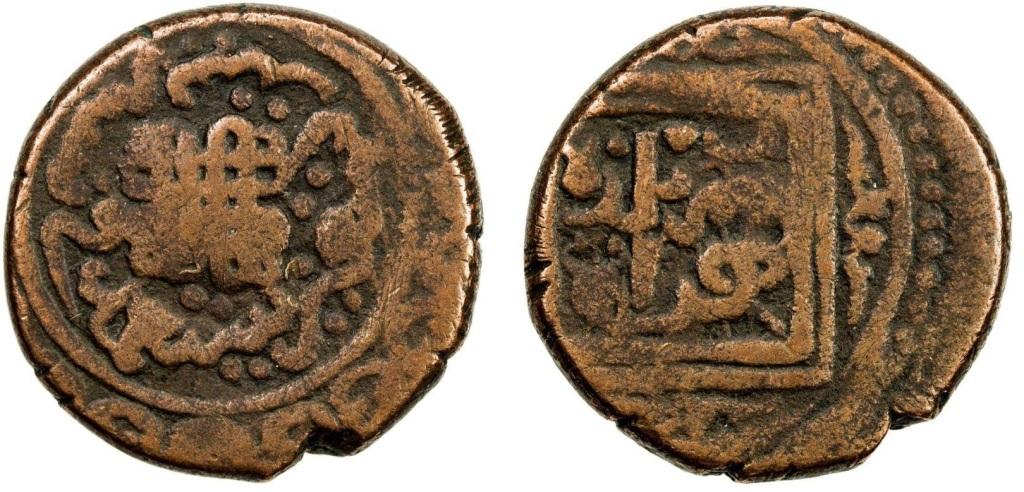 |
SA# 3186 Civic Copper Falus. Date:
AH796 (1394). Weight:
8.96g.
Metal: Copper.
Diameter:
21.50 mm. Alignment:
Rotated (1 o' clock). Mint:
Herat (Harât).
Obverse: Date in
words around an ornate knot. Reverse:
"baldat harât" written in double square.
Mintage:
N/A.
Type: Very rare.
Struck at Herat during the reign of the Timurid founder Timur.
Note: Purchase from Stephen Album
Auction No. 34 (Auction Date: May 23-26, 2019), Lot No. 979
(249094). |
|
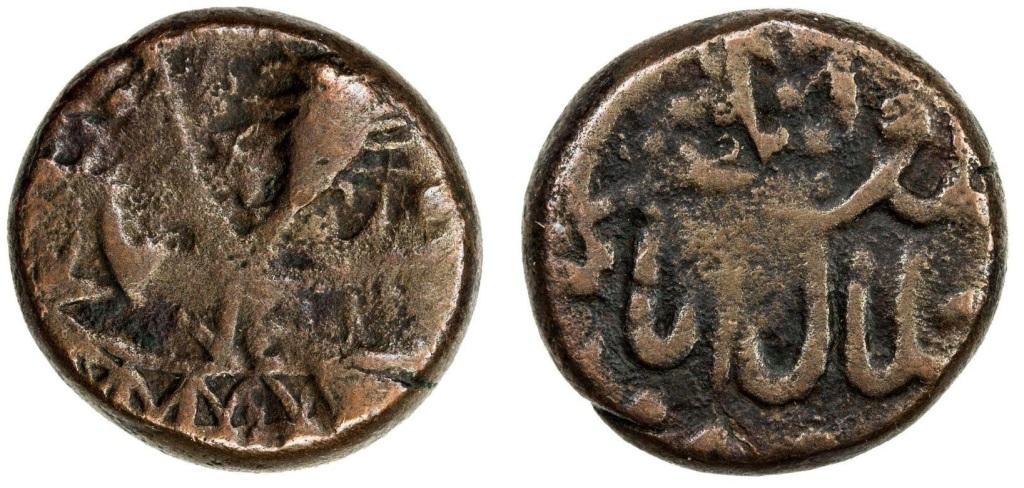 |
SA# 3238 Civic Copper Falus. Date:
ND. Weight:
8.35g.
Metal: Copper.
Diameter:
18.00 mm. Alignment:
Coin. Mint:
Jalalabad.
Obverse: Ornate
floral design. Reverse:
"... Jalalabad" written in calligraphic style.
Mintage:
N/A.
Type: Very rare.
Above average details for this mint. Purchase from Stephen Album
Auction No. 34 (Auction Date: May 23-26, 2019), Lot No. 981
(249095). |
|
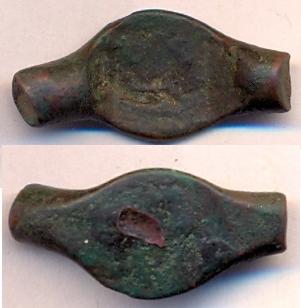 |
MM#2014 Central Asia "Bar" Fals with
Arabic stamped inscription.
Weight: 3.00g.
Metal: Copper.
Length: 24.00 mm.
Mintage:
N/A.
These irregular copper coins emanating from
Central Asia and normally procured in Afghanistan and have not yet been
attributed to a particular issuing dynasty or locality.
This coin is numbered as 2014 in "Oriental
Coins and their values - The World of Islam" by Michael Mitchiner,
Hawkins publication 1977 at page# 287. |
|
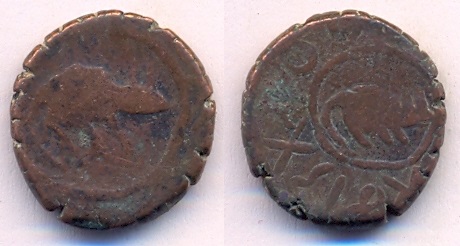 |
Anonymous Fulus.
Date:
ND (1689-1696). Weight: 5.07g.
Metal: Copper.
Diameter:
17.50 mm. Alignment:
Medal. Mint:
Herat. Obverse:
Rodent facing right in the center circle.
Reverse:
Rat facing right in the center circle surrounded by unknown
alphabets. Mintage:
N/A.
Note: Perhaps issued by Abdullah
Khan Abdali, who served as Persian governor of Herat 1695-1708.
Later he became Shah of Herat 1709-1712. |
|
-Type1.jpg) |
Civic Copper Falus. Date:
ND (1680-1700). Weight:
7.86g.
Metal: Copper.
Diameter:
26.00 mm x 24.00 mm. Alignment:
Medal. Mint:
Qandahar Siege issue.
Obverse: "Falus
Zarb
Qandahar" written within the center circle. Dots surrounds outside
the center circle. Reverse:
Two fish circling a star, within the center
circle. Dots surrounds outside the center circle.
Mintage:
N/A. This coin
has a single turn / fold of copper sheet and can easily be seen from
the edge. |
|
-Type2.jpg) |
Same as above coin, but in Brown color.
Weight:
9.09g.
Diameter:
23.00 mm x 22.00 mm. Alignment:
Medal.
This coin has three turns / folds of copper sheet and can easily
be seen from the edge. |
|
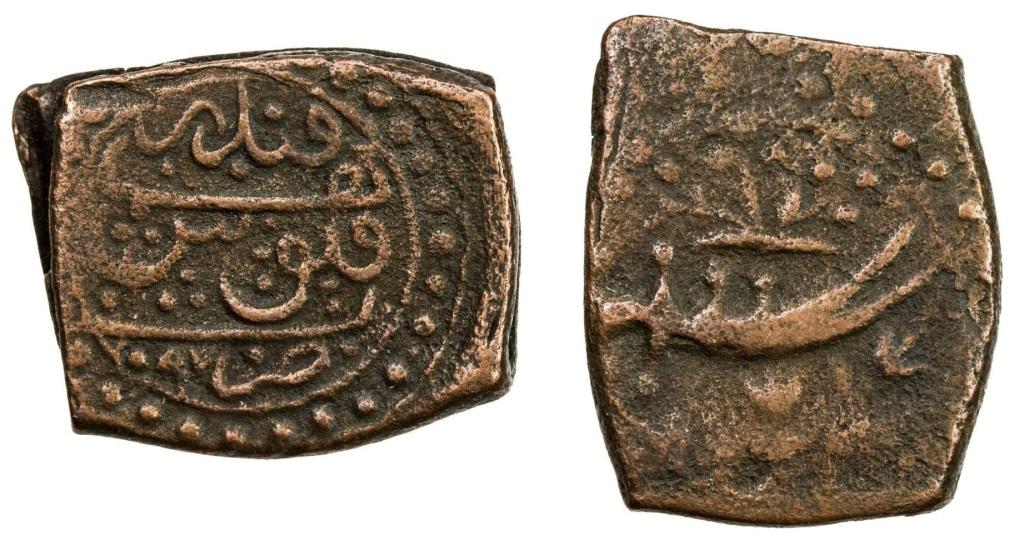 |
SA#3253 Civic Copper Falus.
Date:
AH1097 (1686).
Weight:
8.46g.
Metal: Copper.
Diameter:
22.50 mm x 18.75 mm.
Alignment:
Rotated (3 o' clock). Mint:
Qandahar.
Obverse: "Falus
Zarb Qandahar" with Date at the bottom left side, written within the
center circle. Dots surrounds outside the center circle.
Reverse:
Double-bladed sword (called zulfiqar in
Arabic) pointing right in the center. Floral designed above
and below the sword. Dots surrounds outside the center circle.
Mintage:
N/A. Type:
Very rare. |
|
Note: Same as above coin design but
having double blade sword instead of two fish. This coin
has a single turn / fold of copper sheet and can easily be seen from
the edge. Purchase from Stephen Album Auction No. 34 (Auction Date:
May 23-26, 2019), Lot No. 982 (249107). |
|
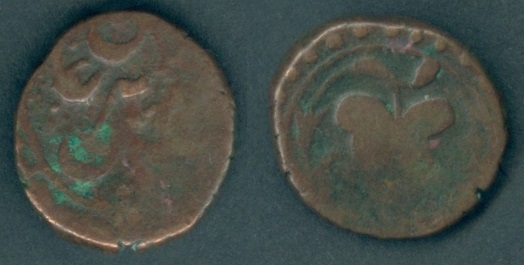 |
Anonymous Fulus.
Date:
ND (1800s). Weight:
8.05g.
Metal: Copper.
Diameter:
20.00 mm. Alignment:
Rotated (1 o' clock). Mint:
Tashqurghan.
Mintage:
N/A. Obverse: "ضرب
تاشقورغان" (zarb Tashqurghan). Reverse:
Flower with stem design in the center within
dotted circle. |
Note: Kholm or Khulm, also known as
Tashqurghan, is a town until recently, in Samangan Province, and now
in Balkh Province of northern Afghanistan 60 km east of
Mazar-i-Sharif one-third of the way to Konduz. Kholm is an ancient
town located on the fertile, inland delta fan of the Khulm River (Darya-i-
Tashqurghan). As such, it is an agriculturally rich locale and
densely populated. It is famous for its covered market, and is a
centre for trading in sheep and wool. The town is slightly to the
south of the ruins of the ancient town of Aornos, destroyed in the
mid-16th century.
The town and district boast a Dari Persian speaking Tajik majority.
Pashtuns, Uzbeks and Arabs form the smaller minorities in the town
and district. Many identify themselves as ethnic Arabs although no
one actually speaks Arabic. There are other such Persian-speaking
"Arabs" to the west, between Mazar-i Sharif and Sheberghan. There
are also such Persian and Pashto-speaking Arabs to the east and
south in Kunduz and Jalalabad.
Tashqurghan was founded early in the 19th century and grew to become
the most important town in northern Afghanistan. A large variety of
industrial products and commodities were transported by camel
caravans: weapons, knives, metal thread, needles, glass, mirrors,
porcelain, paper, tea, cotton and silk cloth. Most of these products
were produced in the European part of Russia, some originated from
Russian Turkestan. From India all kinds of locally manufactured and
British industrial products went the other way: binoculars, razor
blades, indigo, spices, ivory, coconuts and brocades. Afghanistan
contributed to this trade with wool, raw silk, fruits, vegetable
dyes and horses.
In the 2nd quarter of the 19th century it first belonged to the
rather large independent Kunduz state. Then in 1841 the capital of
the Kunduz state shifted to Tashqurghan. However, in 1845 most of
the state seceded under the leadership of Kunduz. So, Tashqurghan
remained the capital of a small independent state.
During the first decades of the twentieth century Tashqurghan
gradually lost its position as the emporium of northern Afghanistan.
Mazar-e Sharif and Kunduz, better positioned for crossing the Amu
Darya river, took over and the caravan traffic stopped. Although
Tashqurghan had lost its importance as a centre for international
trade, local craftsmen and refugees from Soviet Central Asia, (most
of them being craftsmen as well) reinforced the position of
Tashqurghan as a centre for the production of all kinds of objects
for daily use throughout the country. In the 1960s the asphalted
road between Kabul and Mazar-e Sharif was completed. The 350
kilometres between the two cities could now be covered in 8–9 hours
(instead of the previous two weeks travel). The number of foreign
and domestic tourists visiting Tashqurghan increased considerably.
Apart from larger numbers of individual visitors, organized tours
started arriving. A large number of antiques shops were opened for
the visitors.
During the 1970s Tashqurghan was declared a 'town of art-historical
significance' by UNESCO, while the Tim, the centre of the ancient
bazaar, was declared a national monument by the Afghan government.
After the Soviet invasion the bazaar has been attacked on several
occasions but in 1986 it was completely destroyed in reprisal
attacks by the Soviet Army. |
|
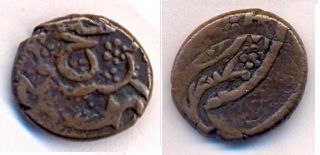 |
Anonymous Fulus.
Weight: 5.26g.
Metal: Copper.
Diameter:
16.15 mm x 18.00 mm. Alignment:
Coin. Mint: Balkh.
Mintage:
N/A.
Not listed in Krause publication. |
|
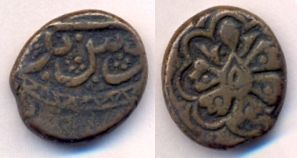 |
Anonymous Fulus.
Weight: 5.90g.
Metal: Copper.
Diameter:
17.50 mm x 18.50 mm. Alignment:
Medal. Mintage:
N/A.
Not listed in Krause publication. |
|
 |
KM#35
Falus.
Year: AH 1267 (1851).
Mint: Balkh.
Weight: 9.20g.
Metal: Copper.
Alignment:
Medal. Obverse:
"Zarb Balkh" with Date.
Reverse: Tiger walking towards right. Diameter:
20.00 mm. Mintage:
N/A.
Minted Years:
One year type. |
|
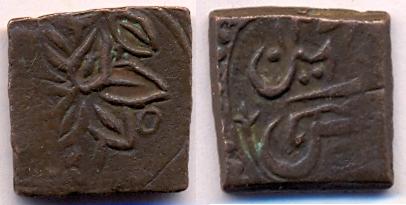 |
Anonymous Fulus.
Year: AH 1271 (1854).
Weight: 4.16g.
Metal: Copper.
Diameter: 15.00 x 15.00
mm. Alignment:
Medal. Mint:
probably Ghazni. Mintage:
N/A.
Not listed in Krause publication. |
|
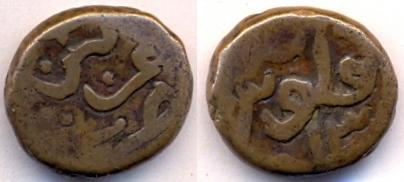 |
KM#39 Fulus.
Year: ND (ca. 1860-1880).
Mint: Ghazni.
Weight: 4.56g.
Metal: Copper.
Alignment:
Coin. Diameter:
16.00 mm. Obverse:
"Zarb GHazni".
Reverse:
"Falus" with Date. Mintage:
N/A.
Minted Years:
One year type. |
|
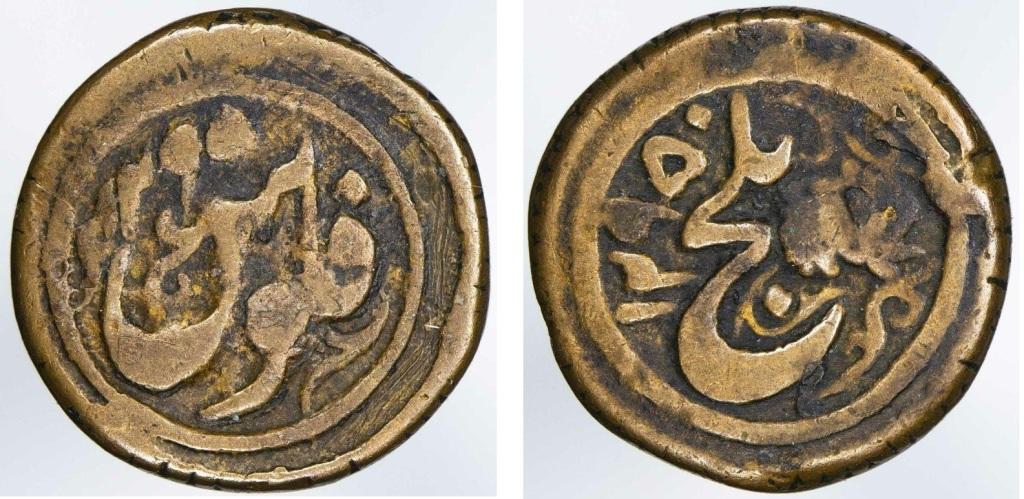 |
Tübingen SNA 1052-1055 Fulus.
Year: AH 1295 (1878).
Mint: Balkh.
Weight: 6.15g.
Metal: Copper.
Alignment: Rotated (2
o' clock). Diameter:
18.50 mm. Obverse:
"Falus" with Date, surrounded by
curved lines design; all within circle.
Reverse:
Flower design in the center. "Balkh" with Date, surrounded by
curved lines design; all within circle. Mintage:
N/A.
Minted Years:
One year type.
Note:
Issued during Second Anglo-Afghan War. |
|
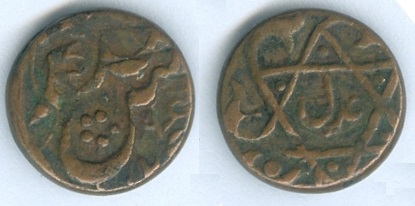 |
KM#95 Fulus.
Year: AH 1296 (1879).
Mint: Qandahar.
Weight: 3.74g.
Metal: Copper.
Alignment: Rotated (7
o' clock). Diameter:
15.50 mm. Obverse:
"Falus Zarb Qandahar" with Date.
Reverse:
"Adl" (justice) written in hexagram. Mintage:
N/A.
Minted Years:
One year type.
Note:
Issued during Second Anglo-Afghan War. |
|
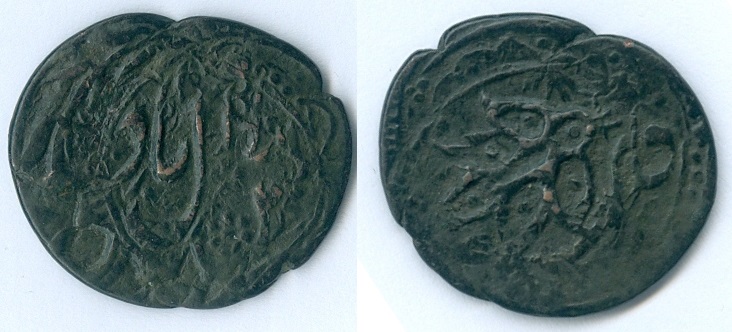 |
KM#52 / SA# 3239 Fulus.
Year: AH 1297 (1880).
Mint: Jalalabad.
Weight: 7.25g.
Metal: Copper.
Alignment: Medal. Diameter:
28.00 mm x 24.50 mm. Obverse:
"Falus Jalalabad" with Date.
Reverse: Six petal Large flower. Mintage:
N/A.
Minted Years:
One year type.
Note:
Issued during Second Anglo-Afghan War. Crudely overstruck on earlier
types therefore, several varieties exist. |
|
| |
02 Oct 1881
State of Afghanistan
09 Jun 1926
Kingdom of Afghanistan
17 Jul 1973
Republic of Afghanistan
30 Apr 1978
Democratic Republic of Afghanistan
30 Nov 1987
Republic of Afghanistan
28 Apr 1992
Islamic State of Afghanistan
26 Oct 1997
Islamic Emirate of Afghanistan
13 Nov 2001
Islamic State of Afghanistan
19 Jun 2002
Transitional Islamic State of Afghanistan
26 Jan 2004
Islamic Republic of Afghanistan |
| |
- BARAKZAI
(Emirs - Mohammadzai segment)-
Muhammad Yaqub Khan Mohammadzai..................21 Feb 1879 - 12
Oct 1879
-
Known as unified Emir of
Aghan (Balkh, Herat, Kabul & Qandahar). He also severed as the governor of
Herat from 1871 to 1874 under his father, Sher Ali Khan's rule.
- Mohammad Jan (minister-regent
at Kabul).................1879 - 31
Mar 1880
- Musa Jan Khan Mohammadzai (Ghazni)...............24 Dec 1879 - 21
Apr 1880
- Muhammad Ayyub Khan
Mohammadzai.....................Mar 1880 - 02 Oct 1881
- Ruled Herat & Qandahar. Qandahar
briefly from
20 Jul 1881 to 22 Sep 1881.
- Wali Sher Ali (Qandahar)................................1879
- 1880
- Wali Muhammad (Kabul)..........................................1880
- Sher Ali Khan Barakzai (minister-regent at Qandahar)....1880 -
21 Apr 1881
- Abdur Rahman Khan Mohammadzai....................22 Jul 1880 - 03 Oct 1901
- Ruled Qandahar briefly from
21 Apr 1881 to 20 Jul 1881 and then ruled Qandahar again from 22 Sep 1881.
- Timur Shah (Herat).............................................1887
- Muhammad Ishaq (rebel at Balkh
& Kabul)........................1889
-
Habibullah Khan ibn Abdur Rehman Khan............03 Oct 1901 - 20 Feb 1919
-
Nasrullah Khan ibn Abdur Rehman Khan.............21 Feb 1919 - 28 Feb 1919
d.1921
-
Amanullah Khan ibn Habibullah Khan...............28 Feb 1919 - 09 Jun 1926
- Amanullah Khan was 3rd son of Habibullah Khan. He helped assassinate his father. As the governor of Kabul and was in control
of the army and the treasury. He quickly seized power, imprisoned any
relatives with competing claims to the Kingship, and gained the allegiance
of most of the tribal leaders. Amanullah's ten years of reign initiated a period of
dramatic change in Afghanistan in both foreign and domestic politics. He
declared full independence and sparked the Third Anglo-Afghan War. Britain
virtually dictated the terms of the 1919 Rawalpindi Agreement, a temporary
armistice that provided, somewhat ambiguously, for Afghan self-determination
in foreign affairs. Before final negotiations were concluded in 1921,
however, Afghanistan had already begun to establish its own foreign policy,
including diplomatic relations with the new government in the Soviet Union
in 1919. During the 1920s, Afghanistan established diplomatic relations with
most major countries.
-
BARAKZAI -
Kings - Mohammadzai segment
- Amanullah Shah (Continued
as King)...............09 Jun 1926 -
14 Jan 1929 d.1960
- Inayatullah Shah ibn Habibullah Khan.............14 Jan 1929 - 17 Jan 1929
d.1946
- Emir
- Habibullah [Kalakani] Ghazi......................17 Jan 1929 - 13 Oct 1929
-
He named himself Habibullah
'Khadem e Deen e Rasulullah' (The servant of the religion of messenger of
God). Habibullah succeeded Inayatullah, who abdicated on January 17, 1929.
As an ethnic Tajik, he was and is considered an usurper by the Pashtuns of
Afghanistan, since he interrupted the Pashtun Barakzai Dynasty (which
resumed upon his death). Among the Pashtuns, as a derogatory term he is
commonly referred to as "Bacha-ye Saqqow" or "Bachchayi
Saqqa" (in Persian "son of the water-carrier") because his father was at one
point a water-carrier in the Afghan army. Among the Tajiks, however, he is
still remembered and respected as a rightful king. Additionally, he is also
celebrated by the famous poet Khalilollah Khalili in his masterpiece Hero of
Khorasan. After nine months in power, Nader Shah's troops surrounded Kabul
and took over. Kalakani and his brother and aides were shot by a firing
squad on 01 November 1929. His remains were laid below a hilltop mausoleum
at an undisclosed location for 87 years, until a campaign in 2016 by some
Tajiks and scholars who wanted him to be reburied in a better place.
Persians and religious scholars, who consider Kalakani to have been a devout
Muslim, wanted him to be buried at the Shahrara hill and asked President
Ashraf Ghani to plan a state burial. Opponents to Kalakani, mostly Pashtuns
and secularists, were against this plan, including vice-president Abdul
Rashid Dostum who claimed that he could not be buried at a hilltop important
to Uzbek heritage. He was eventually buried at the hill on 02 September
2016, with four injuries and one death in clashes between his supporters and
pro-Dostum soldiers.
- BARAKZAI
(Emirs - Mohammadzai segment)
-
Amanullah Shah (in rebellion, at
Qandahar).......21 Jan 1929 - 23 May 1929
- Sardar Ali Ahmad Khan............................28
Jan 1929 - 15 Jul 1929
- in rebellion at Jalalabad
till 29 Mar 1929, then continue rebellion at Qandahar
- Mohammad Nadir Khan (in rebellion, at Khost)............1929 - 17 Oct 1929
- BARAKZAI
(Kings - Mohammadzai segment)
- Mohammad Nadir Shah (Continued
as King)..........17 Oct 1929 - 08 Nov 1933
- Mohammed Nadir Khan was born in Dehra Dun (north
of Delhi), India, on April 09, 1883 to Sardar Mohammad Yusuf Khan and his first wife Sharaf Sultana. His paternal grandfather was Yahya Khan and his great
grandfather was Sultan Muhammad Khan Telai, the brother of Dost Mohammed
Khan, who sold Peshawar to the Sikhs.
Mohammad Nadir Shahs's great grandfather Mohammad Yahya Khan was
responsible for the mediation between Yaqub Khan and the British leading to
the Gandamak Treaty. After the British invasion following the killing of Sir
Louis Cavagnari in 1879, Yaqub Khan and Yahya Khan were seized by the
British and transferred under custody to India, where they forcibly remained
until invited back to Afghanistan by Emir Abdur Rahman Khan in the last year
of his reign in 1901.-
Mohammad Zahir Shah ibn Mohammad
Nadir Shah.....08 Nov 1933 - 17 Jul 1973
d.2007
- He was ousted in a coup by his cousin Mohammed
Daoud Khan while in Italy undergoing eye surgery.
|
| |
|
Wali Sher Ali
coinage at Qandahar: 1879-1880. |
| |
|
 |
KM#221 Rupee.
Year: AH 1297 (1880).
Weight:
5.41g. Metal:
0.800 Silver.
Diameter:
18.50 mm. Edge:
Plain. Alignment:
Rotated. Mint:
Qandahar. Obverse:
"Al-Mulk Lillah" (Kingship belongs
to Allah) with Date 1297 at the bottom. Reverse:
"Zarb Qandahar" with Date 1297 at the bottom.
Mintage:
N/A.
Minted Years:
One year type. Ruler:
Wali Sher Ali
(at Qandahar 1879-1880). |
| Note:
It is not known under whose
authority this type was struck as no ruler's name is mentioned on
the coin. Anyhow this coin is listed under ruler: Wali Sher Ali in
Krause Publications. Some coin experts believe that it is perhaps
issued by British authority. |
|
| |
|
Wali Muhammad coinage at Kabul: 1880. |
| |
|
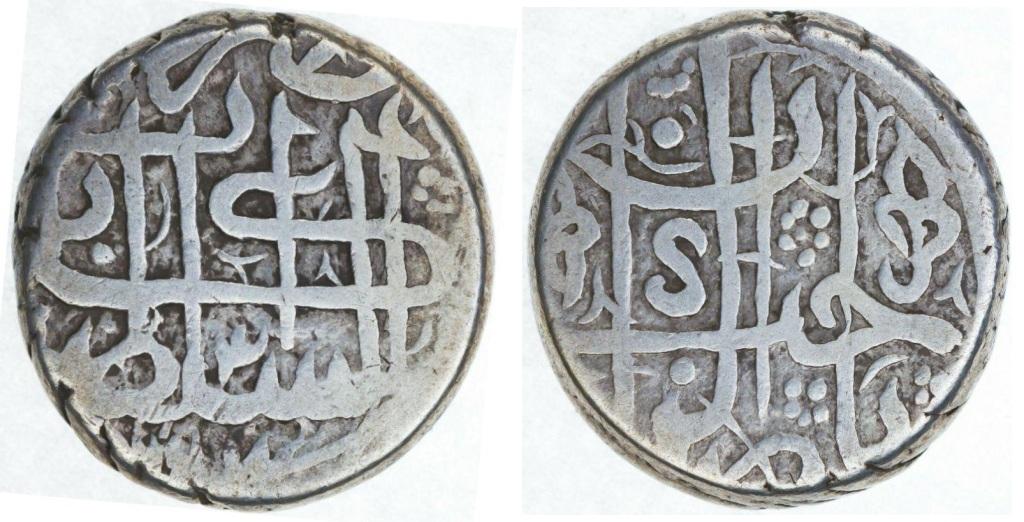 |
KM#538 / SA#3176 Rupee.
Year: AH 1297 (1880).
Weight:
9.13g. Metal:
0.800 Silver.
Diameter:
18.00 mm. Edge:
Plain. Alignment:
Medal. Mint:
Kabul. Obverse:
"Zarb Dar es-Sultanate Kabul" with Date
"1297" at the bottom. Reverse:
"Ya Sabeb uz-Zaman" (O Master of Time).
Date "1297" at the bottom.
Mintage:
N/A.
Minted Years:
One year type. Ruler:
Wali Muhammad
(at Kabul in 1880). |
|
| |
|
Muhammad Yaqub Khan
coinage: 1879-1880. |
| |
|
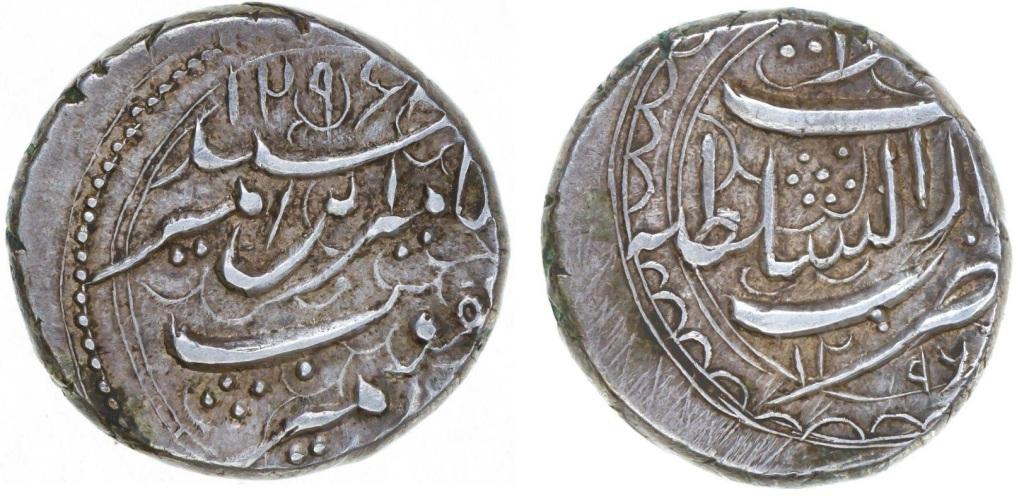 |
KM#417 Half Rupee.
Year: AH 1296 (1879).
Weight:
4.55g. Metal:
0.800 Silver.
Diameter:
16.50 mm. Edge:
Plain. Alignment:
Rotated (3 o' clock). Mint:
Dar as-Sultanat - Herat. Obverse:
Date at the top.
Reverse:
Dar as-Sultanat - Herat. Date at the bottom.
Mintage:
N/A.
Minted Years: AH
1296-1298 (1879-1880). Same date on both sides. Ruler: Muhammad Yaqub Khan Barakzai ibn Sher Ali Khan
(1879). |
|
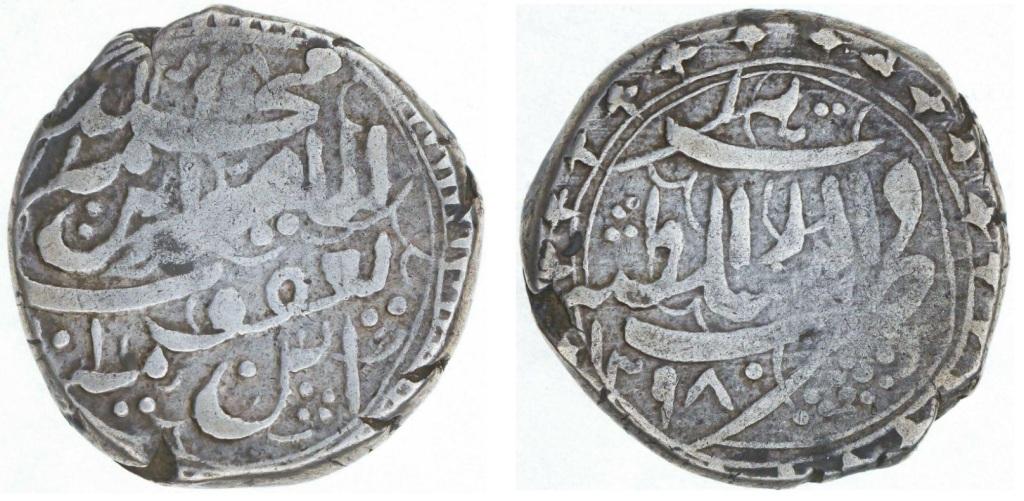 |
Same as above coin KM#417 Half Rupee,
but...
Year: AH 1298 (1880).
Weight:
5.52g. Diameter:
17.50 mm. Edge:
Plain. Alignment:
Rotated (1 o' clock). |
|
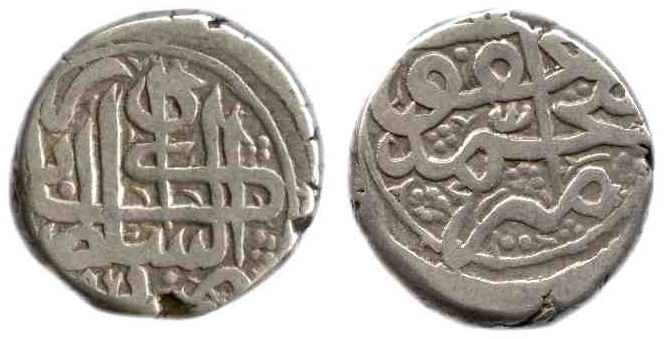 |
KM#533 Rupee.
Year: AH 1296 (1879).
Weight:
9.04g. Metal:
0.800 Silver.
Diameter:
18.00 mm. Edge:
Plain. Alignment:
almost Coin. Mint:
Dar as-Sultanat - Kabul. Obverse:
Dar as-Sultanat - Kabul.
Reverse: Emir
Muhammad Yaqub. Mintage:
N/A.
Minted Years: AH
1296-1297 (1879). Ruler: Muhammad Yaqub Khan Barakzai ibn Sher Ali Khan
(1879). AH1297 dated coins are
reported, but not confirmed. |
|
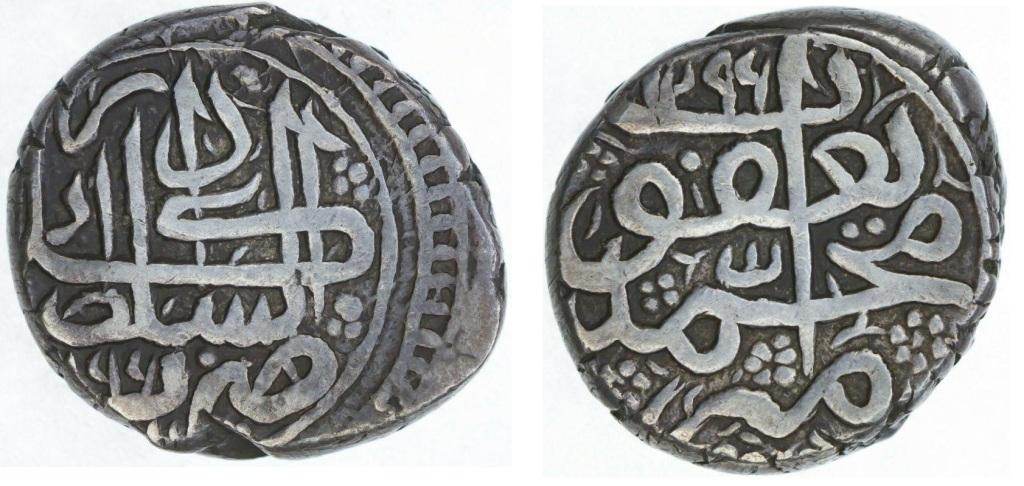 |
Same as above coin but font size and design slightly differ.
Weight:
9.20g. Metal:
0.800 Silver.
Diameter:
19.75 mm. Alignment:
Coin.
Mintage:
N/A. |
|
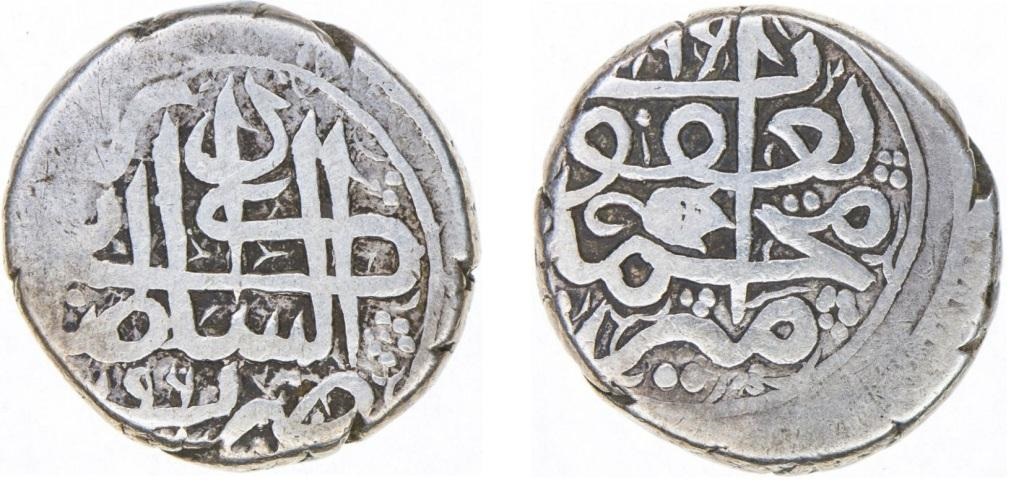 |
Same as above coin, but having mouse like image in the center of
Reverse side. Date AH 1296 (1879)
visible on both sides.
Weight:
9.12g. Metal:
0.800 Silver.
Diameter:
20.00 mm. Alignment:
Rotated (3 o'clock).
Mintage:
N/A. |
|
| |
|
Abdur Rahman Khan
coinage: 1880 - 1901 |
| |
|
 |
KM#419 Qiran
(Half Rupee).
Year: AH 1304 (1886).
Weight: 4.56g.
Metal: Silver.
Diameter:
16.50 mm. Mint:
Herat. Edge:
Plain. Alignment:
Coin.
Obverse:
"Emir Abdur Rahman" with Date.
Reverse:
"Zarb Dar as-Sultanat - Herat" with Date.
Mintage:
N/A.
Minted Years:
AH1297, AH1298, AH1299, AH1300, AH1301,
AH1302, AH1303, AH1304, AH1305, AH1306, AH1307//1306, AH1307,
AH1308//1307 and AH1308 (1880-1890). Ruler:
Abdur Rahman Khan. |
|
Note: Many coins of this type
KM#419 are found with blundered dates. Such coins are worth the same
as normal dates. Mulings of dates exist. |
|
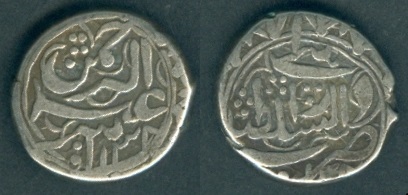 |
Same as above coin, but...
Year: AH 1308 (1890).
Weight: 4.53g.
Diameter:
15.50 mm. Edge:
Plain.
Alignment:
Coin. Mintage:
N/A. |
|
 |
KM#544.1 Rupee.
Year: AH 1307 (1890).
Weight: 8.98g.
Metal: 0.800 Silver.
Diameter:
21.00 mm. Mint:
Kabul. Edge:
Plain.
Alignment: Medal, but
slightly rotated.
Obverse: "Emir Abdur Rahman" with date
written at the bottom left side. Reverse:
Dar as-Sultanat - Kabul.
Mintage:
N/A.
Minted Years:
AH1297, AH1298, AH1299, AH1300, AH1301, AH1302,
AH1303, AH1304, AH1305, AH1306, AH1307 and AH1308 (1880-1890).
Ruler:
Emir Abdur Rahman Khan ibn Muhammad Afzal Khan ibn Dost
Muhammad Khan.
|
|
Note: Date AH1297 has been
observed struck over an British India 1876 1/4 Rupee, probably a mint
sport. |
|
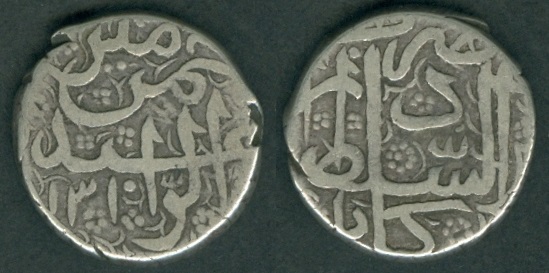 |
Same as above coin KM#544.1 Rupee,
but...
Year: AH 1310 (1892).
Weight: 9.07g.
Alignment: Medal, but
slightly rotated. Mintage:
N/A. |
|
| |
| Monetary standard: [Kabuli] Rupee = 2 Qiran = 3 Abbasi = 6
Sanar = 12 Shahi = 60 Paise = 600 Dinar. (Tilla or Amani = 10 Kabuli Rupee;
Habibi = 30 Rupees). |
| |
|
 |
KM#802 1 paisa.
Year: AH 1309 (1892). Weight: 3.83g.
Metal: Bronze Or
Brass.
Diameter:
21.00 mm. Mint:
Kabul. Edge:
Plain.
Alignment: Medal.
Obverse: Date below
text denomination (one paisa) below the Mosque gate. Reverse:
"Dar as-Sultanat - Kabul" written in the
dotted circle, surrounded by circular design.
Mintage:
N/A.
Minted Years: AH1309,
AH1312-1314 and AH1316-1317.
Ruler: Abdur Rahman Khan.
Note:
Date on the left side below the Value and
above wreath. |
|
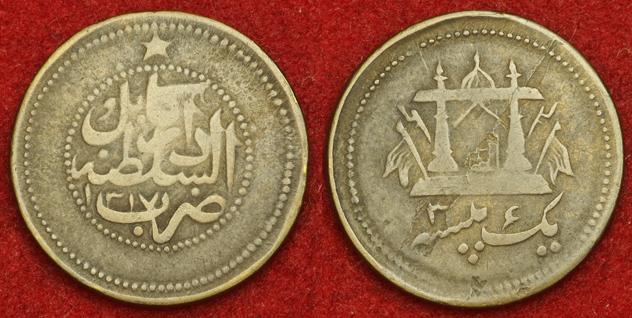 |
KM#827 1
paisa.
Year: AH 1317 (1899). Weight:
4.62g.
Metal: Bronze Or
Brass.
Diameter:
20.50 mm. Mint:
Kabul. Edge:
Plain.
Alignment: Medal;
slightly rotated.
Obverse: Star at the
top. "Dar as-Sultanat - Kabul" with Date at the
bottom within inner dotted circle. Dotted circle near the border.
Reverse:
Denomination (one paisa) below the Mosque gate.
Mintage:
N/A.
Minted Years:
One year type.
Ruler: Abdur Rahman
Khan. |
|
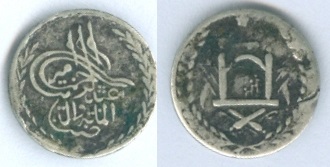 |
KM#823 Sanar.
Year: ND (1898). Weight: 1.50g
[1.55g].
Metal: 0.500 Silver.
Diameter:
12.50 mm. Mint:
Kabul. Edge:
Rotated (2 o' clock).
Alignment: Medal.
Obverse: Toughra of Abdur Rahman
Khan.
Reverse:
Mosque gate in the center with crossed cannons
below it. Wreath on both sides with knot at the bottom. Mintage:
N/A.
Minted Years: AH1315
(1897) and without Date (1898).
Ruler: Abdur Rahman Khan. |
|
 |
KM#824 Sanar.
Year: AH 1315 (1897). Weight: 1.53g
[1.55g].
Metal: 0.500 Silver.
Diameter:
12.50 mm. Mint:
Kabul. Edge:
Reeded.
Alignment: Medal.
Obverse: "Kabul"
written at the top. Mosque gate in the center. Date below the gate.
Wreath on both sides with knot at the bottom.
Reverse: Toughra of Abdur Rahman
Khan.
Mintage:
N/A.
Minted Years: One
year type.
Ruler: Abdur Rahman Khan. |
|
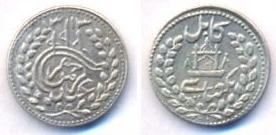 |
KM#810 Abbasi.
Year: AH 1313 (1895). Weight: 3.07g
[3.11g].
Metal: 0.500 Silver.
Diameter:
15.50 mm. Mint:
Kabul. Edge:
Reeded.
Alignment: Medal.
Obverse: Date above toughra.
Mintage:
N/A.
Minted Years: One year type.
Ruler: Abdur Rahman Khan.
Similar coin with date AH 1313 also
exists as KM#811, having date below mosque on reverse side.
|
|
 |
Same as above coin but thick legends on Reverse side.
Weight: 3.00g
[3.11g]. Mintage:
N/A. |
|
 |
Same as above coin but rotated as
shown. Weight:
3.07g. Mintage:
N/A. |
|
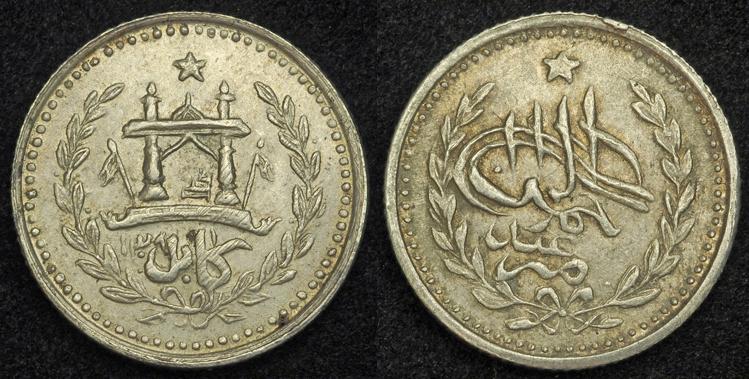 |
KM#804 Half Rupee.
Year: AH 1308 (1891).
Weight: 4.59g [4.65g].
Metal: 0.500 Silver.
Diameter:
18.00 mm. Mint:
Kabul. Edge: Reeded.
Alignment: Medal.
Obverse:
Star above mosque. "Kabul" written below Mosque
gate and Date. Mintage:
N/A.
Minted Years:
AH 1308-1310 (1890-1892).
Ruler:
Abdur Rahman Khan. |
|
 |
KM#806 Rupee.
Year: AH 1311 (1893).
Weight: 9.18g [9.20g].
Metal: 0.900 Silver.
Diameter:
23.00 mm. Mint:
Kabul. Edge: Reeded.
Alignment: Medal.
Obverse:
Star above mosque. "Kabul" written below Mosque
gate and Date. Mintage:
N/A.
Minted Years:
AH 1308-1313, AH1311/09, AH1312/1/9, AH1312/1 and
AH1391 Error. Ruler:
Abdur Rahman Khan. Note: Two varieties
each are known for dates AH1311-1313. |
|
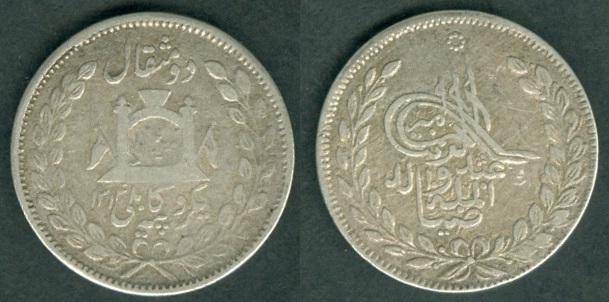 |
KM#818 Kabuli Rupee.
Year: AH 1314 (1896).
Weight: 9.06g
[9.20g].
Metal: 0.900 Silver.
Diameter:
23.50 mm. Mint:
Kabul. Edge: Reeded.
Alignment: Medal.
Obverse:
"Do Mashkal" written above the Mosque
gate. "Ek Rupiya Kabuli" with Date written below the mosque gate. Wreath
surrounds on both sides. Reverse:
Small dotted circle at the top. Toughra in the
center surrounded by wreath on both sides.
Mintage: N/A.
Minted Years:
One year type. Ruler:
Abdur Rahman Khan. |
|
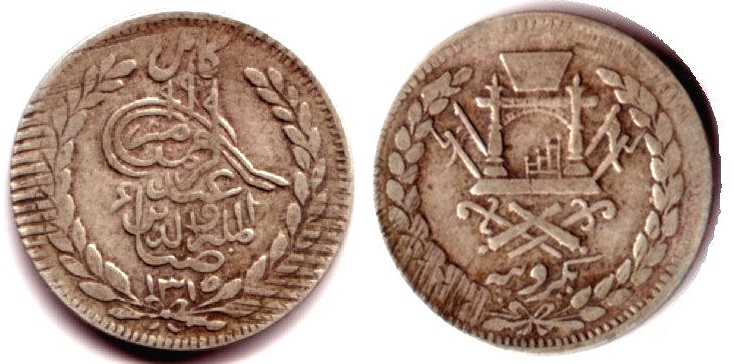 |
KM#819.1 Rupee.
Year: AH 1315 (1897).
Weight: 9.10g.
Metal: 0.500 Silver.
Edge: Reeded.
Diameter:
24.50 mm. Mint:
Kabul. Alignment: Medal.
Obverse: Kabul
above toughra, undivided dates. Reverse:
Mosque in the center with crossed swords and
cannons below it. Wreath on both sides.
Mintage:
N/A.
Minted Years:
AH 1314-1315. Ruler:
Emir Abdur Rahman Khan ibn Muhammad Afzal Khan ibn Dost
Muhammad Khan.
Divided dates; two digits on opposite sides of toughra exists as KM#819.2 in year AH 1315-1316.
|
|
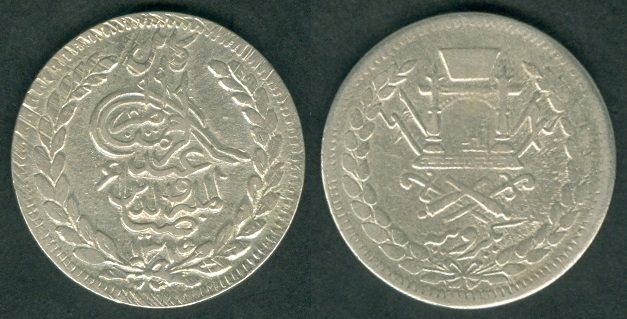 |
Same as above coin, but thicker details on Obverse side.
Weight: 9.22g.
Diameter:
24.50 mm. |
|
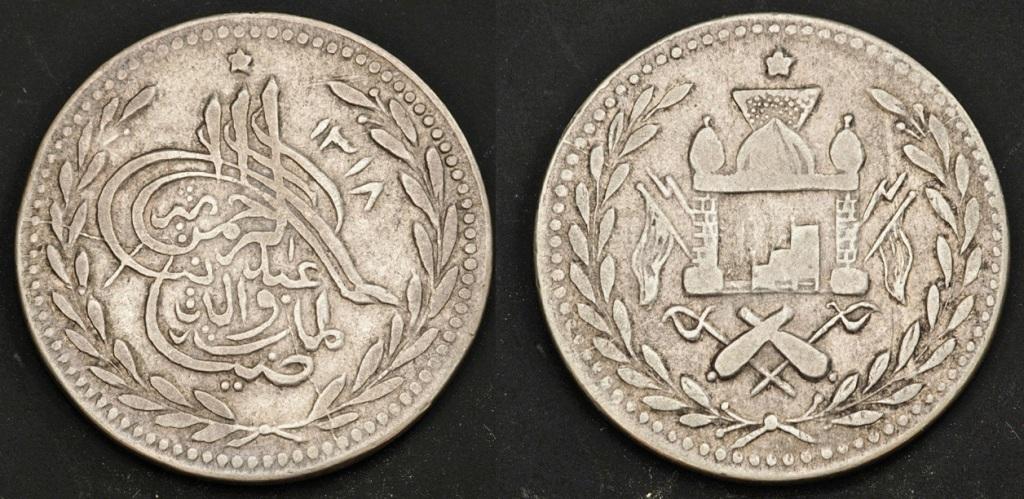 |
KM#830 Rupee.
Year: AH 1318 (1900).
Weight: 9.10g.
Metal: 0.500 Silver.
Diameter:
24.50 mm. Edge:
Reeded.
Alignment: Medal.
Obverse: Date on
right side of toughra. Reverse:
Star at the top. Stylish Mosque in the center with
crossed swords and cannons below it. Wreath on both sides.
Ruler:
Emir Abdur Rahman Khan ibn Muhammad Afzal Khan ibn
Dost Muhammad Khan. Mintage:
N/A.
Minted Years:
One year type. |
|
 |
| KM#826 5 Kabuli Rupee.
Year: AH 1316 - RY3
(1898). Weight:
45.70g. Metal:
.900 Silver. Edge:
Reeded. Alignment:
Medal. Ruler:
Abdur Rahman Khan.
Mintage:
N/A.
Minted Years:
One year type. |
|
| |
|
Habibullah Khan
coinage: 1901-1919. |
Habibullah Khan (June 3, 1872 –
February 20, 1919) was the Emir of Afghanistan from 1901 until 1919. He was
born in Samarkand, Uzbekistan, the eldest son of the Emir Abdur Rahman Khan,
whom he succeeded by right of primogeniture in October 1901.
Habibullah was a relatively reform-minded ruler who attempted to modernize
his country. During his reign he worked to bring modern medicine and other
technology to Afghanistan. In 1903, Habibullah founded the Habibia school as
well as a military academy. He also worked to put in place progressive
reforms in his country. He instituted various legal reforms and repealed
many of the harshest criminal penalties. But one of his chief advisers Abdul
Lateef was sentenced to death in 1903 for apostasy. He was stoned to death
in Kabul. Other reforms included the dismantling of the repressive internal
intelligence organization that had been put in place by his father.
He strictly maintained the country's neutrality in World War I, despite
strenuous efforts by the Sultan of the Ottoman Empire and a German military
mission (Niedermayer–Hentig Expedition) to enlist Afghanistan on its side.
He also greatly reduced tensions with British India, signing a treaty of
friendship in 1905 and paying an official state visit in 1907.
Habibullah was assassinated while on a hunting trip at Laghman Province on
February 20, 1919. His assassination was carried out by Mustafa Seghir, an
Indian spy, employed by Britain. Seghir was again hired by Britain to
assassinate Mustafa Kemal Ataturk. He was arrested in Ankara and confessed
that he received a regular salary from the British. He was hanged till
death. Habibullah's brother Nasrullah Khan briefly succeeded him as Emir and
held power for a week between February 21 and February 28, 1919, before
being ousted and imprisoned by Amanullah Khan, Habibullah's third son. |
| |
|
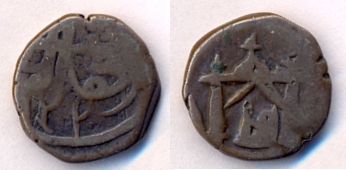 |
KM#960.1 Paisa (Local Dump Coinage).
Year: AH 1322 (1903). Weight:
6.29g. Metal: Copper.
Diameter:
19.00 mm. Mint: Qandahar.
Mintage:
N/A.
Minted Years:
One year type. Ruler: Emir Habibullah Khan ibn
Emir Abdur Rahman Khan (1901-1919). |
|
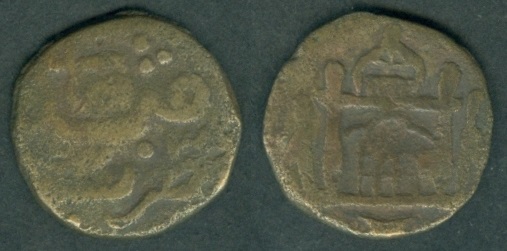 |
KM#964 Paisa (Local Dump Coinage).
Year: AH xxx3 = 1333 (1914). Weight:
3.50g. Metal: Copper.
Diameter:
19.00 mm.
Edge:
Plain.
Alignment: Medal.
Mint: Qandahar.
Obverse:
"Zarb Qandahar" with Date.
Reverse:
Mosque.
Mintage:
N/A.
Minted Years:
AH1333 (1914) and AH1334 (1915). Ruler: Emir Habibullah Khan ibn
Emir Abdur Rahman Khan (1901-1919). |
|
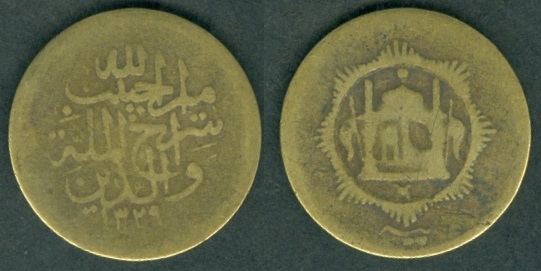 |
KM#849 Paisa.
Year: AH 1329 (1911).
Weight: 4.73g.
Metal: Brass.
Diameter:
21.50 mm. Mint:
Afghanistan. Edge:
Plain.
Alignment: Medal.
Obverse:
"سراج الملة والدین
امیرحبیب الله" (Seraj al-Mulya wa'l Din Emir Habibullah)
written in center. Date at the bottom. Reverse: Mosque
within 8-pointed star. Mintage:
N/A.
Minted Years:
AH1329 (1911), AH1331 (1912) and AH1332
(1913). Ruler:
Emir Habibullah Khan
ibn Emir Abdur Rahman Khan (1901-1919). |
|
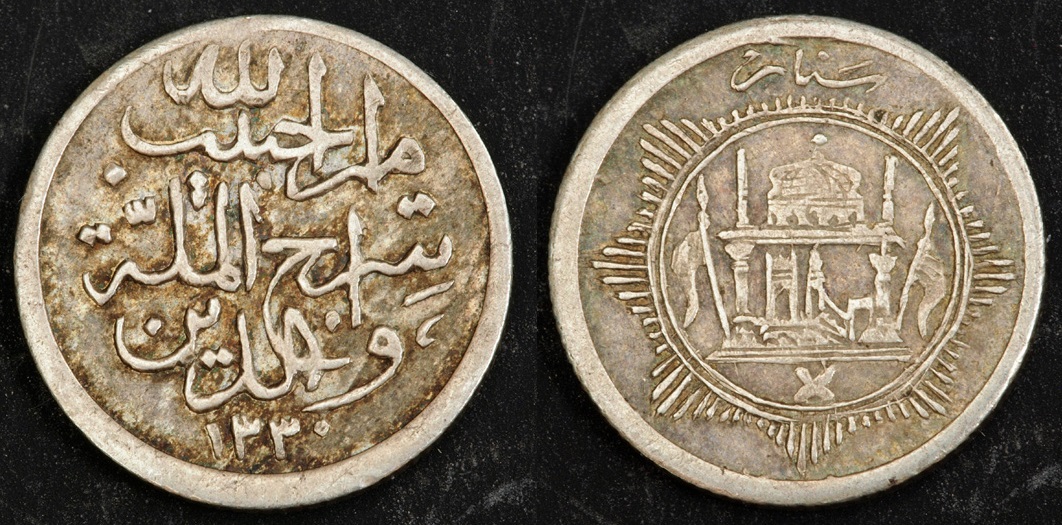 |
KM#850 Sanar
(10 paisa).
Year: AH 1330 (1911).
Weight: 1.48g [1.55g].
Metal: 0.500 Silver.
Diameter:
13.00 mm. Edge:
Plain.
Alignment: Medal.
Mint:
Afghanistan.
Obverse:
"سراج الملة والدین
امیرحبیب الله" (Seraj al-Mulya wa'l Din Emir Habibullah)
written in center. Date written at the bottom. |
|
Reverse:
Value "Sanar" written at the top. Mosque within
7-pointed star, all within circle.
Mintage:
N/A.
Minted Years:
AH1329 (1911), AH1330 (1911), AH1331 (1912),
AH1332 (1913), AH1333 (1914), AH1335 (1916) and AH1337 (1918).
Ruler:
Emir Habibullah Khan
ibn Emir Abdur Rahman Khan (1901-1919).
Note:
Coins dated AH1333 and
1337 are known in two varieties. |
|
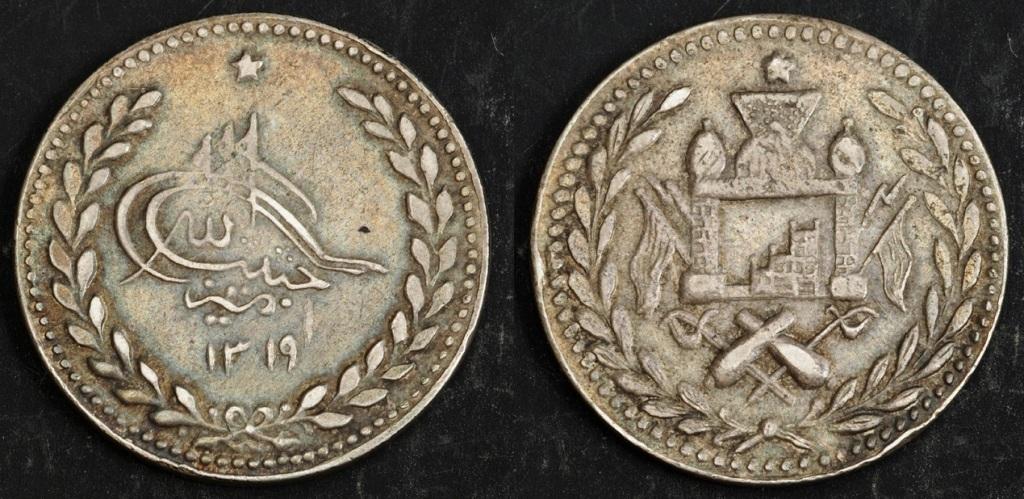 |
KM#832 Rupee.
Year: AH 1319 (1901).
Weight: 9.12g [9.20g].
Metal: 0.500 Silver.
Diameter:
24.50 mm. Edge: Reeded.
Alignment: Medal.
Mint:
Afghanistan. Obverse:
Star at the top. Toughra in the center: "Amir
Habibullah". Wreath on both sides joining at the bottom. Date above
wreath knot. |
|
Reverse: "Afghanistan"
written above mosque. Wreath on both sides. Crossed swords
and cannons at the bottom. Mintage:
N/A.
Minted Years:
One year type (Two varieties are known). Ruler:
Emir Habibullah Khan
ibn Emir Abdur Rahman Khan (1901-1919). |
|
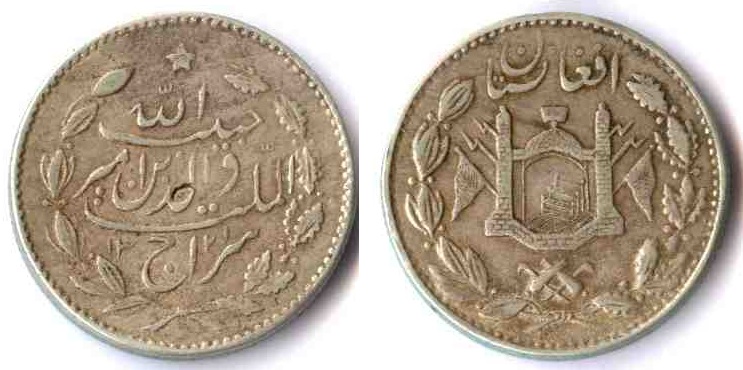 |
KM#842.1 Rupee.
Year: AH 1321 (1903).
Weight: 9.11g [9.20g].
Metal: 0.500 Silver.
Diameter:
24.50 mm. Edge: Reeded.
Alignment: Medal.
Mint:
Afghanistan.
Obverse:
Star at the top. "سراج الملة والدین
امیرحبیب الله" (Seraj al-Mulya wa'l Din Emir Habibullah)
written in center. Star at the top. Date written within the last
word at the bottom. Wreath on both sides with knot at the bottom. |
|
Reverse: "Afghanistan"
written above mosque. Wreath on both sides. Crossed swords
and cannons at the bottom. Mintage:
N/A.
Minted Years:
AH 1321-1322 (1903-1904). Ruler:
Emir Habibullah Khan
ibn Emir Abdur Rahman Khan (1901-1919).
Note:
Two
varieties exists for AH 1321 date. |
|
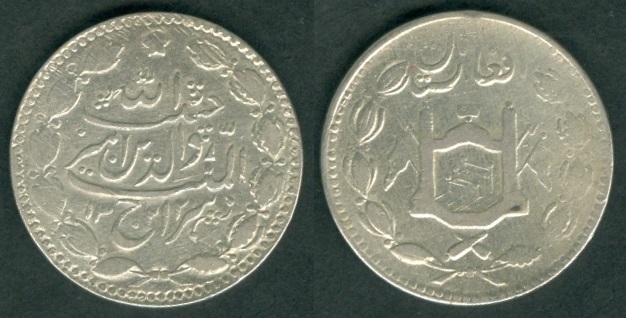 |
KM#842.2 Rupee.
Year: AH 1322 (1904).
Weight: 9.16g.
Metal: 0.500 Silver.
Diameter:
24.50 mm. Edge: Reeded.
Alignment: Medal.
Mint:
Afghanistan.
Obverse:
Star at the top. "سراج الملة والدین
امیرحبیب الله" (Seraj al-Mulya wa'l Din Emir Habibullah)
written in center. Date written within the last word at the bottom.
Wreath on both sides with knot at the bottom. |
|
Reverse: "Afghanistan"
written above mosque. Wreath on both sides. Crossed cannons at the bottom.
Mintage:
N/A.
Minted Years:
AH1322 (1904), AH1324 (1906), AH1325 (1907),
AH1326//3 (1908), AH1327//6 (1909), AH1327 (1909), AH1328 (1910) and
AH1329 (1911). Ruler:
Emir Habibullah Khan
ibn Emir Abdur Rahman Khan (1901-1919).
Note:
Two varieties exist for
AH1328 date. |
|
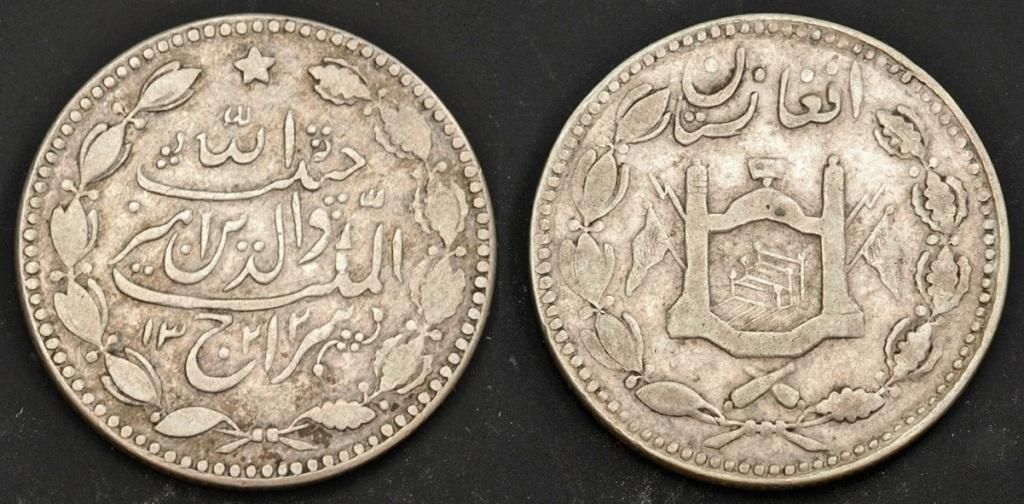 |
Same as above coin, but having minor difference like the
position of the baseline of both pillars.
Weight: 9.15g. |
|
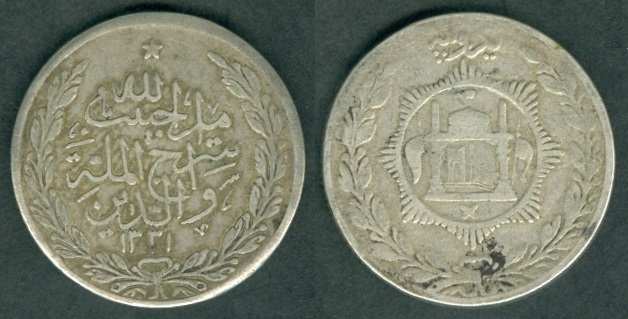 |
KM#853 Rupee.
Year: AH 1331 (1912).
Weight: 9.04g [9.20g].
Metal: 0.500 Silver.
Diameter:
24.50 mm. Edge: Reeded.
Alignment: Medal.
Mint:
Afghanistan.
Obverse:
Star at the top. "سراج الملة والدین
امیرحبیب الله" (Seraj al-Mulya wa'l Din Emir Habibullah)
written in center. Date written within the last word at the bottom.
Wreath on both sides with knot at the bottom. |
|
Reverse:
Value "Ek Rupiya" written at the top. Mosque within
8-pointed star, all within circle. Wreath on both sides.
Mintage:
N/A.
Minted Years:
AH1329 (1911), AH1330 (1911), AH1331/0 (1912),
AH1331 (1912), AH1332 (1913), AH1333 (1914), AH1334 (1915), AH1335
(1916) and AH1337 (1918). Ruler:
Emir Habibullah Khan
ibn Emir Abdur Rahman Khan (1901-1919).
Note:
Two varieties of the AH1337
date exist, with either crossed cannons or a six-pointed star below
the mosque. |
|
 |
Same as above coin KM#853
Rupee, but...
Year: AH 1333 (1914).
Weight: 9.11g [9.20g].
Diameter:
25.00 mm. |
|
 |
|
KM#843
5 Rupees.
Year: AH 1326 (1908).
Weight: 45.53g [45.60g].
Metal: 0.900 Silver.
Diameter:
45.00 mm. Edge: Reeded.
Alignment: Medal;
slightly rotated. Mint:
Afghanistan.
Reverse:
Three stars at the top. "سراج الملة والدین
امیرحبیب الله" (Seraj al-Mulya wa'l Din Emir Habibullah) written in
dotted circle in the center with Date. Wreath on both sides.
Reverse: "افغانستان"
(Afghanistan) with star in between written at the top. Mosque gate
in the center dotted circle. Wreath on both sides.
Mintage:
N/A.
Minted Years:
AH1322 (1904), AH1324 (1906), AH1326 (1908),
AH1327/6 (1909), AH1328 (1910) and AH1329 (1911). Ruler:
Emir Habibullah Khan
ibn Emir Abdur Rahman Khan (1901-1919).
Note:
Most dates are recut
dies. Two varieties are known for each date, AH1324 and AH1327. |
|
| |
|
Amanullah Khan
coinage: 1919-1929 |
| |
|
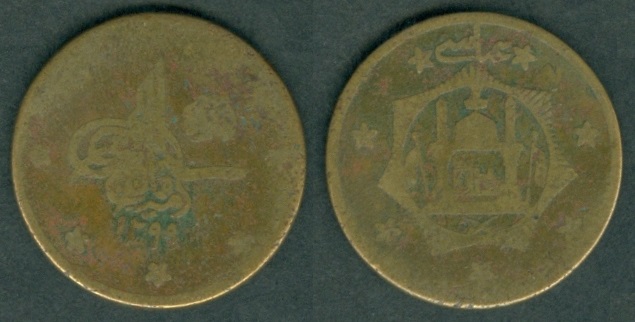 |
KM#883 Abbasi (20
paisa).
Year: SH 1299 (1920). Weight: 6.70g.
Metal: Billon.
Diameter:
25.00 mm. Mint:
Afghanistan. Edge:
Reeded.
Alignment: Medal.
Obverse: Tughra
surrounded by 8
stars. Date below Tughra.
Reverse:
Value "Abbasi" written at the top. Mosque within
7-pointed star, 7 stars surrounds.
Mintage:
N/A.
Minted Years:
SH1299 (1920),
SH1300 (1921), SH1301 (1922) - Two varieties for date SH1301 exist,
SH1302 (1923), SH2031 (1923) Error and SH1303 (1924).
Ruler:
Amanullah Khan ibn Emir Habibullah Khan. |
|
 |
|
KM#881 3 Shahi (15
paisa).
Year: SH 1300 (1921). Weight:
5.97g.
Metal: Copper.
Diameter:
31.50 mm. Mint:
Afghanistan. Edge:
Plain.
Alignment: Medal;
slightly rotated.
Obverse: "al-Ghazi"
written at the top. "Emir Amanullah" written in the center circle.
10 stars surrounds in outer circle.
Reverse: "سہ شاهی"
(Say Shahi) written in Persian at the top. Mosque
within
7-pointed star, all within circle. 10 stars surrounds in outer circle.
Mintage:
N/A.
Minted Years:
SH1298 (1919), SH1299 (1920) and SH1300 (1921).
Ruler:
Amanullah Khan (1919-1926).
Note:
Four varieties for date SH1299 and three
varieties for date SH1300 are known. |
|
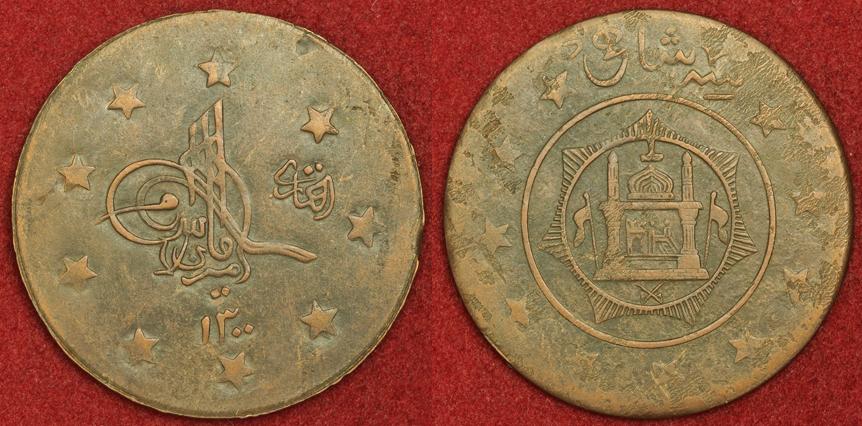 |
|
KM#893 3 Shahi (15
paisa).
Year: SH 1300 (1921). Weight: 6.72g.
Metal: Copper.
Diameter:
32.50 mm. Mint:
Afghanistan. Edge:
Plain.
Alignment: Medal;
slightly rotated.
Obverse: Tughra
surrounded by nine
stars.
Reverse: Mosque
within
7-pointed star, all within circle. 10 stars surrounds.
Mintage:
N/A.
Minted Years:
SH1300 (1921), SH1301 (1922), SH130x (1923) error
and SH1303 (1924). Ruler:
Amanullah Khan (1919-1926).
Note:
Two varieties of SH1301 exist. |
|
 |
KM#965 Half Rupee.
Year: AH 1337 (1919). Weight:
4.71g
[4.75g].
Metal: Silver.
Diameter:
20.50 mm. Mint:
Afghanistan. Edge:
Reeded.
Alignment: Medal.
Obverse: Star at the
top. "Emir Amanullah" written in the center with Date
below it. Wreath on both sides.
Reverse: Value "Neem
Rupiya" written at the top. Mosque
within
8-pointed star. Wreath on both sides.
Mintage:
N/A.
Minted Years:
One year type.
Ruler:
Amanullah Khan ibn Emir Habibullah Khan.
Five varieties are known. |
|
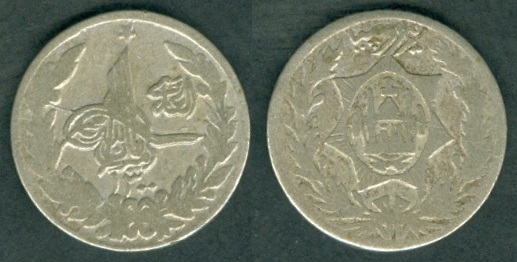 |
KM#984 Half Rupee.
Year: SH 1300 (1921). Weight:
4.60g
[4.75g].
Metal: 0.500 Silver.
Diameter:
20.50 mm. Mint:
Afghanistan. Edge:
Reeded.
Alignment: Medal.
Obverse: Star at the
top. Tughra
surrounded by wreath. Date below Tughra.
Reverse: Value "Neem
Rupiya" written at the top. Mosque
within
7-pointed star. Wreath on both sides.
Mintage:
N/A.
Minted Years:
SH1300 (1921), SH1301 (1922), SH1302 (1923) and
SH1303 (1924).
Ruler:
Amanullah Khan ibn Emir Habibullah Khan. |
|
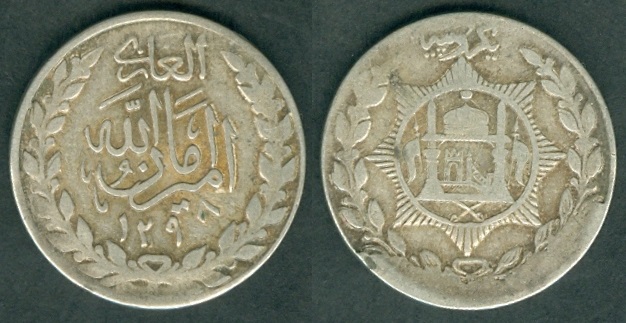 |
KM#877 Rupee.
Year: SH 1298 (1919). Weight:
8.98g
[9.00g].
Metal: 0.900 Silver.
Diameter:
25.00 mm. Mint:
Afghanistan. Edge:
Reeded.
Alignment: Medal.
Obverse: "Al-Ghazi"
written at the top. "Emir Amanullah" written in the center with Date
below it. Wreath on both sides.
Reverse: Value "Ek
Rupiya" written at the top. Mosque
within
8-pointed star. Wreath on both sides.
Mintage:
N/A.
Minted Years:
SH 1298 (1919)
and SH 1299 (1920).
Ruler:
Amanullah Khan ibn Emir Habibullah Khan.
Note:
Four varieties are known
for date SH1298 and Two varieties are known for date SH1299. |
|
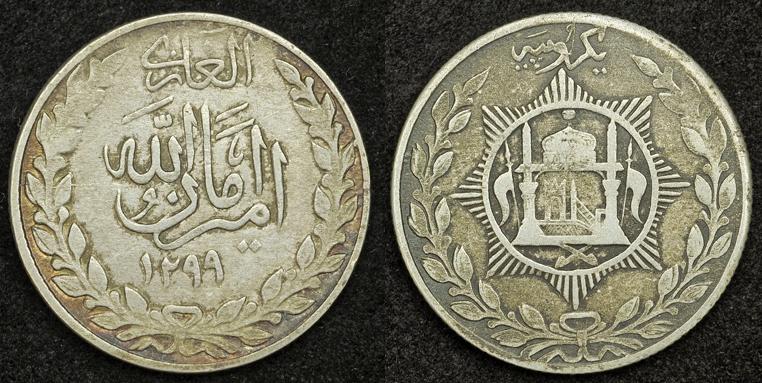 |
Same as above coin KM#877 Rupee,
but...
Year: SH 1299 (1920). Weight: 9.15g
[9.00g]. Mintage:
N/A. |
|
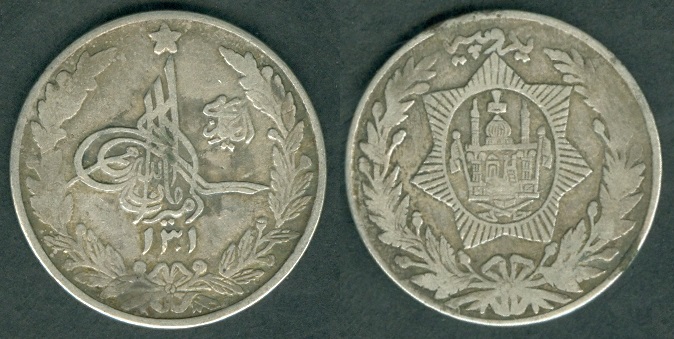 |
|
KM#885 Rupee.
Year: SH 1301 (1922). Weight:
9.08g
[9.00g].
Metal: 0.900 Silver.
Diameter:
26.50 mm. Mint:
Afghanistan. Edge:
Reeded.
Alignment: Medal.
Obverse: Star at the
top. Tughra
surrounded by wreath. Date below Tughra.
Reverse: Value "Ek
Rupiya" written at the top. Mosque
within
7-pointed star. Wreath on both sides.
Mintage:
N/A.
Minted Years:
SH1299 (1920), SH1300 (1921), SH1301 (1922),
SH1302/1 (1923), SH1302 (1923) and SH1303 (1924).
Ruler:
Amanullah Khan ibn Emir Habibullah Khan. |
|
 |
KM#888 2 Amani (20 Rupees).
Year: SH 1299 (1920). Weight:
9.20g. Metal:
0.900 Gold.
Diameter:
24.00 mm. Mint:
Afghanistan. Edge: Reeded.
Obverse: Numeral "2"
at the top. Tughra above date within wreath.
Reverse: "Amania" written at the top.
Mosque within 7-pointed star, wreath surrounds. Alignment: Medal.
Mintage:
N/A.
Minted Years: SH 1299-1303 (1920-1924 CE).
Ruler: Amanullah Khan ibn Emir Habibullah Khan.
|
|
| |
| Monetary standard: Afghani = 100 Pul (Amani
= 20 Afghani). |
| |
|
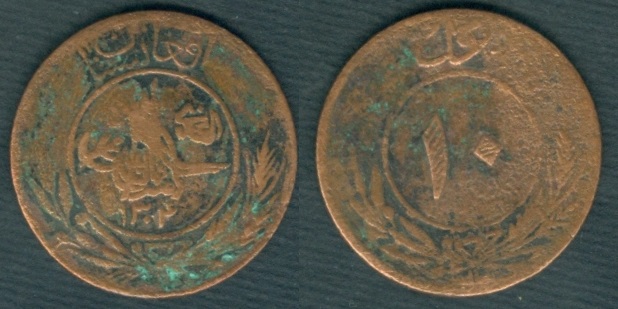 |
KM#907 10 Puls.
Year: SH 1304
(1925). Weight:
5.31g [6.00g]. Metal:
Copper. Diameter:
24.00 mm. Edge:
Reeded.
Alignment: Medal.
Obverse:
"Afghanistan" written at the top. Tughra
above date within center circle. Wreath on both sides.
Reverse:
"Pul" written at the top.
Numeral "10"
written within the center circle. Wreath
at the bottom section.
Mintage:
N/A.
Minted Years:
SH1304 (1925), SH1305 (1926) and SH1306 (1927).
Ruler:
Amanullah Shah ibn Emir Habibullah Khan. |
|
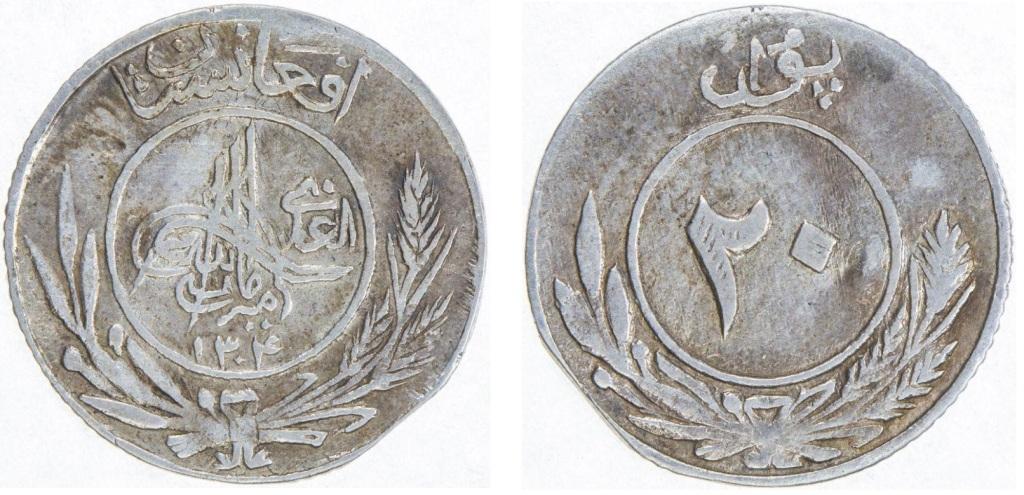 |
KM#908 20 Puls.
Year: SH 1304
(1925). Weight:
1.82g [2.00g]. Metal:
Billion. Diameter:
19.50 mm. Edge:
Reeded.
Alignment: Medal.
Obverse:
"Afghanistan" written at the top. Tughra
above date within center circle. Wreath on both sides.
Reverse:
"Pul" written at the top.
Numeral "20" written within the center circle. Wreath at the
bottom section.
Mintage:
N/A.
Minted Years:
SH1304 (1925) and SH134 (1925) Error. Ruler:
Amanullah Shah ibn Emir Habibullah Khan.
Part of ex-Jewelry. |
|
 |
KM#909 Half Afghani.
Year: SH 1305 - RY8
(1926). Weight:
5.06g [5.00g]. Metal:
0.500 Silver. Diameter:
24.50 mm. Edge:
Reeded.
Alignment: Medal.
Mintage:
N/A.
Minted Years:
SH1304/7 (1925), SH1305/8 (1926) and
SH1306/9 (1927).
Ruler:
Amanullah Shah ibn Emir Habibullah Khan.
Note:
Two varieties are known for date SH1304/7
(1925). |
|
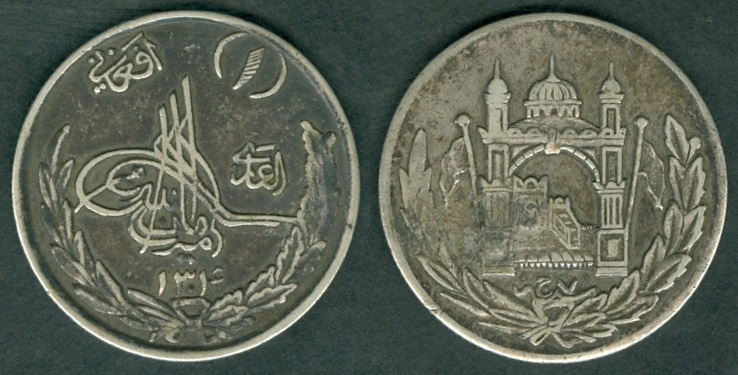 |
KM#910 Afghani.
Year: SH 1304 - RY7
(1925). Weight:
9.90g [10.00g]. Metal:
0.900 Silver. Diameter:
29.50 mm. Edge:
Reeded.
Alignment: Medal.
Mintage:
N/A.
Minted Years:
SH1304/7 (1925), SH1305/8 (1926), SH1305/9 (1926) and SH1306/9
(1927).
Ruler:
Amanullah Shah ibn Emir Habibullah Khan.
Note:
Three varieties are known for date SH1304/7
(1925). |
|
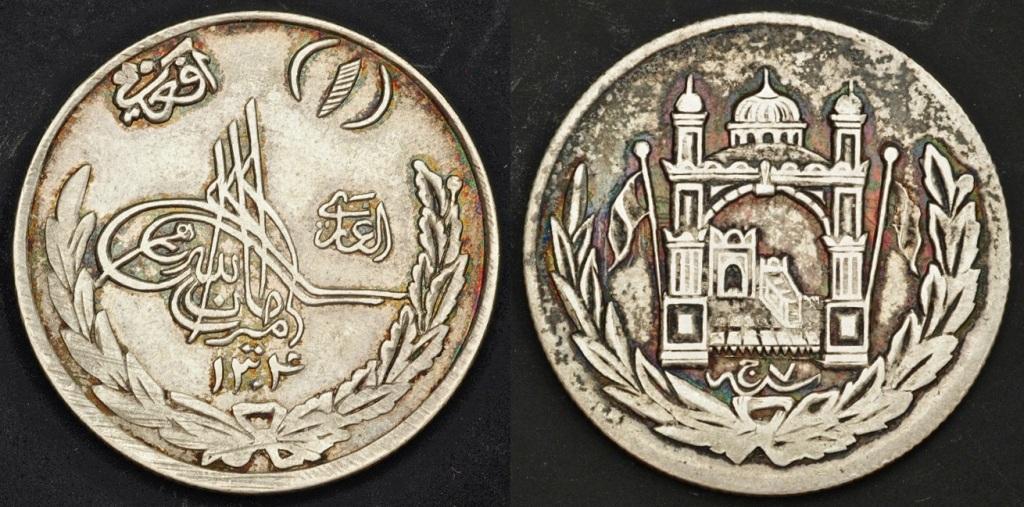 |
Type2: Same as above coin,
but having larger details on the Obverse side (especially thick
"Afghani" written at the top left side). Reignal year a bit far from
the wreath knot on the Reverse side.
Weight:
10.04g. |
|
|
 |
|
KM#913 2.5 Afghani.
Year: SH 1305 - RY8
(1926). Weight:
24.81g [25.00g]. Metal:
.900 Silver. Diameter:
39.00 mm. Edge:
Reeded.
Alignment: Medal.
Mintage:
N/A.
Minted Years: SH
1305//8-1306//9 (1926-1927).
Ruler:
Amanullah Shah ibn Emir Habibullah Khan.
Note:
Two varieties are known for each date. |
|
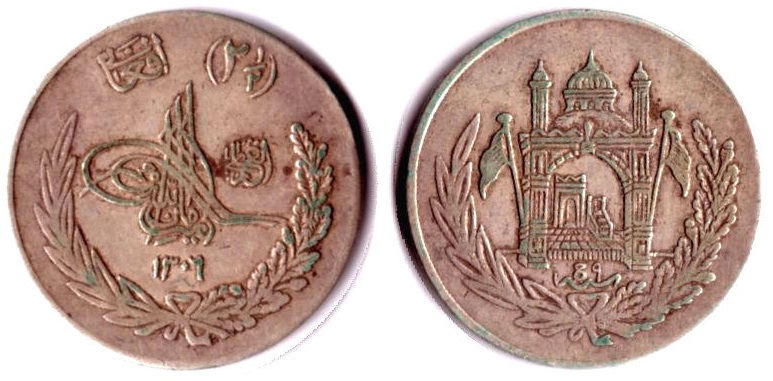 |
|
Same as above coin, but...
Year: SH 1306 - RY9
(1927). Weight:
24.90g [25.00g].
Alignment: Medal;
slightly rotated.
Mintage:
N/A. |
|
 |
|
Type2: Same as above coin with minor
differences. Reverse wreath away from the border.
Weight:
24.84g [25.00g].
Mintage:
N/A. |
|
| |
|
Habibullah [Kalakani]
Ghazi coinage: 1929 |
| Monetary standard: [Kabuli] Rupee = 2 Qiran = 3 Abbasi = 6
Sanar = 12 Shahi = 60 Paise = 600 Dinar. (Tilla = 10 Kabuli Rupee). |
| Note:
He issued his earlier coins in the name of "Baccha-i-Saqao" in AH1347-1348
(1929). |
| |
|
 |
KM#901
10 paisa.
Year: AH 1348
(1929). Weight:
4.09g. Metal:
Copper. Diameter:
21.50 mm. Edge: Reeded.
Alignment: Medal.
Mint:
Afghanistan.
Obverse:
"Les Paise" (10 paisa in Pashto) written on top. Clockwise
in center written: "Khadem e Deen e Rasulullah"
(The servant of the religion of messenger of Allah). "Emir Habibullah"
written in extreme center with date. Wreath below. Reverse:
Da paisa (10 paisa in Persian) on the top. Arms in the center. Wreath below.
Mintage: N/A. Minted Years:
One year type. Ruler:
Habibullah [Kalakani] Ghazi. |
|
 |
KM#895
20 paisa.
Year: AH 1347
(1929). Weight:
6.17g. Metal:
Bronze or Brass. Diameter:
24.00 mm. Edge: Reeded.
Alignment: Medal.
Mint:
Afghanistan.
Obverse:
"Shall Paise" (20 paisa in Pashto) written on top. Bottom to
top in center written: "Khadem e Deen e Rasulullah
Emir Habibullah" (The servant of the religion of messenger of Allah Emir
Habibullah). Date above wreath. Reverse:
Beseat paisa (20 paisa in
Persian) on
the top. Arms in the center. Wreath below.
Mintage: N/A. Minted Years:
One year type. Ruler:
Habibullah [Kalakani] Ghazi. |
|
 |
KM#896
Qiran (1/2 Rupee).
Year: AH 1347
(1929). Weight:
4.44g [4.70g]. Metal:
0.500 Silver. Diameter:
21.00 mm. Edge: Reeded.
Alignment: Medal.
Mint:
Afghanistan.
Obverse:
Star at the top. Bottom to
top in center written: "Khadem e Deen e Rasulullah
Emir Habibullah" (The servant of the religion of messenger of Allah Emir
Habibullah). Date above wreath. Reverse:
Value (Qiran) above mosque
within 8-pointed
star, wreath surrounds.
Mintage: N/A. Minted Years:
One year type. Ruler:
Habibullah [Kalakani] Ghazi. |
|
Note:
The above coin has
broken circle in the center at the bottom left side. |
|
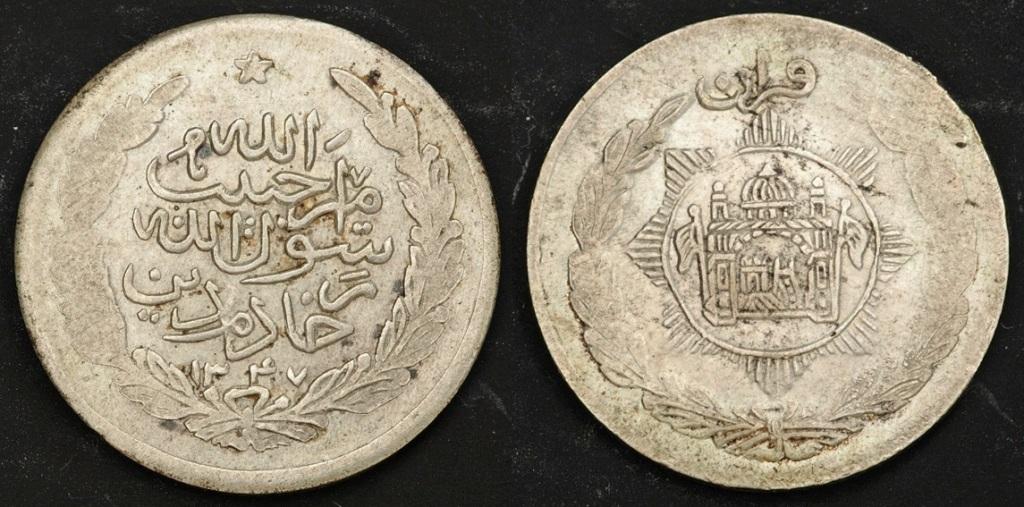 |
Same as above coin but have irregular center circle at the
Reverse side. This coin has traces of Reeded edge. Crude type.
Weight:
4.70g [4.70g]. |
|
 |
KM#897
Rupee.
Year: AH 1347
(1929). Weight:
8.81g [9.10g]. Metal:
0.900 Silver. Diameter:
24.50 mm. Edge: Reeded.
Alignment: Medal.
Mint:
Afghanistan. Obverse:
Star at the top. Bottom to
top in center written: "Khadem e Deen e Rasulullah
Emir Habibullah" (The servant of the religion of messenger of Allah Emir
Habibullah). Date above wreath. Reverse:
Value (Ek Rupiya) above mosque
within 8-pointed
star, wreath surrounds.
Mintage: N/A. Minted Years:
One year type. Ruler:
Habibullah [Kalakani] Ghazi. |
|
| |
|
Mohammad Nadir Shah
coinage: 1929-1933 |
| |
|
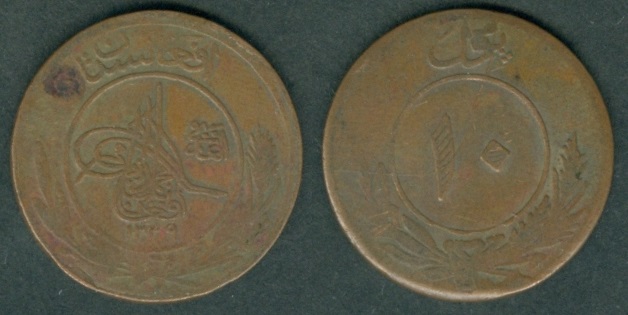 |
KM#918 10 Puls.
Year: AH 1349
(1930). Weight:
5.75g [5.80g]. Metal:
Copper or Brass.
Diameter:
25.00 mm. Edge: Reeded.
Alignment: Medal.
Mint:
Afghanistan.
Obverse:
"افغانستان"
(Afghanistan) written at the top. Mohammad Nadir Tughra and Date
within inner circle.
Wreath at the bottom section outside the inner circle.
Reverse:
"Pul" written at the top. Numerical "١٠"
(10) denomination within inner circle. Wreath at the
bottom section outside the inner circle. |
|
Mintage: N/A. Minted Years:
AH1348 (1929) and AH1349 (1930). Ruler: Mohammad Nadir Shah ibn Sardar Mohammad Yusuf Khan.
My coin's edge is almost smooth with small traces of Reeded / Milled
lines with diameter: 24.50 mm.
Note:
Small or large letters exists. Weight
also varies: 5.30 to 5.80. |
|
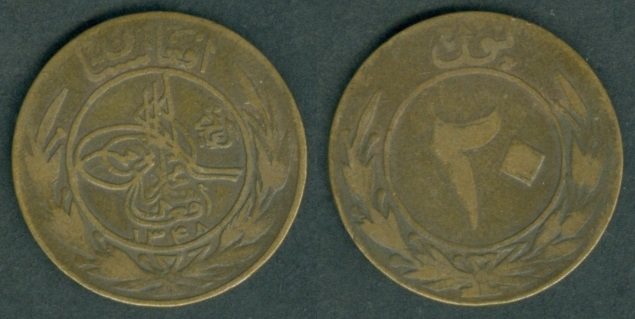 |
KM#919 20 Puls.
Year: AH 1348
(1929). Weight:
5.83g [5.80g]. Metal:
Copper or Brass.
Diameter:
25.00 mm. Edge: Reeded.
Alignment: Medal.
Mint:
Afghanistan.
Obverse:
"افغانستان"
(Afghanistan) written at the top. Mohammad Nadir Tughra and Date
within inner circle.
Wreath at the bottom section outside the inner circle.
Reverse:
"Pul" written at the top. Numerical "٢٠"
(20) denomination within inner circle. Wreath at the
bottom section outside the inner circle. |
|
Mintage: N/A. Minted Years:
AH1348 (1929) and AH1349 (1930). Ruler: Mohammad Nadir Shah ibn Sardar Mohammad Yusuf Khan. |
|
 |
KM#924 25 Puls.
Year: AH 1349
(1930). Weight:
5.67g [6.00g]. Metal:
Bronze or Brass.
Diameter:
25.00 mm. Edge: Reeded.
Alignment: Medal.
Mint:
Afghanistan.
Obverse:
"پنځه ویشت"
(Twenty-five) written at the top. Mohammad Nadir Tughra and Date
within inner circle.
Wreath at the bottom section outside the inner circle.
Reverse:
"Pul" written at the top.
Numerical "٢٥" (25) denomination within inner circle. Wreath at the
bottom section outside the inner circle. |
|
Mintage: N/A. Minted Years:
AH1349 (1930) and 134x (1931). Ruler: Mohammad Nadir Shah ibn Sardar Mohammad Yusuf Khan.
Note:
Two varieties of letters are known for
issue dated AH1349. |
|
 |
KM#920 Half Afghani (50 pul).
Year: AH 1349 - RY2
(1930). Weight:
5.09g. Metal:
0.500 Silver. Diameter:
24.00 mm. Edge: Reeded.
Alignment: Medal.
Mint:
Afghanistan.
Obverse:
Date below
mosque. Wreath at the bottom section.
Reverse:
Value: "1/2 Afghani" written at the top.
Mohammad Nadir Tughra in the center with Reign year below it. Wreath
at the bottom section.
Minted Years:
AH1348/1 (1929), AH1349/2 (1930) and AH1350/3
(1931). Ruler: Mohammad Nadir Shah ibn Sardar Mohammad Yusuf Khan. |
|
 |
Same as above KM#920 Half Afghani,
but... Year: AH 1350 - RY3
(1931). Weight:
5.03g. |
|
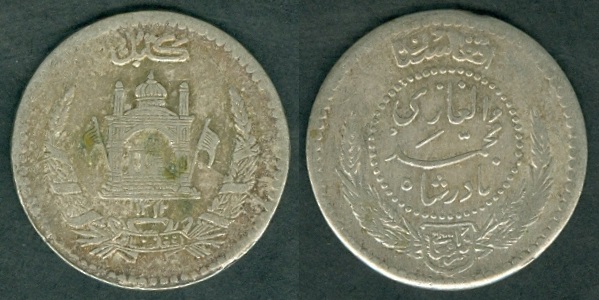 |
KM#926 Half Afghani (50 pul).
Year: AH 1312
(1933). Weight:
4.67g [4.75g]. Metal:
0.500 Silver. Diameter:
24.00 mm. Edge:
Plain.
Alignment: Medal.
Mint:
Kabul. Obverse:
"Kabul" written at the top. Date below
mosque. Wreath at both sides. "Afghanistan" written within the bottom
banner. Reverse:
"Afghanistan" written at the top. "Badshah Muhammad Al-Ghazi"
written in the center dotted circle. "Neem Afghani" written in the
shield at the bottom. Wreath at both sides. |
|
Minted Years:
SH1310 (1931), SH1311 (1932) and SH1312
(1933). Ruler: Mohammad Nadir Shah ibn Sardar Mohammad Yusuf Khan.
Without diamond-shaped dot beneath the wreath type.
Note:
Two die varieties exist
for SH1311 (1932). SH1312 (1933) exists with and without
diamond-shaped dot beneath the wreath. |
|
 |
|
KM#921 Afghani.
Year: AH 1349 - RY2
(1930). Weight:
9.90g. Metal:
0.500 Silver. Diameter:
29.25 mm. Edge: Reeded.
Alignment: Medal.
Mint:
Afghanistan.
Obverse:
Date below
mosque. Minted Years:
AH1348/1 (1929), AH1349/2 (1930) and AH1350/3
(1931). Ruler: Mohammad Nadir Shah ibn Sardar Mohammad Yusuf Khan. |
|
| |
|
Anonymous (general)
coinage: 1932-1935 |
| 2, 5 and 10
Puls coins in Brass / Bronze were produced during 1932-1935 without ruler's
name are considered as anonymous issues. |
| |
|
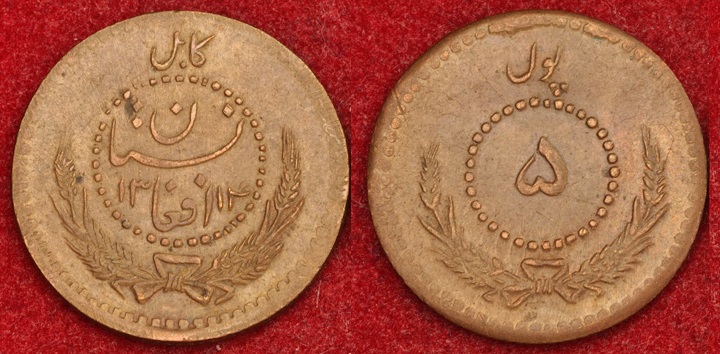 |
KM#929 5 Puls.
Year: SH 1314
(1935). Weight:
2.90g [3.00g]. Metal:
Brass / Bronze. Diameter:
21.00 mm. Edge: Reeded.
Alignment: Medal.
Mint:
Kabul.
Obverse:
"Kabul" written at the top. "Afghanistan" with
Date written within the dotted center circle. Wreath at the bottom.
Reverse:
"Pul" written at the top. Numeral "5"
written within the dotted center circle. Wreath at the bottom.
Mintage: N/A. Minted Years:
SH1311 (1932), SH1312 (1933), SH1313 (1934)
and SH1314 (1935). |
|
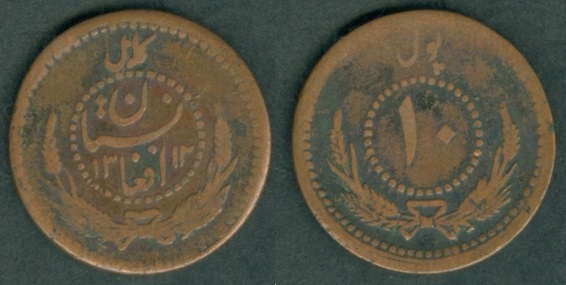 |
KM#930 10 Puls.
Year: SH 1312
(1933). Weight:
5.83g. Metal:
Brass / Bronze. Diameter:
22.50 mm. Edge: Reeded.
Alignment: Medal.
Mint:
Kabul.
Obverse:
"Kabul" written at the top. "Afghanistan" with
Date written within the dotted center circle. Wreath at the bottom.
Reverse:
"Pul" written at the top.
Numeral "10"
written within the dotted center circle. Wreath at the bottom.
Mintage: N/A. Minted Years:
SH1311 (1932), SH1312 (1933), SH1313 (1934)
and SH1314 (1935). |
|
 |
Same as above coin, KM#930, 10 Puls, but...
Year: SH 1313
(1934). Weight:
5.00g. |
|
| |
|
Mohammad Zahir Shah
coinage: 1933-1973 |
| |
|
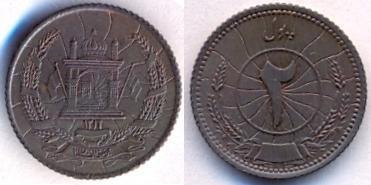 |
KM#936 2 Puls.
Year: SH 1316
(1937). Weight:
1.96g [2.00g]. Metal:
Bronze. Diameter:
15.00 mm. Edge: Reeded.
Alignment: Medal.
Mint:
Afghanistan.
Obverse:
Arms within wreath.
Reverse:
Numerical
denomination within inner circle,
wreath surrounds.
Mintage: N/A. Minted Years:
One year type. Ruler: Mohammad
Zahir Shah ibn Mohammad Nadir Shah. It has radiant background. |
|
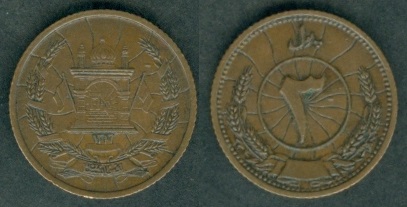 |
KM#937
3 Puls.
Year: SH 1316
(1937). Weight:
2.50g [2.50g]. Metal:
Bronze. Diameter:
16.00 mm. Edge: Reeded.
Alignment: Medal.
Mint:
Afghanistan.
Obverse:
Arms within wreath.
Reverse:
Numerical
denomination within inner circle,
wreath surrounds.
Mintage: N/A. Minted Years:
One year type. Ruler: Mohammad
Zahir Shah ibn Mohammad Nadir Shah. It has radiant background. |
|
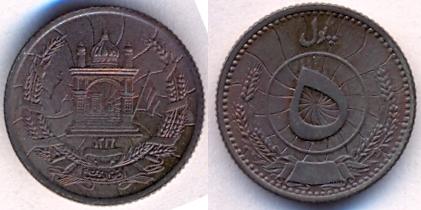 |
KM#938 5 Puls.
Year: SH 1316
(1937). Weight:
3.02g [3.00g]. Metal:
Bronze. Diameter:
17.10 mm. Edge: Reeded.
Alignment: Medal.
Mint:
Afghanistan.
Obverse:
Arms within wreath.
Reverse:
Numerical
denomination within inner circle,
wreath surrounds.
Mintage: N/A. Minted Years:
One year type. Ruler: Mohammad
Zahir Shah ibn Mohammad Nadir Shah. It has radiant background. |
|
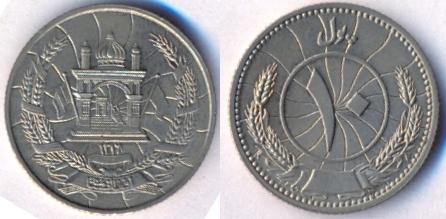 |
KM#939 10 Puls.
Year: SH 1316
(1937). Weight:
2.53g [2.50g]. Metal:
Copper-Nickel.
Diameter:
18.00 mm. Edge: Reeded.
Alignment: Medal.
Mint:
Afghanistan.
Obverse:
Arms within wreath.
Reverse:
Numerical denomination within inner circle,
wreath surrounds.
Mintage: N/A. Minted Years:
One year type. Ruler: Mohammad
Zahir Shah ibn Mohammad Nadir Shah. |
|
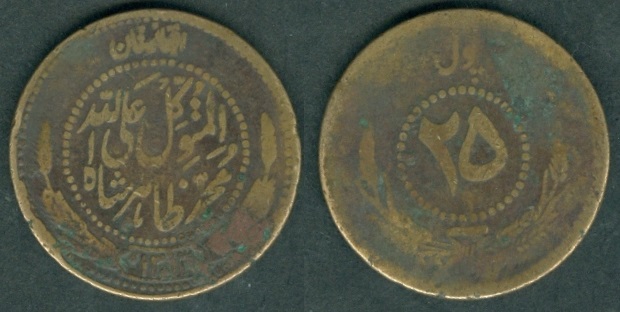 |
KM#931 25 Puls.
Year: SH 1313
(1934). Weight:
6.64g. Metal:
Bronze or Brass.
Diameter:
24.50 mm. Edge: Reeded.
Alignment: Medal.
Mint:
Afghanistan.
Obverse:
Al-Mutawakil-illah Mohammad
Zahir Shah written within beaded inner circle.
Reverse:
Numerical denomination within beaded inner circle, wreath surrounds.
Mintage: N/A. Minted Years:
AH1312-1314 and 1316 (1933-1935 and 1937). Ruler: Mohammad
Zahir Shah ibn Mohammad Nadir Shah. |
|
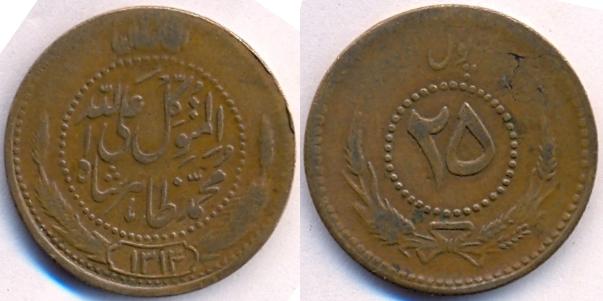 |
Same as above coin as KM#931 25 Puls,
but...
Year: SH 1314
(1935). Weight:
6.83g. |
|
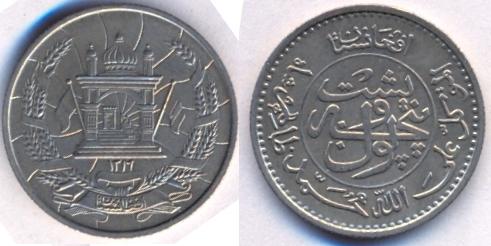 |
KM#940 25 Puls.
Year: SH 1316
(1937). Weight:
2.99g [3.00g]. Metal:
Copper-Nickel.
Diameter:
20.00 mm. Edge: Reeded.
Alignment: Medal.
Mint:
Afghanistan.
Obverse:
Arms within wreath.
Reverse: Denomination text within inner
circle. Afghanistan written on the top and Al-Mutawakil-illah Mohammad
Zahir Shah written below.
Mintage: N/A. Minted Years:
One year type. Ruler: Mohammad
Zahir Shah ibn Mohammad Nadir Shah. |
|
 |
KM#941 25 Puls.
Year: SH 1330
(1951). Weight:
3.17g [3.00g]. Metal:
Bronze. Diameter:
20.00 mm. Edge:
Plain.
Alignment: Medal.
Mint:
Afghanistan.
Obverse:
Arms within wreath.
Reverse: Denomination text within inner
circle. Afghanistan written on the top and Al-Mutawakil-illah Mohammad
Zahir Shah written below. |
|
Mintage: N/A. Minted Years:
SH1330 (1951), SH1331 (1952), SH1332 (1953)
and SH1333 (1954).
SH1333 (1954) requires confirmation.
Ruler: Mohammad Zahir Shah ibn Mohammad
Nadir Shah. |
|
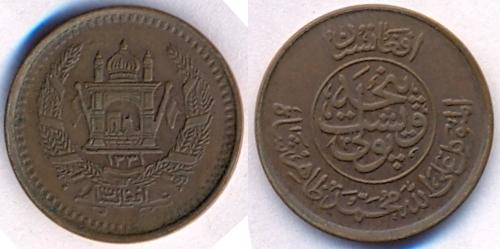 |
Same as above coin as KM#941 25 Puls,
but... Year: SH 1331
(1952). Weight:
3.13g [3.00g]. |
|
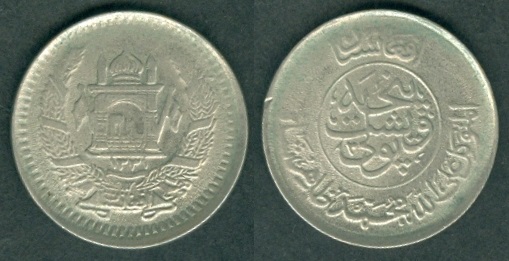 |
KM#944 25 Puls.
Year: SH 1331
(1952). Weight:
2.98g [3.00g]. Metal:
Nickel Clad Steel. Diameter:
20.00 mm. Edge:
Plain.
Alignment: Medal.
Mint:
Afghanistan.
Obverse:
Arms within wreath.
Reverse: Denomination text within inner
circle. Afghanistan written on the top and Al-Mutawakil-illah Mohammad
Zahir Shah written below. |
|
Mintage: N/A. Minted Years:
SH1331 (1952), SH1332 (1953), SH1333 (1954),
SH1334/2 (1955) and SH1334 (1955).
Ruler: Mohammad Zahir Shah ibn Mohammad
Nadir Shah.
Note:
KM#943 25 Puls Nickel Clad Steel has
Reeded edge mint in SH1331 (1952) and SH1332 (1953). |
|
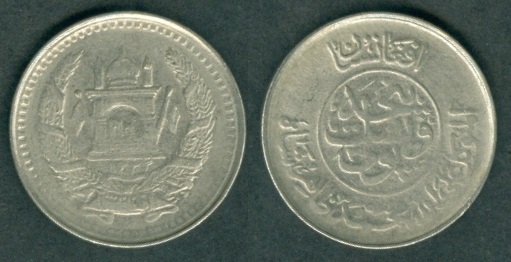 |
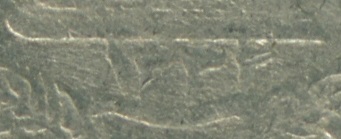 |
| Same as above coin, KM#944 25
Puls but...
Year: SH 1334/2
(1955). Weight:
2.99g [3.00g]. |
|
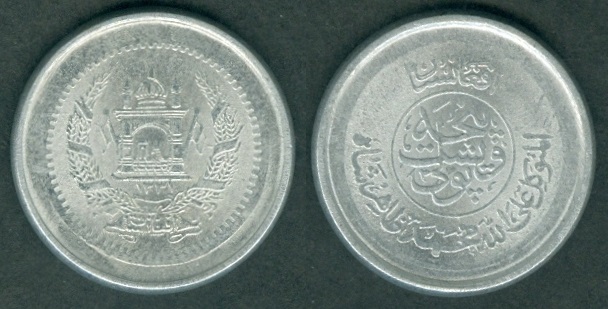 |
KM#945 25 Puls.
Year: SH 1331
(1952). Weight:
2.46g. Metal:
Aluminium. Diameter:
24.00 mm. Edge:
Plain.
Alignment: Medal.
Mint:
Afghanistan.
Obverse:
Arms within wreath.
Reverse: Denomination text within inner
circle. Afghanistan written on the top and Al-Mutawakil-illah Mohammad
Zahir Shah written below.
Mintage: N/A. Minted Years:
One year type.
Ruler: Mohammad Zahir Shah ibn Mohammad
Nadir Shah. |
|
Note:
Struck on oversize 2 Afghani KM#949
planchets in 1970. |
|
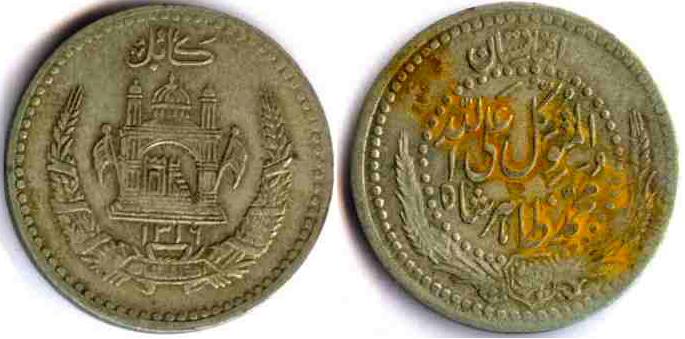 |
KM#932.2 Half
Afgani (50 puls).
Year: SH 1316
(1937). Weight:
5.01g. Metal:
0.500 Silver. Diameter:
24.00 mm. Edge:
Plain.
Alignment: Medal.
Mint:
Afghanistan.
Obverse:
Arms within wreath with Kabul wriiten on top.
Reverse:
Afghanistan written on the top and Al-Mutawakil-illah Mohammad
Zahir Shah written within 40 dotted circle. Wreath below.
Mintage: N/A. Minted Years:
SH 1313-1316 (1934-1937).
Ruler: Mohammad Zahir Shah ibn Mohammad
Nadir Shah.
Note:
No denomination mentioned on this coin. |
|
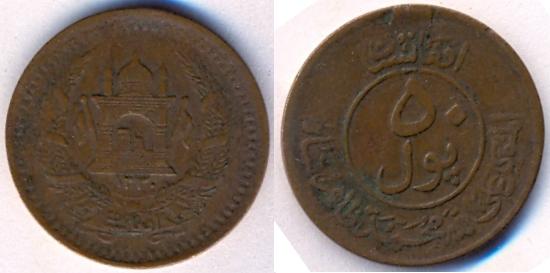 |
KM#942.1 50 puls.
Year: SH 1330
(1951). Weight:
4.80g. Metal:
Bronze. Diameter:
22.50 mm. Edge:
Plain.
Alignment: Medal.
Mint:
Afghanistan.
Obverse:
Arms within wreath.
Reverse:
Afghanistan written on the top, numerical denomination written within
circle and Al-Mutawakil-illah Mohammad
Zahir Shah written below.
Mintage: N/A.
Ruler: Mohammad Zahir Shah ibn Mohammad
Nadir Shah. |
|
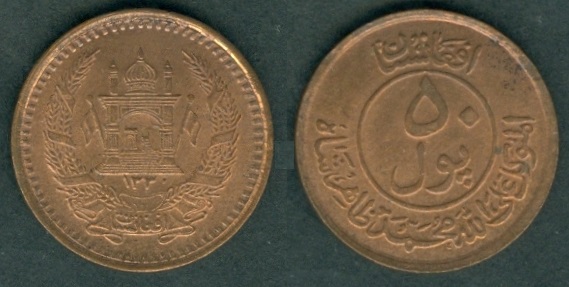 |
Same as above coin, but
the last digit "zero" is above and far from the remaining digits.
The "zero" digit is near the base of the mosque. Weight:
5.53g [4.80g]. Edge:
Reeded. |
|
 |
Same as above coin, but last digit missing in the date.
Year: SH 133x
(1951). Weight:
5.16g [4.80g]. Edge:
Reeded. |
|
 |
KM#947 50 puls.
Year: SH 1331
(1952). Weight:
4.96g. Metal:
Nickel clad Steel. Diameter:
22.30 mm. Edge:
Plain.
Alignment: Medal.
Mint:
Afghanistan.
Obverse:
Arms within wreath.
Reverse:
Afghanistan written on the top, Text denomination written within circle
and Al-Mutawakil-illah Mohammad
Zahir Shah written below.
Mintage: N/A.
Ruler: Mohammad Zahir Shah ibn Mohammad
Nadir Shah.
Note:
AH133x (1953) also exists. |
|
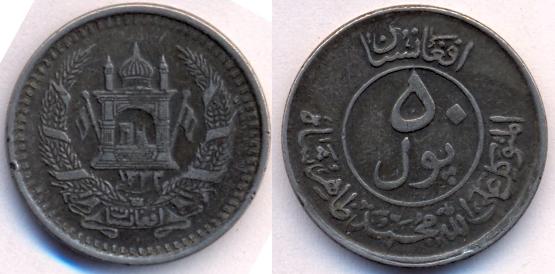 |
KM#946 50 Puls.
Year: SH 1332
(1953). Weight:
5.00g. Metal:
Nickel clad Steel.
Diameter:
22.30 mm. Edge:
Plain. Alignment: Medal.
Mint:
Afghanistan.
Obverse:
Arms within wreath.
Reverse: Denomination within inner
circle. Afghanistan written on the top and Al-Mutawakil-illah Mohammad
Zahir Shah written below.
Mintage: N/A. Minted Years:
SH 1331-1334 (1952-1955).
Ruler: Mohammad Zahir Shah ibn Mohammad
Nadir Shah. |
|
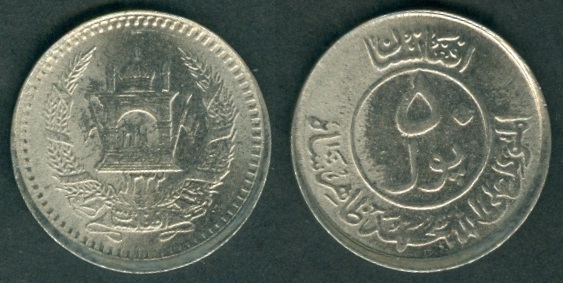 |
Same as above coin, but the date size digits are
decreasing from left to right while in the above coin the date
digits are increasing from left to right.
Weight:
5.05g.
|
|
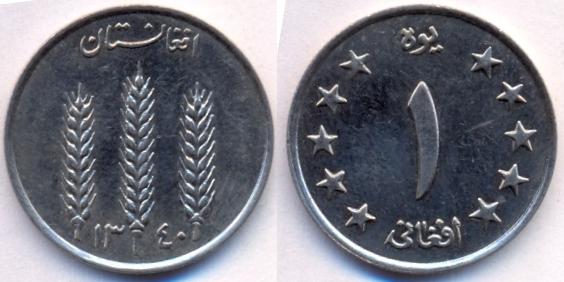 |
KM#953 Afghani (100 Puls).
Year: SH 1340
(1961). Weight:
4.00g. Metal:
Nickel clad Steel.
Diameter:
23.00 mm. Edge:
Reeded. Alignment:
Coin. Mint:
Afghanistan.
Obverse:
Three wheat sprigs.
Reverse: Denomination with five stars on
each side.
Mintage: N/A. Minted Years:
One year type. Ruler: Mohammad
Zahir Shah ibn Mohammad Nadir Shah. |
|
 |
KM#949 2 Afghanis.
Year: SH 1337
(1958). Weight:
2.50g. Metal:
Aluminum.
Diameter:
24.00 mm. Edge:
Reeded. Alignment:
Medal. Mint:
Afghanistan.
Obverse:
Numerical denomination within dotted inner circle.
Reverse:
Arms within wreath, circle surrounds.
Mintage: N/A. Minted Years:
One year type. Ruler: Mohammad
Zahir Shah ibn Mohammad Nadir Shah.
Note:
This issue was withdrawn and demonetized due to extensive
counterfeiting. |
|
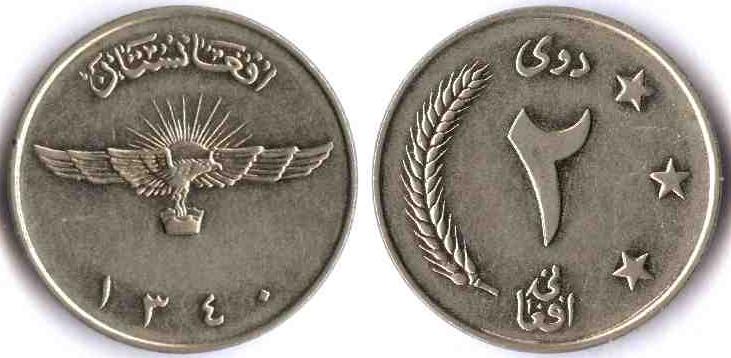 |
KM#954.1 2 Afghanis.
Year: SH 1340
(1961). Weight:
5.30g. Metal:
Nickel clad Steel.
Diameter:
25.10 mm. Edge:
Plain. Alignment:
Coin. Mint:
Afghanistan.
Obverse:
Radiant eagle
statue, with wings spread.
Reverse: Wheat sprig left of denomination
with three stars on the right.
Mintage: N/A. Minted Years:
One year type. Ruler: Mohammad
Zahir Shah ibn Mohammad Nadir Shah.
Note:
KM#954.2 with medal alignment also exists.
Some evidence indicates that the medal alignment variety was the first
Republican issue struck in 1973. |
|
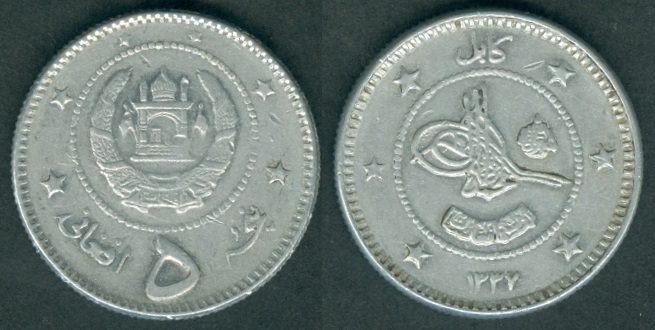 |
KM#950 5 Afghanis.
Year: SH 1337
(1958). Weight:
2.98g [3.00g]. Metal:
Aluminum.
Diameter:
26.00 mm. Edge:
Reeded. Alignment:
Medal. Mint:
Afghanistan.
Obverse:
Kabul written on the top. Tughra within beaded
circle.
Reverse:
Arms within beaded circle, denomination below.
Mintage: N/A. Minted Years:
One year type. Ruler: Mohammad
Zahir Shah ibn Mohammad Nadir Shah.
Note:
This issue was withdrawn and demonetized due to extensive
counterfeiting. |
|
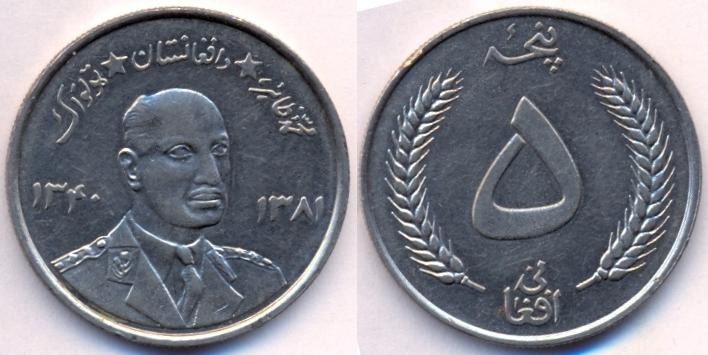 |
KM#955 5 Afghani.
Year: SH 1340 - AH
1381
(1961). Weight:
8.02g. Metal:
Nickel clad Steel.
Diameter:
28.80 mm. Edge:
Reeded. Alignment:
Coin. Mint:
Afghanistan.
Obverse:
Bust 3/4 right divides dates.
Reverse: Wheat sprigs
flank denomination.
Mintage: N/A. Minted Years:
One year type. Ruler: Mohammad
Zahir Shah ibn Mohammad Nadir Shah. |
|
| |
- Presidents - Republic
- Sardar Mohammad Daud Khan .......................17 Jul 1973 - 27 Apr 1978
- Daoud and most of his family were assassinated
during a coup by the communist People's Democratic Party of Afghanistan. The
coup happened in the presidential palace on 28 April 1978. On June 28, 2008,
the body of President Daoud and those of his family were found in two
separate mass graves in the Pul-e-Charkhi area, District 12 of Kabul city.
- Chairman of Military Council
- Abdul Qadir Dagarwal..............................27 Apr 1978 - 30 Apr 1978
- At 7:00 P.M. on April 27, Qadir made an
announcement over Radio Afghanistan, in the Dari language, "For the first
time in the history of Afghanistan, the last remnants of monarchy, tyranny,
despotism ... has ended, and all powers of the state are in the hands of the
people of Afghanistan". He added that a Revolutionary Council of the
Armed Forces had been established, with himself as its head.
- Presidents of the Revolutionary Council
- Democratic Republic
- Nur Mohammad Taraki..............................30
Apr 1978 - 16 Sep 1979
- Hafizullah Amin..................................16 Sep 1979 - 27 Dec 1979
- He came to power by
ordering the death of his predecessor Nur Muhammad Taraki. The revolt
against communist rule which had begun under Taraki worsened under Amin, and
was a problem that his government was unable to solve. The Soviet Union,
which alleged that Amin was an agent of the CIA, intervened in Afghanistan
on behalf of the Twenty-Year Treaty of Friendship between Afghanistan and
the Soviet Union. Amin was assassinated by the Soviets in December 1979 as
part of Operation Storm-333, having ruled for slightly longer than three
months.
- Babrak Karmal....................................27 Dec 1979 - 24 Nov 1986
-
He was also General secretary of
the People's Democratic (Communist) party till 04 May 1986.
- Haji Mohammad Chamkani...........................24 Nov 1986 - 30 Sep 1987
-
Mohammad Najibullah..............................30
Sep 1987 - 16 Apr 1992
- General secretary of the
People's Democratic (Communist) party from 04 May 1986 to 28 Jun 1990.
President from 30 Nov 1987. The Hizb-e Wahdat (Hazara militia) rule at
Bamiyan from 1990 to 1998.
|
| |
|
Republic issue
coinage: |
| |
|
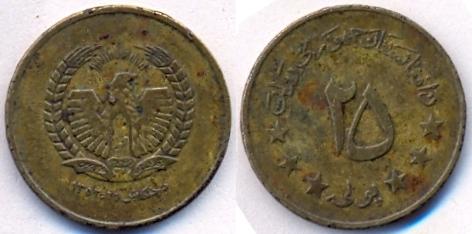 |
KM#975 25 Puls.
Year: SH 1352
(1973). Weight:
2.43g. Metal:
Brass clad Steel.
Diameter:
19.00 mm. Edge:
Plain. Alignment:
Coin. Mint:
N/A. Obverse:
National arms. Reverse:
Denomination with six stars.
Mintage: 45,950,000.
Minted Years: One
year type. Republic issue. |
|
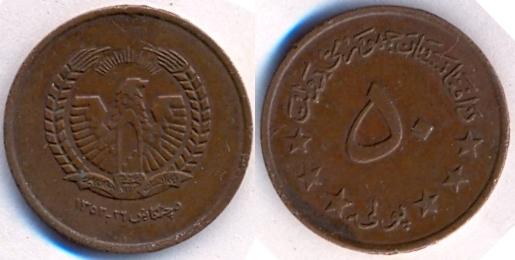 |
KM#976 50 Puls.
Year: SH 1352
(1973). Weight:
3.45g. Metal:
Copper clad Steel.
Diameter:
21.00 mm. Edge:
Plain. Alignment:
Coin. Mint:
N/A. Obverse:
National arms. Reverse:
Denomination with six stars.
Mintage: 24,750,000.
Minted Years: One
year type. Republic issue. |
|
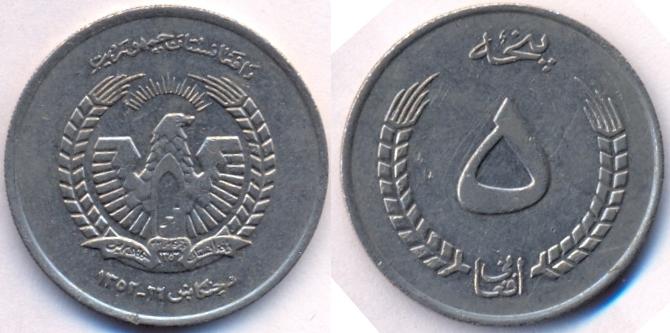 |
KM#977 5 Afghani.
Year: SH 1352
(1973). Weight:
7.02g. Metal:
Nickel clad Steel.
Diameter:
27.00 mm. Edge:
Reeded. Alignment:
Coin. Mint:
N/A. Obverse:
National arms. Reverse:
Denomination within stylized grain sprig wreath.
Mintage: 34,750,000.
Minted Years: One
year type. Republic issue. |
|
| |
|
Democratic Republic Issues: |
| |
|
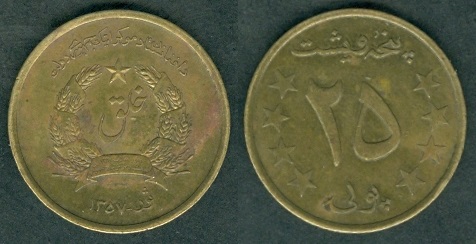 |
KM#990 25 Puls.
Year: SH 1357
(1978). Weight:
2.30g. Metal:
Aluminum-Bronze.
Diameter:
18.50 mm. Edge:
Reeded. Alignment:
Coin. Mint:
N/A. Obverse:
National arms. Reverse:
Denomination within four stars on each side.
Mintage: N/A.
Minted Years: One
year type. |
|
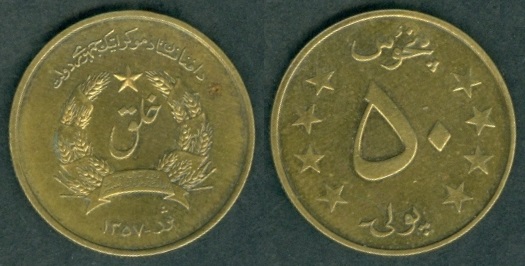 |
KM#992 50 Puls.
Year: SH 1357
(1978). Weight:
3.10g. Metal:
Aluminum-Bronze.
Diameter:
21.00 mm. Edge:
Reeded. Alignment:
Coin. Mint:
N/A. Obverse:
National arms. Reverse:
Denomination within four stars on each side.
Mintage: N/A.
Minted Years: One
year type. |
|
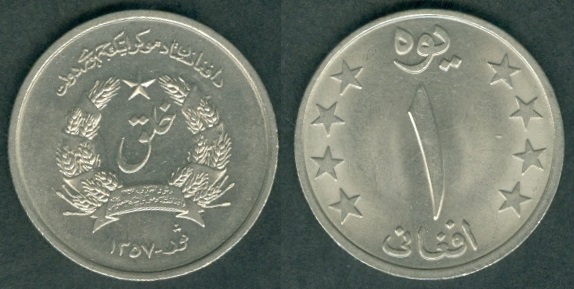 |
KM#993 1 Afghani.
Year: SH 1357
(1978). Weight:
4.55g. Metal:
Copper-Nickel.
Diameter:
23.00 mm. Edge:
Reeded. Alignment:
Coin. Mint:
N/A. Obverse:
National arms. Reverse:
Denomination within four stars on each side.
Mintage: N/A.
Minted Years: One
year type. |
|
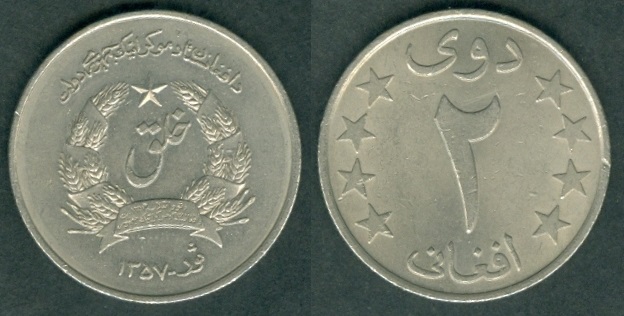 |
KM#994 2 Afghanis.
Year: SH 1357
(1978). Weight:
5.90g. Metal:
Copper-Nickel.
Diameter:
24.50 mm. Edge:
Reeded. Alignment:
Coin. Mint:
N/A. Obverse:
National arms. Reverse:
Denomination within four stars on each side.
Mintage: N/A. Minted Years:
SH1357 and SH1358. |
|
 |
KM#995 5 Afghanis.
Year: SH 1357
(1978). Weight:
7.66g. Metal:
Copper-Nickel.
Diameter:
26.50 mm. Edge:
Reeded. Alignment:
Coin. Mint:
N/A. Obverse:
National arms. Reverse:
Denomination within four stars on each side.
Mintage: N/A. Minted Years:
One year type. |
|
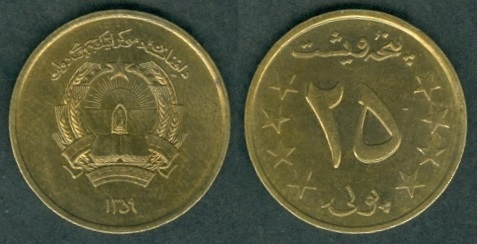 |
KM#996 25 Puls.
Year: SH 1359
(1980). Weight:
2.23g. Metal:
Aluminum-Bronze.
Diameter:
18.50 mm. Edge:
Reeded. Alignment:
Coin. Mint:
N/A. Obverse:
National arms. Reverse:
Denomination within four stars on each side.
Mintage: N/A.
Minted Years: One
year type. |
|
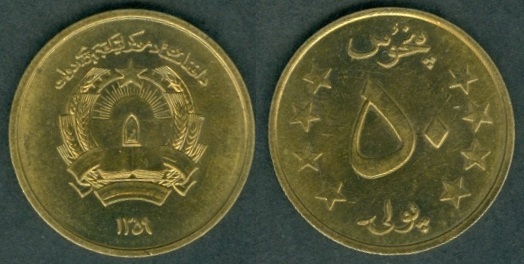 |
KM#997 50 Puls.
Year: SH 1359
(1980). Weight:
3.11g. Metal:
Aluminum-Bronze.
Diameter:
21.00 mm. Edge:
Reeded. Alignment:
Coin. Mint:
N/A. Obverse:
National arms. Reverse:
Denomination within four stars on each side.
Mintage: N/A.
Minted Years: One
year type. |
|
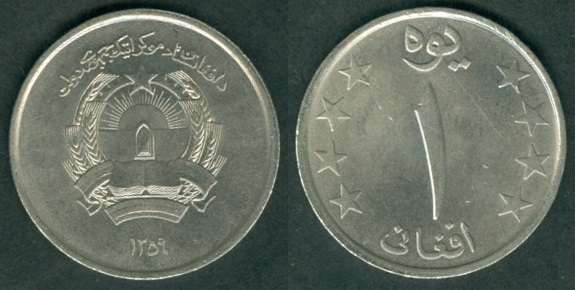 |
KM#998 1 Afghani.
Year: SH 1359
(1980). Weight:
4.36g. Metal:
Copper-Nickel.
Diameter:
23.00 mm. Edge:
Reeded. Alignment:
Coin. Mint:
N/A. Obverse:
National arms. Reverse:
Denomination within four stars on each side.
Mintage: N/A.
Minted Years: One
year type. |
|
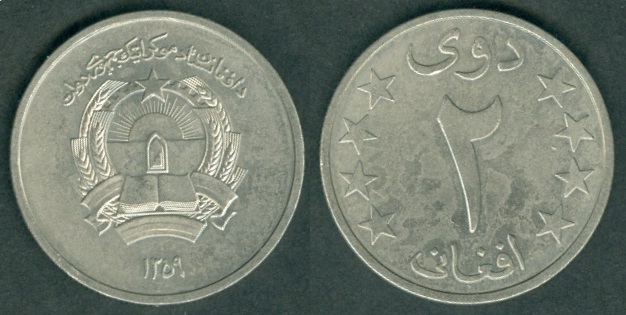 |
KM#999 2 Afghanis.
Year: SH 1359
(1980). Weight:
6.31g. Metal:
Copper-Nickel.
Diameter:
24.50 mm. Edge:
Reeded. Alignment:
Coin. Mint:
N/A. Obverse:
National arms. Reverse:
Denomination within four stars on each side.
Mintage: N/A. Minted Years:
One year type. |
|
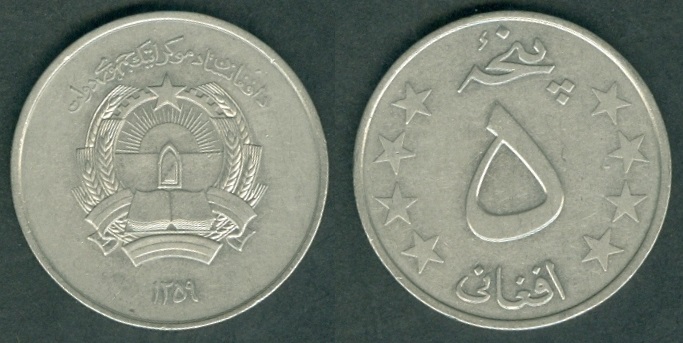 |
KM#1000
5 Afghanis.
Year: SH 1359
(1980). Weight:
7.70g. Metal:
Copper-Nickel.
Diameter:
26.50 mm. Edge:
Reeded. Alignment:
Coin. Mint:
N/A. Obverse:
National arms. Reverse:
Denomination within four stars on each side.
Mintage: N/A. Minted Years:
One year type. |
|
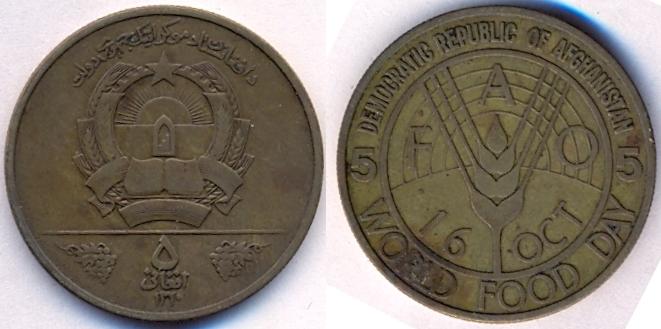 |
KM#1001 5 Afghanis.
Year: SH 1360
(1981). Weight:
7.00g. Metal:
Brass.
Diameter:
26.50 mm. Edge:
Reeded. Alignment:
Coin. Mint:
N/A. Obverse:
National arms. Reverse:
FAO logo.
Mintage: N/A. Minted Years:
One year type. |
|
_Galgary1988.jpg) |
KM#1004 500 Afghanis.
Year: ND (1986). Weight:
12.00g. Metal:
0.999Ag.
Diameter:
29.00 mm. Edge:
Reeded. Alignment:
Coin. Mint:
N/A. Obverse:
Ice Dancers (Skaters). Reverse:
National arms.
Mintage: 10,000. Minted Years:
One year type.
Subject:
15th Winter Olympics Games - Galgary 1988. |
|
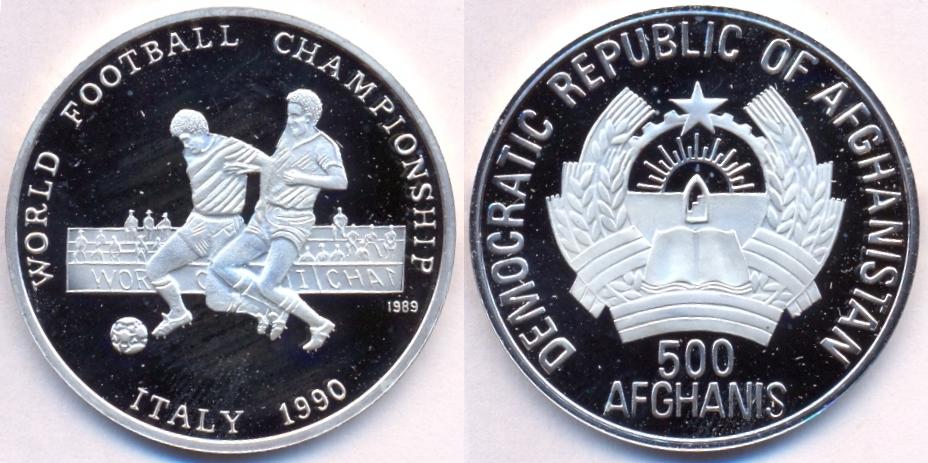 |
KM#1011 500 Afghanis.
Year: 1989. Weight:
16.00g. Metal:
0.999Ag.
Diameter:
39.00 mm. Edge:
Plain. Alignment:
Coin. Mint:
10,000. Obverse:
Two players playing soccer. Reverse:
National arms.
Mintage: 10,000. Minted Years:
One year type.
Subject: World
Football (Soccer) Championship - Italy 1990.
Note: Afghanistan became Republic on
30 Nov 1987, but still this coin have the legends of Democratic Republic. |
|
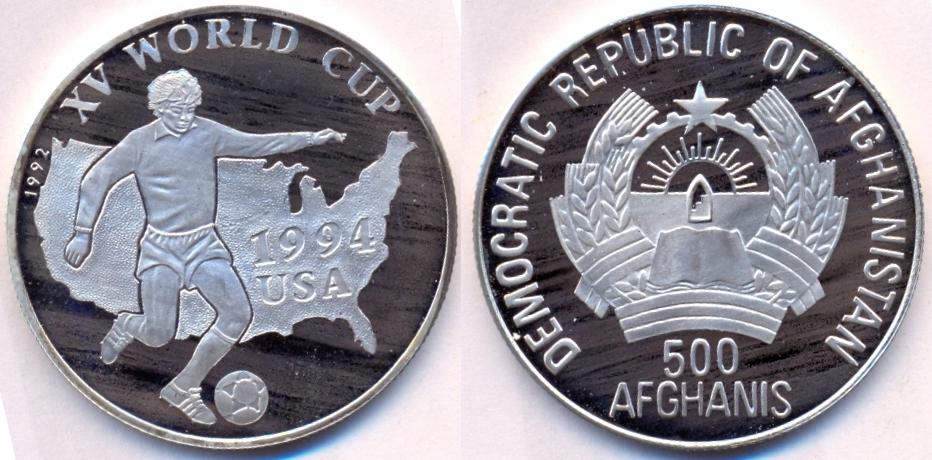 |
KM#1022 500 Afghanis.
Year: 1992. Weight:
20.00g. Metal:
0.999Ag.
Diameter:
39.00 mm. Edge:
Reeded. Alignment:
Coin. Mint:
10,000. Obverse:
USA map behind soccer player. Reverse:
National arms.
Mintage: N/A. Minted Years:
One year type.
Subject: 15th World
Cup Soccer Games 1994 - U.S.A.
Note: Afghanistan became Republic on
30 Nov 1987, but still this coin have the legends of Democratic Republic. |
|
| |
- Presidents
- Abdul Rahim Hatef (acting).......................16 Apr 1992 - 28 Apr 1992
- Sibghatullah Mojadedi (interim)..................28 Apr 1992 - 28 Jun 1992
- Burhanuddin Rabbani (1st
time)...................28 Jun 1992 - 27 Sep 1996
- continues in rebellion
after 27 Sep 1996, largely retaining international recognition.
-
Head of Supreme Council (Taliban Rule)
- Mullah Mohammad Umar.............................27 Sep 1996 - 16 Apr 2001
-
Mawlawi Abdul Kabir (acting).....................16 Apr 2001 - 13 Nov 2001
-
Presidents
- Burhanuddin Rabbani (2nd time)...................13 Nov 2001 - 22 Dec 2001
-
return to Kabul on 17 Nov 2001.
-
Hamid Karzai.....................................22 Dec 2001 -
29 Sep 2014
-
Chairman of the Interim
Administrator to 19 Jun 2002 and then for the transitional government to 26 Jan 2004.
- Mohammad Ashraf Ghani
Ahmadzai...................29
Sep 2014 - date
-
Ashraf Ghani is sworn in as
president and Abdullah Abdullah as chief executive and Prime Minister. On 21
April 2019, the Supreme Court extends the term of President Ashraf Ghani
(ending on 22 May 2019) until delayed presidential elections take place
(scheduled for 28 September 2019). On 23 October 2019, Foreign Minister
Salahuddin Rabbani resigns. On 30 October, President Ashraf Ghani appoints
Idrees Zaman as acting foreign minister. On 22 January 2020, Haroon
Chakhansuri is appointed acting foreign minister. He took office on 23
January.
On 29 February 2020, the U.S. signed a conditional peace agreement
with the Taliban at Doha, Qatar, It calls for the withdrawal of foreign
troops in 14 months if the Taliban uphold the terms of the agreement. On 01
March 2020, however, the Afghan government, which was not a party to the
deal, rejected the U.S. and Taliban's call for a prisoner swap by 10 March
2020, with President Ghani stating that such an agreement will require
further negotiation and will also not be implemented as a precondition for
future peace negotiations. On 10 March 2020, Ghani signed a decree agreeing
to swap 1,500 Taliban prisoners starting 14 March 2020, but on the
condition that they sign pledges agreeing to not return to combat. The same
day, it was also revealed that there were no plans for a full U.S.
withdrawal from Afghanistan. On 10 March 2020, the United Nations Security
Council unanimously backed the U.S.-Taliban peace deal. On 09 March 2020, Ashraf Ghani is sworn in for another term as president. Abdullah Abdullah,
who has disputed the election results, holds a parallel ceremony in which he
takes the oath as self-proclaimed president. On 31 March 2020, President
Ashraf Ghani appoints Abdul Hadi Arghandiwal as acting finance minister. On
04 April 2020, President Ashraf Ghani appoints Mohammad Hanif Atmar as
acting foreign minister and nominates him for the substantive post. On 17
May 2020, President Ashraf Ghani and rival Abdullah Abdullah sign a
power-sharing agreement putting an end to Abdullah's claim to the
presidency.
|
| |
|
Islamic State
issue coinage: |
| |
|
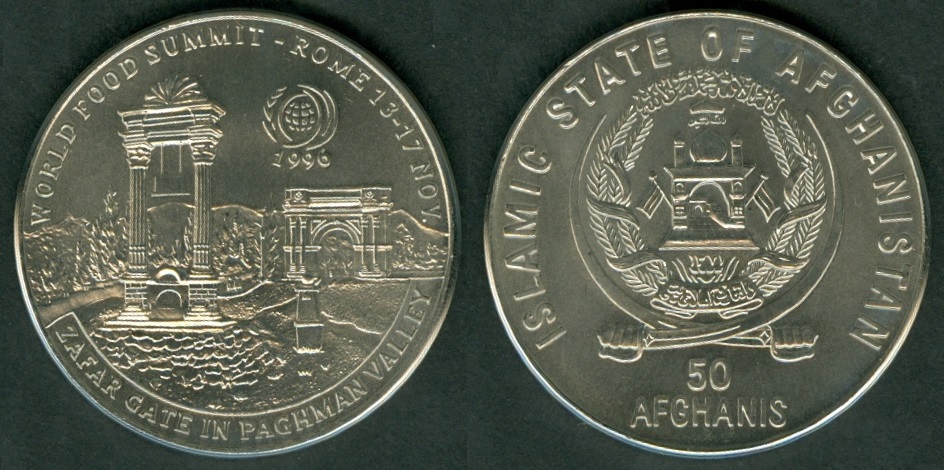 |
KM#1030 50 Afghanis.
Year: 1996.
Weight: 25.89g.
Metal:
Copper-Nickel. Diameter:
38.00 mm. Edge:
Plain. Alignment:
Coin. Mint:
Havana, Cuba. Obverse:
Zafar Gate in Paghman Valley.
Reverse: National arms.
Mintage: 10,000.
Minted Years: One
year type. Subject:
World Food Summit - Rome 13-17 November 1996. |
|
 |
KM#1027 500 Afghanis.
Year: 1996.
Weight: 30.95g.
Metal: 0.999Ag.
Diameter: 39.00
mm. Edge:
Reeded. Alignment:
Coin. Mint:
Havana, Cuba. Obverse:
Soccer player going for goal.
Reverse: National
arms. Mintage:
100 + N/A Proofs.
Minted Years: One year type.
Subject: 16th
World Cup Soccer Games 1998 - France. |
|
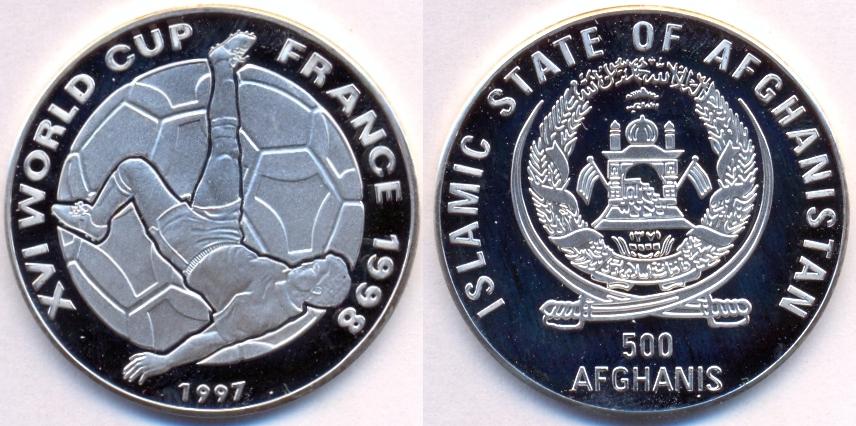 |
KM#1039 500 Afghanis.
Year: 1997.
Weight: 15.00g.
Metal: 0.999Ag.
Diameter: 35.50
mm. Edge:
Plain. Alignment:
Coin. Mint:
N/A. Obverse:
Soccer player superimposed on ball.
Reverse: National
arms. Mintage:
N/A. Minted
Years: One year type.
Subject: 16th
World Cup Soccer Games 1998 - France. |
|
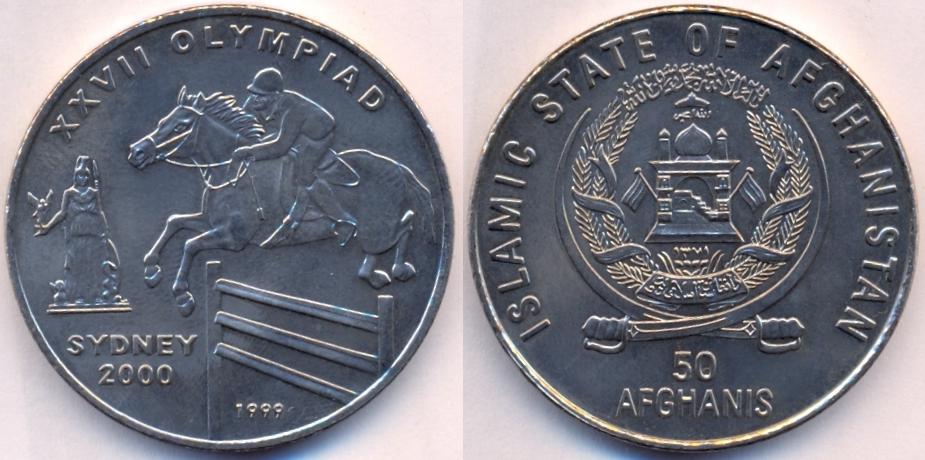 |
KM#1037 50 Afghanis.
Year: 1999.
Weight: 26.07g [26.00g].
Metal:
Copper-Nickel. Diameter:
39.00 mm. Edge:
Plain. Alignment:
Coin. Mint:
N/A. Obverse:
Equestrian event.
Reverse: National arms.
Mintage: 10,000.
Minted Years: One
year type. Subject:
27th Summer Olympics 2000 - Sydney. |
|
| |
|
Islamic Republic
issue coinage: |
|
Monetary standard: Afghani = 100 Pul = 1000 old
Afghanis (Taliban) or 2000 old Afghanis (Northern Alliance). |
| |
|
 |
KM#1044 Afghani.
Year: SH 1383 (2004). Weight:
3.25g. Metal:
Copper-plated Steel.
Diameter:
19.50 mm. Edge:
Plain. Alignment:
Medal. Mint:
N/A. Obverse:
Value. Reverse:
National arms.
Mintage: N/A. Minted Years:
One year type. |
|
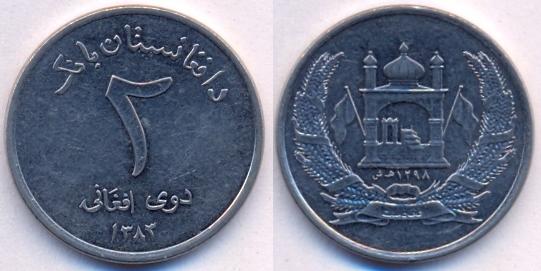 |
KM#1045 2 Afghanis.
Year: SH 1383 (2004). Weight:
4.25g. Metal:
Stainless Steel.
Diameter:
21.00 mm. Edge:
Plain. Alignment:
Medal. Mint:
N/A. Obverse:
Value. Reverse:
National arms.
Mintage: N/A. Minted Years:
One year type. |
|
 |
KM#1046
5 Afghanis. Year:
SH 1383 (2004).
Weight: 5.26g.
Metal: Brass.
Diameter: 23.50
mm. Edge:
Reeded. Alignment:
Medal. Mint:
N/A.
Obverse: Value.
Reverse: National
arms. Mintage:
N/A. Minted
Years: One year type.
|
|
|
|
| |
| |
|
|
|
Countries
/ Territories |
| |
|
Chiefa Coins | |
|







































































































































































.jpg)



























-Type1.jpg)
-Type2.jpg)





















































































































_Galgary1988.jpg)








